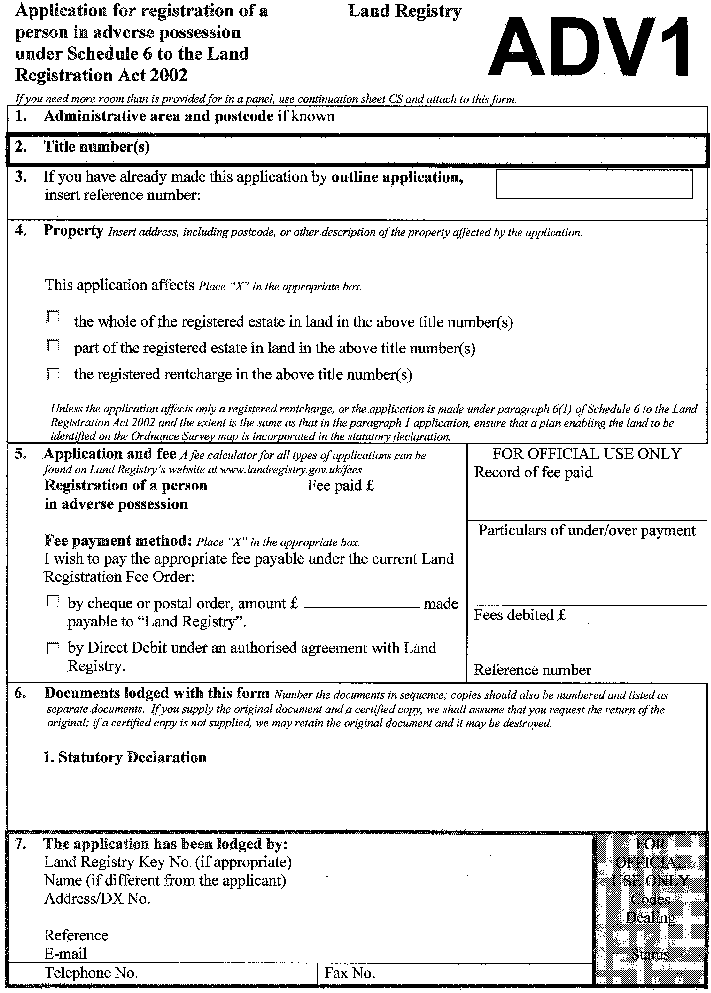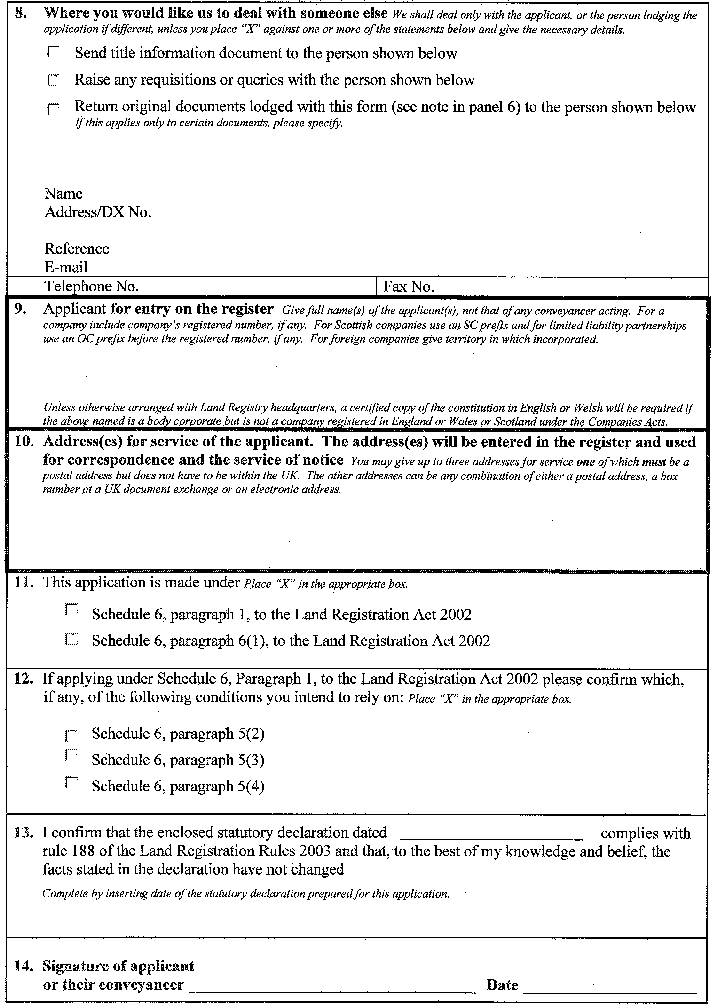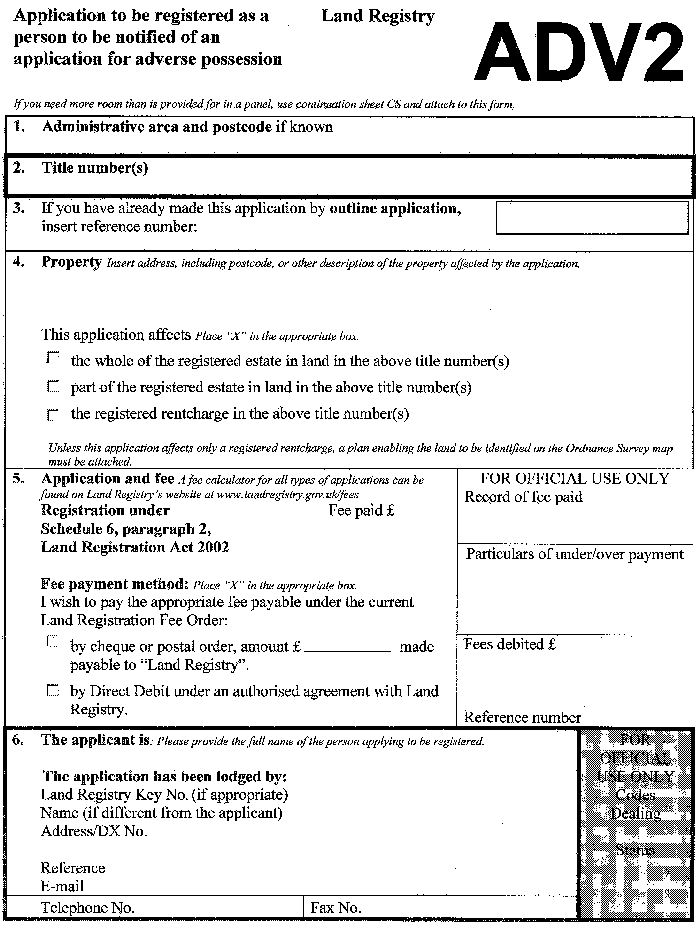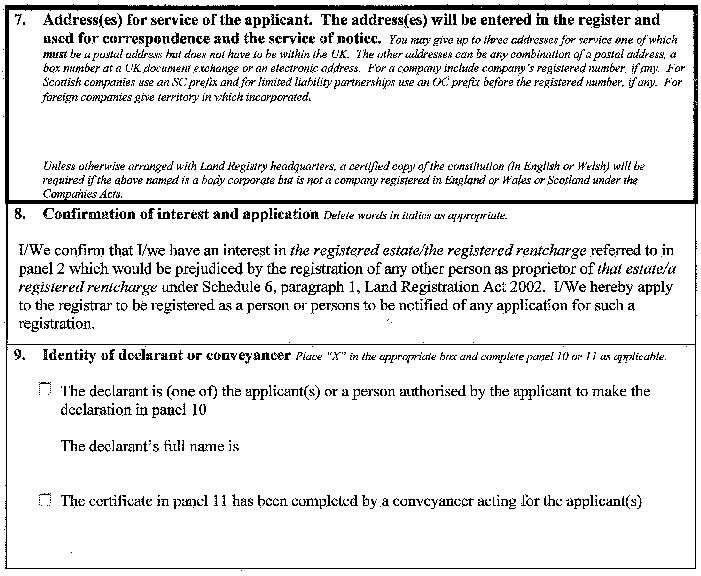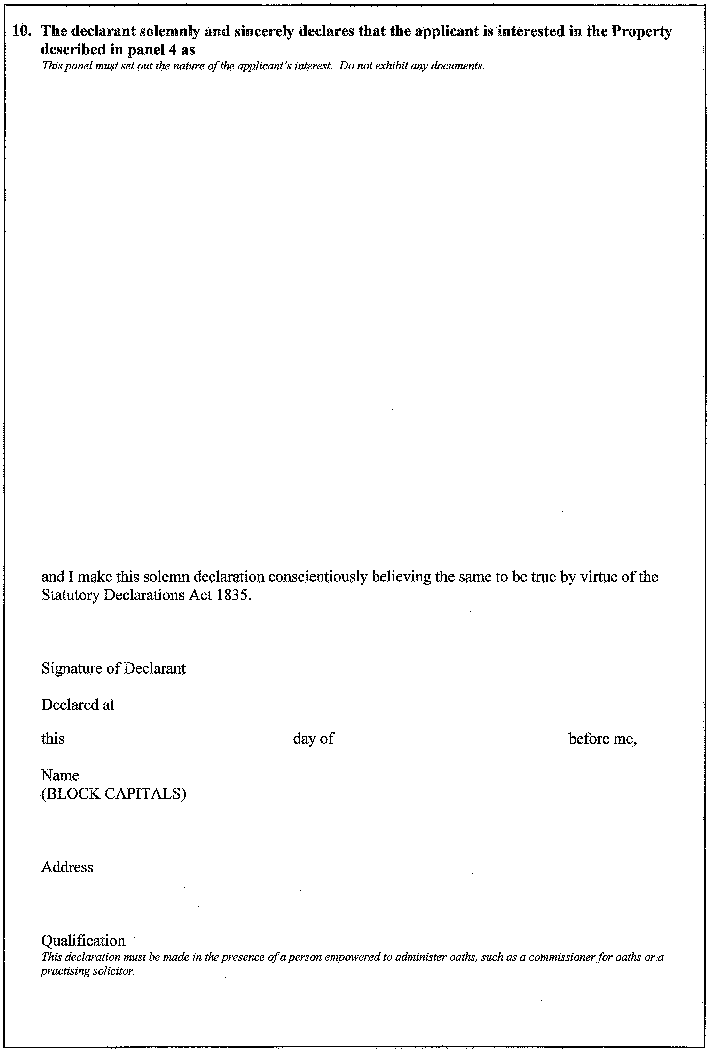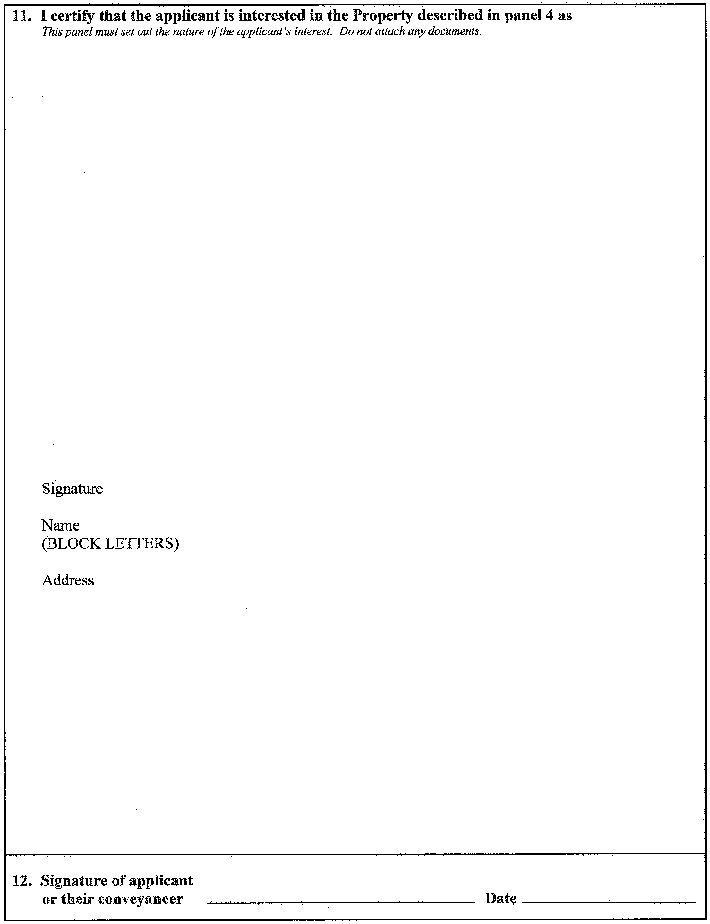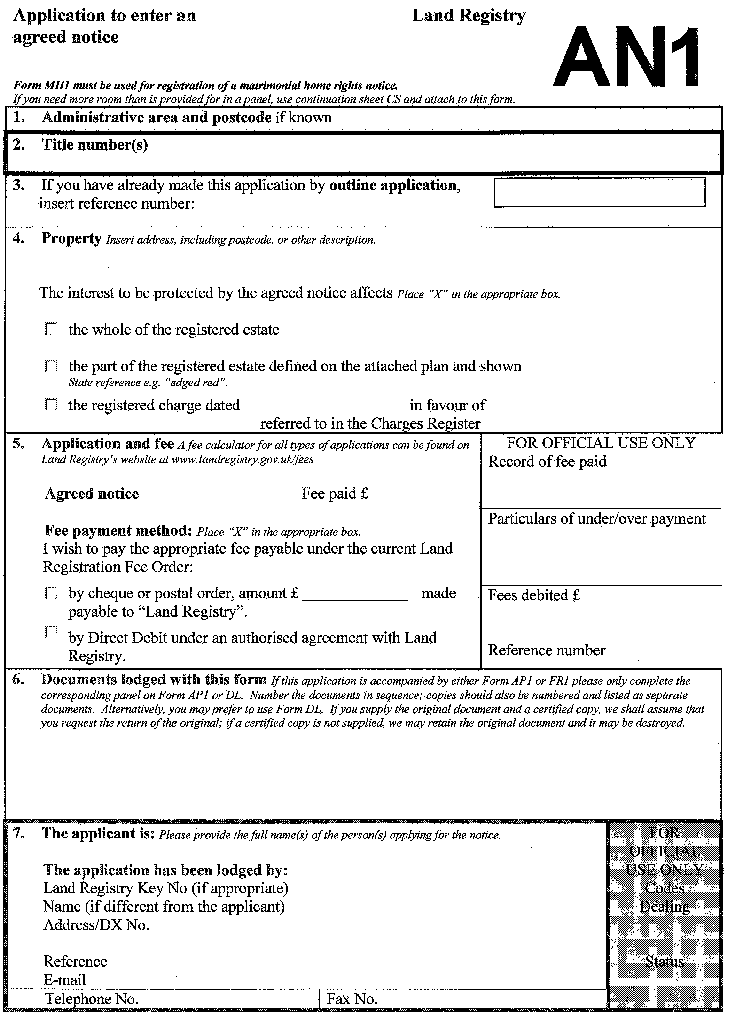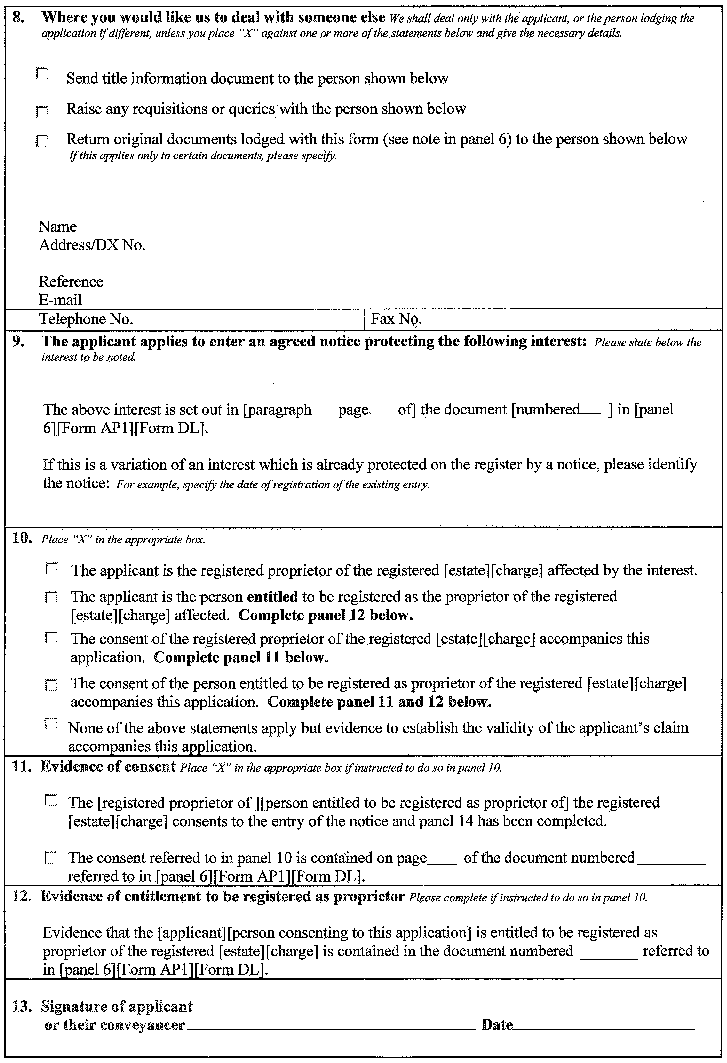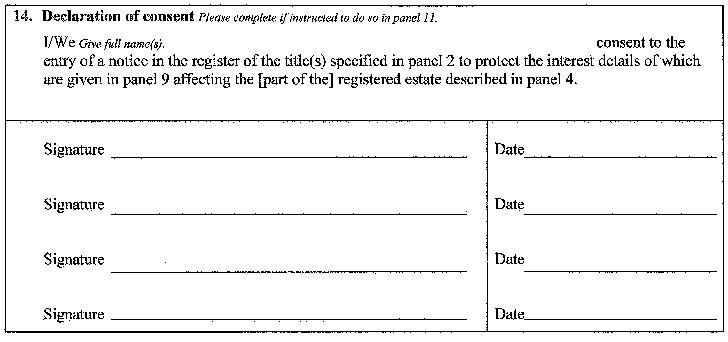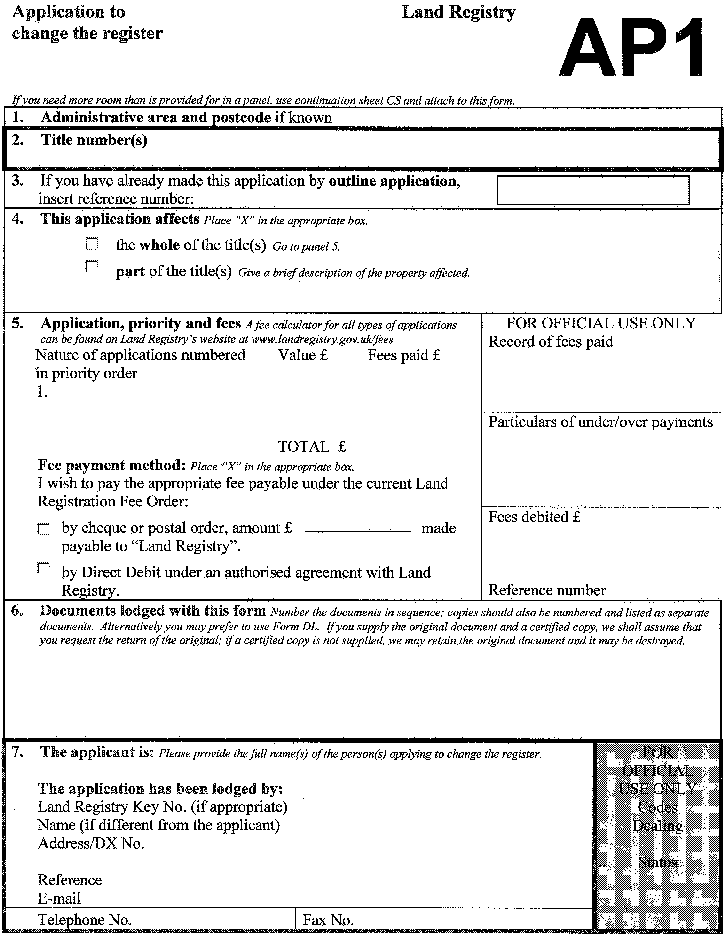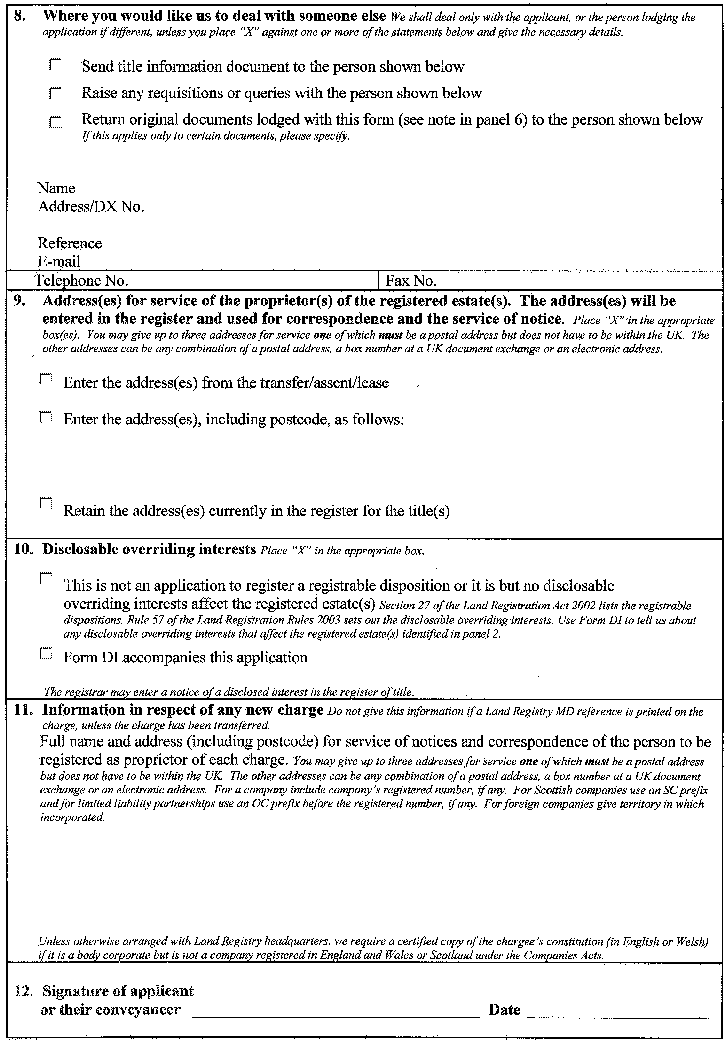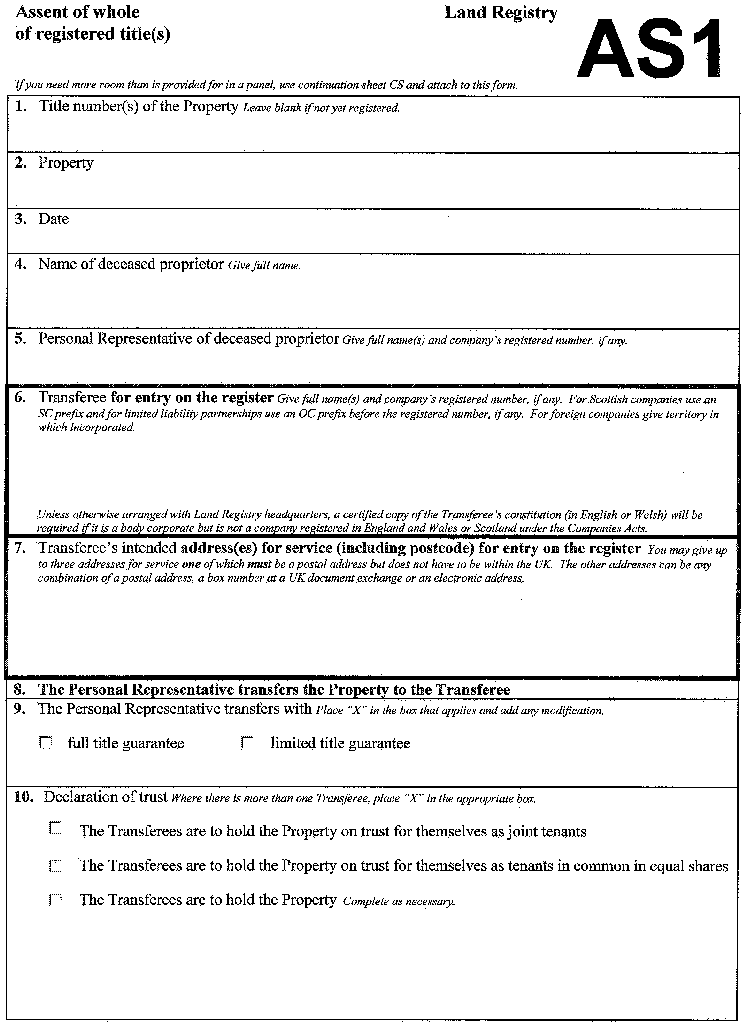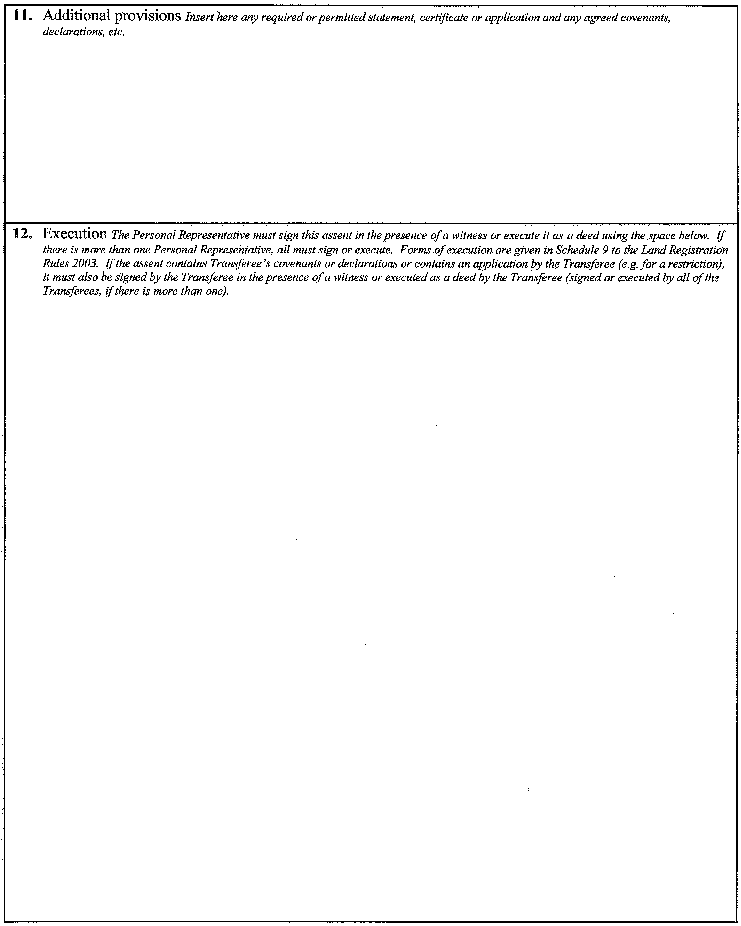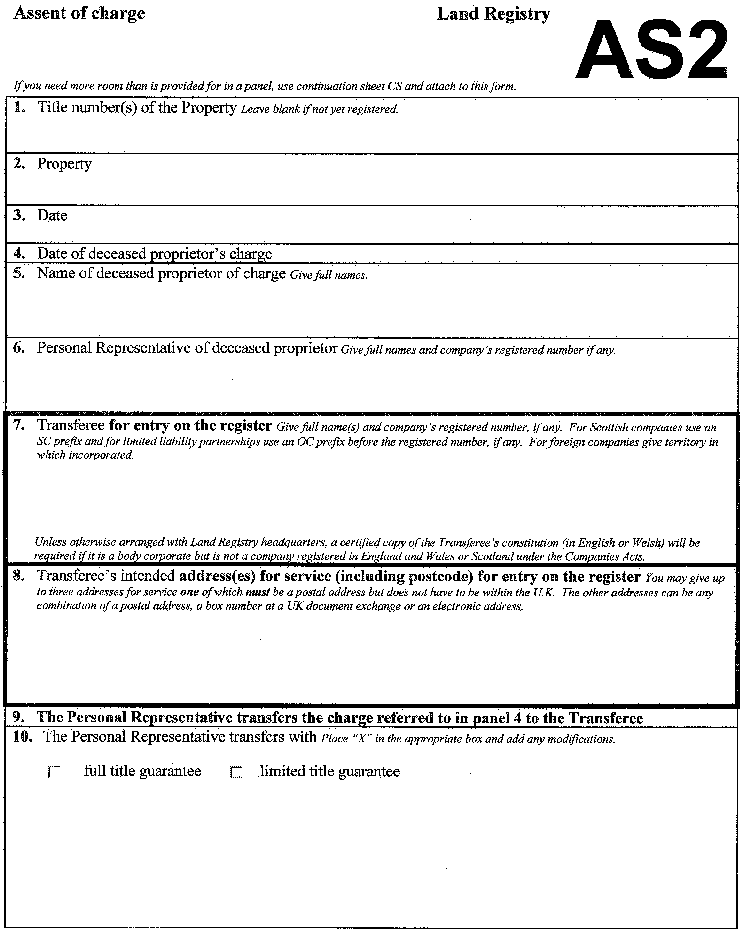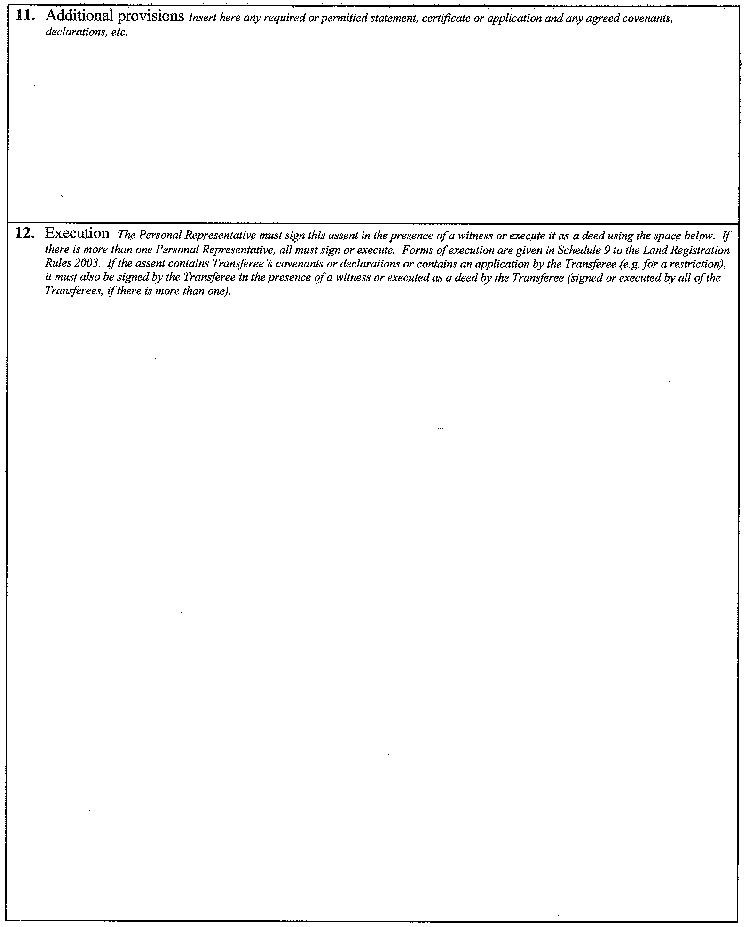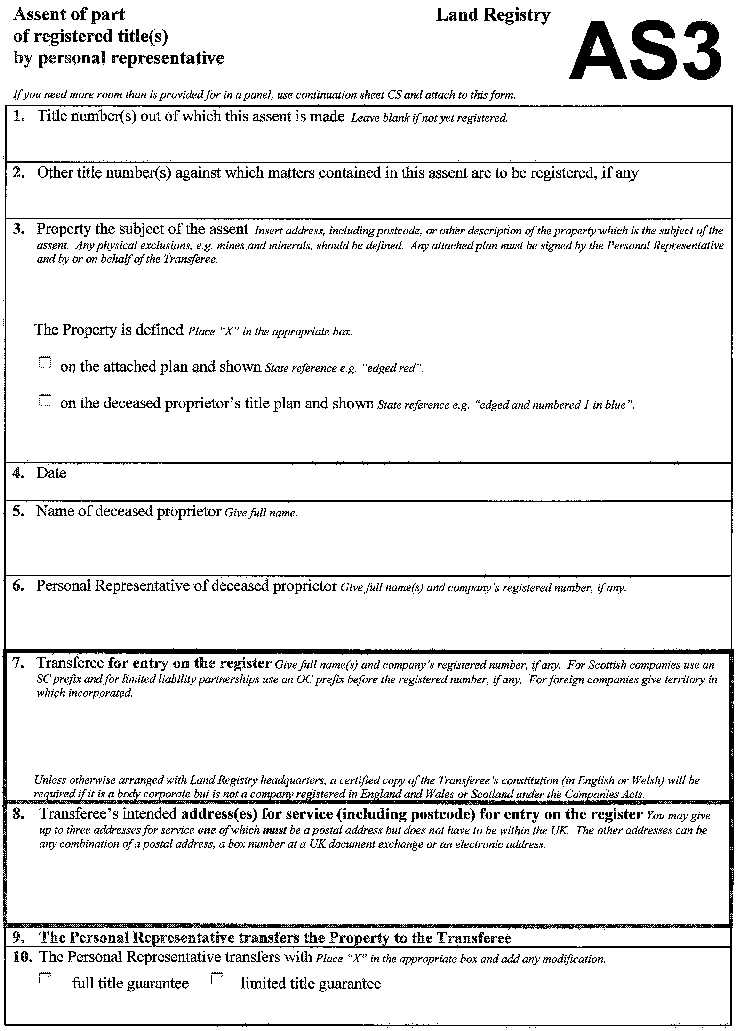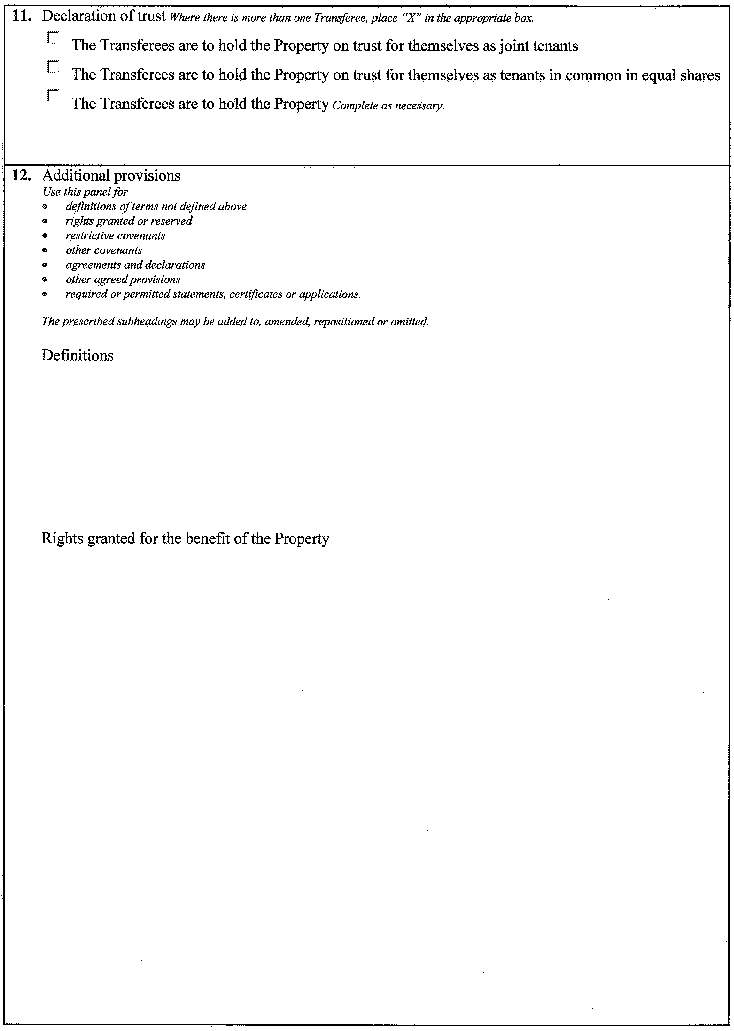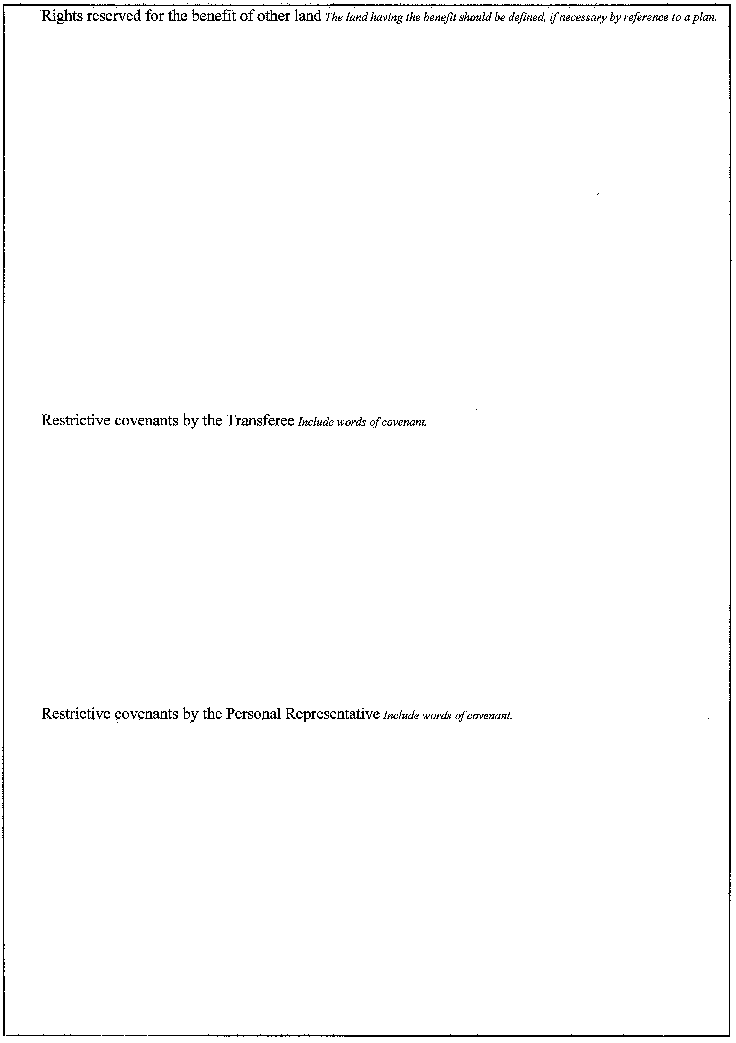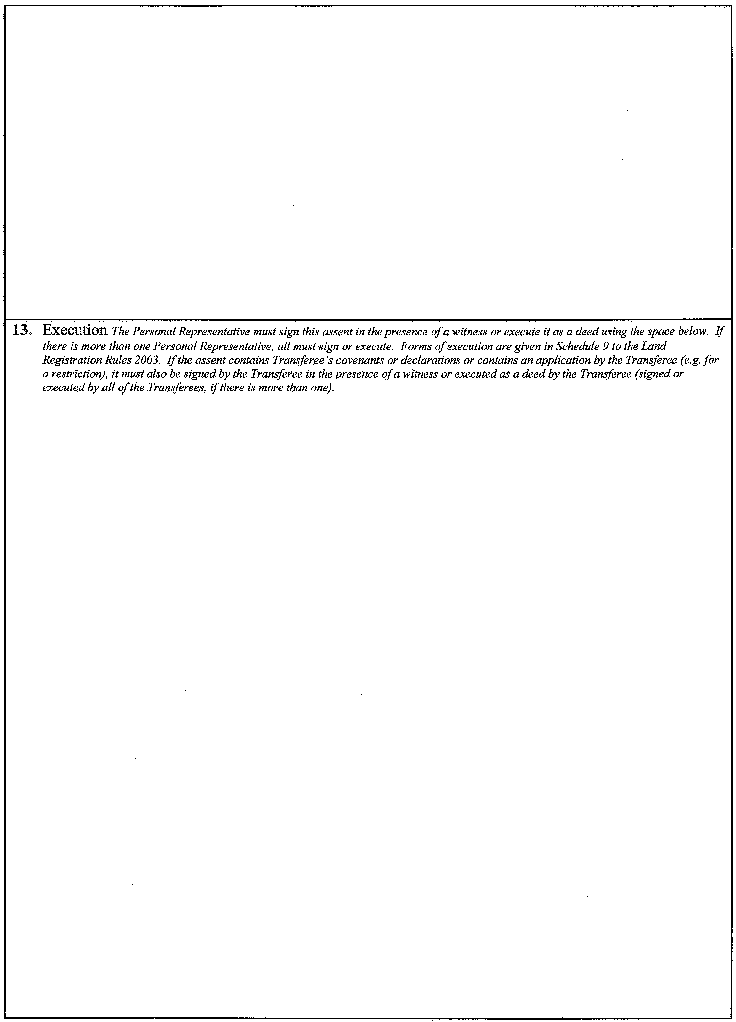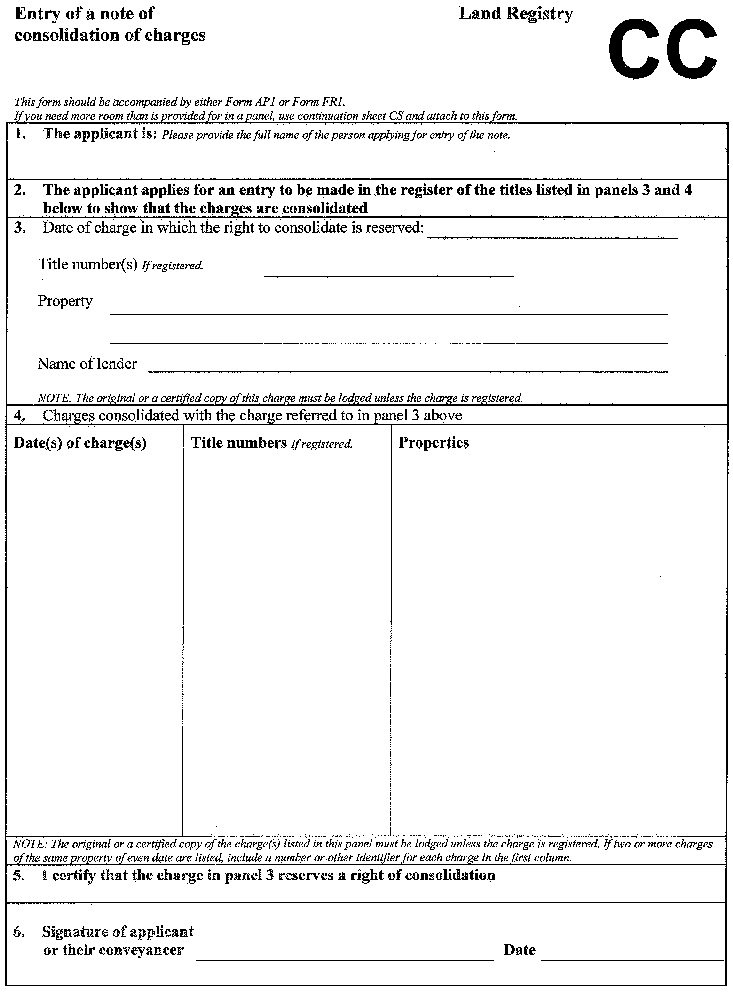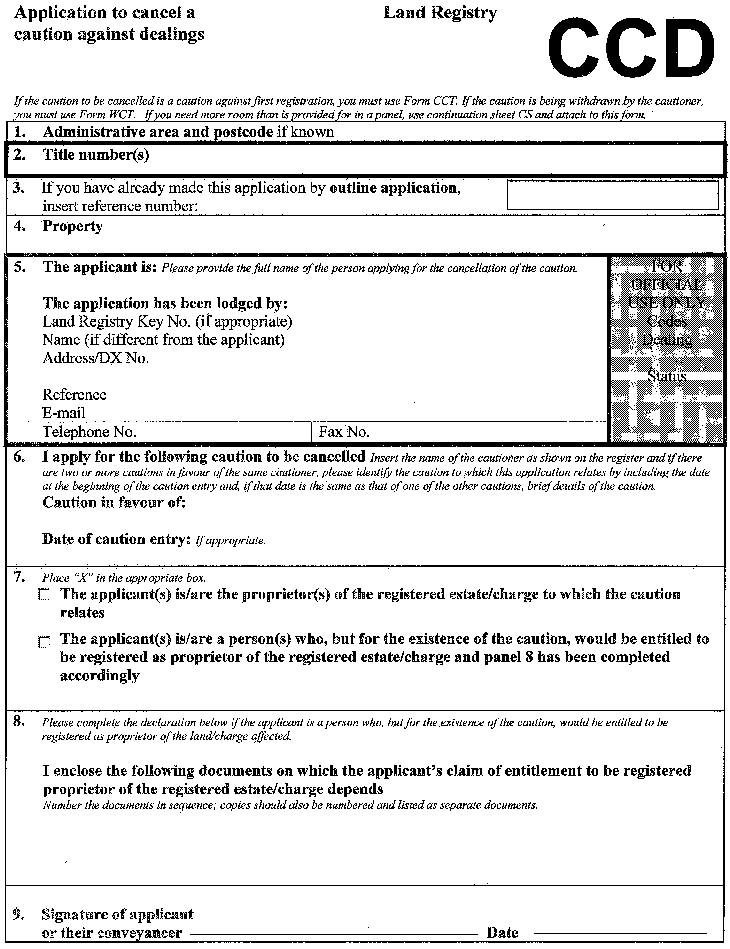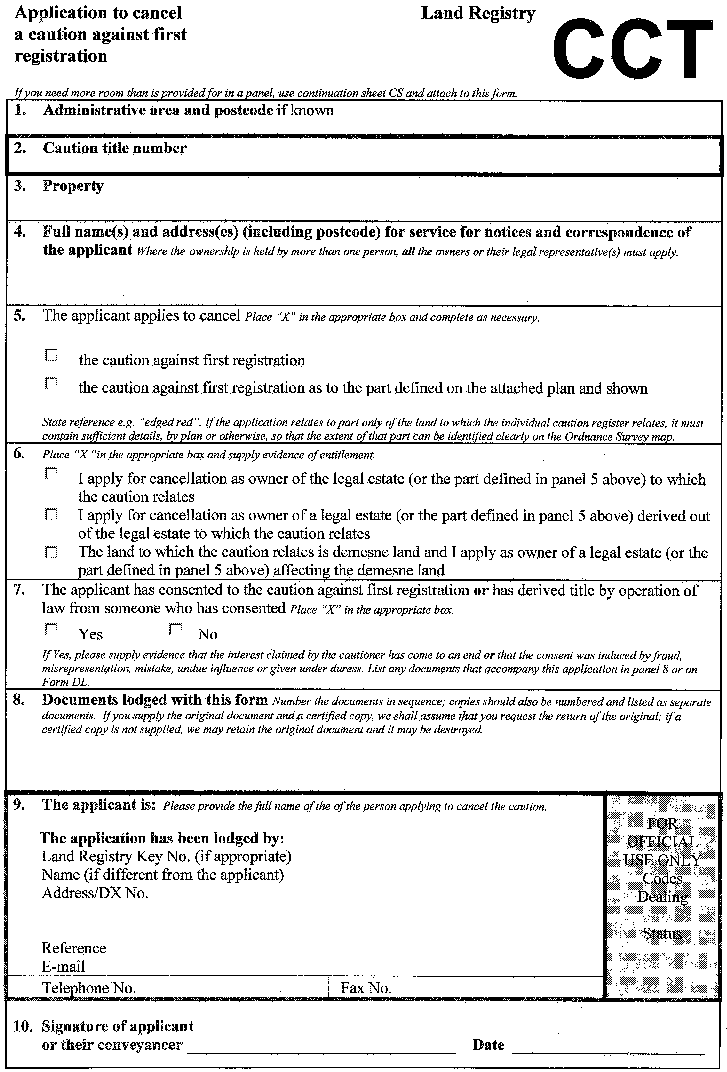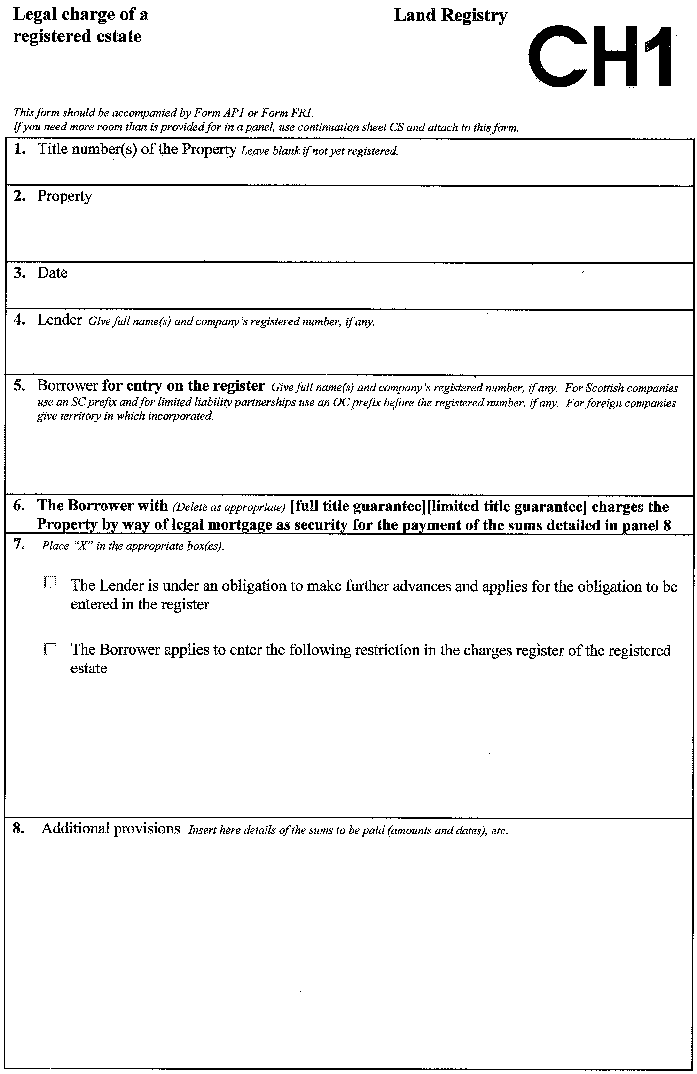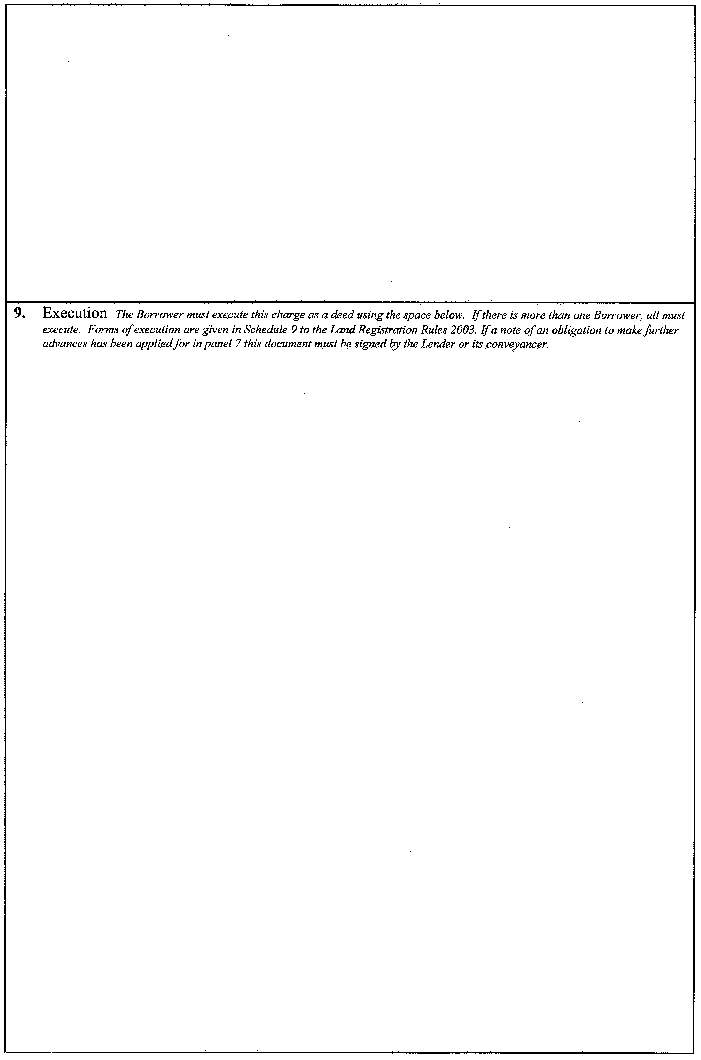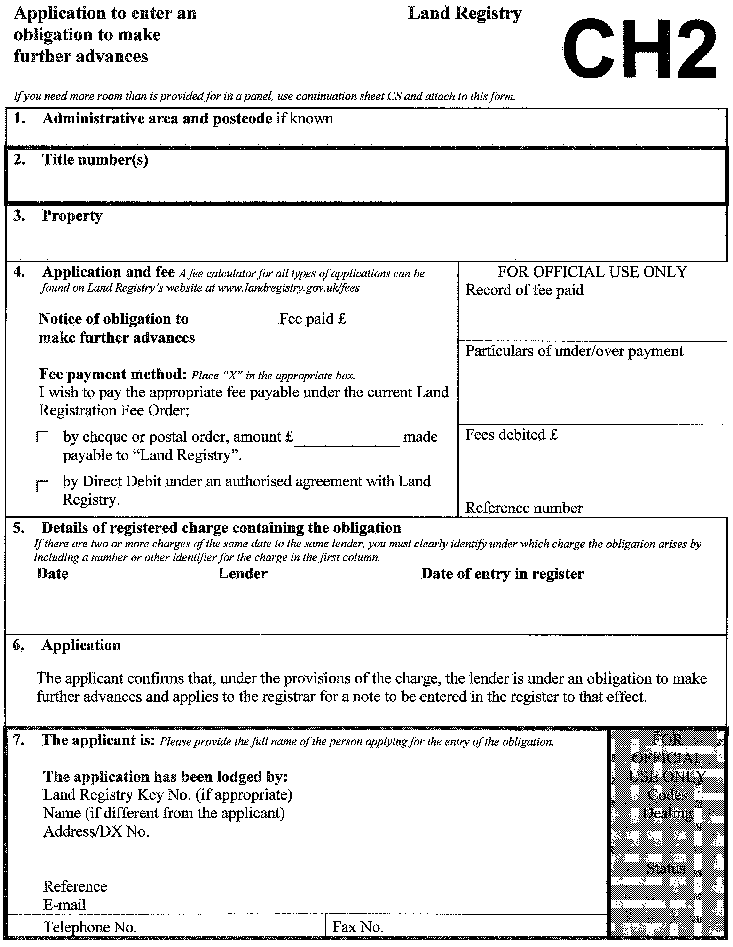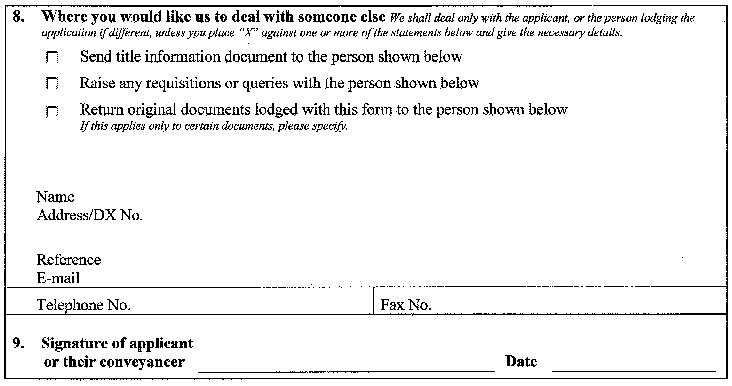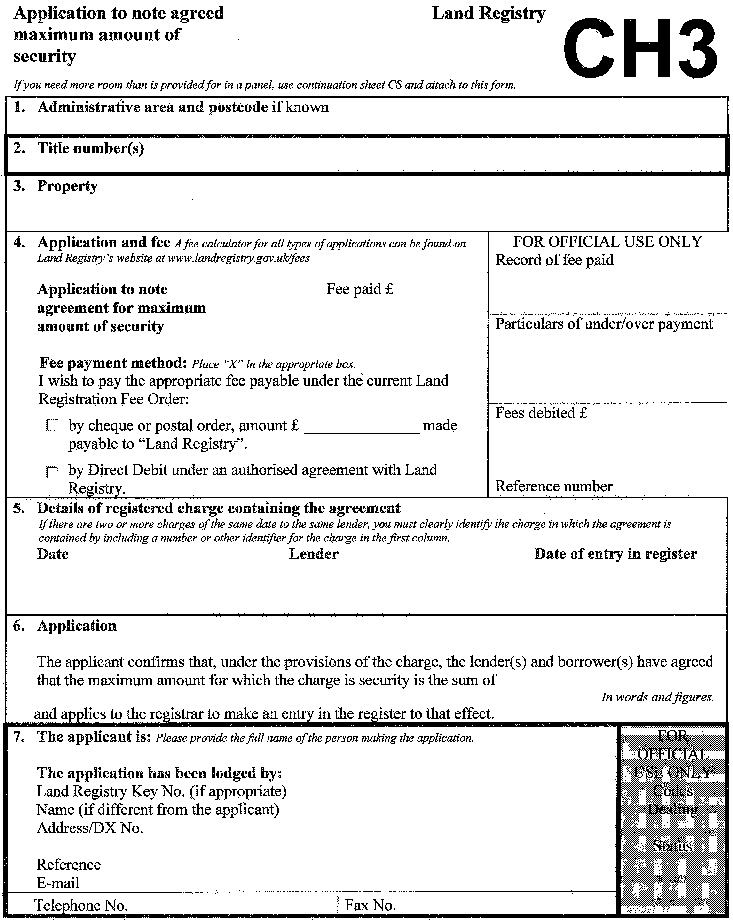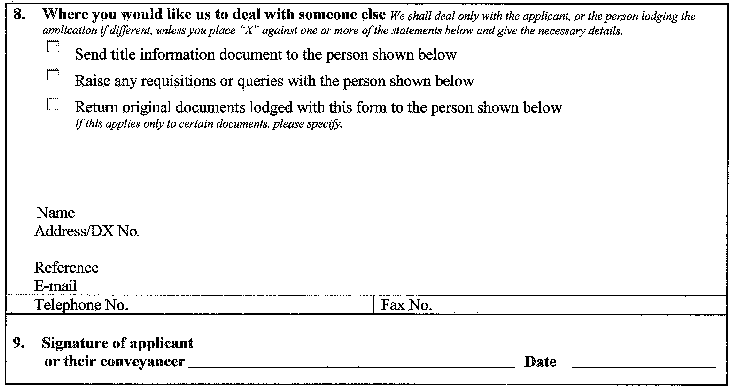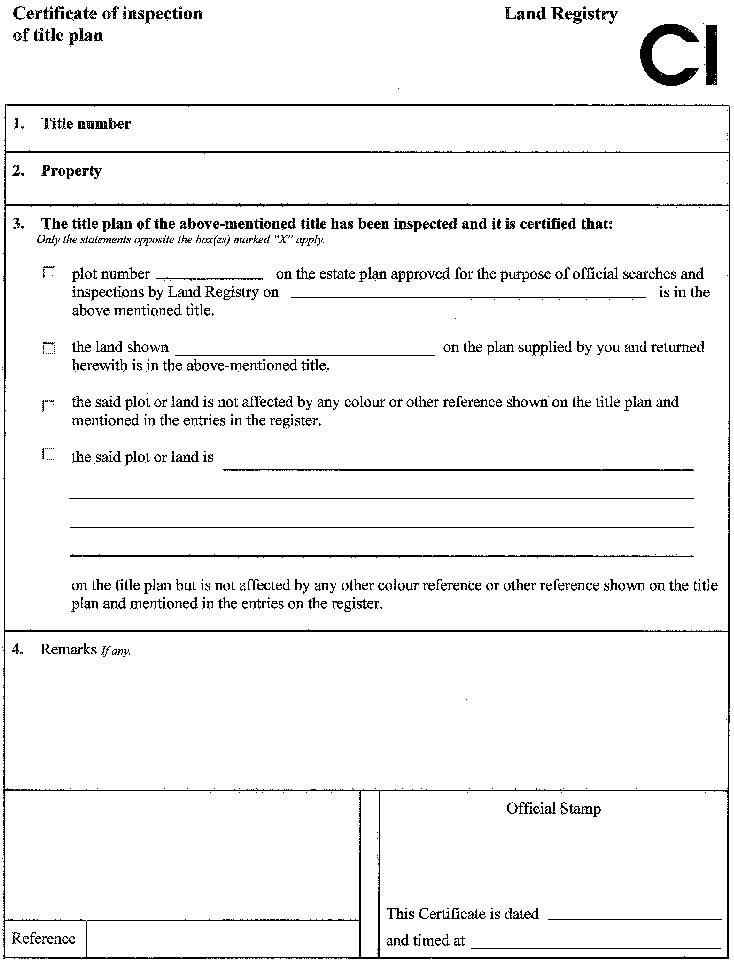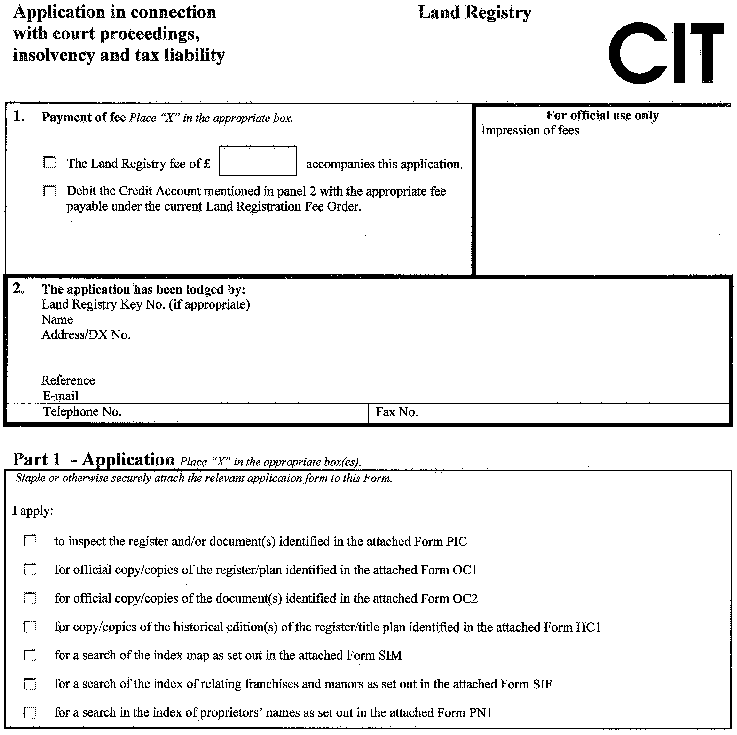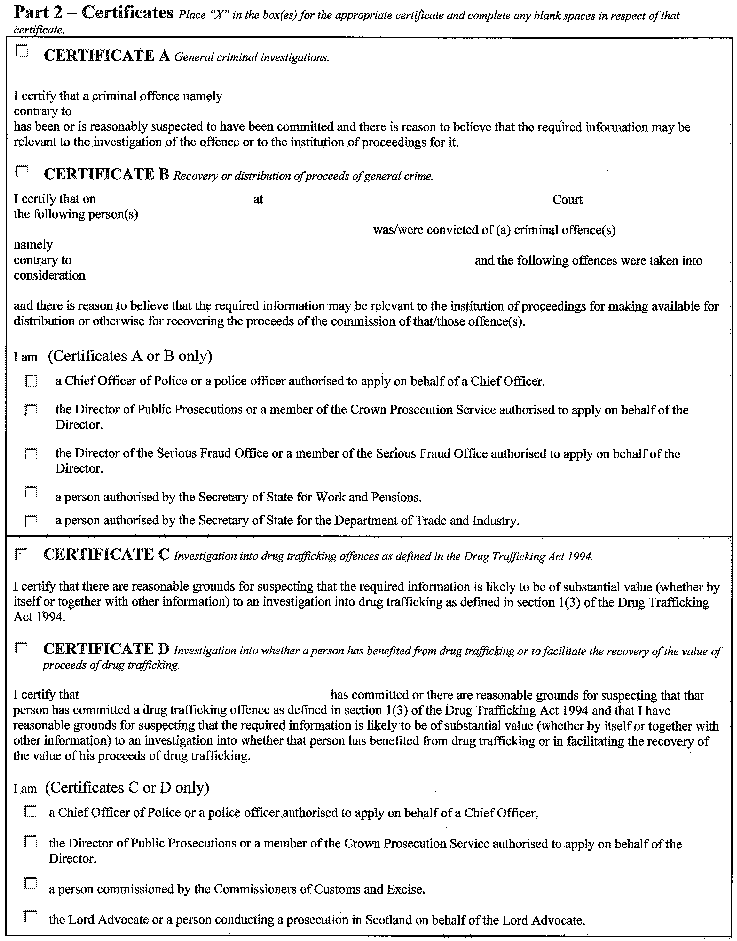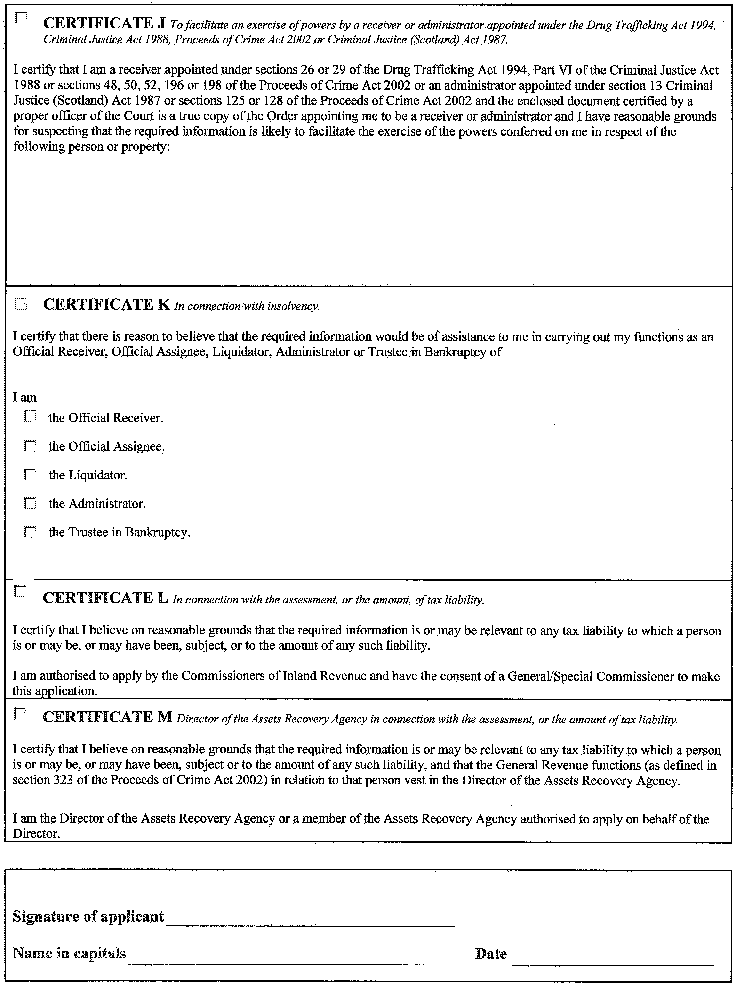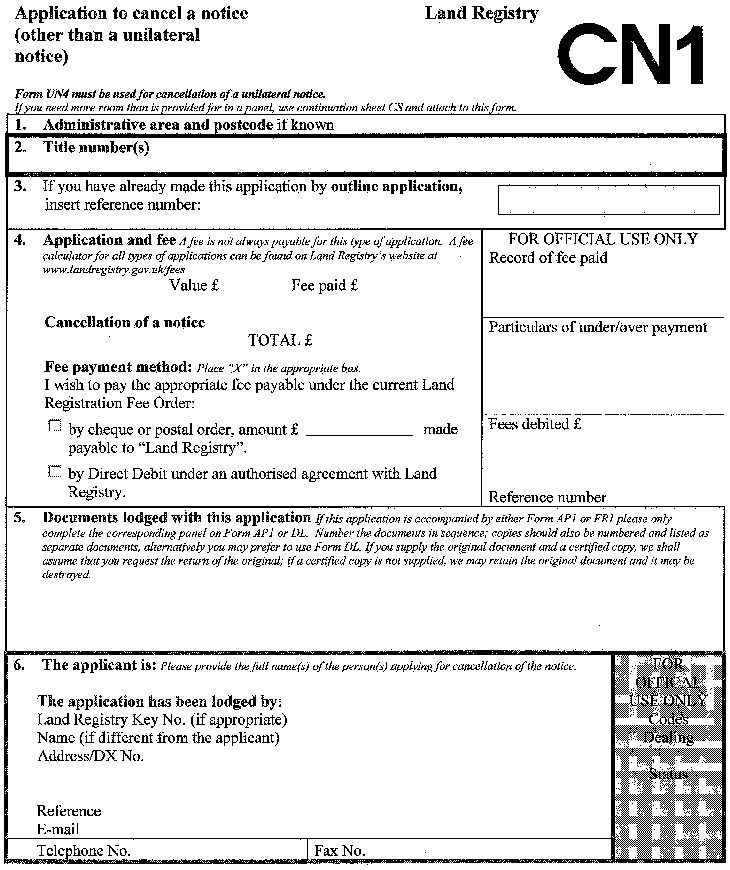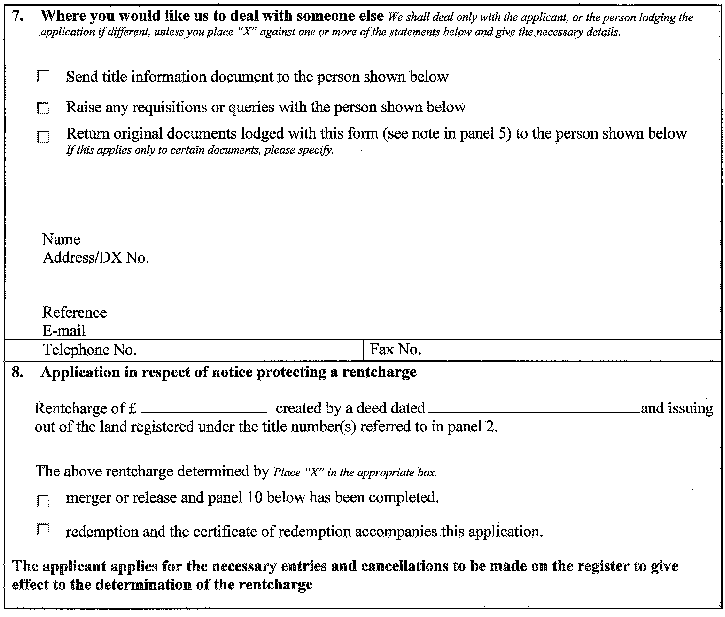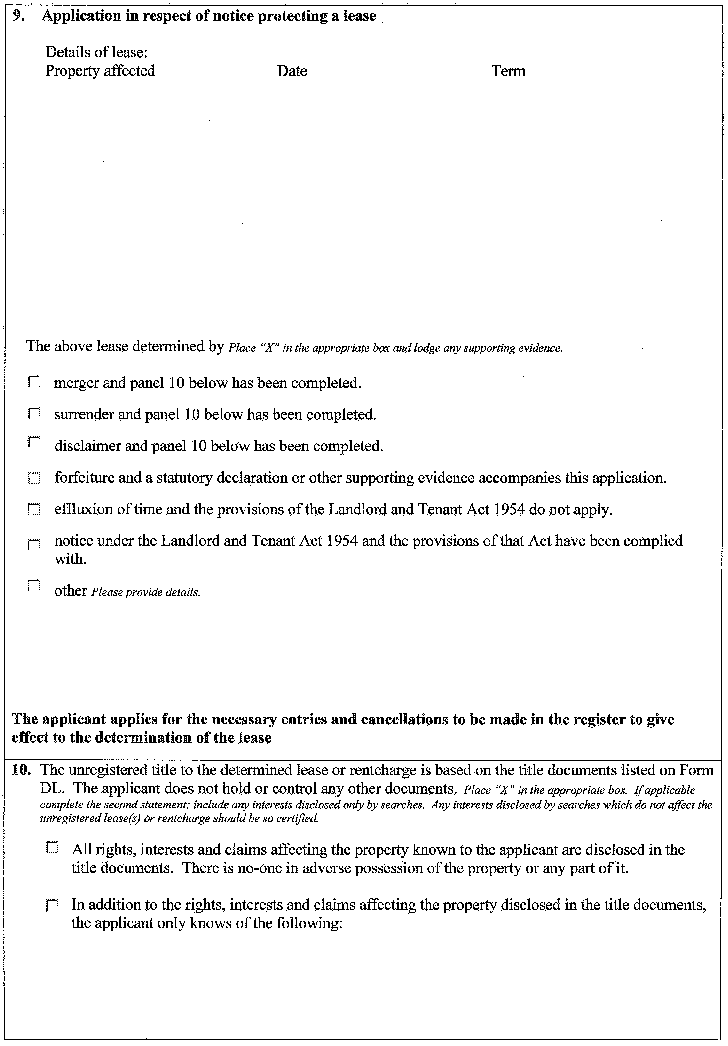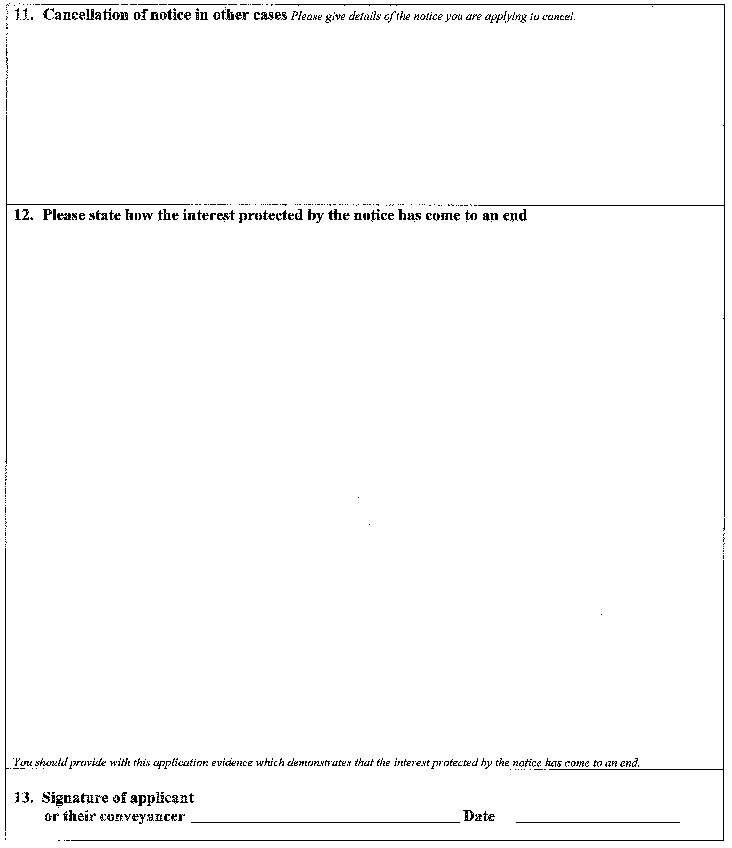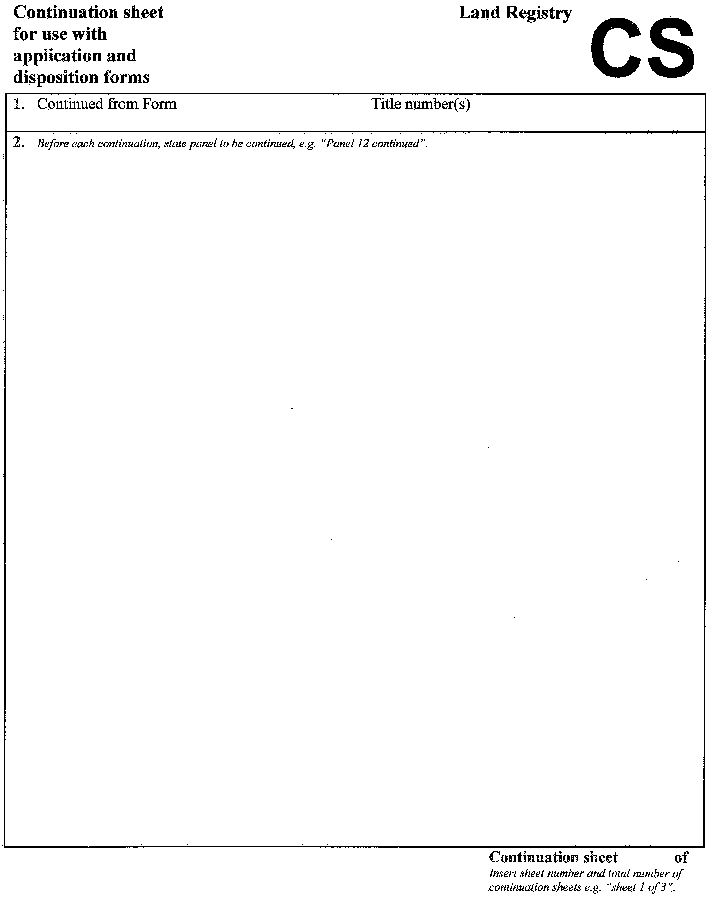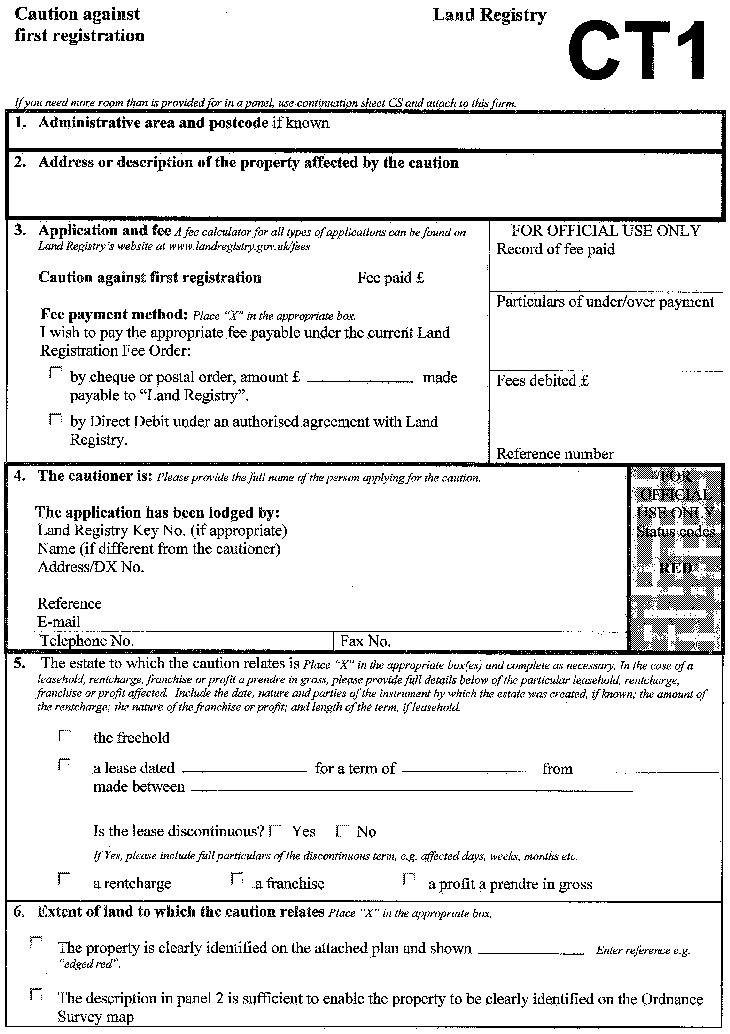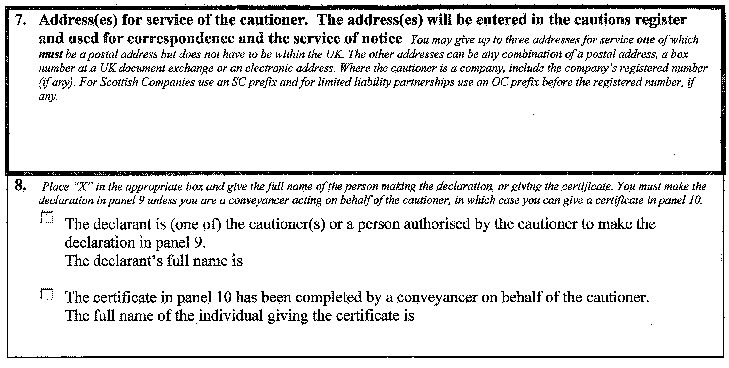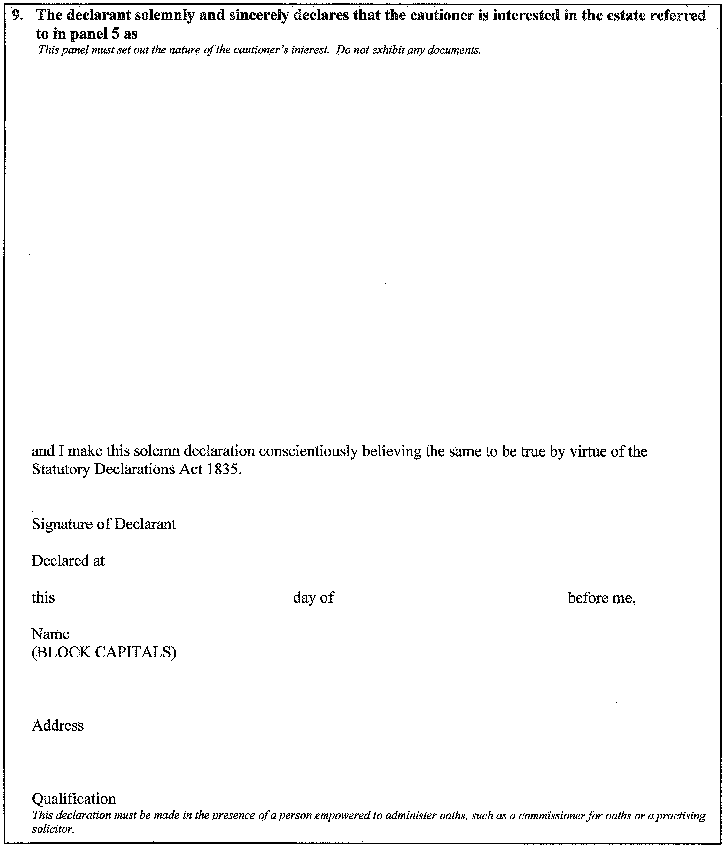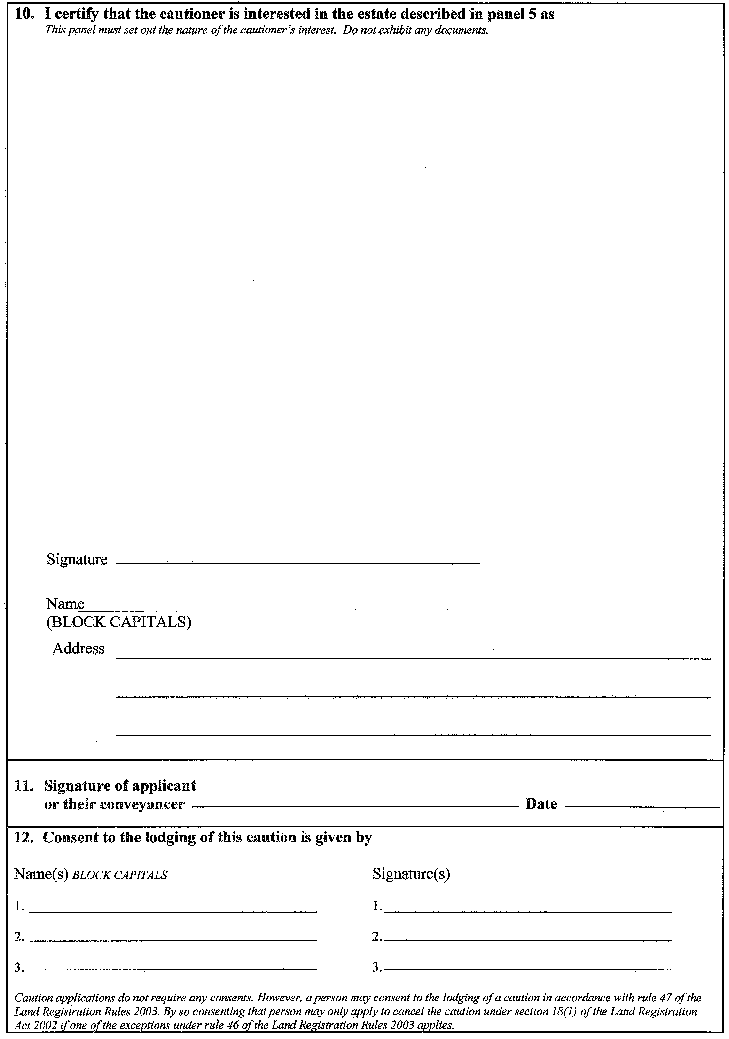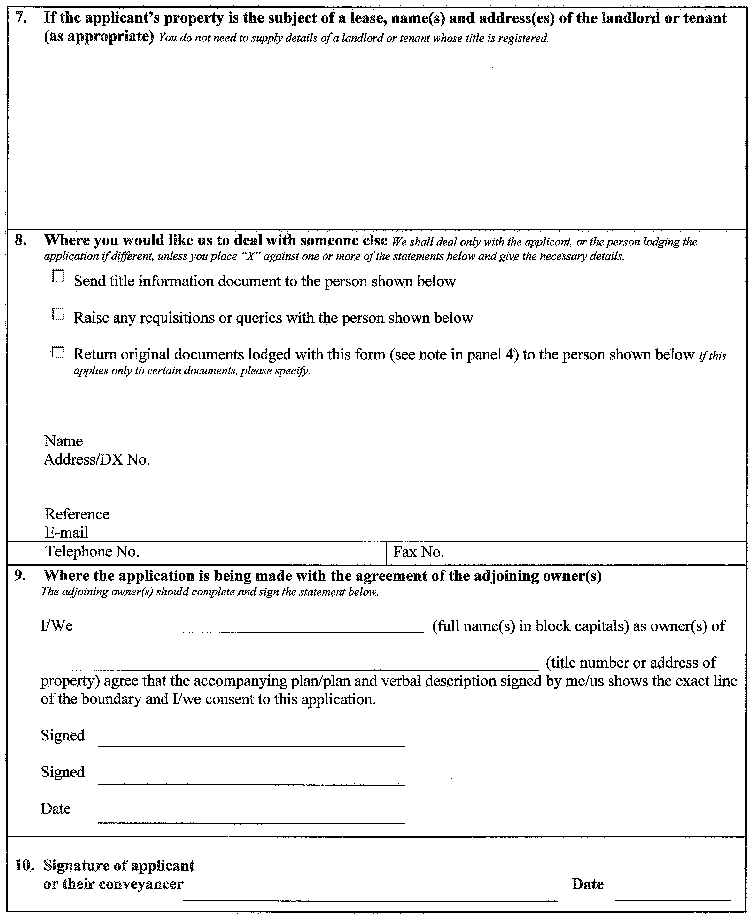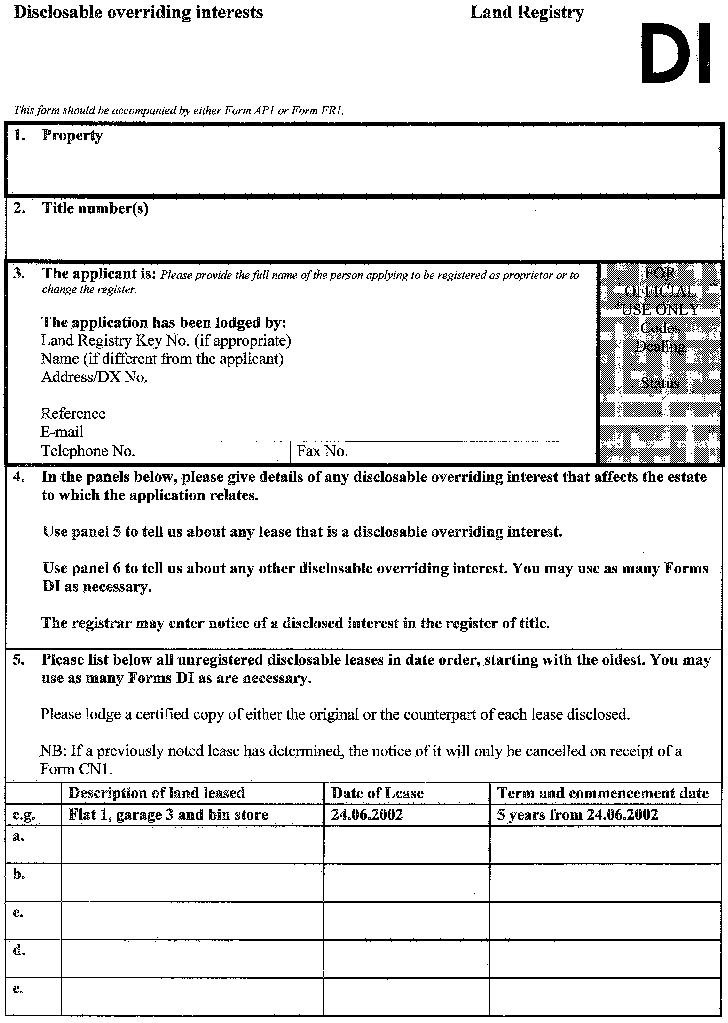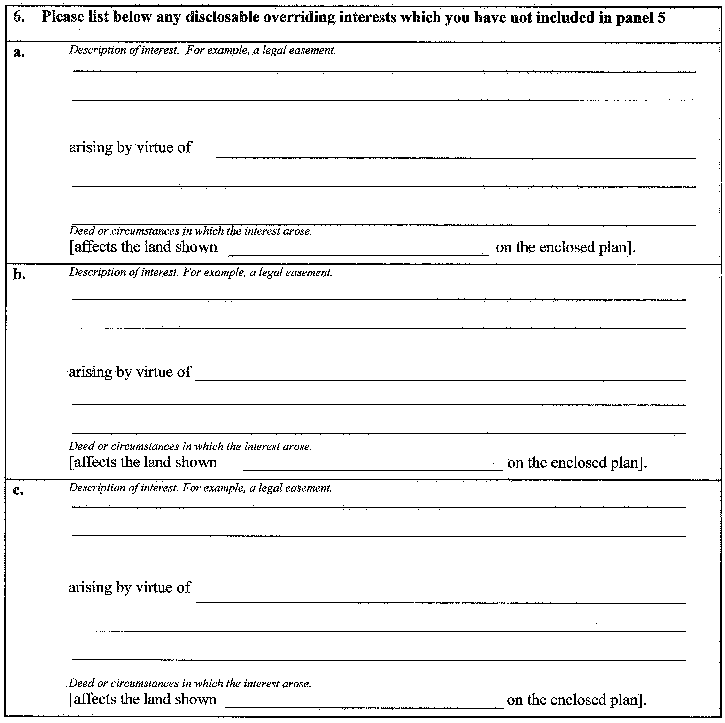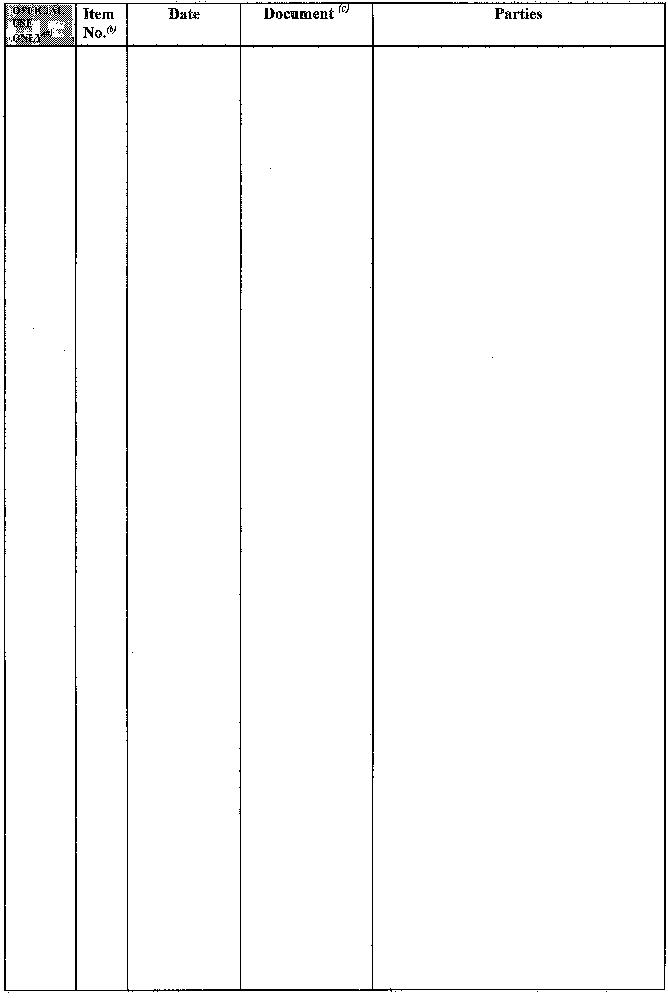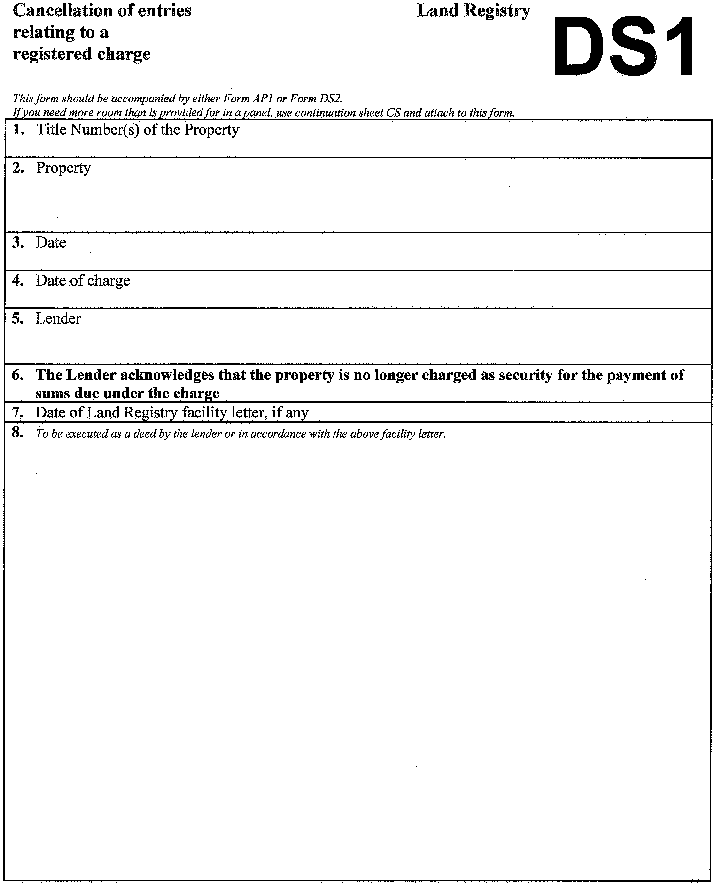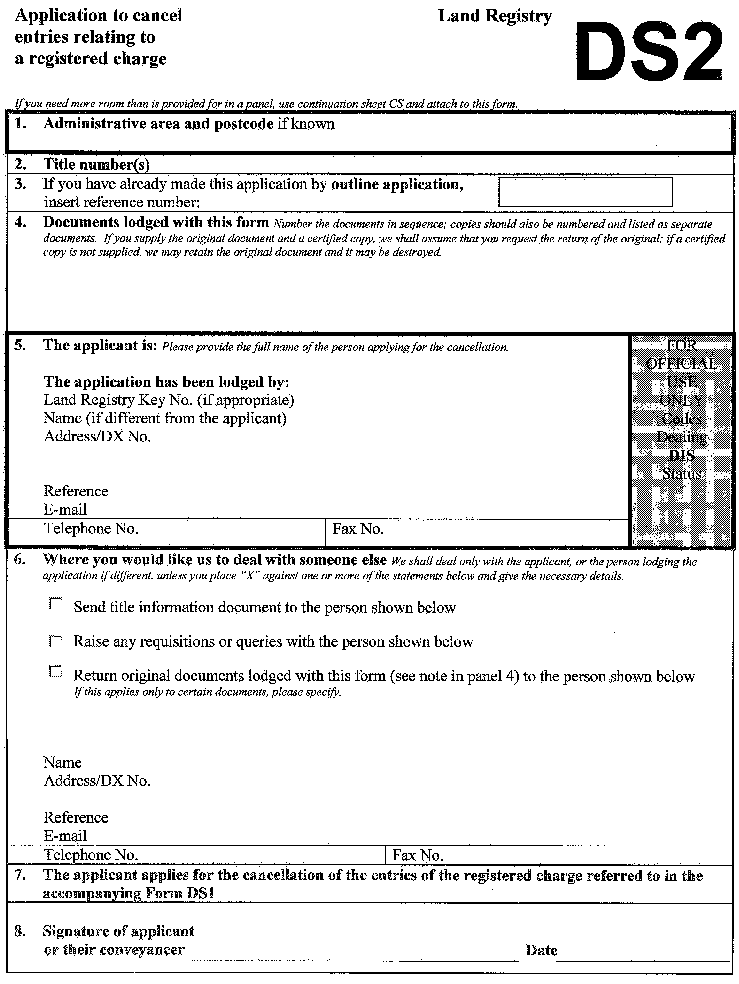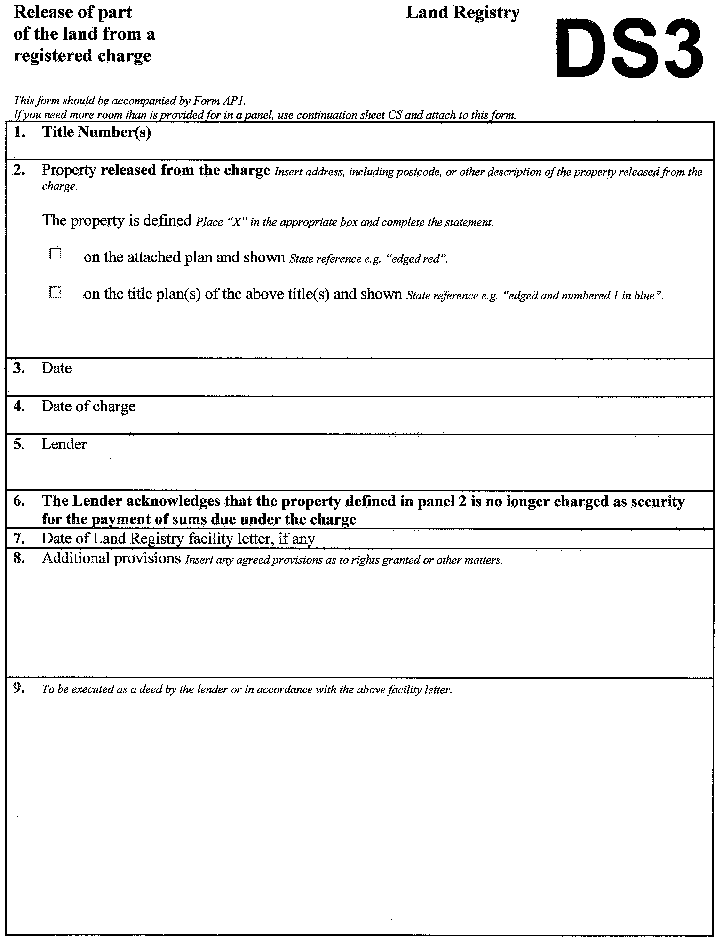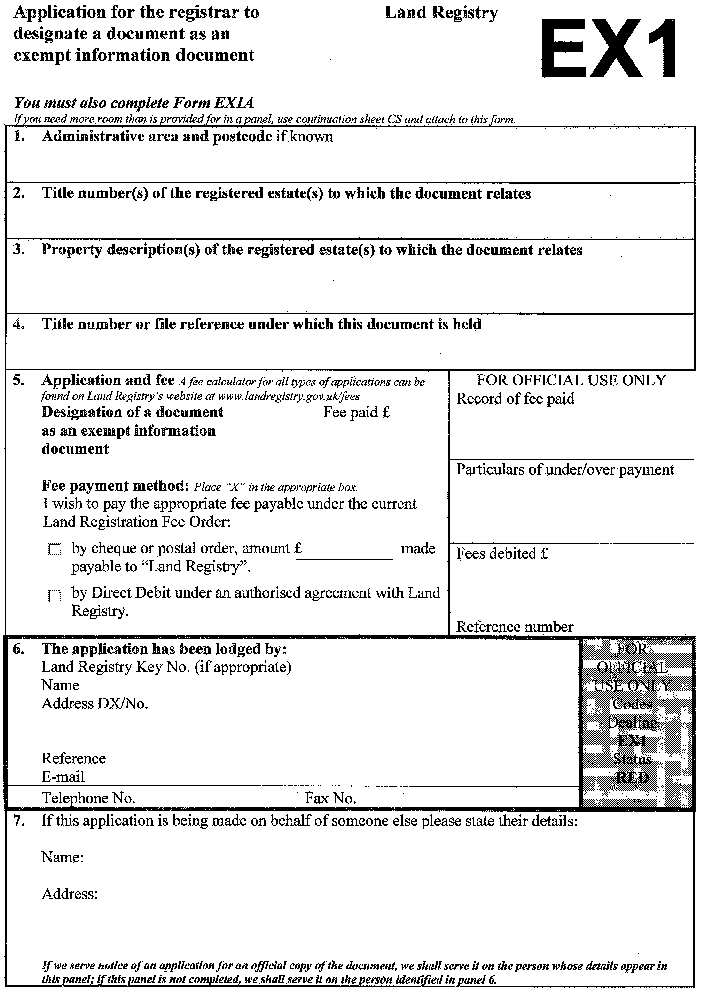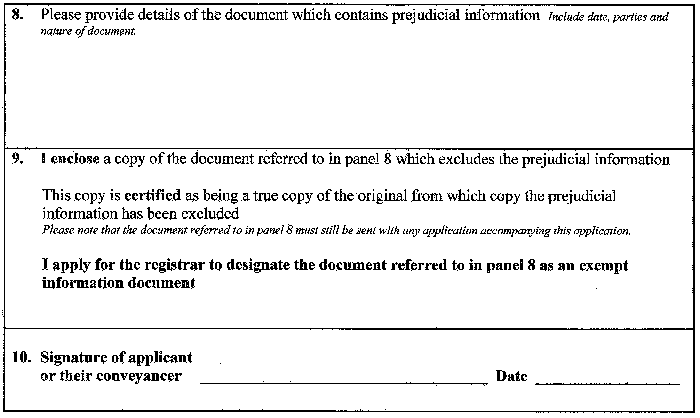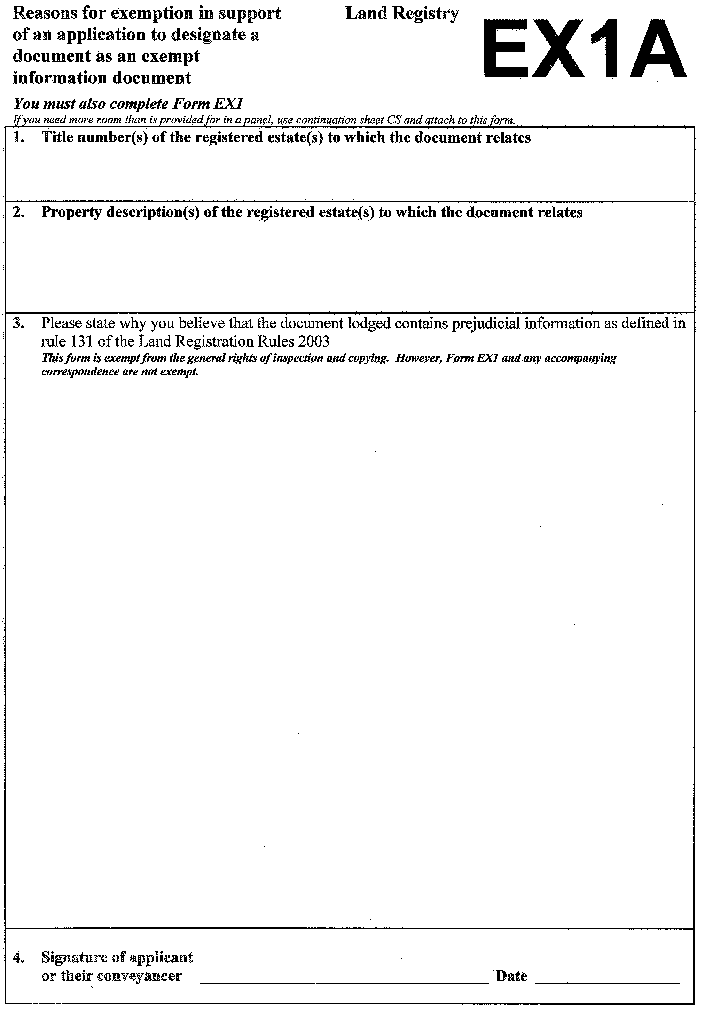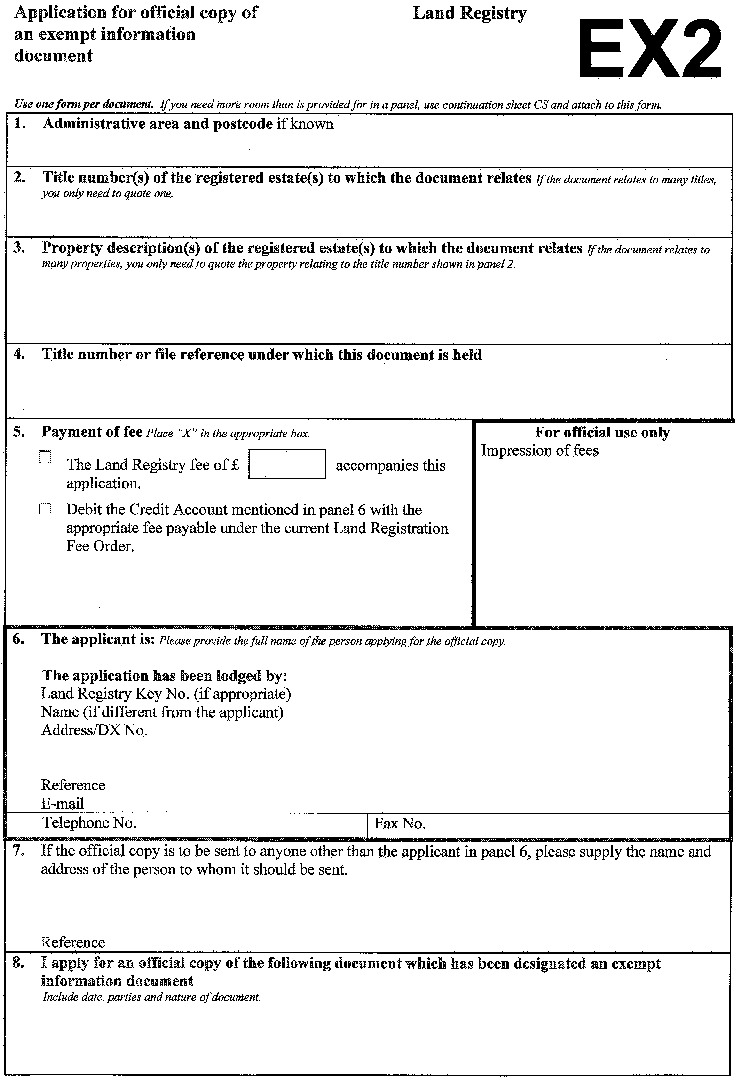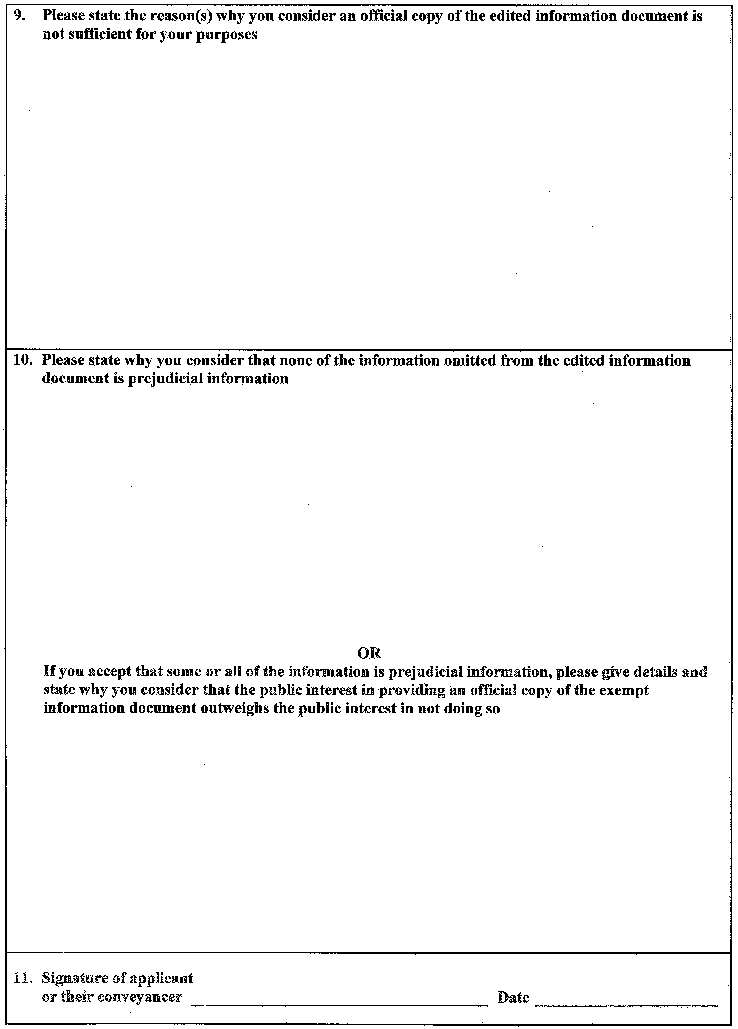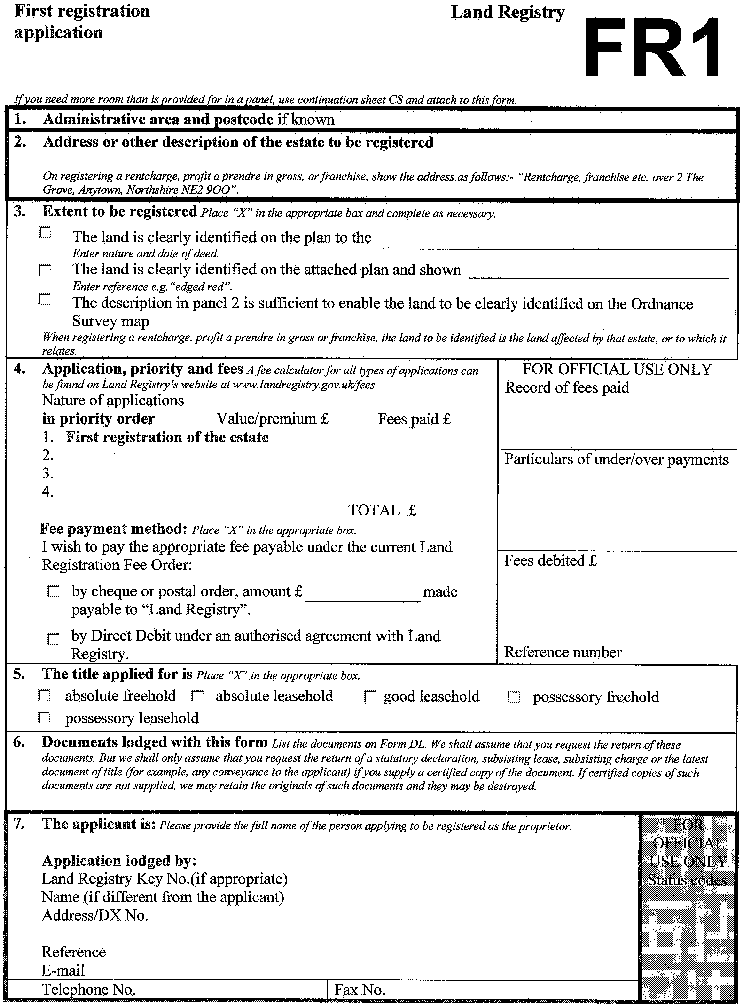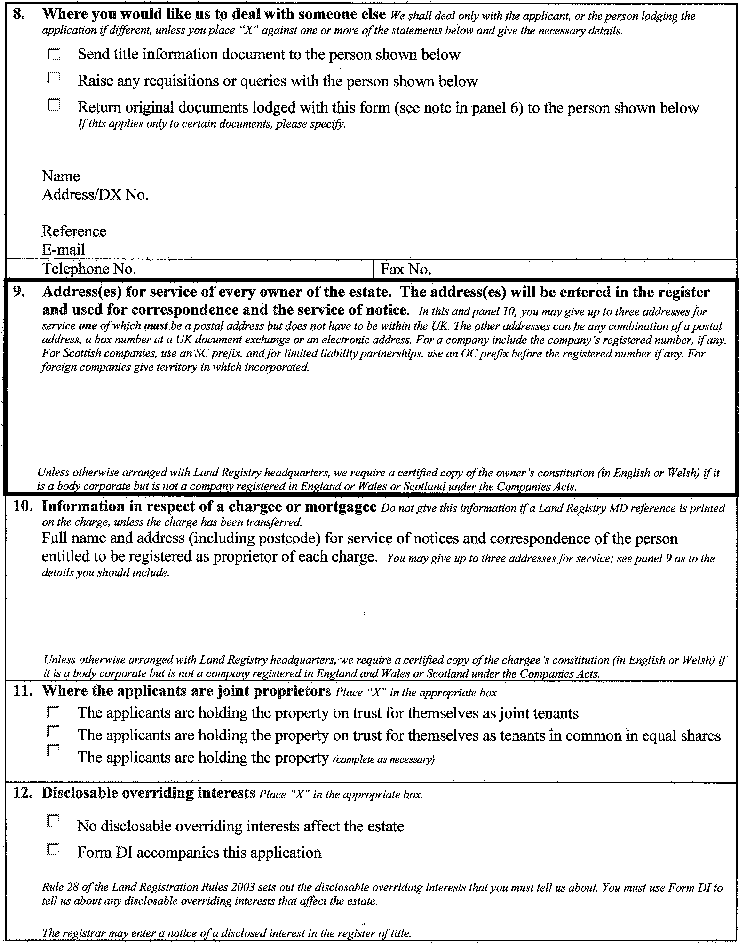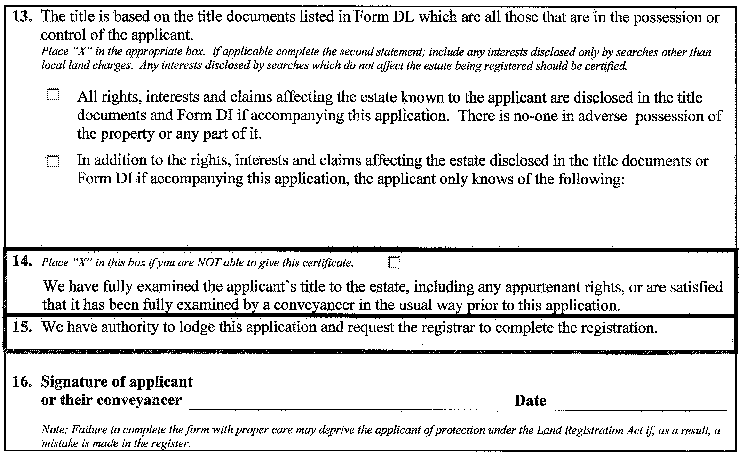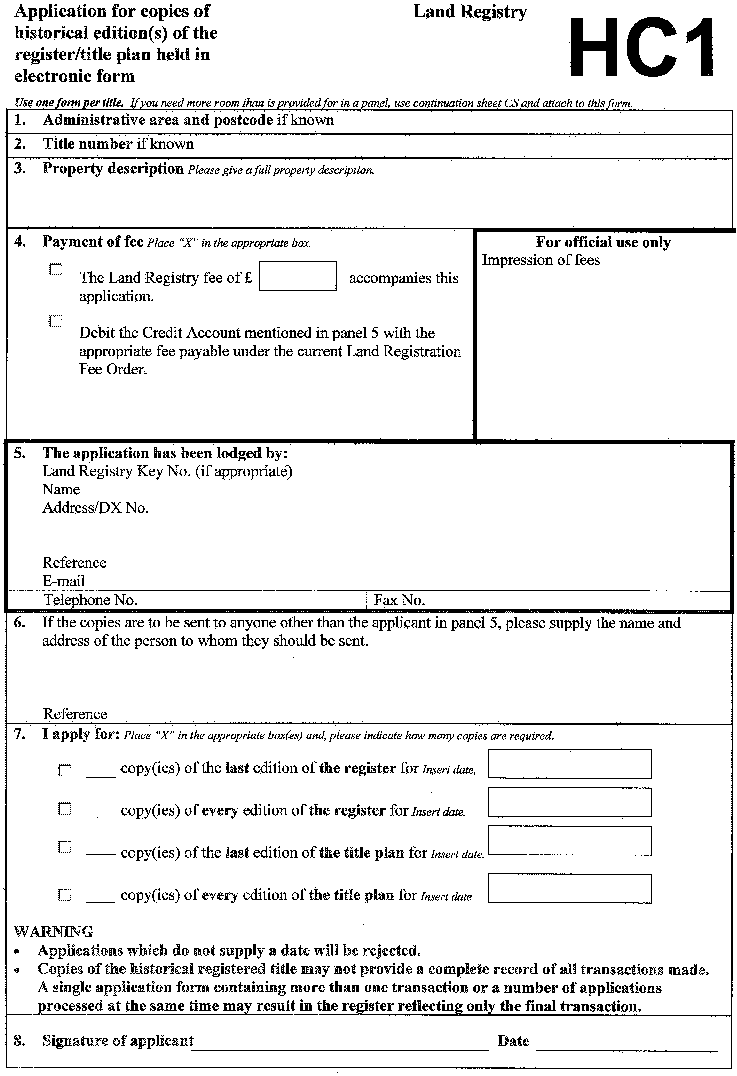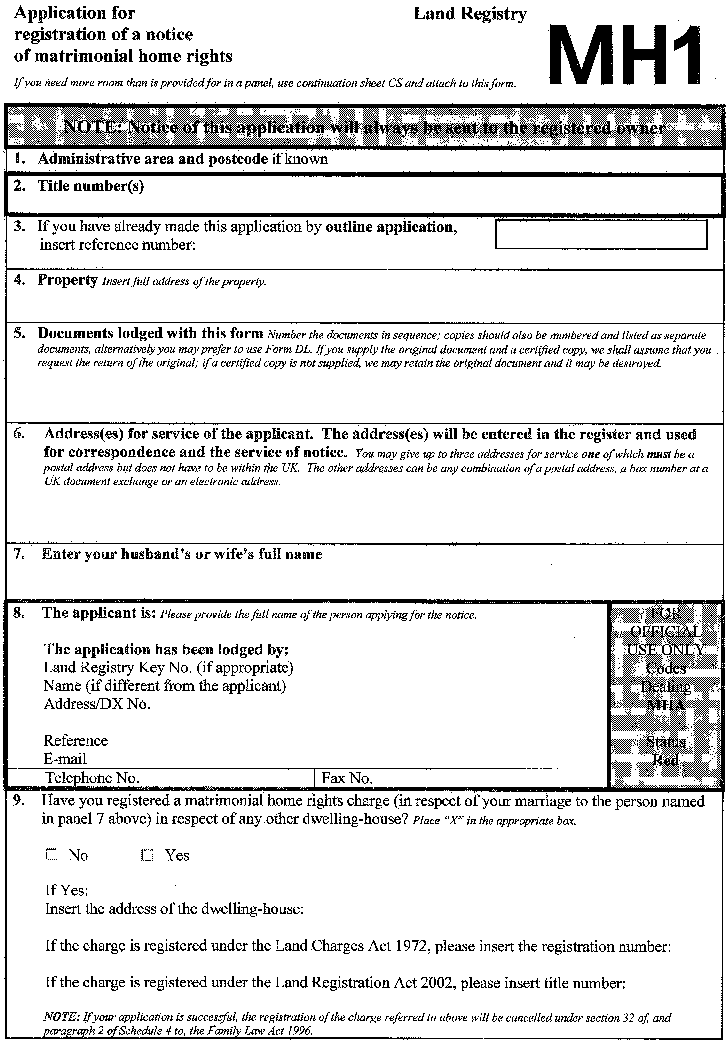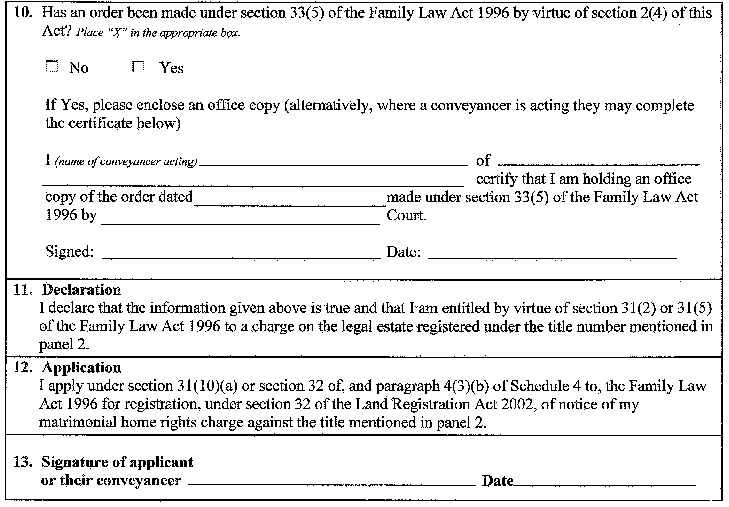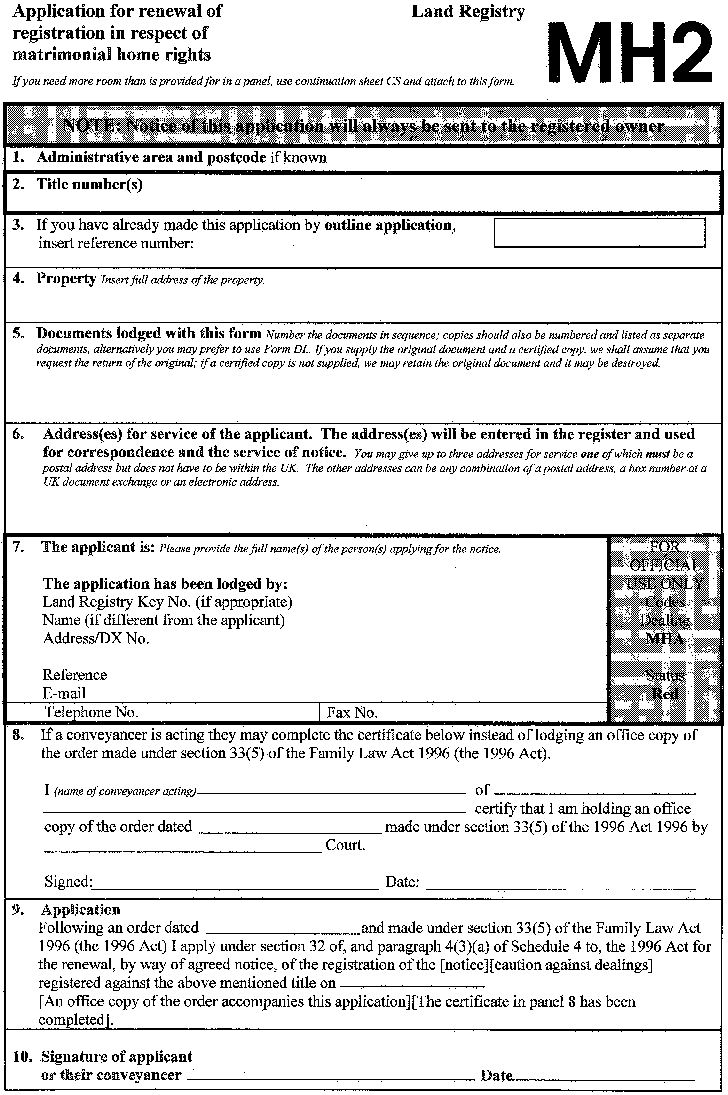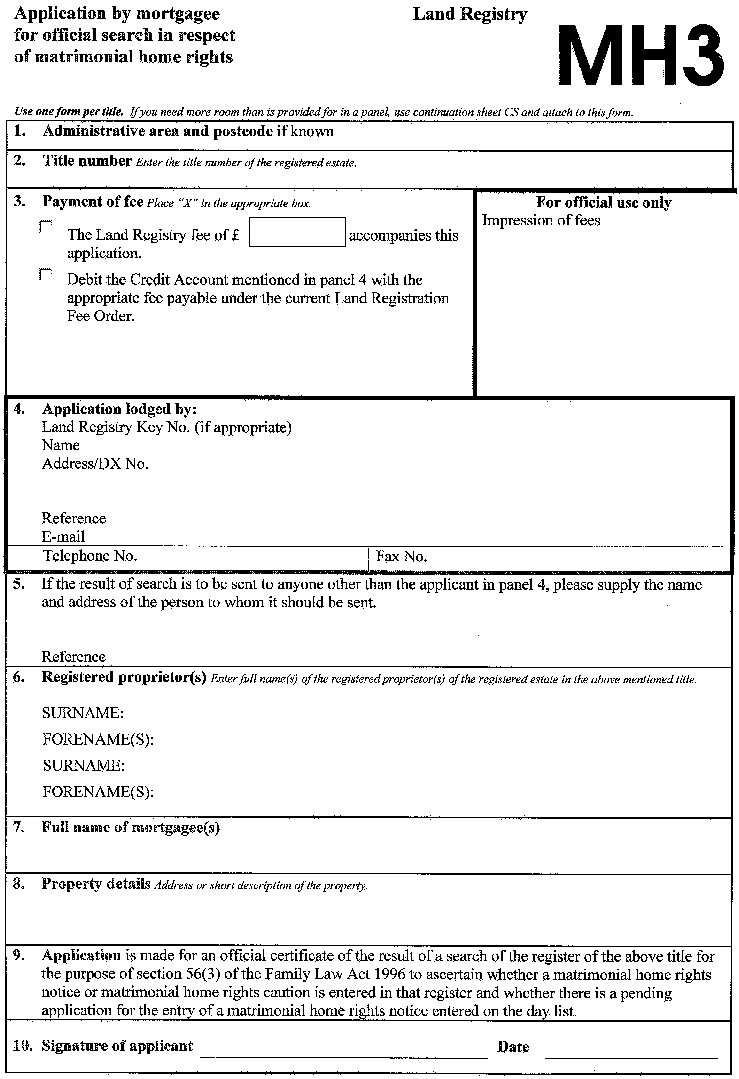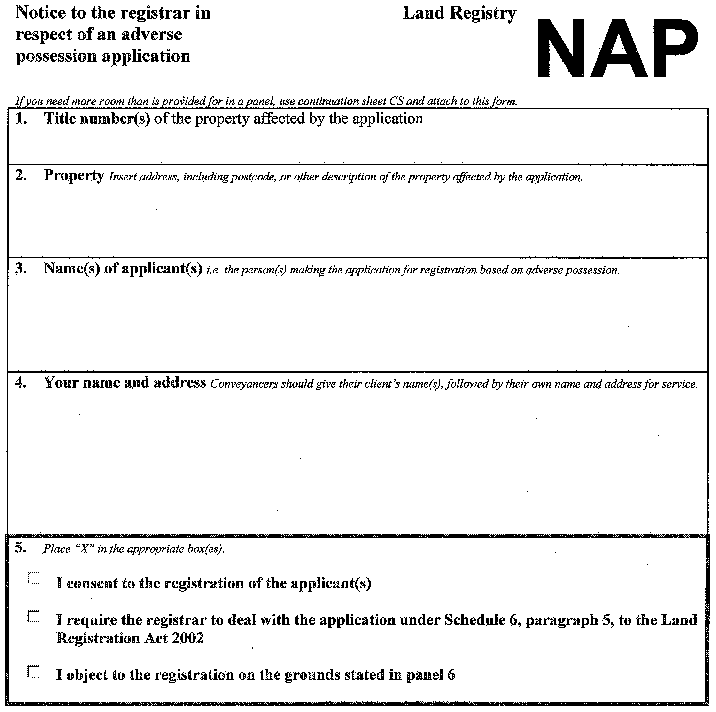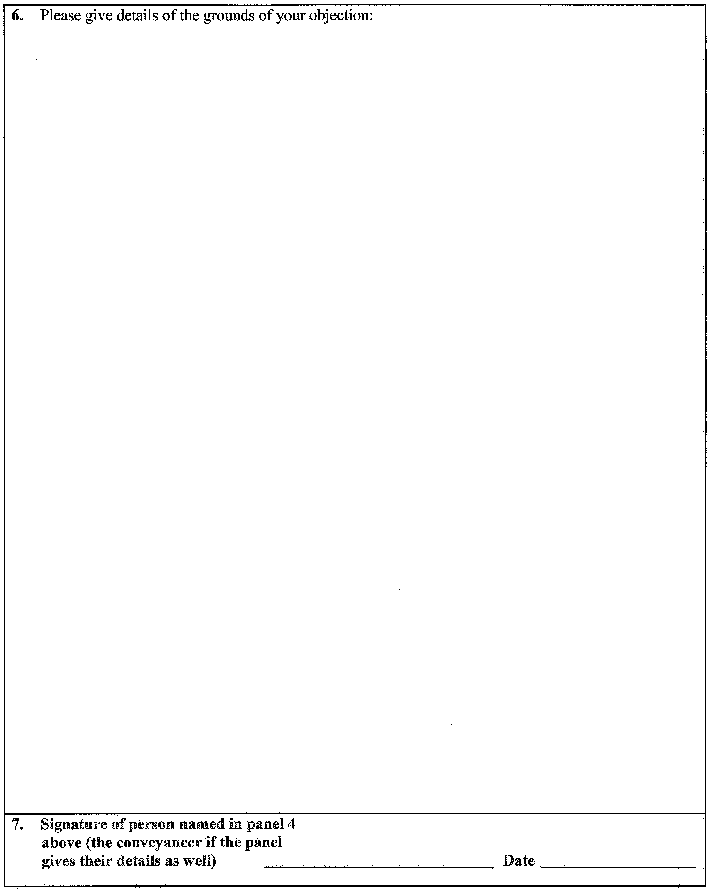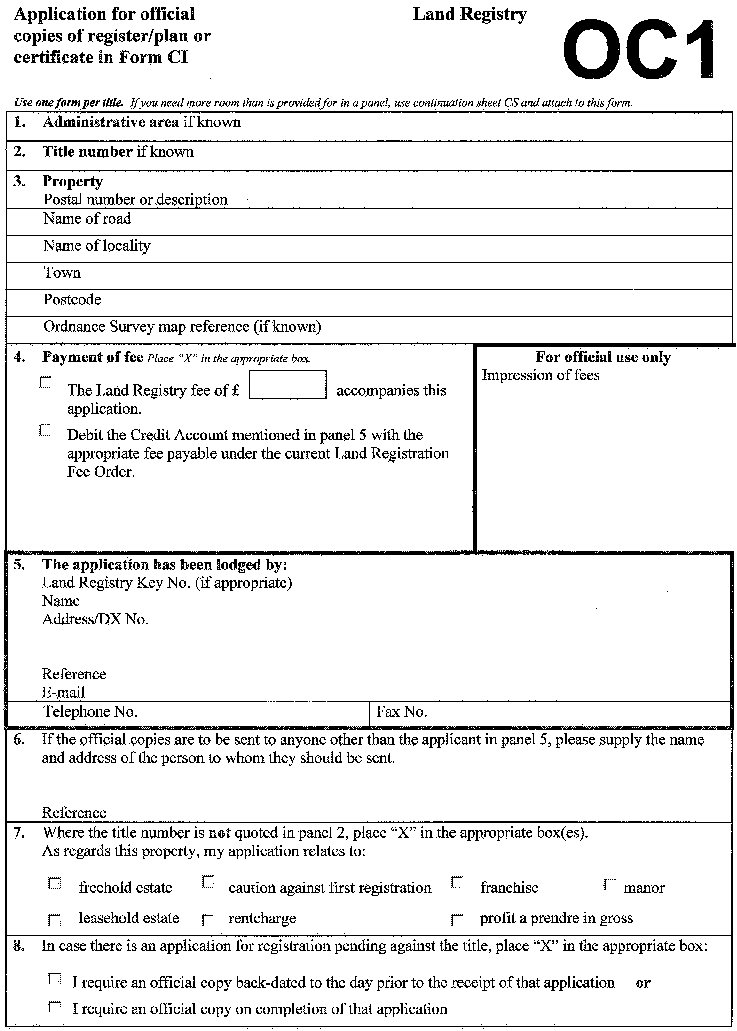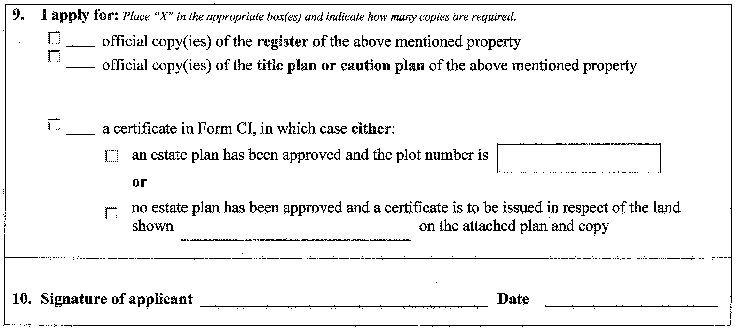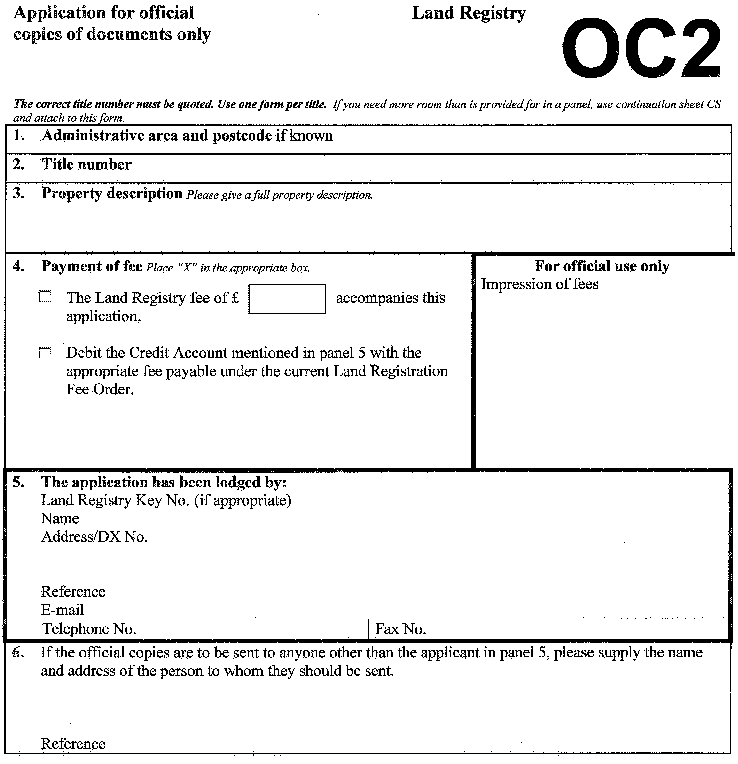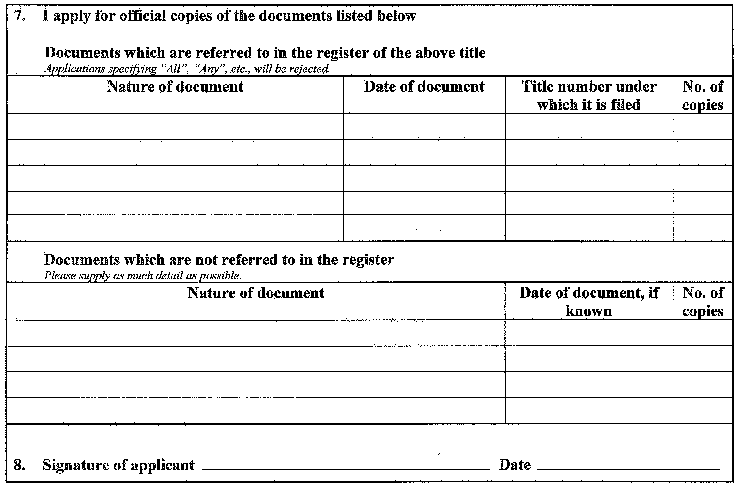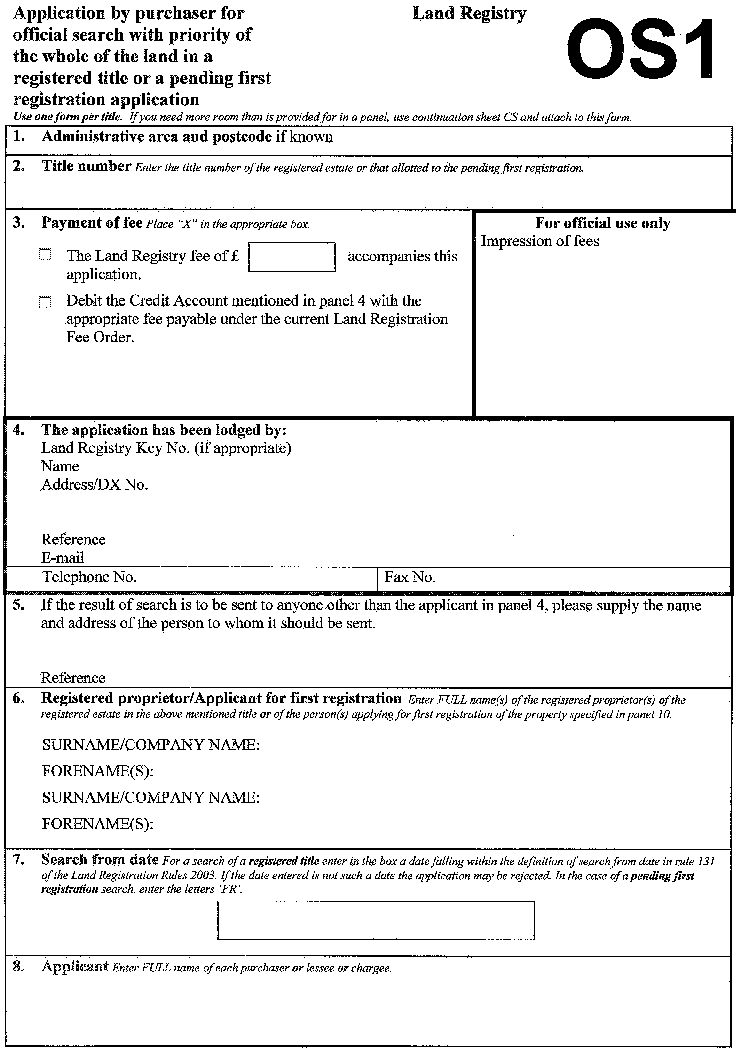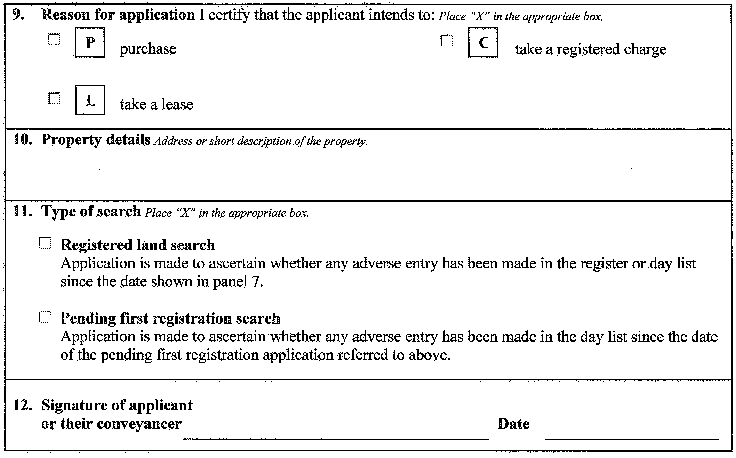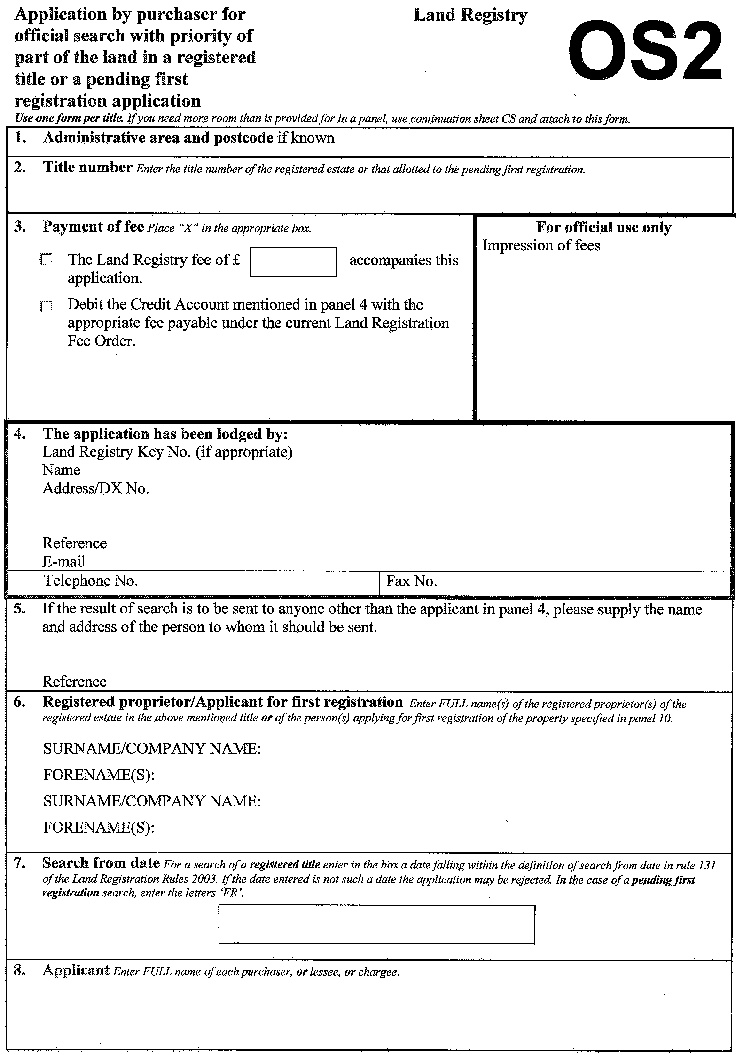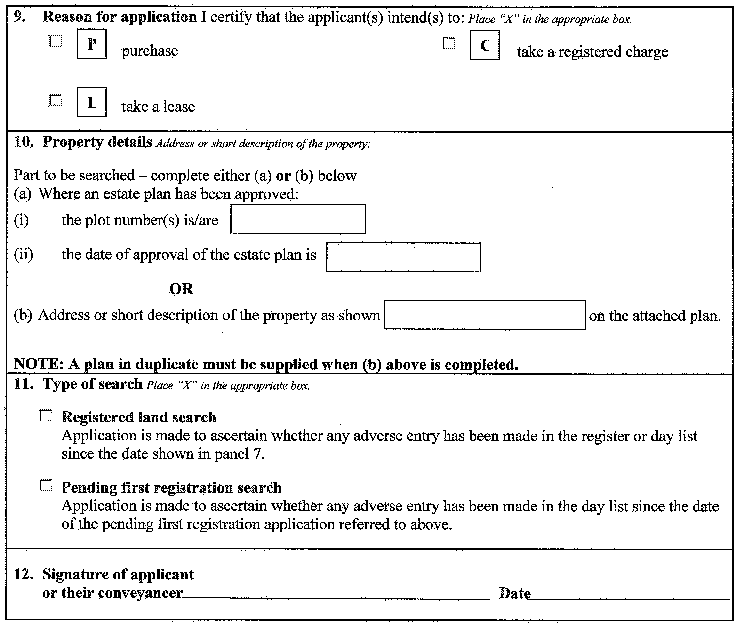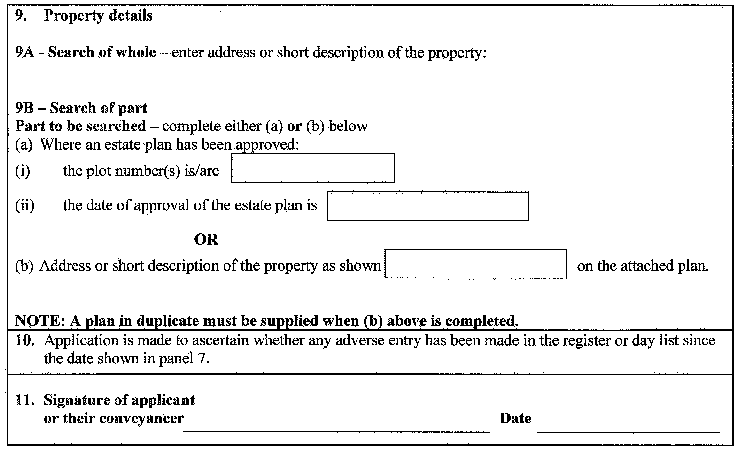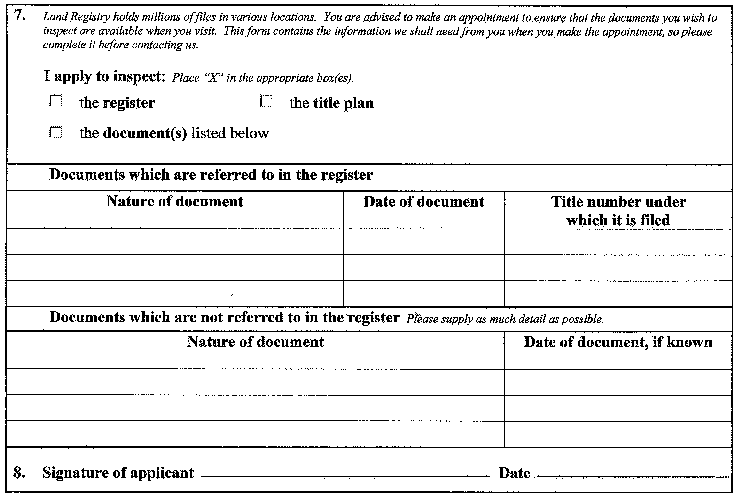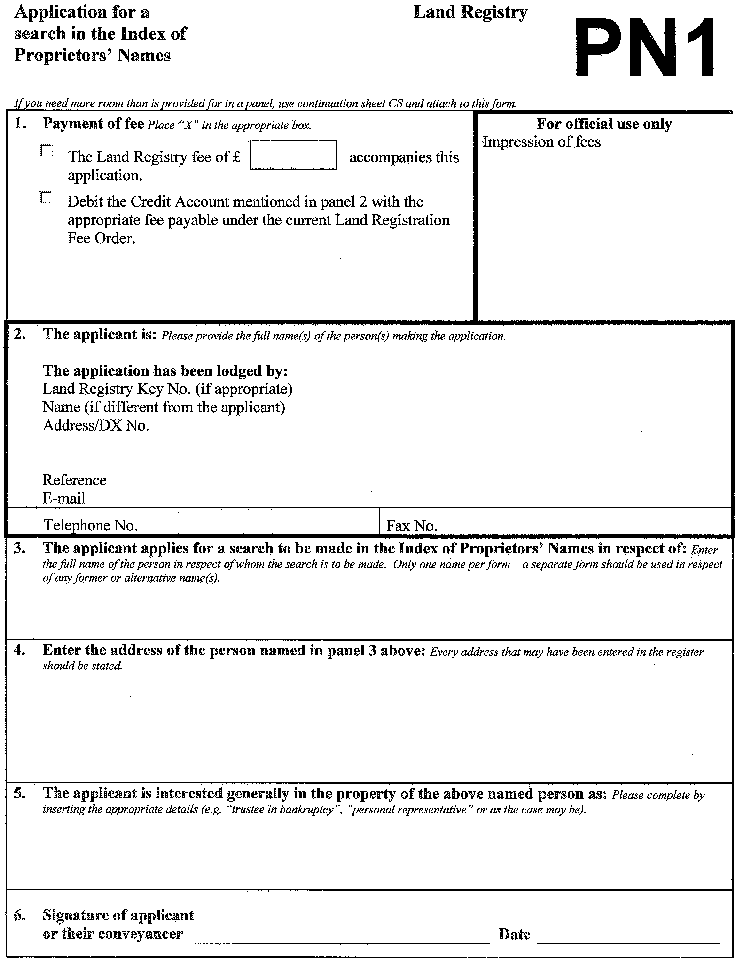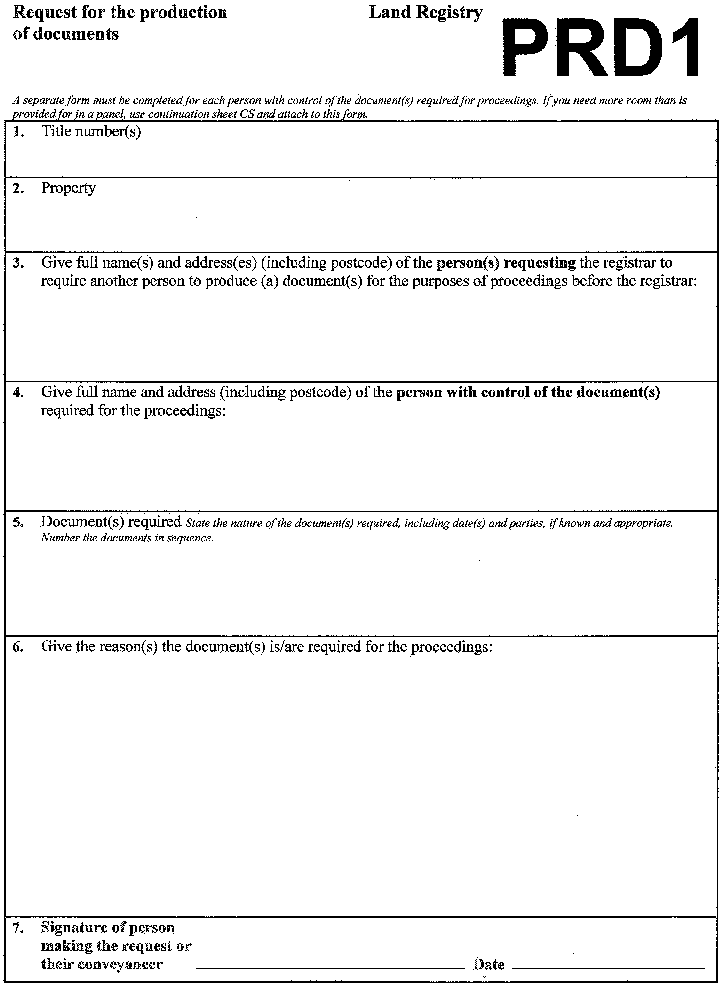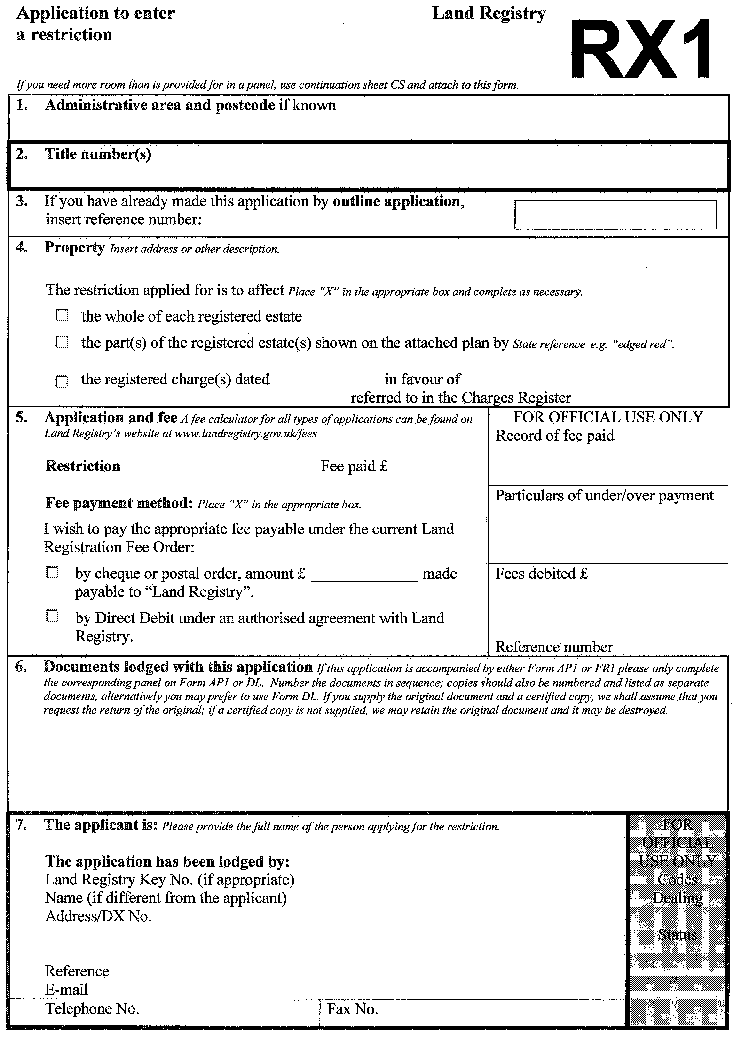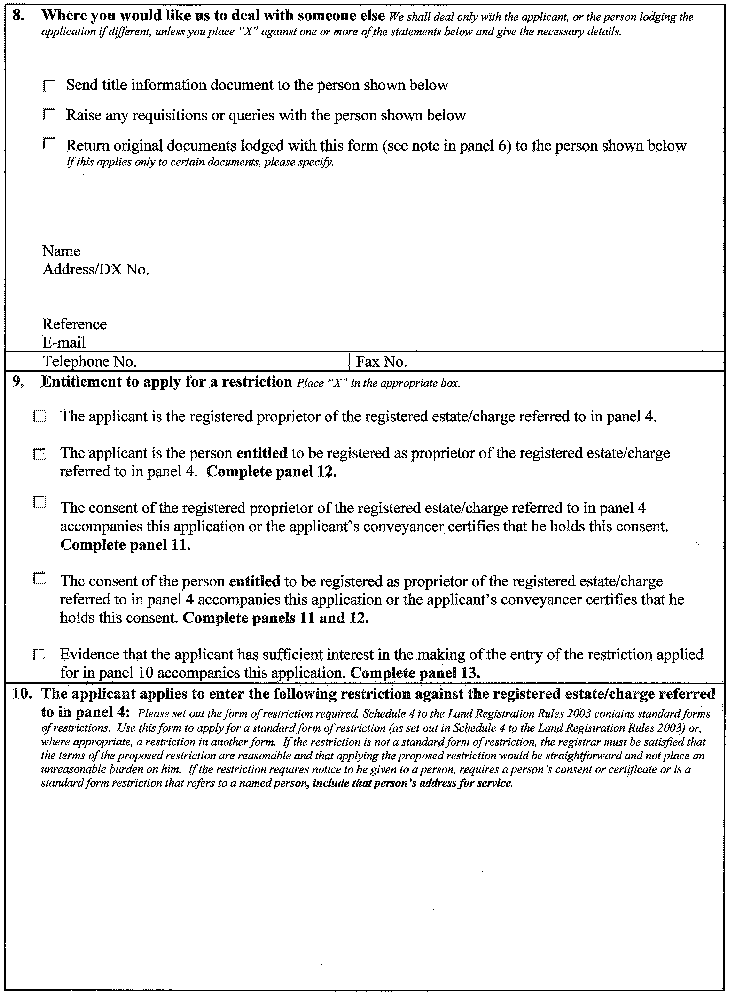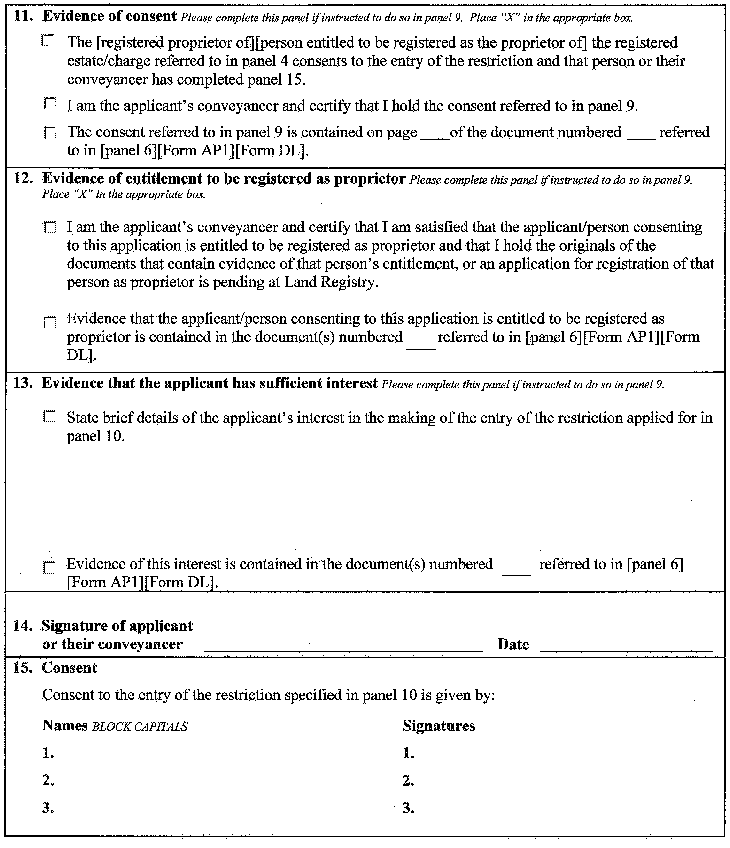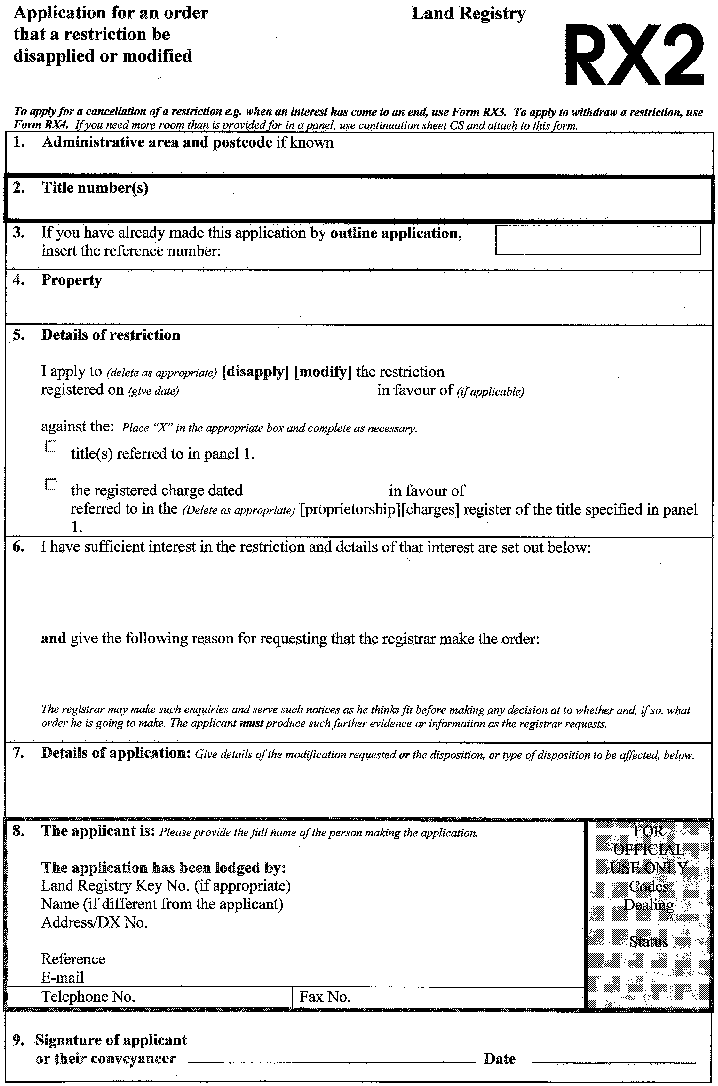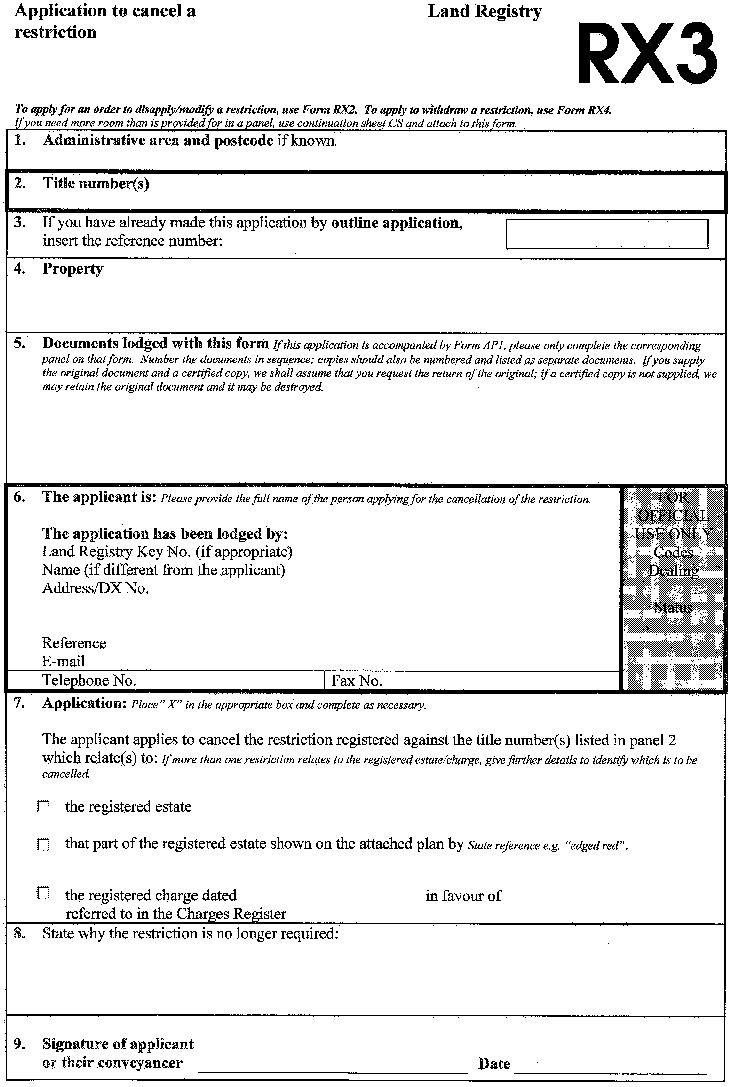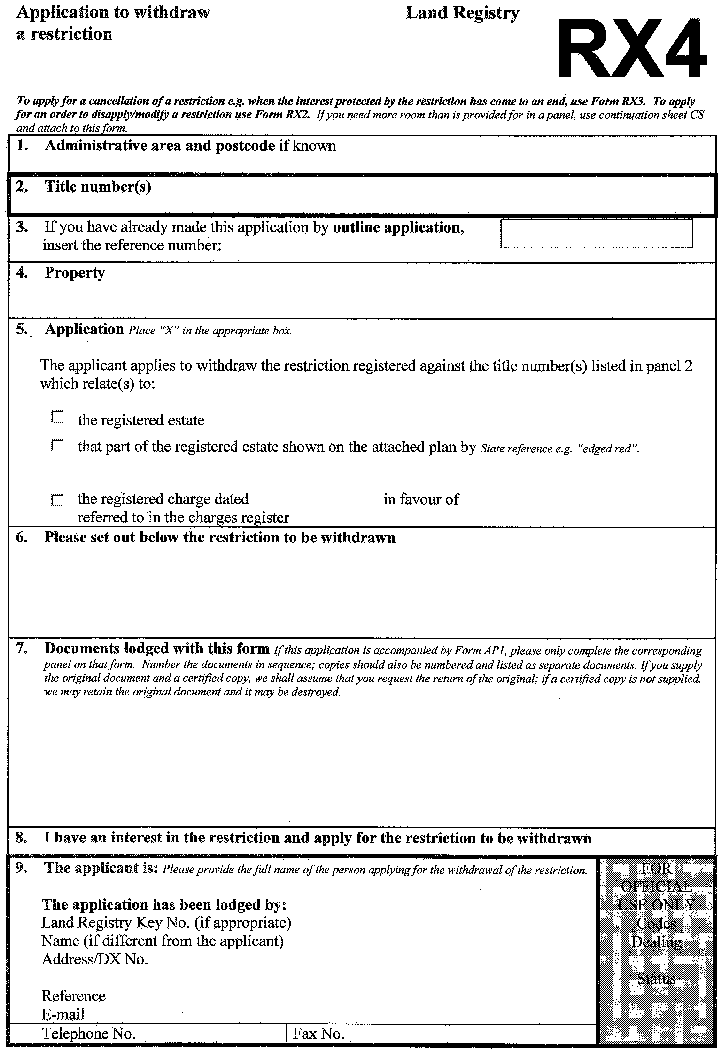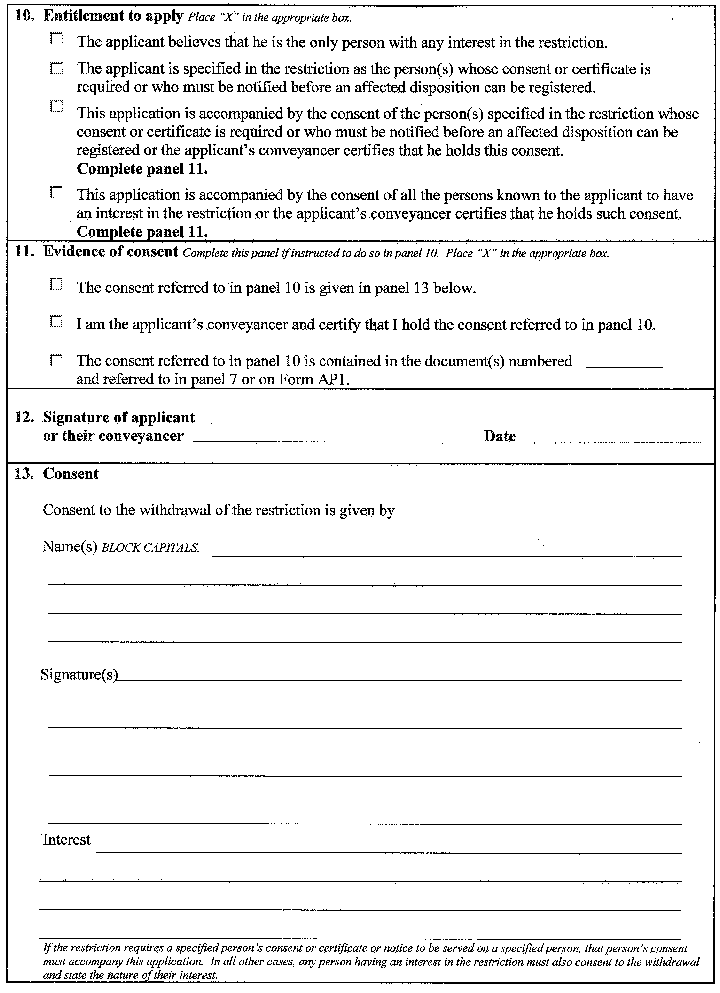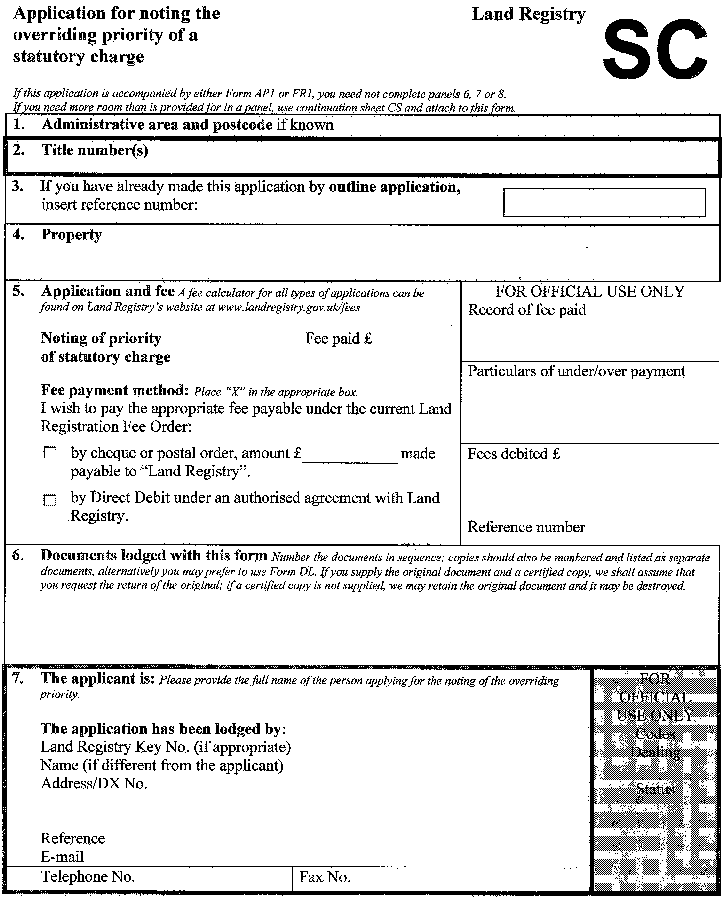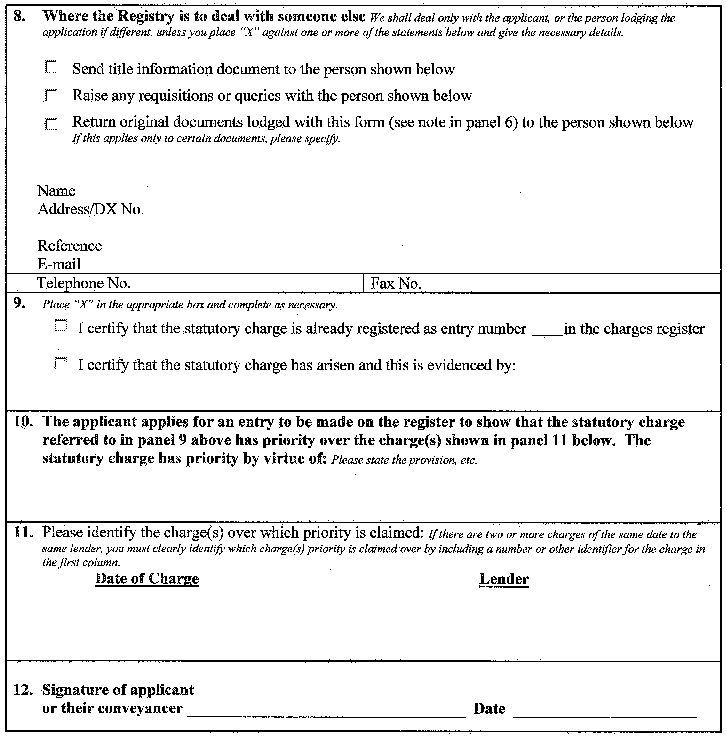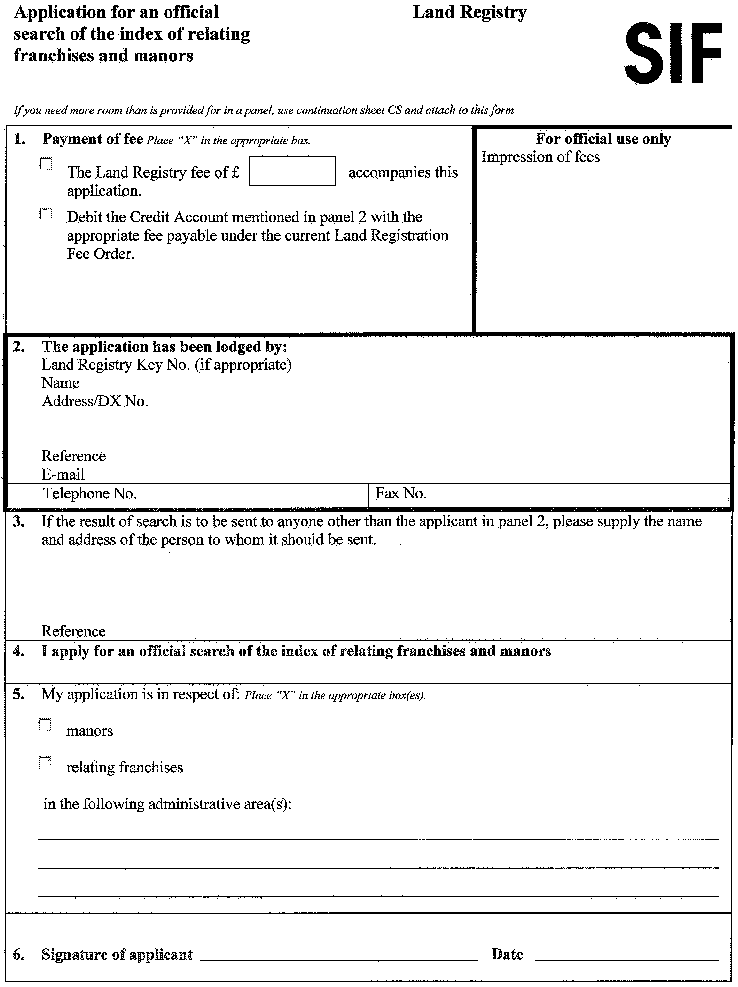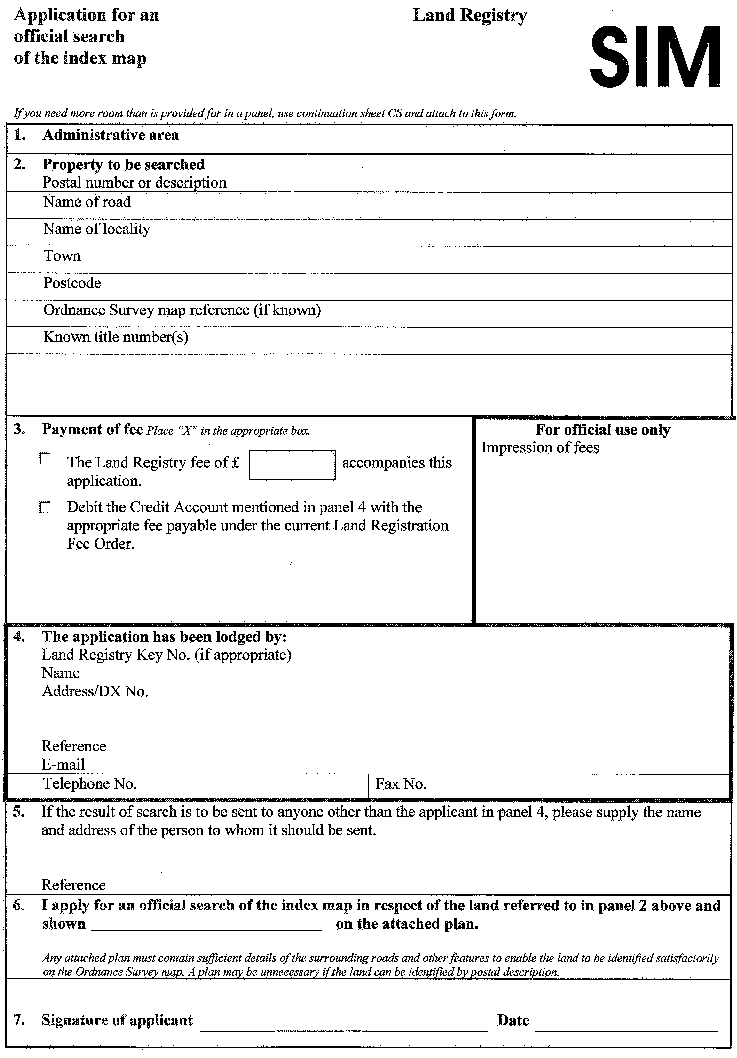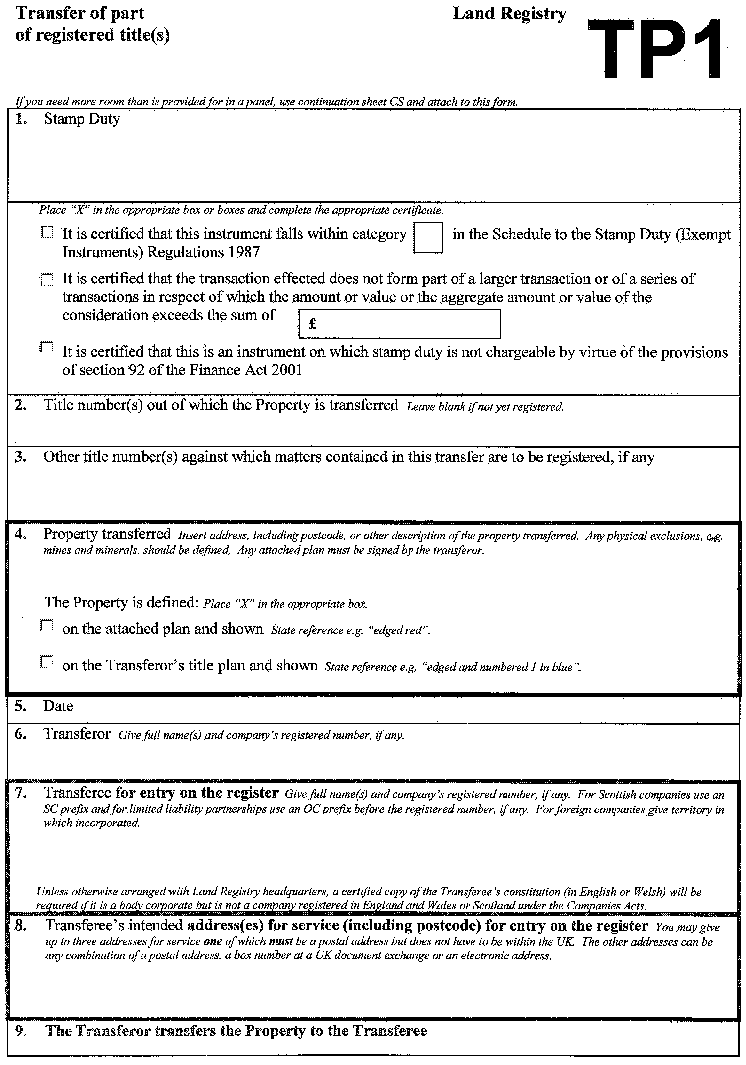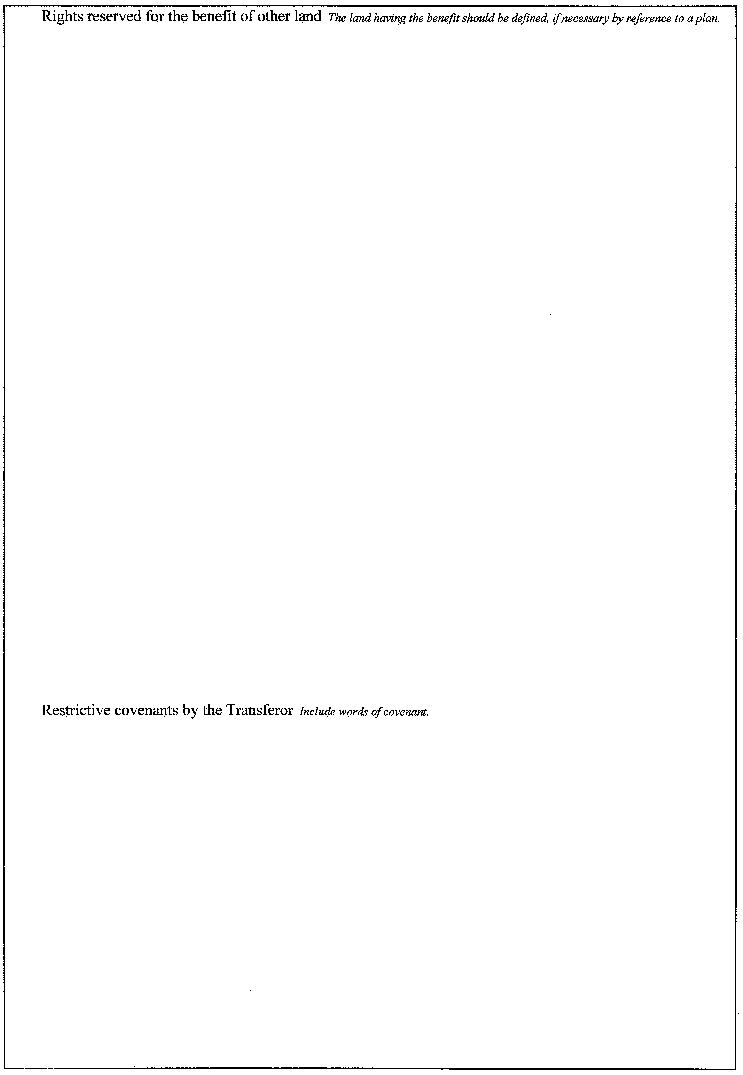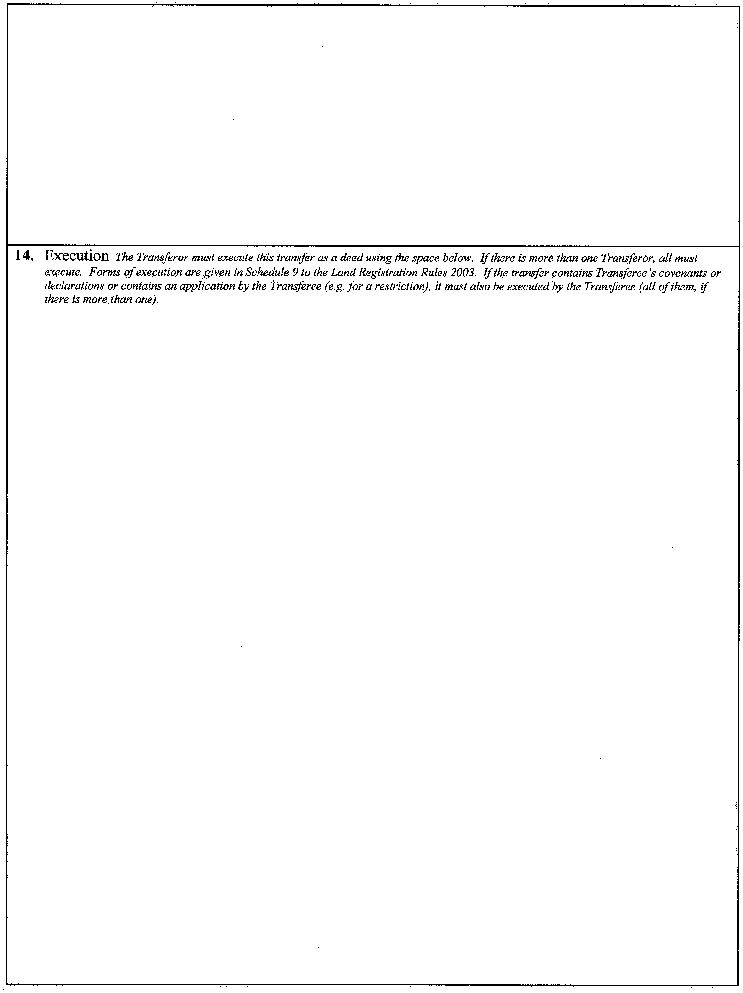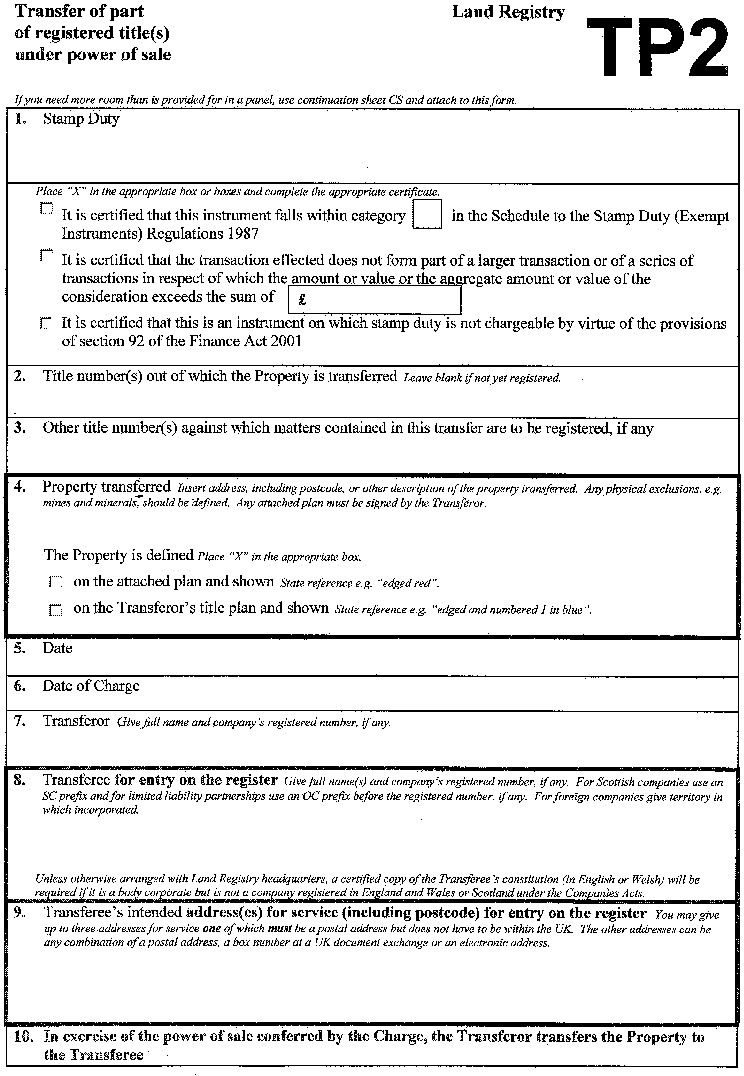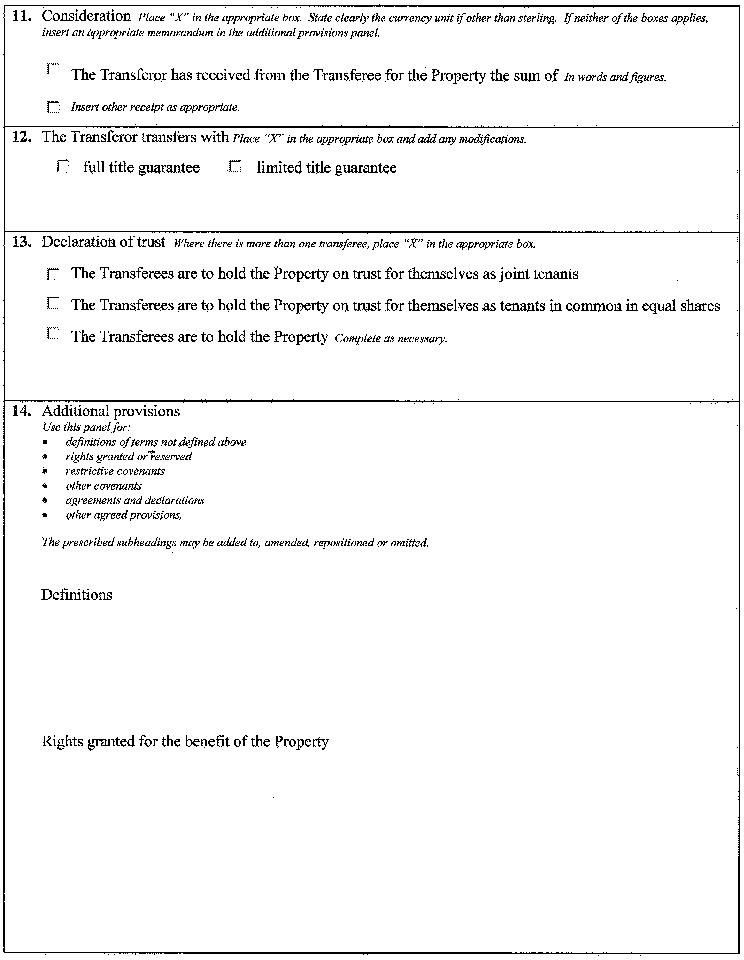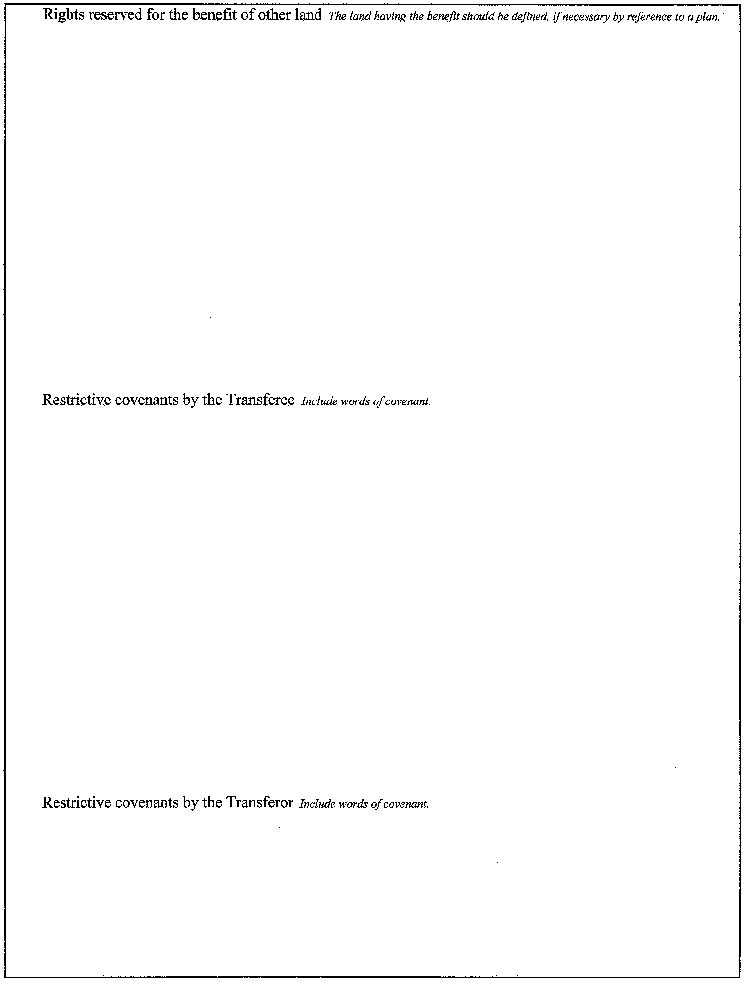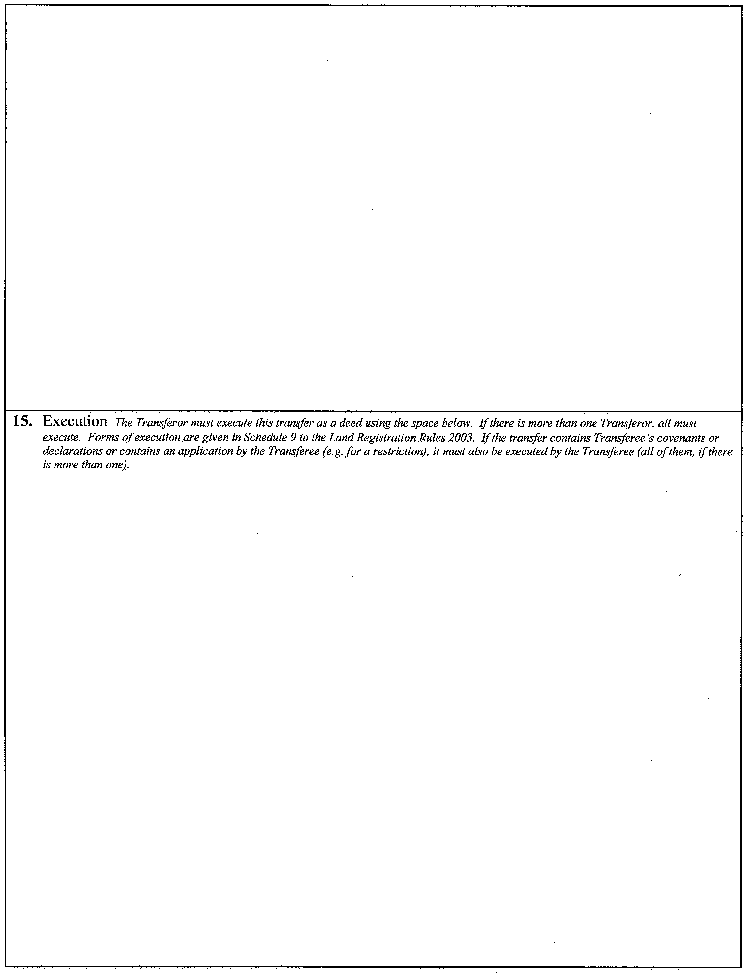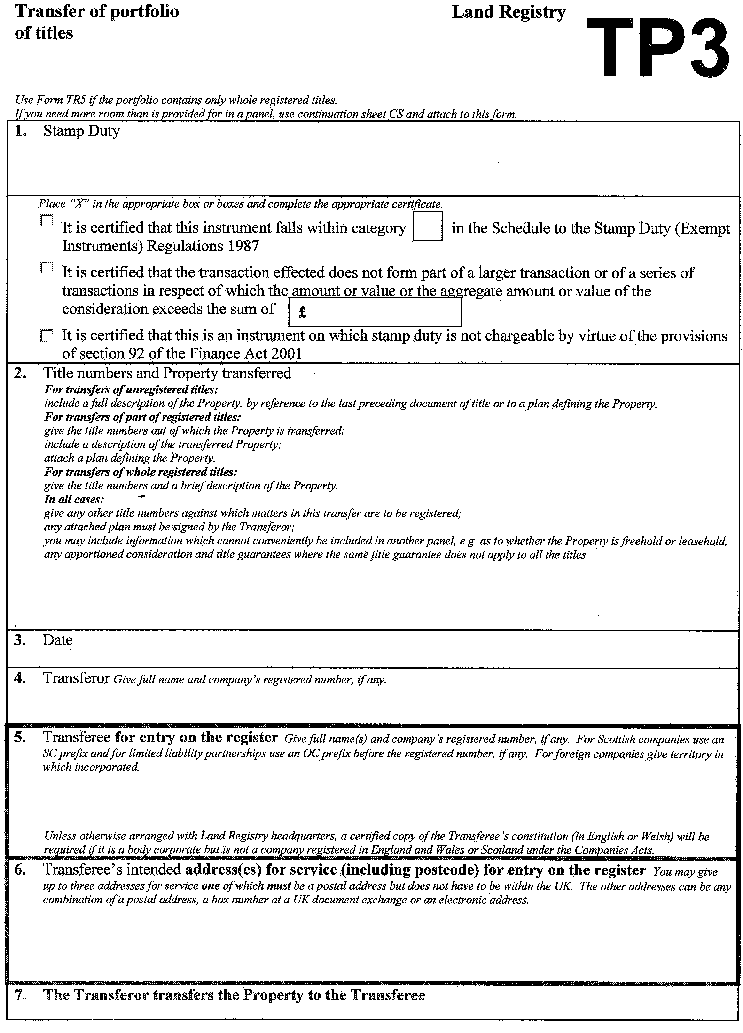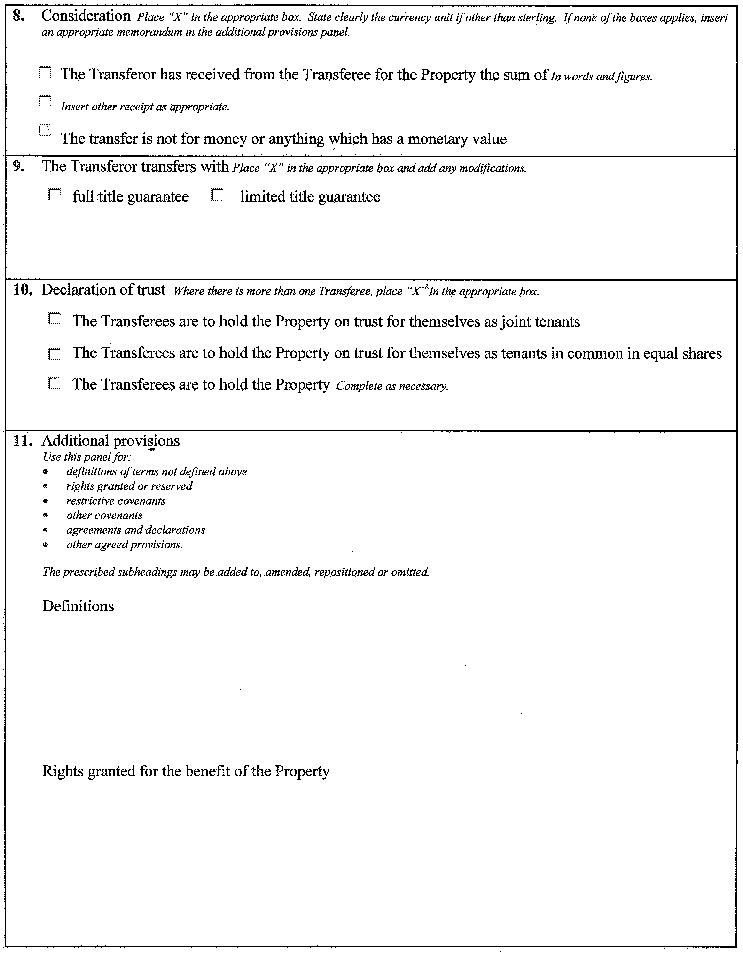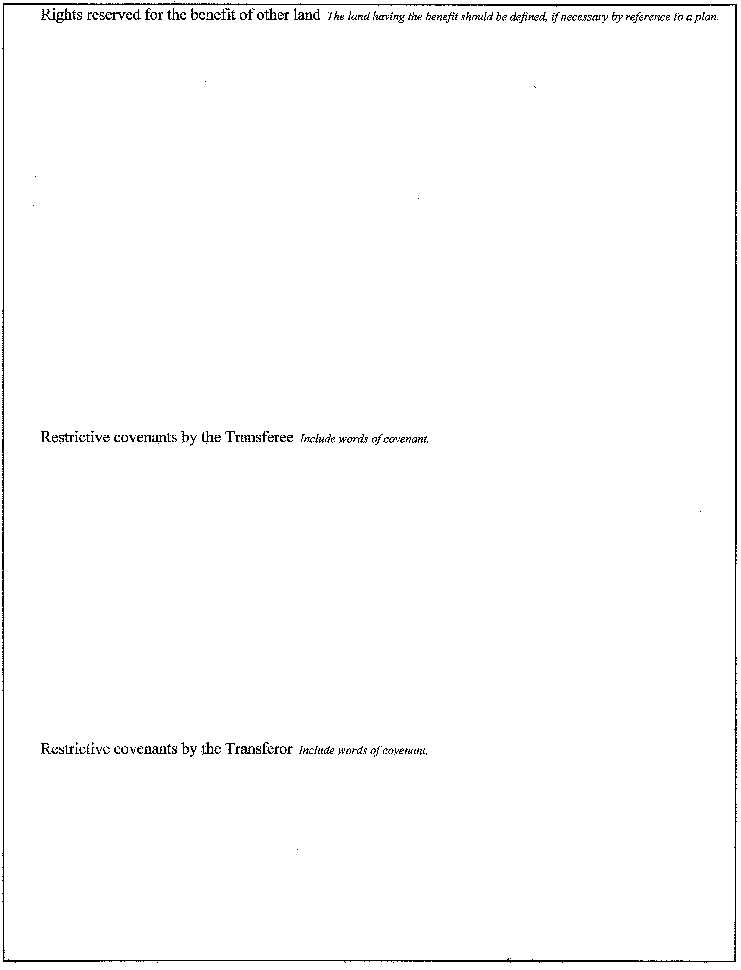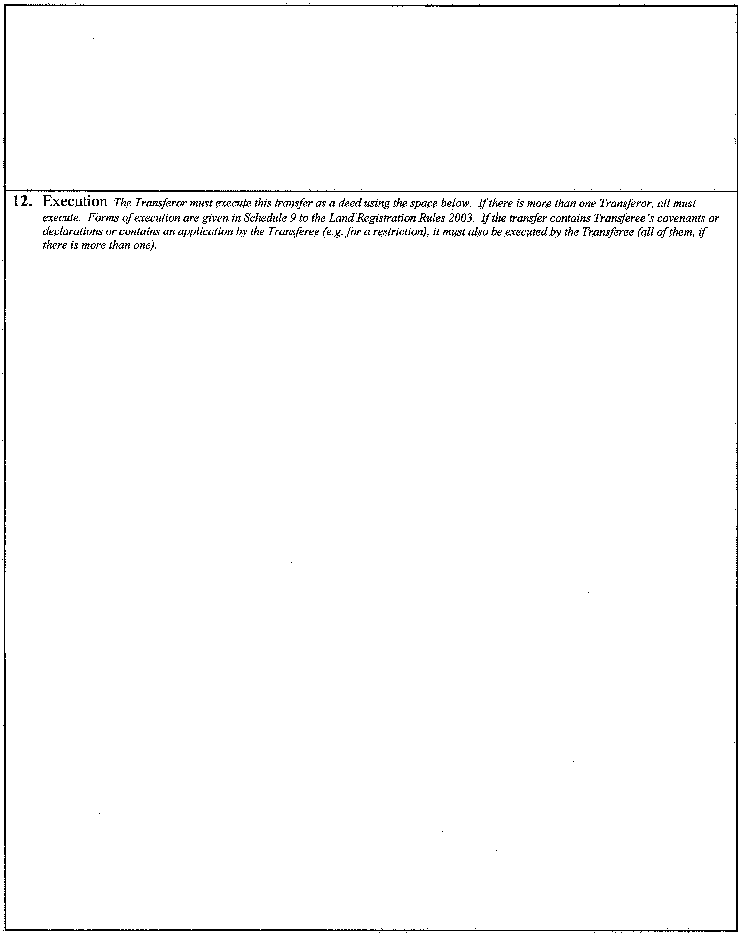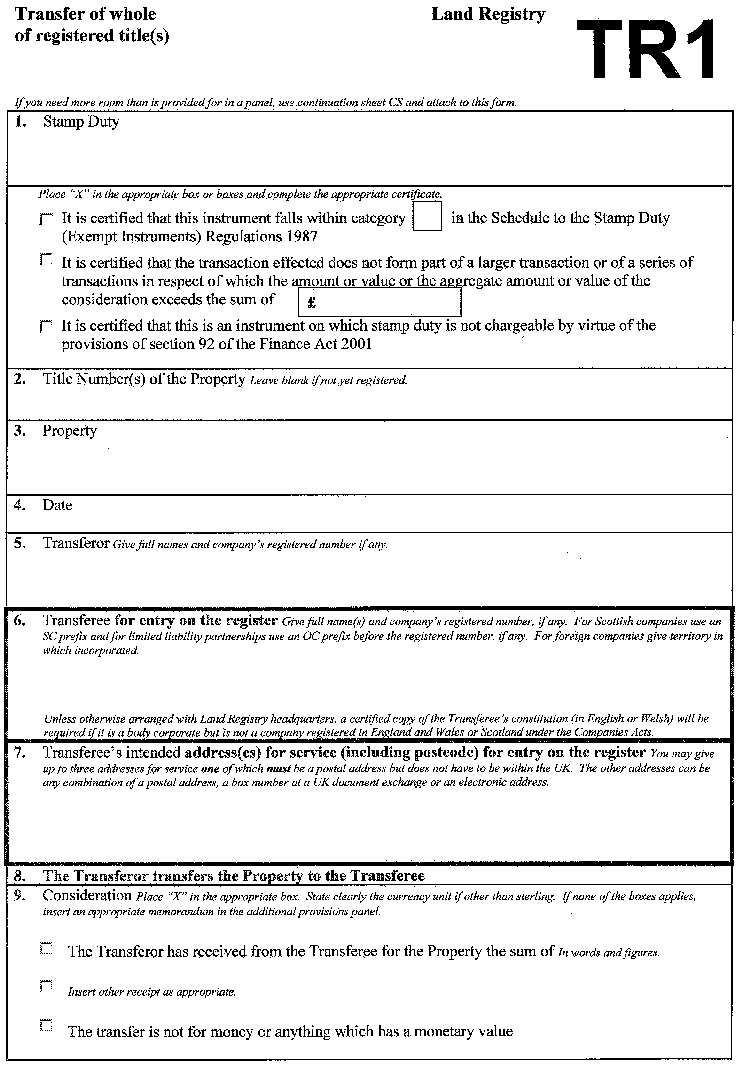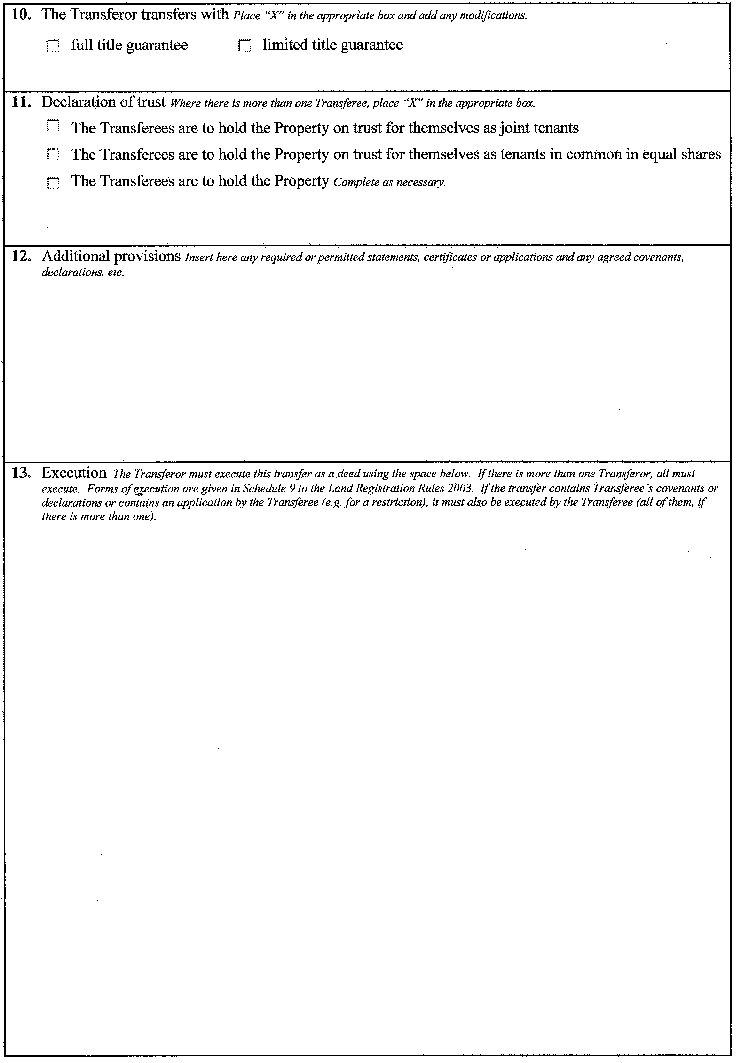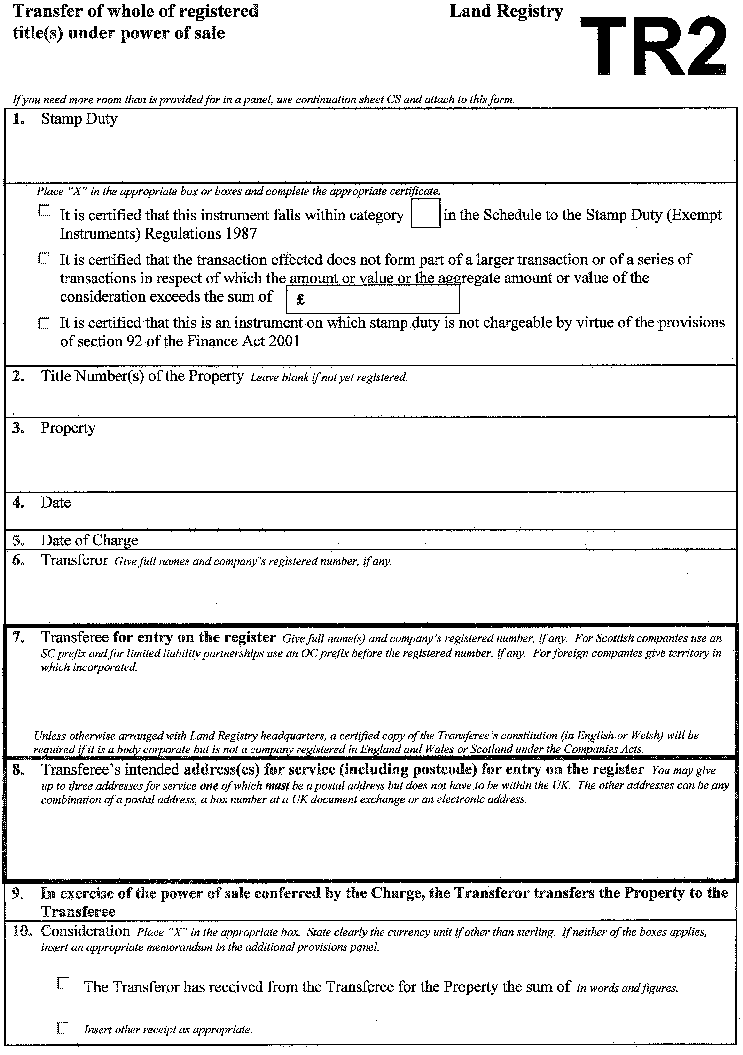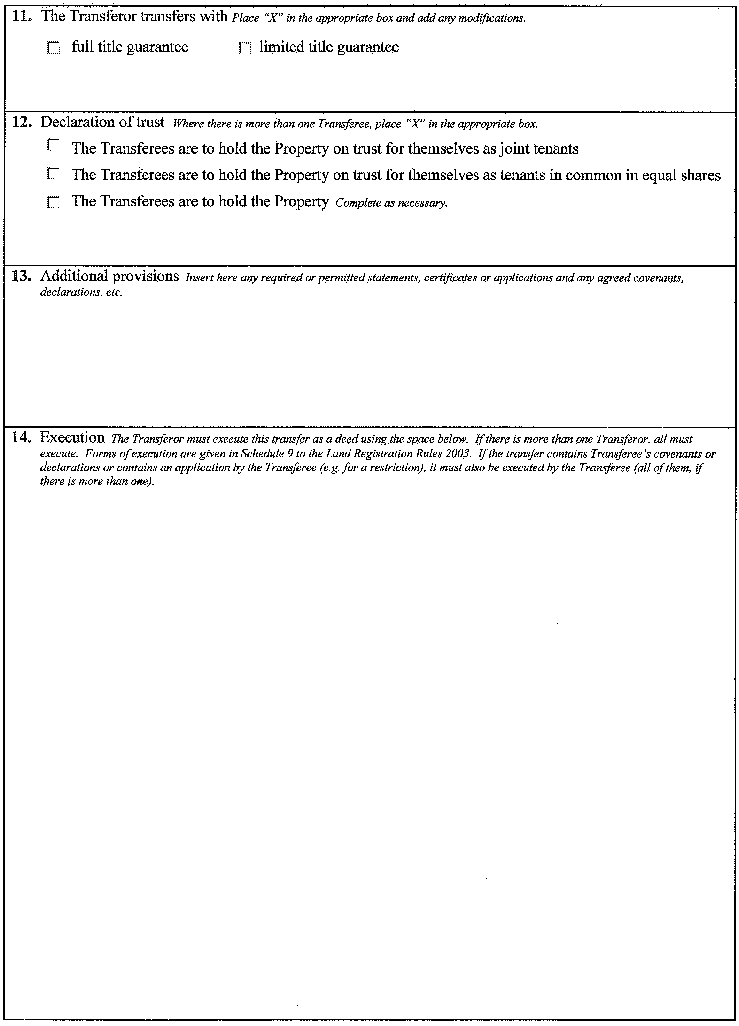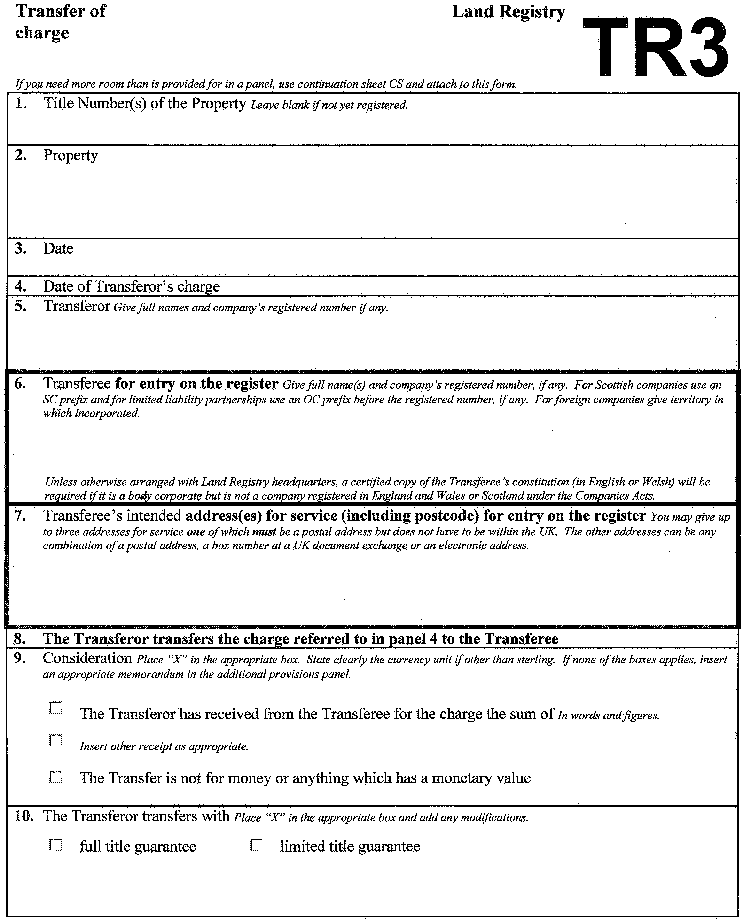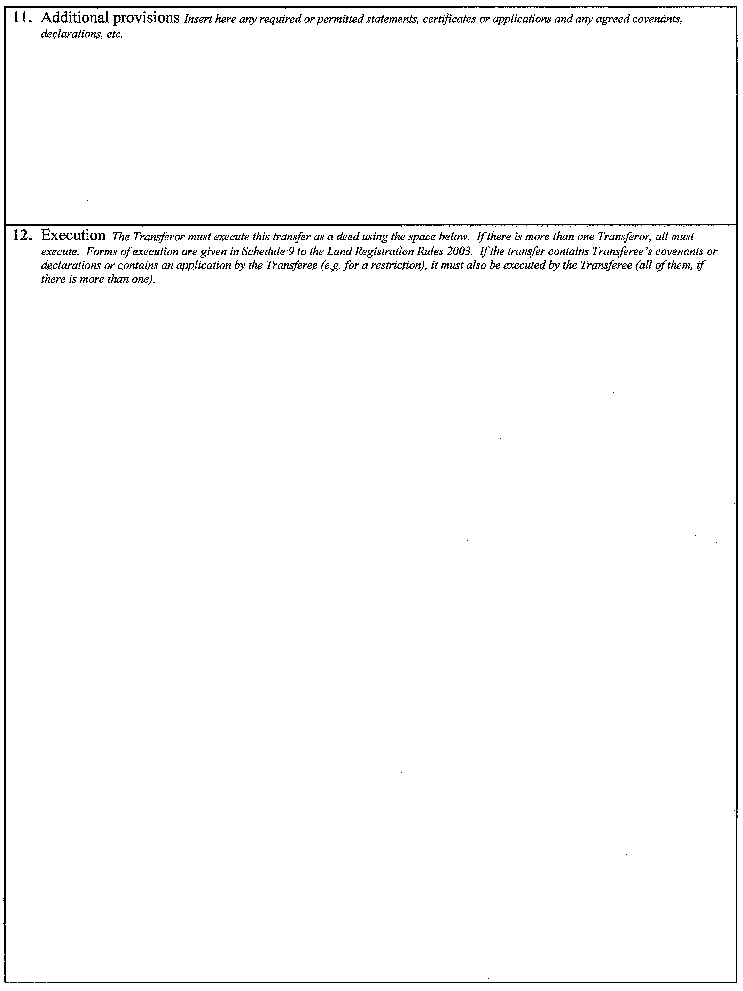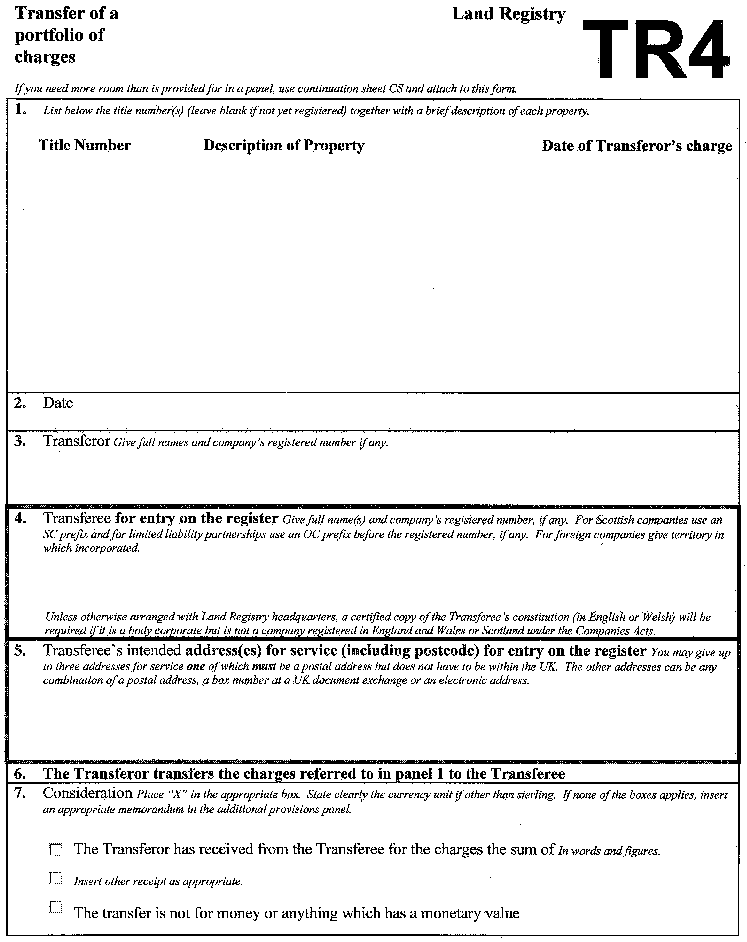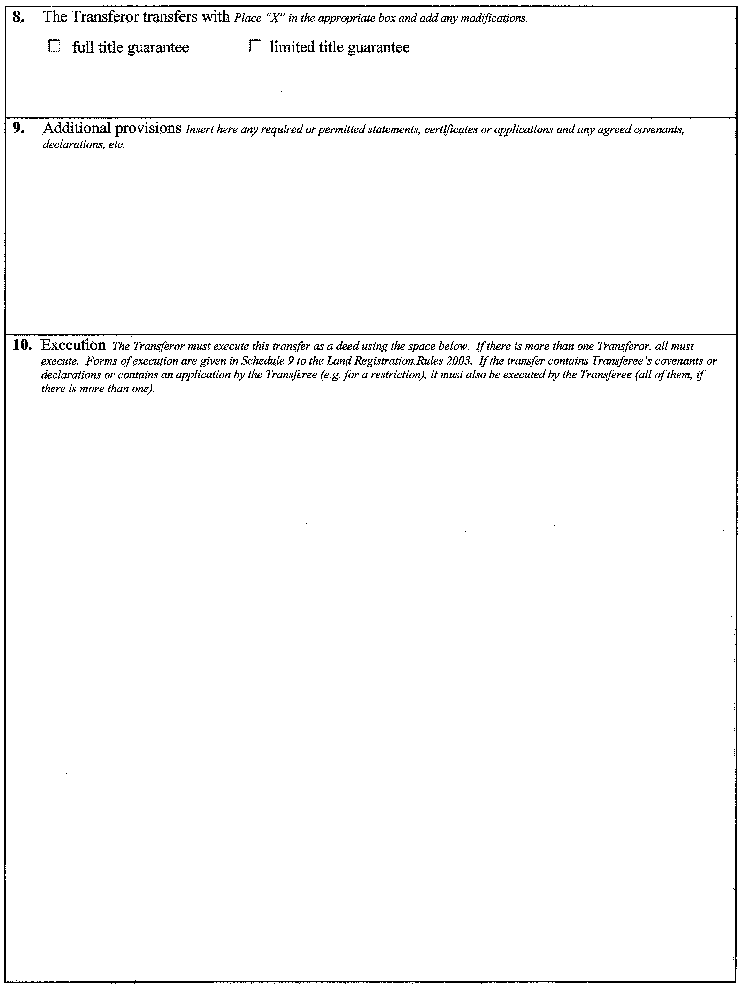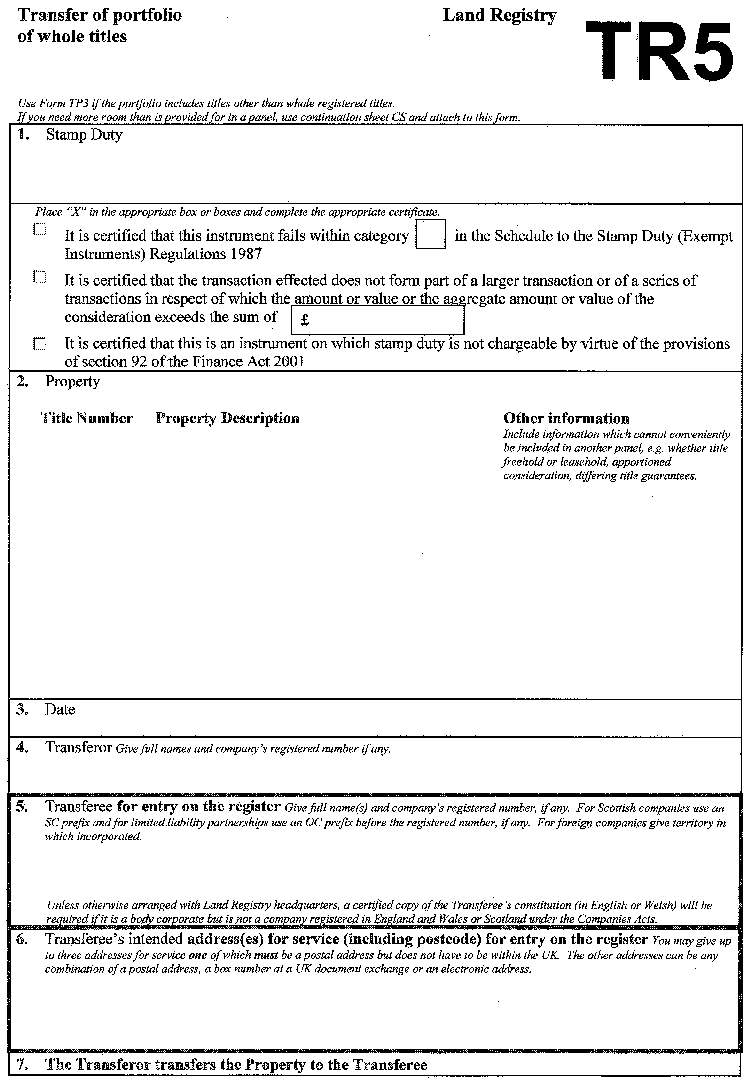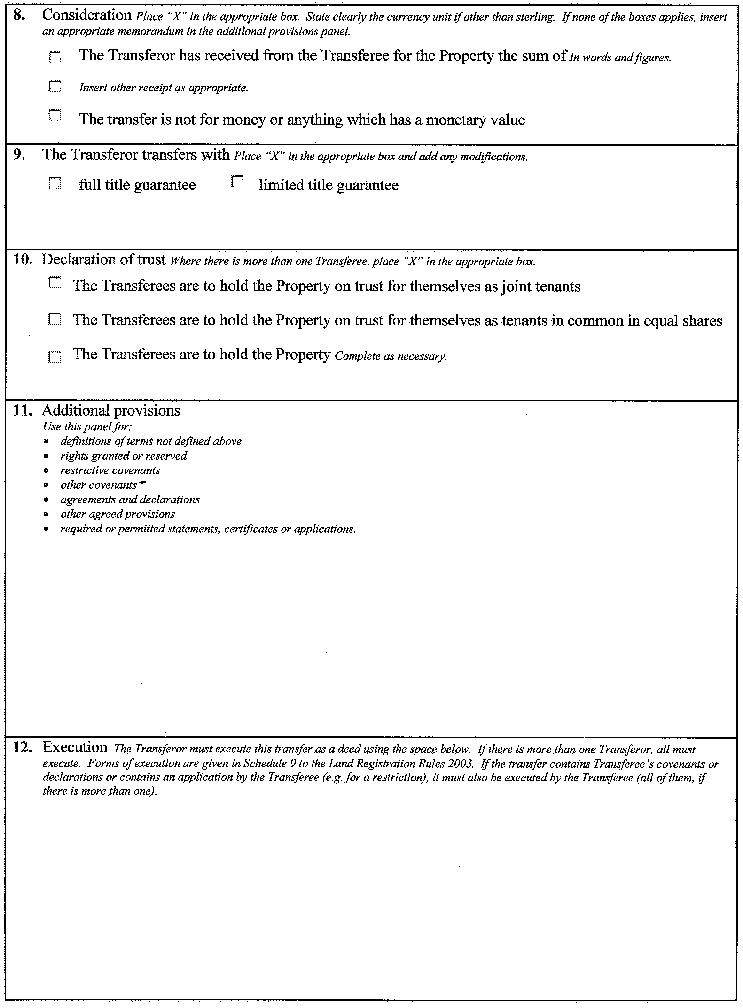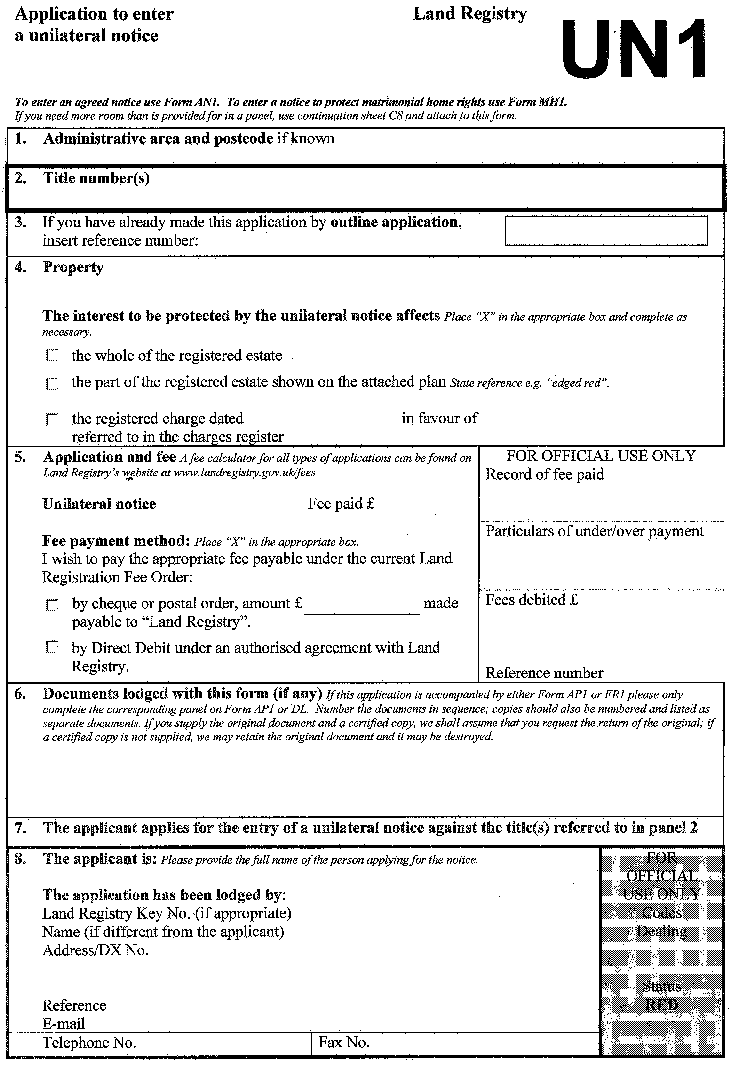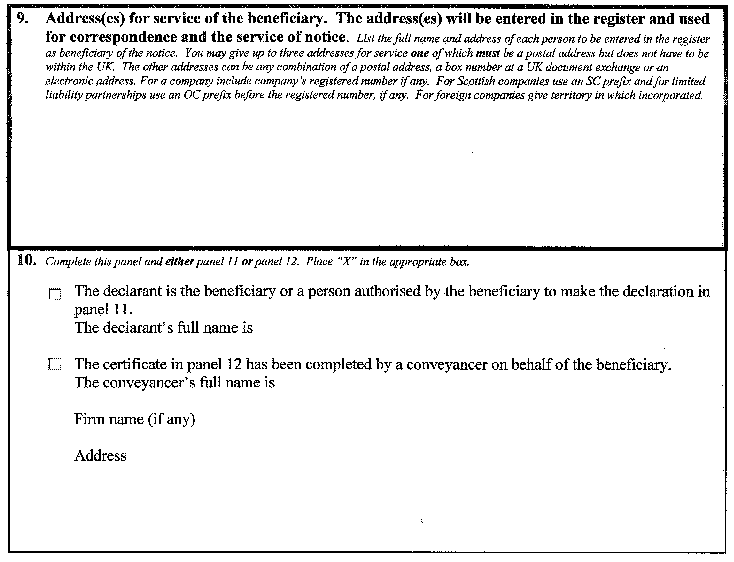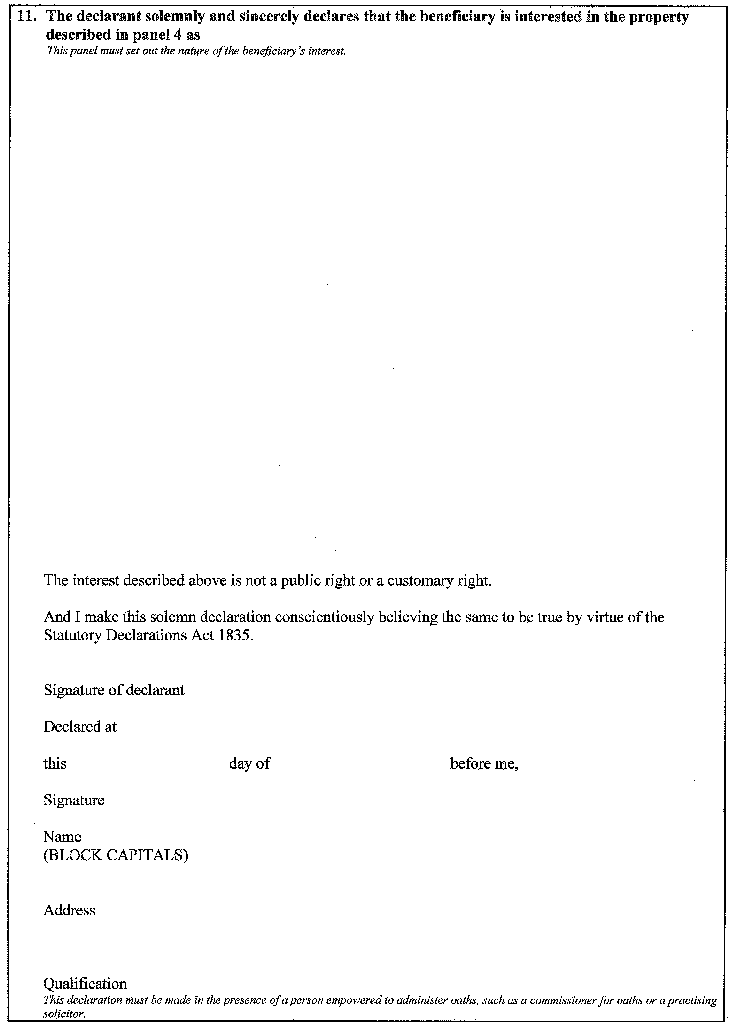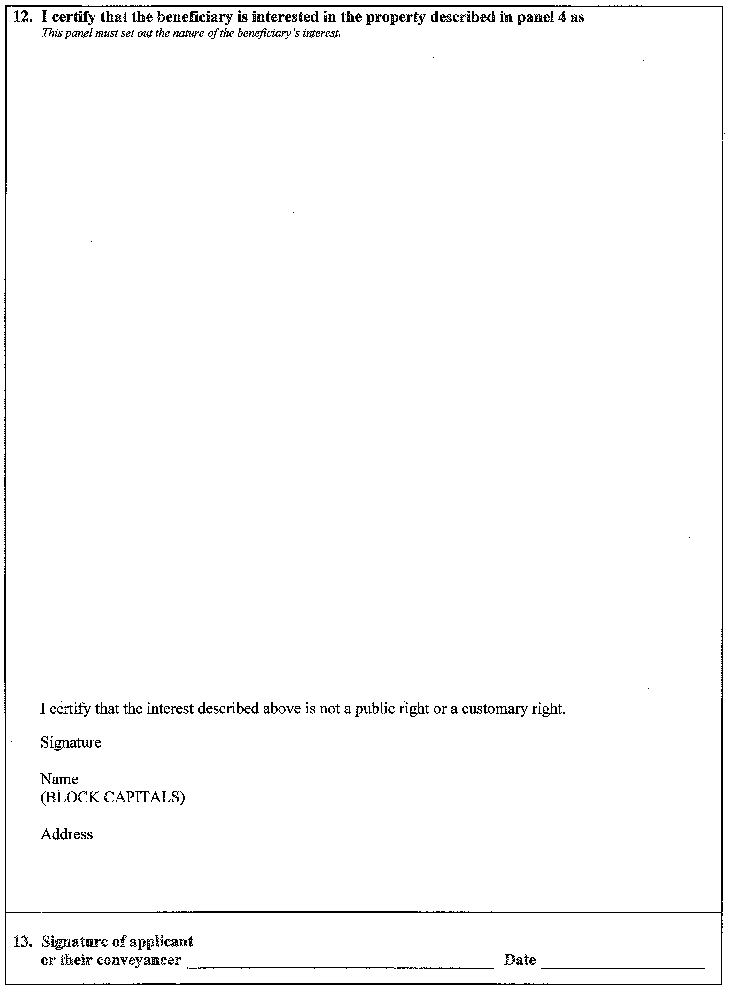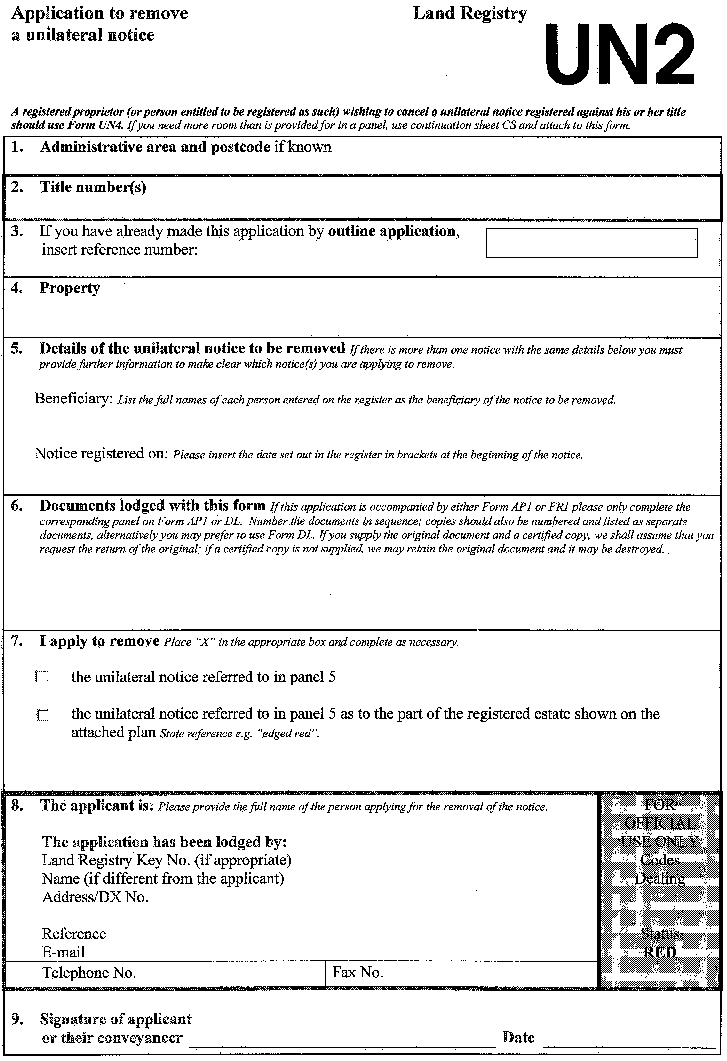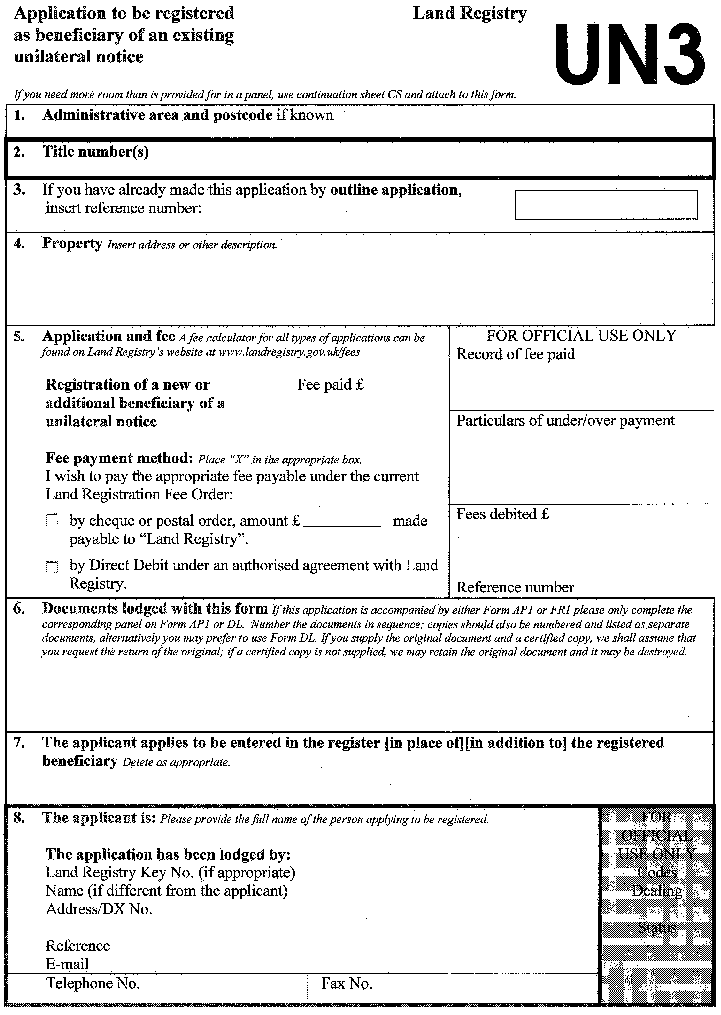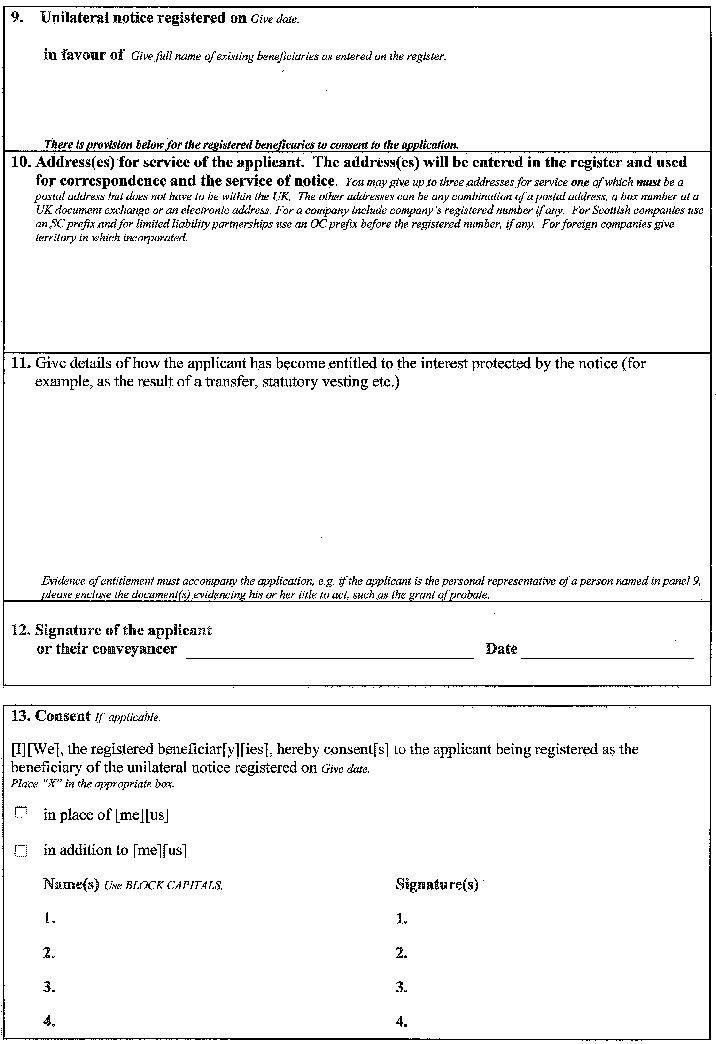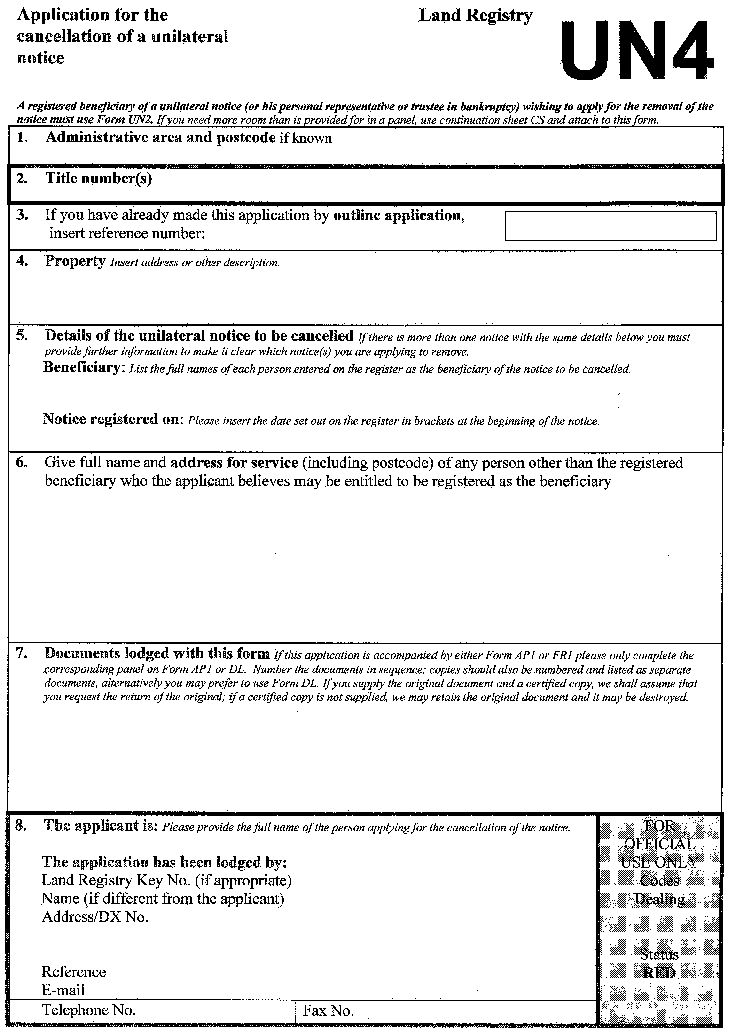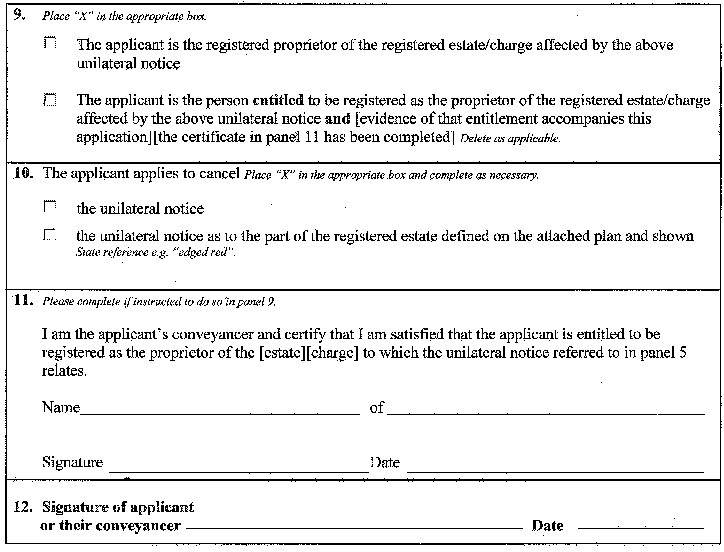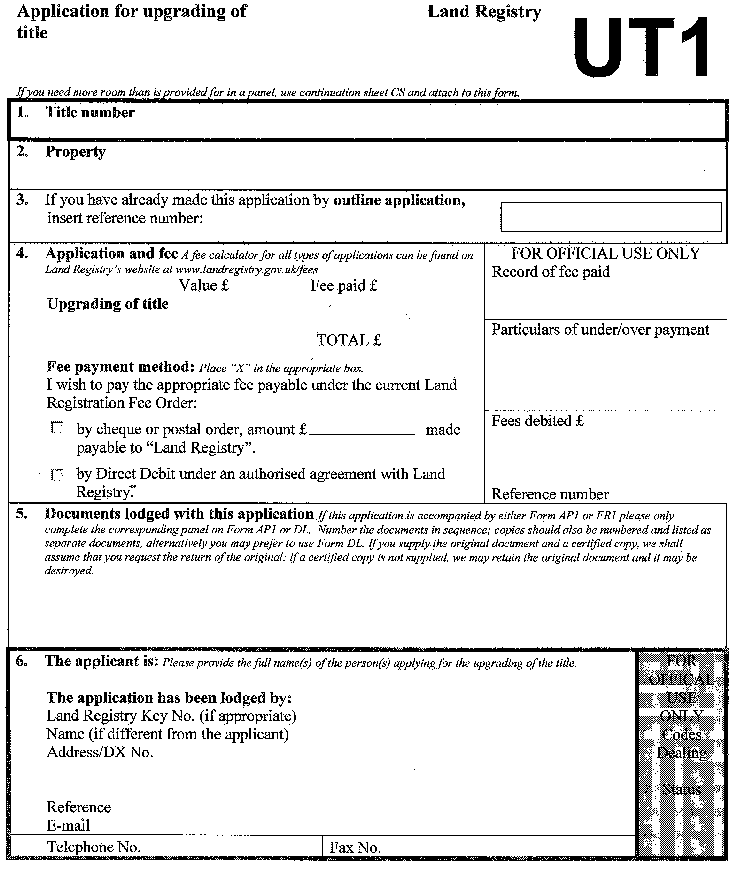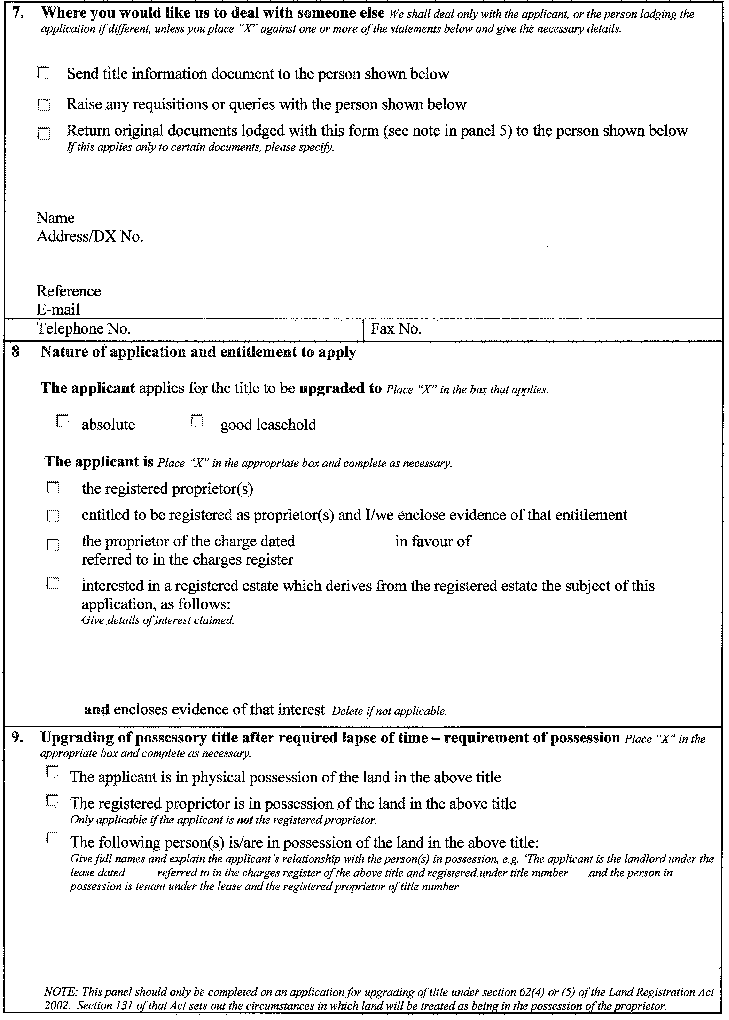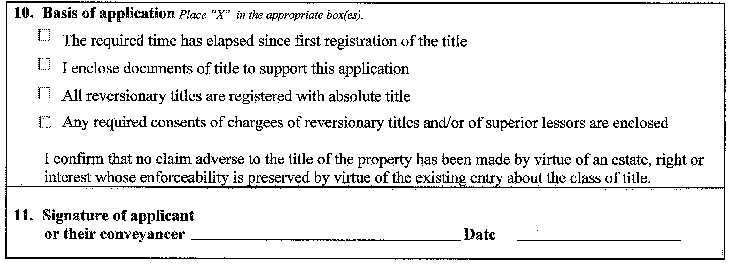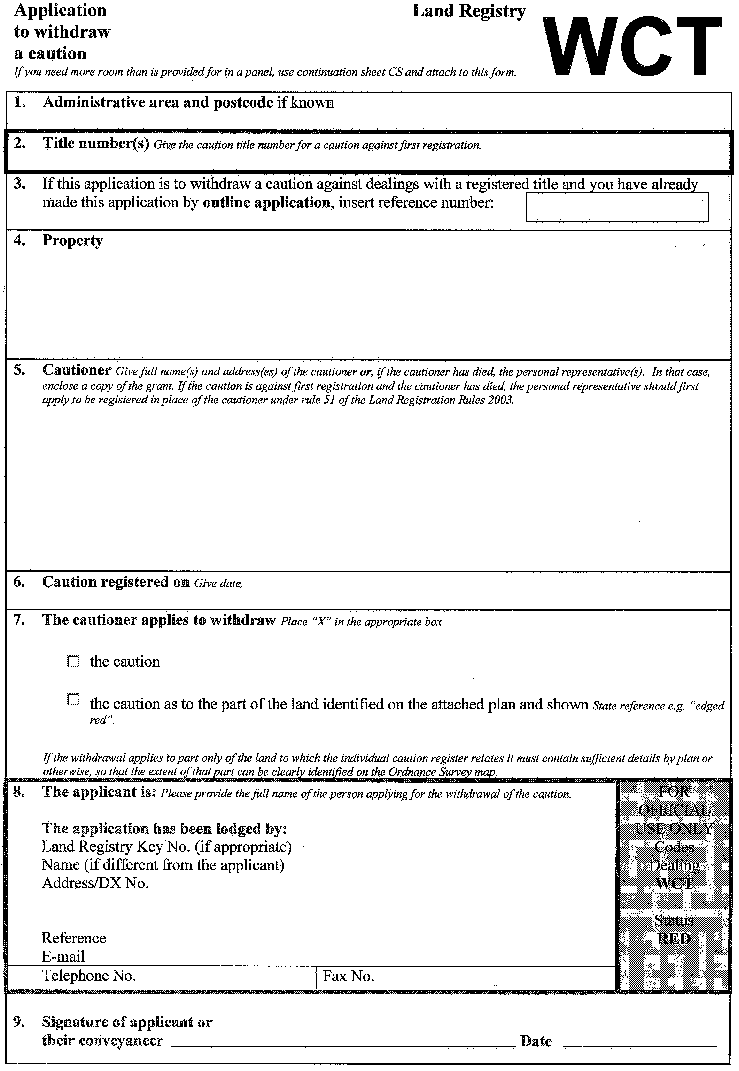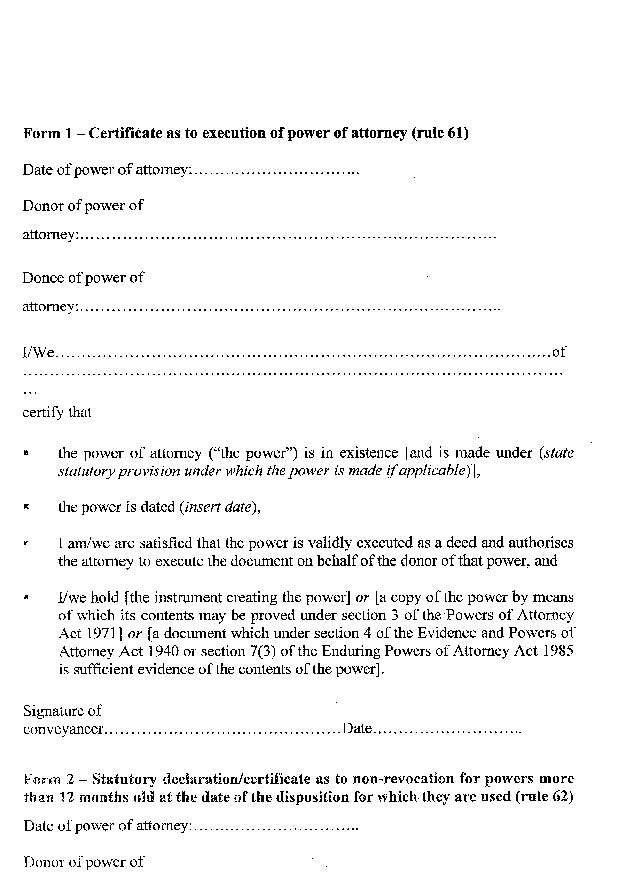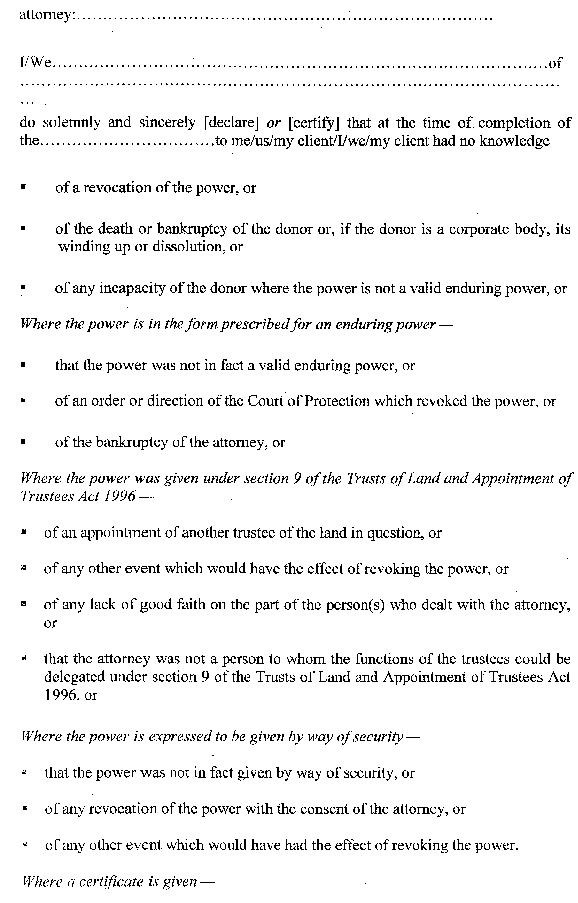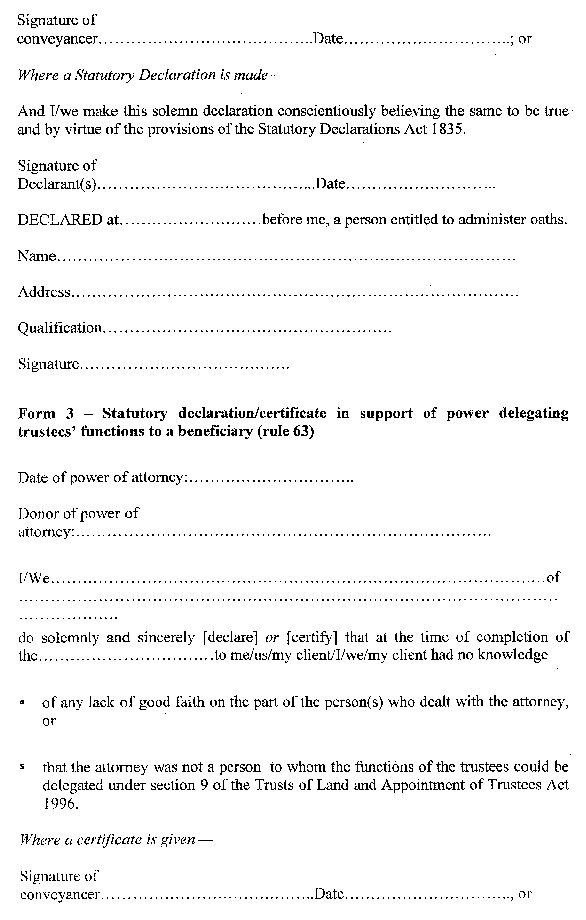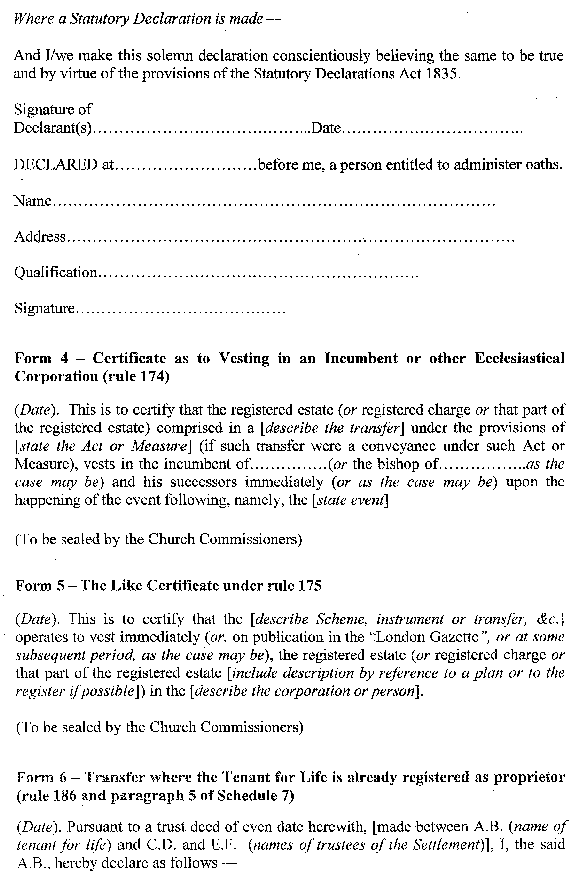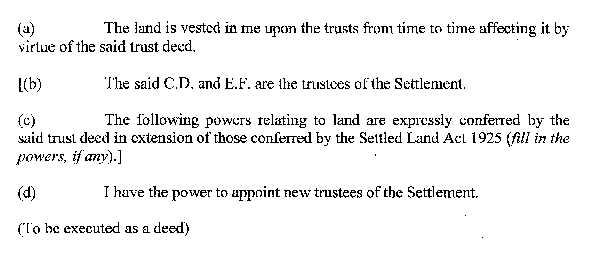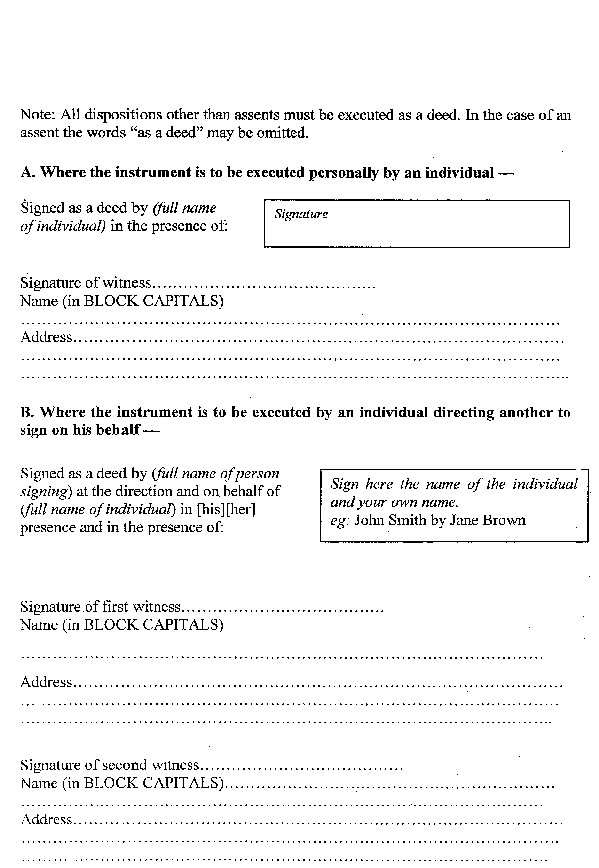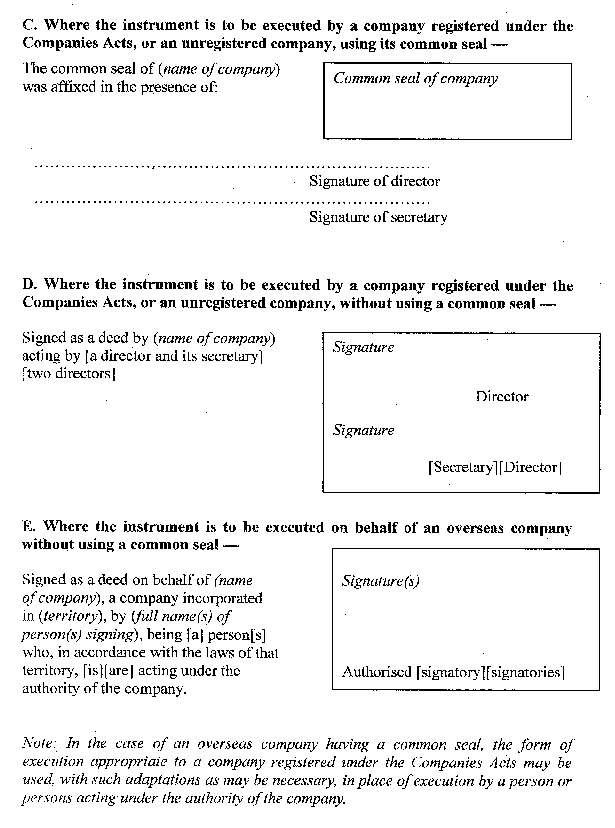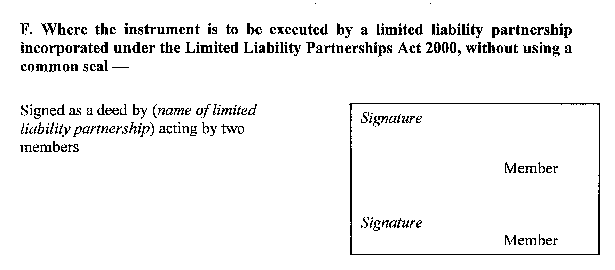- Latest available (Revised)
- Original (As made)
The Land Registration Rules 2003
You are here:
- UK Statutory Instruments
- 2003 No. 1417
- Whole Instrument
- Previous
- Next
More Resources
Status:
This is the original version (as it was originally made).
Statutory Instruments
2003 No. 1417
LAND REGISTRATION, ENGLAND AND WALES
The Land Registration Rules 2003
Made
19th May 2003
Laid before Parliament
5th June 2003
Coming into force in accordance with rule 1
The Lord Chancellor, with the advice and assistance of the Rule Committee appointed in pursuance of section 127 of the Land Registration Act 2002(1), in exercise of the powers conferred on him by sections 1(2), 6(6), 13(a), (b), 14(a), (b), 16(2), 18(1)(b), (2), (4), 19(2), 20(3)(a), (b), (c), 21(2)(a), (b), (c), (d), 22, 25(1), 27(6), 34(2), 35(3), 36(3), (4), 37(2), 39, 43(2)(a), (b), (c), (d), 44(2), 45(2), 46(4), 47(a), (b), 48(2)(a), (b), 49(2), (3)(b), (4)(b), 50, 57, 60(3), (4), 61(2), 64(2), 66(2), 67(3), 68(1)(d), (2)(a), (b), 69(2), 70, 71(a), (b), 72(6)(a), (b), 73(2), (3), (4), 75(2), 76(2), 81(2), 82, 86(3), 87(4), 89, 95(a) and 98(7) of, and paragraphs 2(2) and 7(3) of Schedule 2, paragraphs 4(a), (b), (c), and 7(a), (b), (c), (d) of Schedule 4, paragraphs 2(1)(d), 3(2), 14, and 15 of Schedule 6, paragraph 9 of Schedule 8, paragraphs 1(1)(a), (b), 3(a), (b), (c), 5, 6(a), (b), (c), (d), (e), 7, and 8 of Schedule 10, and paragraphs 2(4) and 18(5) of Schedule 12 to, the Land Registration Act 2002, sections 37(7) and 39(1) and (1A) of the Charities Act 1993(2), sections 34(10) and 57(11) of the Leasehold Reform, Housing and Urban Development Act 1993(3), paragraph 4(4) of Schedule 4 to the Family Law Act 1996(4), and of all other powers enabling him in that behalf, hereby makes the following rules:
PRELIMINARY
Citation and commencement
1. These rules may be cited as the Land Registration Rules 2003 and shall come into force on the day that section 1 of the Act comes into force.
PART 1THE REGISTER OF TITLE
Form and arrangement of the register of title
2.—(1) The register of title may be kept in electronic or paper form, or partly in one form and partly in the other.
(2) Subject to rule 3, the register of title must include an individual register for each registered estate which is—
(a)an estate in land, or
(b)a rentcharge, franchise, manor or profit a prendre in gross,
vested in a proprietor.
Individual registers and more than one registered estate, division and amalgamation
3.—(1) The registrar may include more than one registered estate in an individual register if the estates are of the same kind and are vested in the same proprietor.
(2) On first registration of a registered estate, the registrar may open an individual register for each separate area of land affected by the proprietor’s registered estate as he designates.
(3) Subsequently, the registrar may open an individual register for part of the registered estate in a registered title and retain the existing individual register for the remainder—
(a)on the application of the proprietor of the registered estate and of any registered charge over it, or
(b)if he considers it desirable for the keeping of the register of title, or
(c)on the registration of a charge of part of the registered estate comprised in the registered title.
(4) The registrar may amalgamate two or more registered titles, or add an estate which is being registered for the first time to an existing registered title, if the estates are of the same kind and are vested in the same proprietor—
(a)on the application of the proprietor of the registered estate and of any registered charge over it, or
(b)if he considers it desirable for the keeping of the register of title.
(5) Where the registrar has divided a registered title under paragraph (3)(b) or amalgamated registered titles or an estate on first registration with a registered title under paragraph (4)(b) he—
(a)must notify the proprietor of the registered estate and any registered charge, unless they have agreed to such action, and
(b)may make a new edition of any individual register or make entries on any individual register to reflect the division or amalgamation.
Arrangement of individual registers
4.—(1) Each individual register must have a distinguishing number, or series of letters and numbers, known as the title number.
(2) Each individual register must consist of a property register, a proprietorship register and, where necessary, a charges register.
(3) An entry in an individual register may be made by reference to a plan or other document; in which case the registrar must keep the original or a copy of the document.
(4) Whenever the registrar considers it desirable, he may make a new edition of any individual register so that it contains only the subsisting entries, rearrange the entries in the register or alter its title number.
Contents of the property register
5. The property register of a registered estate must contain—
(a)a description of the registered estate which in the case of a registered estate in land, rentcharge or registered franchise which is an affecting franchise must refer to a plan based on the Ordnance Survey map and known as the title plan;
(b)where appropriate, details of—
(i)the inclusion or exclusion of mines and minerals in or from the registration under rule 32,
(ii)easements, rights, privileges, conditions and covenants benefiting the registered estate and other similar matters,
(iii)all exceptions arising on enfranchisement of formerly copyhold land, and
(iv)any other matter required to be entered in any other part of the register which the registrar considers may more conveniently be entered in the property register, and
(c)such other matters as are required to be entered in the property register by these rules.
Property register of a registered leasehold estate
6.—(1) The property register of a registered leasehold estate must also contain sufficient particulars of the registered lease to enable that lease to be identified.
(2) If the lease contains a provision that prohibits or restricts dispositions of the leasehold estate, the registrar must make an entry in the property register stating that all estates, rights, interests, powers and remedies arising on or by reason of a disposition made in breach of that prohibition or restriction are excepted from the effect of registration.
Property register of a registered estate in a rentcharge, a franchise or a profit a prendre in gross
7. The property register of a registered estate in a rentcharge, franchise or a profit a prendre in gross must, if the estate was created by an instrument, also contain sufficient particulars of the instrument to enable it to be identified.
Contents of the proprietorship register
8.—(1) The proprietorship register of a registered estate must contain, where appropriate—
(a)the class of title,
(b)the name of the proprietor of the registered estate including, where the proprietor is a company registered under the Companies Acts, or a limited liability partnership incorporated under the Limited Liability Partnerships Act 2000(5), its registered number,
(c)an address for service of the proprietor of the registered estate in accordance with rule 198,
(d)restrictions under section 40 of the Act, including one entered under section 86(4) of the Act, in relation to the registered estate,
(e)notices under section 86(2) of the Act in relation to the registered estate,
(f)positive covenants by a transferor or transferee and indemnity convenants by a transferee entered under rules 64 or 65,
(g)details of any modification of the covenants implied by paragraphs 20(2) and (3) of Schedule 12 to the Act entered under rule 66,
(h)details of any modification of the covenants implied under the Law of Property (Miscellaneous Provisions) Act 1994(6) entered under rule 67(6),
(i)where the class of title is possessory, the name of the first proprietor of the registered estate and, where that proprietor is a company registered under the Companies Acts, or a limited liability partnership incorporated under the Limited Liability Partnerships Act 2000, its registered number, and
(j)such other matters as are required to be entered in the proprietorship register by these rules.
(2) On first registration and on a subsequent change of proprietor, the registrar whenever practicable will enter in the proprietorship register the price paid or value declared and such entry will remain until there is a change of proprietor, or some other change in the register of title which the registrar considers would result in the entry being misleading.
Contents of the charges register
9. The charges register of a registered estate must contain, where appropriate—
(a)details of leases, charges, and any other interests which adversely affect the registered estate subsisting at the time of first registration of the estate or created thereafter,
(b)any dealings with the interests referred to in paragraph (a), or affecting their priority, which are capable of being noted on the register,
(c)sufficient details to enable any registered charge to be identified,
(d)the name of the proprietor of any registered charge including, where the proprietor is a company registered under the Companies Acts, or a limited liability partnership incorporated under the Limited Liability Partnerships Act 2000, its registered number,
(e)an address for service of the proprietor of any registered charge in accordance with rule 198,
(f)restrictions under section 40 of the Act, including one entered under section 86(4) of the Act, in relation to a registered charge,
(g)notices under section 86(2) of the Act in relation to a registered charge, and
(h)such other matters affecting the registered estate or any registered charge as are required to be entered in the charges register by these rules.
PART 2INDICES
Index to be kept under section 68 of the Act
10.—(1) The index to be kept under section 68 of the Act must comprise—
(a)an index map from which it is possible to ascertain, in relation to a parcel of land, whether there is—
(i)a pending application for first registration (other than of title to a relating franchise),
(ii)a pending application for a caution against first registration (other than where the subject of the caution is a relating franchise),
(iii)a registered estate in land,
(iv)a registered rentcharge,
(v)a registered profit a prendre in gross,
(vi)a registered affecting franchise, or
(vii)a caution against first registration (other than where the subject of the caution is a relating franchise),
and, if there is such a registered estate or caution, the title number, and
(b)an index of verbal descriptions of—
(i)pending applications for first registration of title to relating franchises,
(ii)pending applications for cautions against first registration where the subject of the caution is a relating franchise,
(iii)registered franchises which are relating franchises,
(iv)registered manors, and
(v)cautions against first registration where the subject of the caution is a relating franchise,
and the title numbers of any such registered estates and cautions, arranged by administrative area.
(2) The information required to be shown in the index to be kept under section 68 is to be entered by the registrar in the index as soon as practicable.
Index of proprietors' names
11.—(1) Subject to paragraph (2), the registrar must keep an index of proprietors' names, showing for each individual register the name of the proprietor of the registered estate and the proprietor of any registered charge together with the title number.
(2) Until every individual register is held in electronic form, the index need not contain the name of any corporate or joint proprietor of an estate or of a charge registered as proprietor prior to 1st May 1972.
(3) A person may apply in Form PN1 for a search to be made in the index in respect of either his own name or the name of some other person in whose property he can satisfy the registrar that he is interested generally (for instance as trustee in bankruptcy or personal representative).
(4) On receipt of such an application the registrar must make the search and supply the applicant with details of every entry in the index relating to the particulars given in the application.
The day list
12.—(1) The registrar must keep a record (known as the day list) showing the date and time at which every pending application under the Act or these rules was made and of every application for an official search with priority under rule 147.
(2) The entry of notice of an application for an official search with priority must remain on the day list until the priority period conferred by the entry has ceased to have effect.
(3) Where the registrar proposes to alter the register without having received an application he must enter his proposal on the day list and, when so entered, the proposal will have the same effect for the purposes of rules 15 and 20 as if it were an application to the registrar made at the date and time of its entry.
(4) In this rule the term “pending application” does not include an application within Part 13, other than an application that the registrar designate a document an exempt information document under rule 136.
PART 3APPLICATIONS: GENERAL PROVISIONS
Form AP1
13.—(1) Any application made under the Act or these rules for which no other application form is prescribed must be made in Form AP1.
(2) Paragraph (1) does not apply to—
(a)an application to remove from the register the name of a deceased joint registered proprietor,
(b)applications made under rule 14, or
(c)outline applications as defined in rule 54.
Electronic delivery of applications
14. Any application to which rule 15 applies (other than an outline application under rule 54) may during the currency of any notice given under Schedule 2, and subject to and in accordance with the limitations contained in that notice, be delivered by electronic means and the applicant shall provide, in such order as may be required by that notice, such of the particulars required for an application of that type as are appropriate in the circumstances and as are required by the notice.
Time at which applications are taken to be made
15.—(1) An application received on a business day is to be taken as made at the earlier of—
(a)the time of the day that notice of it is entered in the day list, or
(b)(i)midnight marking the end of the day it was received if the application was received before 12 noon, or
(ii)midnight marking the end of the next business day after the day it was received if the application was received at or after 12 noon.
(2) An application received on a day which is not a business day is to be taken as made at the earlier of—
(a)the time of a business day that notice of it is entered in the day list, or
(b)midnight marking the end of the next business day after the day it was received.
(3) In this rule an application is received when it is delivered—
(a)to the designated proper office in accordance with an order under section 100(3) of the Act, or
(b)to the registrar in accordance with a written arrangement as to delivery made between the registrar and the applicant or between the registrar and the applicant’s conveyancer, or
(c)to the registrar under the provisions of any relevant notice given under Schedule 2.
(4) This rule does not apply to applications under Part 13, other than an application that the registrar designate a document an exempt information document under rule 136.
Applications not in order
16.—(1) If an application is not in order the registrar may raise such requisitions as he considers necessary, specifying a period (being not less than twenty business days) within which the applicant must comply with the requisitions.
(2) If the applicant fails to comply with the requisitions within that period, the registrar may cancel the application or may extend the period when this appears to him to be reasonable in the circumstances.
(3) If an application appears to the registrar to be substantially defective, he may reject it on delivery or he may cancel it at any time thereafter.
(4) Where a fee for an application is paid by means of a cheque and the registrar becomes aware, before that application has been completed, that the cheque has not been honoured, the application may be cancelled.
Additional evidence and enquiries
17. If the registrar at any time considers that the production of any further documents or evidence or the giving of any notice is necessary or desirable, he may refuse to complete or proceed with an application, or to do any act or make any entry, until such documents, evidence or notices have been supplied or given.
Continuation of application on a transfer by operation of law
18. If, before an application has been completed, the whole of the applicant’s interest is transferred by operation of law, the application may be continued by the person entitled to that interest in consequence of that transfer.
Objections
19.—(1) Subject to paragraph (5), an objection under section 73 of the Act to an application must be made by delivering to the registrar at the appropriate office a written statement signed by the objector or his conveyancer.
(2) The statement must—
(a)state that the objector objects to the application,
(b)state the grounds for the objection, and
(c)give the full name of the objector and an address to which communications may be sent.
(3) Subject to paragraph (5), the written statement referred to in paragraph (1) must be delivered—
(a)in paper form, or
(b)to the electronic address, or
(c)to the fax number.
(4) In paragraph (3) the reference to the electronic address and the fax number is to the electronic address or fax number for the appropriate office specified in a direction by the registrar under section 100(4) of the Act as that to be used for delivery of objections.
(5) Where a person is objecting to an application in response to a notice given by the registrar, he may alternatively do so in the manner and to the address stated in the notice as provided by rule 197(1)(c).
(6) In this rule the appropriate office is the same office as the proper office, designated under an order under section 100(3) of the Act, for the receipt of an application relating to the land in respect of which the objection is made, but on the assumption that if the order contains exceptions none of the exceptions apply to that application.
Completion of applications
20.—(1) Any entry in, removal of an entry from or alteration of the register pursuant to an application under the Act or these rules has effect from the time of the making of the application.
(2) — This rule does not apply to the applications mentioned in section 74 of the Act.
PART 4FIRST REGISTRATION
First registration—application by mortgagee
21. A mortgagee under a mortgage falling within section 4(1)(g) of the Act may make an application in the name of the mortgagor for the estate charged by the mortgage to be registered whether or not the mortgagor consents.
Registration of a proprietor of a charge falling within section 4(1)(g) of the Act
22.—(1) This rule applies to an application for first registration made—
(a)under rule 21, or
(b)by the owner of an estate that is subject to a legal charge falling within section 4(1)(g) of the Act.
(2) The registrar must enter the mortgagee of the legal charge falling within section 4(1)(g) of the Act as the proprietor of that charge if he is satisfied of that person’s entitlement.
First registration–application form
23.—(1) Subject to paragraph (2), an application for first registration must be made in Form FR1.
(2) Where Her Majesty applies for the first registration of an estate under section 79 of the Act, Form FR1 must be used with such modifications to it as are appropriate and have been approved by the registrar.
Documents to be delivered with a first registration application
24.—(1) Unless the registrar otherwise directs, every application for first registration must be accompanied by—
(a)sufficient details, by plan or otherwise (subject to rules 25 and 26), so that the land can be identified clearly on the Ordnance Survey map,
(b)in the case of a leasehold estate, the lease, if in the control of the applicant, and a certified copy,
(c)all deeds and documents relating to the title that are in the control of the applicant,
(d)a list in duplicate in Form DL of all the documents delivered.
(2) On an application to register a rentcharge, franchise or profit a prendre in gross, the land to be identified under paragraph (1)(a) is the land affected by that estate or to which it relates.
First registration of mines and minerals
25. When applying for first registration of an estate in mines and minerals held apart from the surface, the applicant must provide—
(a)a plan of the surface under which the mines and minerals lie,
(b)any other sufficient details by plan or otherwise so that the mines and minerals can be identified clearly, and
(c)full details of rights incidental to the working of the mines and minerals.
First registration of cellars, flats, tunnels etc
26.—(1) Subject to paragraph (2), unless all of the land above and below the surface is included in an application for first registration the applicant must provide a plan of the surface on under or over which the land to be registered lies, and sufficient information to define the vertical and horizontal extents of the land.
(2) This rule does not apply where only mines and minerals are excluded from the application.
First registration application where title documents are unavailable
27. An application for first registration by a person who is unable to produce a full documentary title must be supported by evidence—
(a)to satisfy the registrar that the applicant is entitled to apply under section 3(2) of the Act or required to apply under section 6(1) of the Act, and
(b)where appropriate, to account for the absence of documentary evidence of title.
Duty to disclose unregistered interests that override first registration
28.—(1) Subject to paragraph (2), a person applying for first registration must provide information to the registrar about any of the interests that fall within Schedule 1 to the Act that—
(a)are within the actual knowledge of the applicant, and
(b)affect the estate to which the application relates,
in Form DI.
(2) The applicant is not required to provide information about—
(a)an interest that under section 33 or 90(4) of the Act cannot be protected by notice,
(b)an interest that is apparent from the deeds and documents of title accompanying the application under rule 24,
(c)a public right,
(d)a local land charge,
(e)a leasehold estate in land if—
(i)it is within paragraph 1 of Schedule 1 to the Act, and
(ii)at the time of the application, the term granted by the lease has one year or less to run.
(3) In this rule and in Form FR1, a “disclosable overriding interest” is an interest that the applicant must provide information about under paragraph (1).
(4) Where the applicant provides information about a disclosable overriding interest under this rule, the registrar may enter a notice in the register in respect of that interest.
First registration–examination of title
29. In examining the title shown by the documents accompanying an application for first registration the registrar may have regard to any examination of title by a conveyancer prior to the application and to the nature of the property.
Searches and enquiries by the registrar
30. In examining title on an application for first registration the registrar may—
(a)make searches and enquiries and give notices to other persons,
(b)direct that searches and enquiries be made by the applicant,
(c)advertise the application.
First registration–foreshore
31.—(1) Where it appears to the registrar that any land included in an application for first registration comprises foreshore, he must serve a notice of that application on—
(a)the Crown Estate Commissioners in every case,
(b)the Chancellor of the Duchy of Lancaster in the case of land in the county palatine of Lancaster,
(c)the appropriate person in the case of land in the counties of Devon and Cornwall and in the Isles of Scilly and in the case of land within the jurisdiction of the Port of London Authority, and
(d)the Port of London Authority in the case of land within its jurisdiction.
(2) A notice under paragraph (1) must provide a period ending at 12 noon on the twentieth business day after the date of issue of the notice in which to object to the application.
(3) A notice need not be served under paragraph (1) where, if it was served, it would result in it being served on the applicant for first registration.
(4) In this rule—
“the appropriate person” means such person as the Duke of Cornwall, or the possessor for the time being of the Duchy of Cornwall, appoints,
“foreshore” has the meaning given by paragraph 13(3) of Schedule 6 to the Act.
Mines and minerals–note as to inclusion or exclusion
32. Where, on first registration of an estate in land which comprises or includes the land beneath the surface, the registrar is satisfied that the mines and minerals are included in or excluded from the applicant’s title he must make an appropriate note in the register.
First registration–entry of beneficial rights
33.—(1) The benefit of an appurtenant right may be entered in the register at the time of first registration if—
(a)on examination of the title, or
(b)on receipt of a written application providing details of the right and evidence of its existence,
the registrar is satisfied that the right subsists as a legal estate and benefits the registered estate.
(2) If the registrar is not satisfied that the right subsists as a legal interest benefiting the registered estate, he may enter details of the right claimed in the property register with such qualification as he considers appropriate.
First registration–registration of a proprietor of a legal mortgage not within rule 22 or rule 38
34.—(1) The registrar must enter the mortgagee of a legal mortgage to which this rule applies as the proprietor of that charge if on first registration of the legal estate charged by that charge he is satisfied of that person’s entitlement.
(2) This rule applies to a legal mortgage—
(a)which is either—
(i)a charge on the legal estate that is being registered, or
(ii)is a charge on such charge, and
(b)which is not a charge falling within rule 22 or rule 38.
First registration–entry of burdens
35.—(1) On first registration the registrar must enter a notice in the register of the burden of any interest which appears from his examination of the title to affect the registered estate.
(2) This rule does not apply to—
(a)an interest that under section 33 or 90(4) of the Act cannot be protected by notice,
(b)a public right,
(c)a local land charge,
(d)an interest which appears to the registrar to be of a trivial or obvious character, or the entry of a notice in respect of which would be likely to cause confusion or inconvenience.
First registration–note as to rights of light and air
36. On first registration, if it appears to the registrar that an agreement prevents the acquisition of rights of light or air for the benefit of the registered estate, he may make an entry in the property register of that estate.
First registration–notice of lease
37.—(1) Subject to paragraph (2), before completing an application for registration of a leasehold estate with absolute title, the registrar must give notice of the application to the proprietor of the registered reversion.
(2) This rule only applies where—
(a)at the time of the grant of the lease—
(i)the reversion was not registered, or
(ii)the reversion was registered but the grant of the lease was not required to be completed by registration,
(b)the lease is not noted in the register of the registered reversion, and
(c)it is not apparent from the application that the proprietor of the registered reversion consents to the registration.
(3) On completing registration of the leasehold estate, the registrar must enter notice of the lease in the register of the registered reversion.
(4) In this rule, “the reversion” refers to the estate that is the immediate reversion to the lease that is the subject of the application referred to in paragraph (1) and “registered reversion” refers to such estate when it is a registered estate.
Application of the Act to dealings prior to first registration
38.—(1) If, while a person is subject to a duty under section 6 of the Act to make an application to be registered as proprietor of a legal estate, there is a dealing with that estate, then the Act applies to that dealing as if the dealing had taken place after the date of first registration of that estate.
(2) The registration of any dealing falling within paragraph (1) that is delivered for registration with the application made pursuant to section 6 has effect from the time of the making of that application.
PART 5CAUTIONS AGAINST FIRST REGISTRATION
Definitions
39. In this Part—
“cautioner” has the same meaning as in section 22 of the Act (read with rule 52),
“cautioner’s register” is the register so named in rule 41(2) the contents of which are described in rule 41(5),
“relevant interest” means the interest claimed by the cautioner in the unregistered legal estate to which the caution against first registration relates.
Form and arrangement of the cautions register
40.—(1) The cautions register may be kept in electronic or paper form, or partly in one form and partly in the other.
(2) Subject to paragraph (3), the cautions register will comprise an individual caution register for each caution against the registration of title to an unregistered estate.
(3) On registration of a caution, the registrar may open an individual caution register for each separate area of land affected by the caution as he designates.
Arrangement of individual caution registers
41.—(1) Each individual caution register will have a distinguishing number, or series of letters and numbers, known as the caution title number.
(2) Each individual caution register will be in two parts called the caution property register and the cautioner’s register.
(3) The caution property register will contain—
(a)a description of the legal estate to which the caution relates, and
(b)a description of the relevant interest.
(4) Where the legal estate to which the caution relates is an estate in land, a rentcharge, or an affecting franchise, the description will refer to a caution plan, which plan will be based on the Ordnance Survey map.
(5) The cautioner’s register will contain—
(a)the name of the cautioner including, where the cautioner is a company registered under the Companies Acts, or a limited liability partnership incorporated under the Limited Liability Partnerships Act 2000(7), its registered number,
(b)an address for service in accordance with rule 198, and
(c)where appropriate, details of any person consenting to the lodging of the caution under rule 47.
Caution against first registration–application
42. An application for a caution against first registration must be made in Form CT1 and contain sufficient details, by plan or otherwise, so that the extent of the land to which the caution relates can be identified clearly on the Ordnance Survey map.
Withdrawal of a caution against first registration–application
43. An application to withdraw a caution against first registration must be made in Form WCT and, if the application is made in respect of part only of the land to which the individual caution register relates, it must contain sufficient details, by plan or otherwise, so that the extent of that part can be identified clearly on the Ordnance Survey map.
Cancellation of a caution against first registration–application
44.—(1) Subject to paragraph (5), an application for the cancellation of a caution against first registration must be in Form CCT.
(2) Where the application is made in respect of part only of the land to which the individual caution register relates, it must contain sufficient details, by plan or otherwise, so that the extent of that part can be identified clearly on the Ordnance Survey map.
(3) Where a person applies under section 18(1)(a) of the Act or rule 45(a) or (b)(ii), evidence to satisfy the registrar that he is entitled to apply must accompany the application.
(4) Where the applicant, or a person from whom the applicant derives title to the legal estate by operation of law, has consented to the lodging of the caution, evidence of the facts referred to in rule 46 must accompany the application.
(5) Where an application is made for the cancellation of a caution against first registration by Her Majesty by virtue of rule 45(b)(i), Form CCT must be used with such modifications to it as are appropriate and have been approved by the registrar.
Other persons who may apply to cancel a caution against first registration
45. In addition to the owner of the legal estate to which the caution relates—
(a)the owner of a legal estate derived out of that estate, and
(b)where the land to which the caution relates is demesne land,
(i)Her Majesty, or
(ii)the owner of a legal estate affecting the demesne land,
may apply under section 18(1)(b) of the Act for cancellation of a caution against first registration.
Application for cancellation of a caution against first registration by a person who originally consented
46. A person to whom section 18(2) of the Act applies may make an application for cancellation of a caution against first registration only if—
(a)the relevant interest has come to an end, or
(b)the consent referred to in section 18(2) was induced by fraud, misrepresentation, mistake or undue influence or given under duress.
Consent to registration of a caution against first registration
47. For the purposes of section 18(2) of the Act a person consents to the lodging of a caution against first registration if before the caution is entered in the cautions register—
(a)he has confirmed in writing that he consents to the lodging of the caution, and
(b)that consent is produced to the registrar.
Alteration of the cautions register by the court
48.—(1) If in any proceedings the court decides that the cautioner does not own the relevant interest, or only owns part, or that such interest either wholly or in part did not exist or has come to an end, the court must make an order for alteration of the cautions register under section 20(1) of the Act.
(2) An order for alteration of the cautions register must state the caution title number of the individual caution register affected, describe the alteration that is to be made, and direct the registrar to make the alteration.
(3) For the purposes of section 20(2) of the Act an order for alteration of the cautions register may only be served on the registrar by making an application for him to give effect to the order.
Alteration of the cautions register by the registrar
49. If the registrar is satisfied that the cautioner does not own the relevant interest, or only owns part, or that such interest did not exist or has come to an end wholly or in part, he must on application alter the cautions register under section 21(1) of the Act.
Applications to the registrar to alter the cautions register and service of notice
50.—(1) A person who wishes the registrar to alter the cautions register under section 21(1) of the Act must request the registrar to do so by an application, which must include—
(a)written details of the alteration required and of the grounds on which the application is made, and
(b)any supporting document.
(2) Before the registrar alters the cautions register under section 21(1) of the Act he must serve a notice on the cautioner giving details of the application, unless the registrar is satisfied that service of the notice is unnecessary.
Alteration of the cautions register—alteration of cautioner
51.—(1) A person who claims that the whole of the relevant interest described in an individual caution register is vested in him by operation of law as successor to the cautioner may apply for the register to be altered under section 21(1) of the Act to show him as cautioner in the cautioner’s register in place of the cautioner.
(2) If the registrar does not serve notice under rule 50(2) or if the cautioner does not object within the time specified in the notice, the registrar must give effect to the application.
Definition of “the cautioner”
52. For the purpose of Chapter 2 of Part 2 and section 73(2) of the Act, the other person referred to in sections 22 and 73(2) of the Act shall be the person for the time being shown as cautioner in the cautioner’s register, where that person is not the person who lodged the caution against first registration.
The prescribed periods under section 16(2) and section 18(4) of the Act
53.—(1) The period for the purpose of section 16(2) and section 18(4) of the Act is the period ending at 12 noon on the fifteenth business day after the date of issue of the notice under section 16(1) or section 18(3) of the Act, as the case may be, or such longer period as the registrar may allow following a request under paragraph (2), provided that the longer period never exceeds a period ending at 12 noon on the thirtieth business day after the date of issue of the notice.
(2) The request referred to in paragraph (1) is one by the cautioner to the registrar setting out why the longer period referred to in that paragraph should be allowed.
(3) If a request is received under paragraph (2), the registrar may, if he considers it appropriate, seek the views of the person who applied for registration or cancellation, as the case may be, and if, after considering any such views and all other relevant matters, he is satisfied that a longer period should be allowed he may allow such period (not exceeding a period ending at 12 noon on the thirtieth business day after the date of issue of the notice) as he considers appropriate, whether or not the period is the same as any period requested by the cautioner.
(4) A request under paragraph (2) must be made before the period ending at 12 noon on the fifteenth business day after the date of issue of the notice has expired.
PART 6REGISTERED LAND: APPLICATIONS, DISPOSITIONS AND MISCELLANEOUS ENTRIES
Applications
Outline applications
54.—(1) An outline application is an application made in accordance with this rule.
(2) Subject to Schedule 2, any application may be made by outline application if it satisfies the following conditions—
(a)the application must not be—
(i)an application which can be protected by an official search with priority within the meaning of rule 147,
(ii)an application for first registration,
(iii)an application for a caution against first registration or in respect of the cautions register,
(iv)an application dealing with part only of the land in a registered title, whether or not also involving any other registered title,
(v)an application under Part 13, and
(b)the right, interest or matter the subject of the application must exist at the time the application is made.
(3) During the currency of any notice given under Schedule 2, and subject to and in accordance with the limitations contained in that notice, an outline application may be made by—
(a)an oral application,
(b)telephone, or
(c)electronic means.
(4) An outline application must contain the following particulars when made—
(a)the title number(s) affected,
(b)if there is only one proprietor or applicant for first registration and that person is an individual, his surname, otherwise the proprietor’s or such applicant’s full name or the full name of one of the proprietors or such applicants, as appropriate,
(c)the nature of the application,
(d)the name of the applicant,
(e)the name and address of the person or firm lodging the application,
(f)any other particulars specified in any notice made under Schedule 2.
(5) Every outline application must be allocated an official reference number and must be identified on the day list as such and must be marked with the date and time at which the application is taken as made and the registrar must acknowledge receipt of any outline application by notifying the applicant, as soon as practicable, of the official reference number allocated to it.
(6) Without prejudice to the power of the registrar to cancel an application under rule 16, the outline application must be cancelled by the registrar unless there is delivered at the appropriate office before the expiry of the reserved period the relevant application form prescribed by these rules, duly completed in respect of the outline application, quoting the official reference number of the outline application and accompanied by the appropriate documentation and the prescribed fee.
(7) If the outline application has been cancelled before the form required by paragraph (6) is delivered at the appropriate office, the registrar shall accept the form as an application in its own right.
(8) In this rule the “appropriate office” is the same office as the proper office, designated under an order under section 100(3) of the Act, for the receipt of an application relating to the land in respect of which the outline application is made, but on the assumption that if the order contains exceptions none of the exceptions apply to the application.
(9) In this rule “reserved period” means the period expiring at 12 noon on the fourth business day following the day that the outline application was taken as made.
Priority of applications
55.—(1) Where two or more applications relating to the same registered title are under the provisions of rule 15 taken as having been made at the same time, the order in which, as between each other, they rank in priority shall be determined in the manner prescribed by this rule.
(2) Where the applications are made by the same applicant, they rank in such order as he may specify.
(3) Where the applications are not made by the same applicant, they rank in such order as the applicants may specify that they have agreed.
(4) Where the applications are not made by the same applicant, and the applicants have not specified the agreed order of priority, the registrar must notify the applicants that their applications are regarded as having been delivered at the same time and request them to agree, within a specified time (being not less than fifteen business days), their order of priority.
(5) Where the parties fail within the time specified by the registrar to indicate the order of priority of their applications the registrar must propose the order of priority and serve notice on the applicants of his proposal.
(6) Any notice served under paragraph (5) must draw attention to the right of any applicant who does not agree with the registrar’s proposal to object to another applicant’s application under the provisions of section 73 of the Act.
(7) Where one transaction is dependent upon another the registrar must assume (unless the contrary appears) that the applicants have specified that the applications will have priority so as to give effect to the sequence of the documents effecting the transactions.
Dispositions affecting two or more registered titles
56.—(1) A disposition affecting two or more registered titles may, on the written request of the applicant, be registered as to some or only one of the registered titles.
(2) The applicant may later apply to have the disposition registered as to any of the other registered titles affected by it.
Duty to disclose unregistered interests that override registered dispositions
57.—(1) Subject to paragraph (2), a person applying to register a registrable disposition of a registered estate must provide information to the registrar about any of the interests that fall within Schedule 3 to the Act that—
(a)are within the actual knowledge of the applicant, and
(b)affect the estate to which the application relates,
in Form DI.
(2) The applicant is not required to provide information about—
(a)an interest that under section 33 or 90(4) of the Act cannot be protected by notice,
(b)a public right,
(c)a local land charge, or
(d)a leasehold estate in land if—
(i)it is within paragraph 1 of Schedule 3 to the Act, and
(ii)at the time of the application, the term granted by the lease has one year or less to run.
(3) In this rule and in Form AP1, a “disclosable overriding interest” is an interest that the applicant must provide information about under paragraph (1).
(4) The applicant must produce to the registrar any documentary evidence of the existence of a disclosable overriding interest that is under his control.
(5) Where the applicant provides information about a disclosable overriding interest under this rule, the registrar may enter a notice in the register in respect of that interest.
Registrable dispositions—Form
Form of transfer of registered estates
58. A transfer of a registered estate must be in Form TP1, TP2, TP3, TR1, TR2, TR5, AS1 or AS3, as appropriate.
Transfers by way of exchange
59.—(1) Where any registered estate is transferred wholly or partly in consideration of a transfer of another estate, the transaction must be effected by a transfer in one of the forms prescribed by rule 58.
(2) A receipt for the equality money (if any) must be given in the receipt panel and the following provision must be included in the additional provisions panel—
“This transfer is in consideration of a transfer (or conveyance, or as appropriate,) of (brief description of property exchanged) dated today [if applicable, and of the sum stated above paid for equality of exchange].”.
Transfer of leasehold land, the rent being apportioned or land exonerated
60.—(1) A transfer of a registered leasehold estate in land which contains a legal apportionment of or exoneration from the rent reserved by the lease must include the following statement in the additional provisions panel, with any necessary alterations and additions—
“Liability for the payment of [if applicable the previously apportioned rent of (amount) being part of] the rent reserved by the registered lease is apportioned between the Transferor and the Transferee as follows—
(amount) shall be payable out of the Property and the balance shall be payable out of the land remaining in title number (title number of retained land) or
the whole of that rent shall be payable out of the Property and none of it shall be payable out of the land remaining in title number (title number of retained land) or
the whole of that rent shall be payable out of the land remaining in title number (title number of retained land) and none of it shall be payable out of the Property”.
(2) Where in a transfer of part of a registered leasehold estate which is held under an old tenancy that part is, without the consent of the lessor, expressed to be exonerated from the entire rent, and the covenants in paragraph 20(4) of Schedule 12 to the Act are included, that paragraph shall apply as if—
(a)the reference in paragraph 20(4)(a) to the rent apportioned to the part retained were to the entire rent, and
(b)the covenants in paragraphs 20(4)(b) and (c) extended to a covenant to pay the entire rent.
(3) Where in a transfer of part of a registered leasehold estate which is held under an old tenancy that part is, without the consent of the lessor, expressed to be subject to or charged with the entire rent, and the covenants in paragraph 20(3) of Schedule 12 to the Act are included, that paragraph shall apply as if—
(a)the reference in paragraph 20(3)(a) to the rent apportioned to the part transferred were to the entire rent, and
(b)the covenants in paragraphs 20(3)(b) and (c) extended to a covenant to pay the entire rent.
Execution by an attorney
Documents executed by attorney
61.—(1) If any document executed by an attorney is delivered to the land registry, there must be produced to the registrar—
(a)the instrument creating the power, or
(b)a copy of the power by means of which its contents may be proved under section 3 of the Powers of Attorney Act 1971(8), or
(c)a document which under section 4 of the Evidence and Powers of Attorney Act 1940(9) or section 7(3) of the Enduring Powers of Attorney Act 1985(10) is sufficient evidence of the contents of the power, or
(d)a certificate by a conveyancer in Form 1.
(2) If an order under section 8 of the Enduring Powers of Attorney Act 1985 has been made with respect to a power or the donor of the power or the attorney appointed under it, the order must be produced to the registrar.
(3) In this rule, “power” means the power of attorney.
Evidence of non-revocation of power more than 12 months old
62.—(1) If any transaction between a donee of a power of attorney and the person dealing with him is not completed within 12 months of the date on which the power came into operation, the registrar may require the production of evidence to satisfy him that the power had not been revoked at the time of the transaction.
(2) The evidence that the registrar may require under paragraph (1) may consist of or include a statutory declaration by the person who dealt with the attorney or a certificate given by that person’s conveyancer in Form 2.
Evidence in support of power delegating trustees' functions to a beneficiary
63.—(1) If any document executed by an attorney to whom functions have been delegated under section 9 of the Trusts of Land and Appointment of Trustees Act 1996(11) is delivered to the registrar, the registrar may require the production of evidence to satisfy him that the person who dealt with the attorney—
(a)did so in good faith, and
(b)had no knowledge at the time of the completion of the transaction that the attorney was not a person to whom the functions of the trustees in relation to the land to which the application relates could be delegated under that section.
(2) The evidence that the registrar may require under paragraph (1) may consist of or include a statutory declaration by the person who dealt with the attorney or a certificate given by that person’s conveyancer either in Form 3 or, where evidence of non-revocation is also required pursuant to rule 62, in Form 2.
Covenants
Positive covenants
64.—(1) The registrar may make an appropriate entry in the proprietorship register of any positive covenant that relates to a registered estate given by the proprietor or any previous proprietor of that estate.
(2) Any entry made under paragraph (1) must, where practicable, refer to the instrument that contains the covenant.
(3) If it appears to the registrar that a covenant referred to in an entry made under paragraph (1) does not bind the current proprietor of the registered estate, he must remove the entry.
Indemnity covenants
65.—(1) The registrar may make an appropriate entry in the proprietorship register of an indemnity covenant given by the proprietor of a registered estate in respect of any restrictive covenant or other matter that affects that estate or in respect of a positive covenant that relates to that estate.
(2) Any entry made under paragraph (1) must, where practicable, refer to the instrument that contains the indemnity covenant.
(3) If it appears to the registrar that a covenant referred to in an entry made under paragraph (1) does not bind the current proprietor of the registered estate, he must remove the entry.
Modification of implied covenants in transfer of land held under an old tenancy
66. Where a transfer of a registered leasehold estate which is an old tenancy modifies or negatives any covenants implied by paragraphs 20(2) and (3) of Schedule 12 to the Act, an entry that the covenants have been so modified or negatived must be made in the register.
Covenants implied under Part I of the Law of Property (Miscellaneous Provisions) Act 1994 and under the Law of Property Act 1925
67.—(1) Subject to paragraph (2), a registrable disposition may be expressed to be made either with full title guarantee or with limited title guarantee and, in the case of a disposition which is effected by an instrument in the Welsh language, the appropriate Welsh expression specified in section 8(4) of the 1994 Act may be used.
(2) In the case of a registrable disposition to which section 76 of the LPA 1925 applies by virtue of section 11(1) of the 1994 Act—
(a)a person may be expressed to execute, transfer or charge as beneficial owner, settlor, trustee, mortgagee, or personal representative of a deceased person or under an order of the court, and the document effecting the disposition may be framed accordingly, and
(b)any covenant implied by virtue of section 76 of the LPA 1925 in such a disposition will take effect as though the disposition was expressly made subject to—
(i)all charges and other interests that are registered at the time of the execution of the disposition and affect the title of the covenantor,
(ii)any of the matters falling within Schedule 3 to the Act of which the purchaser has notice and subject to which it would have taken effect, had the land been unregistered.
(3) The benefit of any covenant implied under sections 76 and 77 of the LPA 1925 or either of them will, on and after the registration of the disposition in which it is implied, be annexed and incident to and will go with the registered proprietorship of the interest for the benefit of which it is given and will be capable of being enforced by the proprietor for the time being of that interest.
(4) The provisions of paragraphs (2)(b) and (3) are in addition to and not in substitution for the other provisions relating to covenants contained in the LPA 1925.
(5) Except as provided in paragraph (6), no reference to any covenant implied by virtue of Part I of the 1994 Act, or by section 76 of the LPA 1925 as applied by section 11(1) of the 1994 Act, shall be made in the register.
(6) A reference may be made in the register where a registrable disposition of leasehold land limits or extends the covenant implied under section 4 of the 1994 Act.
(7) In this rule “the LPA 1925” means the Law of Property Act 1925(12) and “the 1994 Act” means the Law of Property (Miscellaneous Provisions) Act 1994(13).
Additional provisions as to implied covenants
68.—(1) A document effecting a registrable disposition which contains a provision limiting or extending any covenant implied by virtue of Part I of the Law of Property (Miscellaneous Provisions) Act 1994 must include a statement referring to the section of that Act in which the covenant is set out.
(2) The statement required by paragraph (1) must be in one of the following forms—
(a)“The covenant set out in section (number) of the Law of Property (Miscellaneous Provisions) Act 1994 shall [not] extend to ... ... ... ... ”, or
(b)“The [transferor or lessor] shall not be liable under any of the covenants set out in section (number) of the Law of Property (Miscellaneous Provisions) Act 1994”.
Transfer of registered estate subject to a rentcharge
69.—(1) Where the covenants set out in Part VII or Part VIII of Schedule 2 to the LPA 1925 are included in a transfer, the references to “the grantees”, “the conveyance” and “the conveying parties” shall be treated as references to the transferees, the transfer and the transferors respectively.
(2) Where in a transfer to which section 77(1)(B) of the LPA 1925 does not apply, part of a registered estate affected by a rentcharge is, without the consent of the owner of the rentcharge, expressed to be exonerated from the entire rent, and the covenants in paragraph (ii) of Part VIII of Schedule 2 to the LPA 1925 are included, that paragraph shall apply as if—
(a)any reference to the balance of the rent were to the entire rent, and
(b)the words “, other than the covenant to pay the entire rent,” were omitted.
(3) Where in a transfer to which section 77(1)(B) of the LPA 1925 does not apply, part of a registered estate affected by a rentcharge is, without the consent of the owner of the rentcharge, expressed to be subject to or charged with the entire rent, and the covenants in paragraph (i) of Part VIII of Schedule 2 to the LPA 1925 are included, that paragraph shall apply as if—
(a)any reference to the apportioned rent were to the entire rent, and
(b)the words “(other than the covenant to pay the entire rent)” were omitted.
(4) On a transfer of a registered estate subject to a rentcharge—
(a)any covenant implied by section 77(1)(A) or (B) of the LPA 1925 may be modified or negatived, and
(b)any covenant included in the transfer may be modified,
by adding suitable words to the transfer.
(5) In this rule “the LPA 1925” means the Law of Property Act 1925.
Mines or minerals
Description of land where mines or minerals situated
70.—(1) This rule applies where—
(a)a registered estate in land includes any mines or minerals but there is no note in the register that the title to the registered estate includes the mines or minerals, and
(b)it is appropriate (for instance, because of a registrable disposition of part of the registered estate, or on a sub-division or amalgamation of a registered title) when describing the registered estate to do so by reference to the land where the mines or minerals are or may be situated.
(2) After the description required to be made in the property register under rule 5(a) the registrar may make an entry to the effect that the description is an entry made under that rule and is not a note that the registered estate includes the mines or minerals to which paragraph 2 of Schedule 8 to the Act refers.
Note as to inclusion of mines or minerals in the registered estate
71.—(1) This rule applies where a registered estate includes any mines or minerals but there is no note in the register to that effect and the registered proprietor of the registered estate applies for a note to be entered that the registered estate includes the mines or minerals or specified mines or minerals.
(2) An application for the entry of the note must be accompanied by evidence to satisfy the registrar that the mines or minerals were vested in the applicant for first registration of the registered estate at the time of first registration and were so vested in the same capacity as the remainder of the estate in land then sought to be registered.
(3) If the registrar is satisfied that mines or minerals were so vested in that applicant he must enter the appropriate note.
Miscellaneous entries
Register entries arising from transfers and charges of part
72.—(1) Subject to paragraphs (3) and (4), on a transfer or charge of part of the registered estate in a registered title the following entries must be made in the individual register of that registered title—
(a)an entry in the property register referring to the removal of the estate comprised in the transfer or charge, and
(b)entries relating to any rights, covenants, provisions, and other matters created by the transfer or charge which the registrar considers affect the retained or uncharged registered estate.
(2) Subject to paragraph (4), on a transfer or charge of part of the registered estate in a registered title entries will be made in the individual register of the registered title comprising the part transferred or charged relating to any rights, covenants, provisions, and other matters created by the transfer or charge which the registrar considers affect the transferred or charged part.
(3) The registrar may, instead of making the entry referred to in paragraph (1)(a), make a new edition of the registered title out of which the transfer or charge is made and, if the registrar considers it desirable, he may allot a new title number to that registered title.
(4) This rule only applies to a charge of part of a registered estate in a registered title if the registrar decides that the charged part will be comprised in a separate registered title from the uncharged part.
Application for register entries for express appurtenant rights over unregistered land
73.—(1) A proprietor of a registered estate who claims the benefit of a legal easement or profit a prendre which has been expressly granted over an unregistered legal estate may apply for it to be registered as appurtenant to his estate.
(2) The application must be accompanied by the grant and evidence of the grantor’s title to the unregistered estate.
(3) In paragraph (1) the reference to express grant does not include a grant as a result of the operation of section 62 of the Law of Property Act 1925(14).
Application for register entries for implied or prescriptive appurtenant rights
74.—(1) A proprietor of a registered estate who claims the benefit of a legal easement or profit a prendre, which has been acquired otherwise than by express grant, may apply for it to be registered as appurtenant to his estate.
(2) The application must be accompanied by evidence to satisfy the registrar that the right subsists as a legal estate appurtenant to the applicant’s registered estate.
(3) In paragraph (1) the reference to an acquisition otherwise than by express grant includes acquired as a result of the operation of section 62 of the Law of Property Act 1925.
Qualified register entries for appurtenant rights
75.—(1) This rule applies where a proprietor of a registered estate makes an application under rule 73 or rule 74 and the registrar is not satisfied that the right claimed subsists as a legal estate appurtenant to the applicant’s registered estate.
(2) The registrar may enter details of the right claimed in the property register with such qualification as he considers appropriate.
Note as to rights of light or air
76. If it appears to the registrar that an agreement prevents the acquisition of rights of light or air for the benefit of the registered estate, he may make an entry in the property register of that estate.
No entry on reversionary title of a right of entry in lease
77. Where a right of re-entry is contained in a lease the registrar need not make any entry regarding such right in the registered title of the reversionary estate.
Note of variation of lease etc on register
78. An application to register the variation of a lease or other disposition of a registered estate or a registered charge which has been completed by registration must be accompanied by the instrument (if any) effecting the variation and evidence to satisfy the registrar that the variation has effect at law.
Determination of registered estates
79.—(1) An application to record in the register the determination of a registered estate must be accompanied by evidence to satisfy the registrar that the estate has determined.
(2) Subject to paragraph (3), if the registrar is satisfied that the estate has determined, he must close the registered title to the estate and cancel any notice in any other registered title relating to it.
(3) Where an entry is made under rule 173 the registrar need not close the registered title to the estate until a freehold legal estate in land in respect of the land in which such former estate subsisted has been registered.
PART 7NOTICES
Certain interests to be protected by agreed notices
80. A person who applies for the entry of a notice in the register must apply for the entry of an agreed notice where the application is for—
(a)a matrimonial home rights notice,
(b)an inheritance tax notice,
(c)a notice in respect of an order under the Access to Neighbouring Land Act 1992(15),
(d)a notice of any variation of a lease effected by or under an order under section 38 of the Landlord and Tenant Act 1987(16) (including any variation as modified by an order under section 39(4) of that Act),
(e)a notice in respect of a—
(i)public right, or
(ii)customary right.
Application for an agreed notice
81.—(1) Subject to paragraph (2), an application for the entry in the register of an agreed notice (including an agreed notice in respect of any variation of an interest protected by a notice) must be—
(a)made in Form AN1,
(b)accompanied by the order or instrument (if any) giving rise to the interest claimed or, if there is no such order or instrument, such other details of the interest claimed as satisfy the registrar as to the nature of the applicant’s claim, and
(c)accompanied, where appropriate, by—
(i)the consent referred to in section 34(3)(b) of the Act, and, where appropriate, evidence to satisfy the registrar that the person applying for, or consenting to the entry of, the notice is entitled to be registered as the proprietor of the registered estate or charge affected by the interest to which the application relates, or
(ii)evidence to satisfy the registrar as to the validity of the applicant’s claim.
(2) Paragraph (1) does not apply to an application for the entry of a matrimonial home rights notice made under rule 82.
Application for a matrimonial home rights notice or its renewal
82.—(1) An application under section 31(10)(a) or section 32 of, and paragraph 4(3)(b) of Schedule 4 to, the Family Law Act 1996(17) for the entry of an agreed notice in the register must be in Form MH1.
(2) An application to renew the registration of a matrimonial home rights notice or a matrimonial home rights caution under section 32 of, and paragraph 4(3)(a) of Schedule 4 to, the Family Law Act 1996 must be in Form MH2.
(3) An application in Form MH1, where the application is made under section 32 of, and paragraph 4(3)(b) of Schedule 4 to, the Family Law Act 1996, or in Form MH2 must be accompanied by—
(a)an office copy of the section 33(5) order, or
(b)a conveyancer’s certificate that he holds an office copy of the section 33(5) order.
Application for entry of a unilateral notice
83. An application for the entry in the register of a unilateral notice must be in Form UN1.
Entry of a notice in the register
84.—(1) A notice under section 32 of the Act must be entered in the charges register of the registered title affected.
(2) The entry must identify the registered estate or registered charge affected and, where the interest protected by the notice only affects part of the registered estate in a registered title, it must contain sufficient details, by reference to a plan or otherwise, to identify clearly that part.
(3) In the case of a notice (other than a unilateral notice), the entry must give details of the interest protected.
(4) In the case of a notice (other than a unilateral notice) of a variation of an interest protected by a notice, the entry must give details of the variation.
(5) In the case of a unilateral notice, the entry must give such details of the interest protected as the registrar considers appropriate.
Removal of a unilateral notice
85.—(1) An application for the removal of a unilateral notice from the register under section 35(3) of the Act must be in Form UN2.
(2) The personal representative or trustee in bankruptcy of the person shown in the register as the beneficiary of a unilateral notice may apply under section 35(3) of the Act; and if he does he must provide evidence to satisfy the registrar as to his appointment as personal representative or trustee in bankruptcy.
(3) If the registrar is satisfied that the application is in order he must remove the notice.
Cancellation of a unilateral notice
86.—(1) An application to cancel a unilateral notice under section 36 of the Act must be made in Form UN4.
(2) An application made under section 36(1)(b) of the Act must be accompanied by—
(a)evidence to satisfy the registrar of the applicant’s entitlement to be registered as the proprietor of the estate or charge to which the unilateral notice the subject of the application relates, or
(b)a conveyancer’s certificate that the conveyancer is satisfied that the applicant is entitled to be registered as the proprietor of the estate or charge to which the unilateral notice the subject of the application relates.
(3) The period referred to in section 36(3) of the Act is the period ending at 12 noon on the fifteenth business day after the date of issue of the notice or such longer period as the registrar may allow following a request under paragraph (4), provided that the longer period never exceeds a period ending at 12 noon on the thirtieth business day after the issue of the notice.
(4) The request referred to in paragraph (3) is one by the beneficiary to the registrar setting out why the longer period referred to in that paragraph should be allowed.
(5) If a request is received under paragraph (4) the registrar may, if he considers it appropriate, seek the views of the person who applied for cancellation and if after considering any such views and all other relevant matters he is satisfied that a longer period should be allowed he may allow such period (not exceeding a period ending at 12 noon on the thirtieth business day after the issue of the notice) as he considers appropriate, whether or not the period is the same as any period requested by the beneficiary.
(6) A request under paragraph (4) must be made before the period ending at 12 noon on the fifteenth business day after the date of issue of the notice under section 36(2) of the Act has expired.
(7) A person entitled to be registered as the beneficiary of a notice under rule 88 may object to an application under section 36(1) of the Act for cancellation of that notice and the reference to the beneficiary in section 36(3) includes such a person.
Cancellation of a notice (other than a unilateral notice or a matrimonial home rights notice)
87.—(1) An application for the cancellation of a notice (other than a unilateral notice or a matrimonial home rights notice) must be in Form CN1 and be accompanied by evidence to satisfy the registrar of the determination of the interest.
(2) Where a person applies for cancellation of a notice in accordance with paragraph (1) and the registrar is satisfied that the interest protected by the notice has come to an end, he must cancel the notice or make an entry in the register that the interest so protected has come to an end.
(3) If the interest protected by the notice has only come to an end in part, the registrar must make an appropriate entry.
Registration of a new or additional beneficiary of a unilateral notice
88.—(1) A person entitled to the benefit of an interest protected by a unilateral notice may apply to be entered in the register in place of, or in addition to, the registered beneficiary.
(2) An application under paragraph (1) must be—
(a)in Form UN3, and
(b)accompanied by evidence to satisfy the registrar of the applicant’s title to the interest protected by the unilateral notice.
(3) Subject to paragraph (4), if an application is made in accordance with paragraph (2) and the registrar is satisfied that the interest protected by the unilateral notice is vested—
(a)in the applicant, the registrar must enter the applicant in the register in place of the registered beneficiary, or
(b)in the applicant and the registered beneficiary, the registrar must enter the applicant in addition to the registered beneficiary.
(4) Except where one of the circumstances specified in paragraph (5) applies, the registrar must serve notice of the application on the registered beneficiary before entering the applicant in the register.
(5) The registrar is not obliged to serve notice on the registered beneficiary if—
(a)the registered beneficiary signs Form UN3 or otherwise consents to the application, or
(b)the applicant is the registered beneficiary’s personal representative and evidence of his title to act accompanies the application.
(6) In this rule, “registered beneficiary” means the person shown in the register as the beneficiary of the notice at the time an application is made under paragraph (1).
Notice of unregistered interests
89.—(1) If the registrar enters a notice of an unregistered interest under section 37(1) of the Act, he must give notice—
(a)subject to paragraph (2), to the registered proprietor, and
(b)subject to paragraph (3), to any person who appears to the registrar to be entitled to the interest protected by the notice or whom the registrar otherwise considers appropriate.
(2) The registrar is not obliged to give notice to a registered proprietor under paragraph (1)(a) who applies for entry of the notice or otherwise consents to an application to enter the notice.
(3) The registrar is not obliged to give notice to a person referred to in paragraph (1)(b) if—
(a)that person applied for the entry of the notice or consented to the entry of the notice, or
(b)that person’s name and his address for service under rule 198 are not set out in the individual register in which the notice is entered.
Application for entry of a notice under paragraph 5(2) or, in certain cases, paragraph 7(2)(a) of Part 1 of Schedule 2 to the Act
90. An application to meet the registration requirements under—
(a)paragraph 5(2) of Part 1 of Schedule 2 to the Act, or
(b)paragraph 7(2)(a) of that Part, where the interest is created for the benefit of an unregistered estate,
must be made in Form AP1.
PART 8RESTRICTIONS
Standard forms of restriction
91.—(1) The forms of restriction set out in Schedule 4 are standard forms of restriction prescribed under section 43(2)(d) of the Act.
(2) The word “conveyancer”, where it appears in any of the standard forms of restriction, has the same meaning as in these rules.
(3) The word “registered”, where it appears in any of the standard forms of restriction in relation to a disposition, means completion of the registration of that disposition by meeting the relevant registration requirements under section 27 of the Act.
Application for a restriction and the prescribed period under section 45(2) of the Act
92.—(1) Subject to paragraphs (5), (6), (7) and (8) an application for a restriction to be entered in the register must be made in Form RX1.
(2) The application must be accompanied by—
(a)full details of the required restriction,
(b)if the restriction—
(i)requires notice to be given to a person,
(ii)requires a person’s consent or certificate, or
(iii)is a standard form of restriction that refers to a named person,
that person’s address for service,
(c)if the application is made with the consent of the relevant registered proprietor, or a person entitled to be registered as such proprietor, and that consent is not given in Form RX1, the relevant consent,
(d)if the application is made by or with the consent of a person entitled to be registered as the relevant registered proprietor, evidence to satisfy the registrar of his entitlement, and
(e)if the application is made by a person who claims that he has a sufficient interest in the making of the entry, the statement referred to in paragraph (3) signed by the applicant or his conveyancer.
(3) The statement required under paragraph (2)(e) must either—
(a)give details of the applicant’s interest in the making of the entry of the required restriction, or
(b)if the interest is one of those specified in rule 93, state which of them.
(4) If requested to do so, an applicant within paragraph (2)(e) must supply further evidence to satisfy the registrar that he has a sufficient interest.
(5) The registrar may accept a certificate given by a conveyancer that the conveyancer is satisfied that the person making or consenting to the application is entitled to be registered as the relevant proprietor, and that either—
(a)the conveyancer holds the originals of the documents that contain evidence of that person’s entitlement, or
(b)an application for registration of that person as proprietor is pending at the land registry.
(6) If an application is made with the consent of the relevant registered proprietor, or a person entitled to be registered as such proprietor, the registrar may accept a certificate given by a conveyancer that the conveyancer holds the relevant consent.
(7) Paragraph (1) of this rule does not apply where—
(a)a person applies for the entry of a standard form of restriction in the additional provisions panel of Form TP1, TP2, TP3, TR1, TR2, TR3, TR4, TR5, AS1, AS2 or AS3,
(b)a person applies for the entry of a standard form of restriction in panel 7 of Form CH1, or
(c)a person applies for the entry of a standard form of restriction in an approved charge.
(8) This rule does not apply to an application to the registrar to give effect to an order of the court made under section 46 of the Act.
(9) The period for the purpose of section 45(2) of the Act is the period ending at 12 noon on the fifteenth business day after the date of issue of the notice under section 45(1) or, if more than one such notice is issued, the date of issue of the latest notice.
(10) In this rule “approved charge” means a charge, the form of which (including the application for the restriction) has first been approved by the registrar.
Persons regarded as having a sufficient interest to apply for a restriction
93. The following persons are to be regarded as included in section 43(1)(c) of the Act—
(a)any person who has an interest in a registered estate held under a trust of land where a sole proprietor or a survivor of joint proprietors (unless a trust corporation) will not be able to give a valid receipt for capital money, and who is applying for a restriction in Form A to be entered in the register of that registered estate,
(b)any person who has a sufficient interest in preventing a contravention of section 6(6) or section 6(8) of the Trusts of Land and Appointment of Trustees Act 1996(18) and who is applying for a restriction in order to prevent such a contravention,
(c)any person who has an interest in a registered estate held under a trust of land where the powers of the trustees are limited by section 8 of the Trusts of Land and Appointment of Trustees Act 1996, and who is applying for a restriction in Form B to be entered in the register of that registered estate,
(d)any person who has an interest in the due administration of the estate of a deceased person, where—
(i)the personal representatives of the deceased hold a registered estate on a trust of land created by the deceased’s will and the personal representatives' powers are limited by section 8 of the Trusts of Land and Appointment of Trustees Act 1996, and
(ii)he is applying for a restriction in Form C to be entered in the register of that registered estate,
(e)the donee of a special power of appointment in relation to registered land affected by that power,
(f)the Charity Commissioners in relation to registered land held upon charitable trusts,
(g)the Church Commissioners, the Parsonages Board or the Diocesan Board of Finance if applying for a restriction—
(i)to give effect to any arrangement which is made under any enactment or Measure administered by or relating to the Church Commissioners, the Parsonages Board or the Diocesan Board of Finance, or
(ii)to protect any interest in registered land arising under any such arrangement or statute,
(h)any person with the benefit of a freezing order or an undertaking given in place of a freezing order, who is applying for a restriction in Form AA or BB,
(i)any person who has applied for a freezing order and who is applying for a restriction in Form CC or DD,
(j)a trustee in bankruptcy who has an interest in a beneficial interest in registered land held under a trust of land, and who is applying for a restriction in Form J to be entered in the register of that land,
(k)any person with the benefit of a charging order over a beneficial interest in registered land held under a trust of land who is applying for a restriction in Form K to be entered in the register of that land,
(l)a person who has obtained a restraint order under—
(i)paragraph 5(1) or 5(2) of Schedule 4 to the Terrorism Act 2000(19), or
(ii)section 41 of the Proceeds of Crime Act 2002(20),
and who is applying for a restriction in Form EE or FF,
(m)a person who has applied for a restraint order under the provisions referred to in paragraph (1) and who is applying for a restriction in Form GG or HH,
(n)a person who has obtained an acquisition order under section 28 of the Landlord and Tenant Act 1987(21) and who is applying for a restriction in Form L or N,
(o)a person who has applied for an acquisition order under section 28 of the Landlord and Tenant Act 1987 and who is applying for a restriction in Form N,
(p)a person who has obtained a vesting order under section 26(1) or 50(1) of the Leasehold Reform, Housing and Urban Development Act 1993(22) and who is applying for a restriction in Form L or N,
(q)a person who has applied for a vesting order under section 26(1) or 50(1) of the Leasehold Reform, Housing and Urban Development Act 1993 and who is applying for a restriction in Form N,
(r)the International Criminal Court where it applies for a restriction—
(i)in Form AA or BB to give effect to a freezing order under Schedule 6 to the International Criminal Court Act 2001(23), or
(ii)in Form CC or DD to protect an application for such a freezing order,
(s)a receiver or a sequestrator appointed by order who applies for a restriction in Form L or N,
(t)a trustee under a deed of arrangement who applies for a restriction in Form L or N,
(u)a person who has obtained an interim receiving order under section 246 of the Proceeds of Crime Act 2002 and who is applying for a restriction in Form EE or FF, and
(v)a person who has applied for an interim receiving order under section 246 of the Proceeds of Crime Act 2002 and who is applying for a restriction in Form GG or HH.
When an application for a restriction must be made
94.—(1) A proprietor of a registered estate must apply for a restriction in Form A where—
(a)the estate becomes subject to a trust of land, other than on a registrable disposition, and the proprietor or the survivor of joint proprietors will not be able to give a valid receipt for capital money, or
(b)the estate is held on a trust of land and, as a result of a change in the trusts, the proprietor or the survivor of joint proprietors will not be able to give a valid receipt for capital money.
(2) A sole or last surviving trustee of land held on a trust of land must, when applying to register a disposition of a registered estate in his favour or to be registered as proprietor of an unregistered estate, at the same time apply for a restriction in Form A.
(3) Subject to paragraph (6), a personal representative of a deceased person who holds a registered estate on a trust of land created by the deceased’s will, or on a trust of land arising under the laws of intestacy which is subsequently varied, and whose powers have been limited by section 8 of the Trusts of Land and Appointment of Trustees Act 1996(24), must apply for a restriction in Form C.
(4) Subject to paragraphs (6) and (7), a proprietor of a registered estate must apply for a restriction in Form B where—
(a)a declaration of trust of that estate imposes limitations on the powers of the trustees under section 8 of the Trusts of Land and Appointment of Trustees Act 1996, or
(b)a change in the trusts on which that estate is held imposes limitations or changes the limitations on the powers of the trustees under section 8 of the Trusts of Land and Appointment of Trustees Act 1996.
(5) Subject to paragraphs (6) and (7), an applicant for first registration of a legal estate held on a trust of land where the powers of the trustees are limited by section 8 of the Trusts of Land and Appointment of Trustees Act 1996 must at the same time apply for a restriction in Form B.
(6) Paragraphs (3), (4) and (5) do not apply to legal estates held on charitable, ecclesiastical or public trusts.
(7) Paragraphs (4) and (5) apply not only where the legal estate is held by the trustees, but also where it is vested in the personal representatives of a sole or last surviving trustee.
(8) An application for a restriction must be made where required by paragraphs (2) or (3) of rule 176 or paragraph (2) of rule 178.
Form of obligatory restrictions
95.—(1) The form of any restriction that the registrar is obliged to enter under any enactment shall be—
(a)as specified in these rules,
(b)as required by the relevant enactment, or
(c)in other cases, such form as the registrar may direct having regard to the provisions of the relevant enactment.
(2) The form of the restriction required under—
(a)section 44(1) of the Act is Form A,
(b)section 37(5A) of the Housing Act 1985(25) is Form U,
(c)section 157(7) of the Housing Act 1985 is Form V,
(d)section 81(10) of the Housing Act 1988(26) is Form X,
(e)section 133 of the Housing Act 1988 is Form X,
(f)paragraph 4 of Schedule 9A to the Housing Act 1985 is Form W,
(g)section 173(9) of the Local Government and Housing Act 1989(27) is Form X, and
(h)section 13(5) of the Housing Act 1996(28) is Form Y.
Application for an order that a restriction be disapplied or modified
96.—(1) An application to the registrar for an order under section 41(2) of the Act must be made in Form RX2.
(2) The application must—
(a)state whether the application is to disapply or to modify the restriction and, if the latter, give details of the modification requested,
(b)explain why the applicant has a sufficient interest in the restriction to make the application,
(c)give details of the disposition or the kind of dispositions that will be affected by the order, and
(d)state why the applicant considers that the registrar should make the order.
(3) If requested to do so, the applicant must supply further evidence to satisfy the registrar that he should make the order.
(4) The registrar may make such enquiries and serve such notices as he thinks fit in order to determine the application.
(5) A note of the terms of any order made by the registrar under section 41(2) of the Act must be entered in the register.
Application to cancel a restriction
97.—(1) An application to cancel a restriction must be made in Form RX3.
(2) The application must be accompanied by evidence to satisfy the registrar that the restriction is no longer required.
(3) If the registrar is satisfied that the restriction is no longer required, he must cancel the restriction.
Application to withdraw a restriction from the register
98.—(1) An application to withdraw a restriction must be made in Form RX4 and accompanied by the consents required under paragraphs (2) to (5).
(2) Subject to paragraphs (3), (4) and (5) an application to withdraw a restriction may only be made by or with the consent of all persons who appear to the registrar to have an interest in the restriction.
(3) An application to withdraw a restriction that requires the consent of a specified person may only be made by or with the consent of that person.
(4) An application to withdraw a restriction that requires notice to be given to a specified person may only be made by or with the consent of that person.
(5) An application to withdraw a restriction that requires a certificate to be given by a specified person may only be made by or with the consent of that person.
(6) No application may be made to withdraw a restriction—
(a)that is entered under section 42(1)(a) of the Act and reflects some limitation on the registered proprietor’s powers of disposition imposed by statute or the general law,
(b)that is entered in the register following an application under rule 94,
(c)that the registrar is under an obligation to enter in the register,
(d)that reflects a limitation under an order of the court or registrar, or an undertaking given in place of such an order,
(e)that is entered pursuant to a court order under section 46 of the Act.
(7) The registrar may accept a certificate given by a conveyancer that the conveyancer holds any consents required.
Cancellation of a restriction relating to a trust
99. When registering a disposition of a registered estate, the registrar must cancel a restriction entered for the purpose of protecting an interest, right or claim arising under a trust of land if he is satisfied that the registered estate is no longer subject to that trust of land.
Entry following a direction of the court regarding overriding priority in connection with a restriction
100.—(1) Any entry in the register required under section 46(4) of the Act shall be in such form as the registrar may determine so as to ensure that the priority of the restriction ordered by the court is apparent from the register.
(2) Where the making of the entry is completed by the registrar during the priority period of an official search which was delivered before the making of the application for the entry, he must give notice of the entry to the person who applied for the official search or, if a conveyancer or other agent applied on behalf of that person, to that agent, unless he is satisfied that such notice is unnecessary.
PART 9CHARGES
How ranking of registered charges as between themselves to be shown on register
101. Subject to any entry in the individual register to the contrary, for the purpose of section 48(1) of the Act the order in which registered charges are entered in an individual register shows the order in which the registered charges rank as between themselves.
Alteration of priority of registered charges
102.—(1) An application to alter the priority of registered charges, as between themselves, must be made by or with the consent of the proprietor or a person entitled to be registered as the proprietor of any registered charge whose priority is adversely affected by the alteration, but no such consent is required from a person who has executed the instrument which alters the priority of the charges.
(2) The registrar may accept a conveyancer’s certificate confirming that the conveyancer holds any necessary consents.
(3) The registrar must make an entry in the register in such terms as the registrar considers appropriate to give effect to the application.
Form of charge of registered estate
103. A legal charge of a registered estate may be made in Form CH1.
Application for registration of the title to a local land charge
104. An application to register the title to a charge over registered land which is a local land charge must be supported by evidence of the charge.
Overriding statutory charges
105.—(1) An applicant for registration of a statutory charge that has the effect mentioned in section 50 of the Act must lodge Form SC with the application.
(2) If the applicant satisfies the registrar that the statutory charge has the priority specified in that Form SC, the registrar must make an entry showing that priority in the charges register of the affected registered title.
(3) If the applicant does not satisfy the registrar as mentioned in paragraph (2) but the registrar considers that the applicant has an arguable case, the registrar may make an entry in the charges register of the affected registered title that the applicant claims the priority specified in that Form SC.
(4) If the registrar makes an entry under paragraph (3) the registrar must give notice of the entry to the persons mentioned in rule 106(1) (subject to rule 106(2)).
(5) Where an entry has been made under paragraph (3)—
(a)the proprietor of the statutory charge which gave rise to the entry, or
(b)the proprietor of a charge entered in the charges register of the affected registered title which, subject to the effect of the entry, would rank in priority to or have equal priority with that statutory charge under rule 101,
may apply for the entry to be removed or to be replaced by an entry of the kind referred to in paragraph (2).
(6) Paragraph (5)(b) includes the proprietor of a statutory charge entered in the charges register of the affected registered title which has had an entry made in respect of it under paragraph (3) claiming priority over the statutory charge referred to in paragraph (5)(a).
(7) An applicant under paragraph (5) must provide evidence to satisfy the registrar that the registrar should take the action sought by the applicant under that paragraph.
(8) Before taking the action sought by the applicant under paragraph (5), the registrar must give notice of the application to any proprietors within that paragraph (other than the applicant).
Service of notice of overriding statutory charges
106.—(1) The registrar shall give notice under section 50 of the Act to—
(a)the registered proprietor of a registered charge, and
(b)subject to paragraph (2), any person who appears to the registrar to be entitled to a charge protected by a notice,
entered in the charges register of the affected registered title at the time of registration of the statutory charge.
(2) The registrar shall not be obliged to give notice to a person referred to in paragraph (1)(b) if that person’s name and his address for service under rule 198 are not set out in the individual register in which the notice is entered.
Further advances—notice of creation of subsequent charge
107.—(1) A notice given for the purposes of section 49(1) of the Act by one of the methods mentioned in paragraph (2) ought to have been received at the time shown in the table in paragraph (4).
(2) The methods referred to in paragraph (1) are—
(a)by post, to the postal address, whether or not in the United Kingdom, entered in the register as the prior chargee’s address for service, or
(b)by leaving the notice at that address, or
(c)by sending to the box number at the relevant document exchange entered in the register as an additional address for service of the prior chargee, or
(d)by electronic transmission to the electronic address entered in the register as an additional address for service of the prior chargee, or
(e)where paragraph (3) applies, by post, document exchange, fax or electronic transmission to the address, box number or fax number provided.
(3) This paragraph applies where the prior chargee has provided to the subsequent chargee a postal address, document exchange box number, fax number, e-mail or other electronic address, and stated in writing to the subsequent chargee that notices to the prior chargee under section 49(1) of the Act may be sent to that address, box number or fax number.
(4) For the purposes of section 49(2) of the Act a notice sent in accordance with paragraph (2) or (3) ought to have been received at the time shown in the table below—
| Method of delivery | Time of receipt |
|---|---|
| Post to an address in the United Kingdom | The second working day after posting |
| Leaving at a postal address | The working day after it was left |
| Post to an address outside the United Kingdom | The seventh working day after posting |
| Document exchange | On the second working day after it was left at the sender’s document exchange |
| Fax | The working day after transmission |
| Electronic transmission to an electronic address entered in the register as an address for service or e-mail or other electronic means of delivery under paragraph (3) | The second working day after transmission |
(5) A notice posted or transmitted after 1700 hours on a working day or posted or transmitted on a day which is not a working day is to be treated as having been posted or transmitted on the next working day.
(6) In this rule—
“post” means pre-paid delivery by a postal service which seeks to deliver documents within the United Kingdom no later than the next working day in all or the majority of cases, and to deliver outside the United Kingdom within such a period as is reasonable in all the circumstances,
“prior chargee” means the proprietor of a registered charge to whom notice is being given under section 49(1) of the Act,
“subsequent chargee” means the chargee giving notice under section 49(1) of the Act,
“working day” means any day from Monday to Friday (inclusive) which is not Christmas Day, Good Friday or any other day either specified or declared by proclamation under section 1 of the Banking and Financial Dealings Act 1971(29) or appointed by the Lord Chancellor.
Obligations to make further advances
108.—(1) The proprietor of a registered charge or a person applying to be so registered, who is under an obligation to make further advances on the security of that charge, may apply to the registrar for such obligation to be entered in the register for the purposes of section 49(3) of the Act.
(2) Except as provided in paragraph (3), the application must be made in Form CH2.
(3) Form CH2 need not be used if the application is contained in panel 7 of Form CH1, or in a charge received for registration where the form of that charge has been approved by the registrar.
(4) The registrar must make an entry in the register in such terms as he considers appropriate to give effect to an application under this rule.
Agreement of maximum amount of security
109.—(1) Where the parties to a legal charge which is a registered charge or which is a registrable disposition have agreed a maximum amount for which the charge is security, the proprietor of the registered charge or a person applying to be registered as proprietor of the registrable disposition may apply to the registrar for such agreement to be entered in the register under section 49(4) of the Act.
(2) The application must be made in Form CH3.
(3) The registrar must make an entry in the register in such terms as he considers appropriate to give effect to an application under this rule.
Consolidation of registered charges
110.—(1) A chargee who has a right of consolidation in relation to a registered charge may apply to the registrar for an entry to be made in respect of that right in the individual register in which the charge is registered.
(2) The application must be made in Form CC.
(3) The registrar must make an entry in the individual register in such terms as he considers appropriate to give effect to an application under this rule.
Certificate of registration of company charges
111.—(1) When making an application for the registration of a charge created by a company registered under the Companies Acts, a limited liability partnership incorporated under the Limited Liability Partnerships Act 2000(30), or a Northern Ireland company, the applicant must produce to the registrar—
(a)a certificate issued under section 401 of the 1985 Act that the charge has been registered under section 395 of that Act, or
(b)(in the case of a charge created by a company registered in Scotland) a certificate issued under section 418 of the 1985 Act that the charge has been registered under section 410 of that Act, or
(c)(in the case of a charge created by a Northern Ireland company) a certificate issued under article 409 of the 1986 Order that the charge has been registered under article 403 of that Order.
(2) If the applicant does not produce the certificate required by paragraph (1) with the application for registration of the charge, the registrar must enter a note in the register that the charge is subject to the provisions of section 395 or section 410 of the 1985 Act, or article 403 of the 1986 Order (as appropriate).
(3) In this rule—
“the 1985 Act” means the Companies Act 1985(31),
“the 1986 Order” means the Companies (N.I.) Order 1986(32),
“Northern Ireland” company means a company formed and registered under the 1986 Order or a company formed and registered, or deemed to have been registered, in Northern Ireland under the former Northern Ireland Companies Acts,
“former Northern Ireland Companies Acts” means the Joint Stock Companies Acts, the Companies Act 1862(33), the Companies (Consolidation) Act 1908(34), the Companies Act (Northern Ireland) 1932(35) and the Companies Acts (Northern Ireland) 1960 to 1983(36),
“Joint Stock Companies Acts” means the Joint Stock Companies Act 1856(37), the Joint Stock Companies Act 1857(38), the Joint Stock Banking Companies Act 1857(39) and the Act to enable Joint Stock Banking Companies to be formed on the principle of limited liability(40), or any one or more of those Acts (as the case may require), but does not include the Joint Stock Companies Act 1844(41).
Foreclosure—registration requirements
112.—(1) Subject to paragraph (3), an application by a person who has obtained an order for foreclosure absolute to be entered in the register as proprietor of the registered estate in respect of which the charge is registered must be accompanied by the order.
(2) The registrar must—
(a)cancel the registration of the charge in respect of which the order was made,
(b)cancel all entries in respect of interests over which the charge has priority, and
(c)enter the applicant as proprietor of the registered estate.
(3) The registrar may accept a conveyancer’s certificate confirming that the conveyancer holds the order for foreclosure absolute or an office copy of it.
Variation of the terms of a registered charge
113.—(1) An application to register an instrument varying the terms of a registered charge must be made—
(a)by, or with the consent of, the proprietor of the registered charge and the proprietor of the estate charged, and
(b)with the consent of the proprietor, or a person entitled to be registered as proprietor, of every other registered charge of equal or inferior priority that is prejudicially affected by the variation,
but no such consent is required from a person who has executed the instrument.
(2) The registrar may accept a conveyancer’s certificate confirming that the conveyancer holds any necessary consents.
(3) If the registrar is satisfied that the proprietor of any other registered charge of equal or inferior priority to the varied charge that is prejudicially affected by the variation is bound by it, he shall make a note of the variation in the register.
(4) If the registrar is not so satisfied, he may make an entry in the register that an instrument which is expressed to vary the terms of the registered charge has been entered into.
Discharges and releases of registered charges
114.—(1) Subject to rule 115, a discharge of a registered charge must be in Form DS1.
(2) Subject to rule 115, a release of part of the registered estate in a registered title from a registered charge must be in Form DS3.
(3) Any discharge or release in Form DS1 or DS3 must be executed as a deed or authenticated in such other manner as the registrar may approve.
(4) Notwithstanding paragraphs (1) and (2) and rule 115, the registrar is entitled to accept and act upon any other proof of satisfaction of a charge that he may regard as sufficient.
(5) An application to register a discharge in Form DS1 must be made in Form AP1 or DS2 and an application to register a release in Form DS3 must be made in Form AP1.
Discharges and releases of registered charges in electronic form
115.—(1) During the currency of a notice given under Schedule 2 and subject to and in accordance with the limitations contained in such notice, notification of—
(a)the discharge of, or
(b)the release of part of a registered estate in a registered title from,
a registered charge may be delivered to the registrar in electronic form.
(2) Notification of discharge or release of part given in accordance with paragraph (1) shall be regarded as having the same effect as a discharge in Form DS1, or a release of part in Form DS3, as appropriate, executed in accordance with rule 114 by or on behalf the person who has delivered it to the registrar.
Transfer of a registered charge
116. A transfer of a registered charge must be in Form TR3, TR4 or AS2, as appropriate.
PART 10BOUNDARIES
Definition
117. In this Part, except in rule 121, “boundary” includes part only of a boundary.
Application for the determination of the exact line of a boundary
118.—(1) A proprietor of a registered estate may apply to the registrar for the exact line of the boundary of that registered estate to be determined.
(2) An application under paragraph (1) must be made in Form DB and be accompanied by—
(a)a plan, or a plan and a verbal description, identifying the exact line of the boundary claimed and showing sufficient surrounding physical features to allow the general position of the boundary to be drawn on the Ordnance Survey map, and
(b)evidence to establish the exact line of the boundary.
Procedure on an application for the determination of the exact line of a boundary
119.—(1) Where the registrar is satisfied that—
(a)the plan, or plan and verbal description, supplied in accordance with rule 118(2)(a) identifies the exact line of the boundary claimed,
(b)the applicant has shown an arguable case that the exact line of the boundary is in the position shown on the plan, or plan and verbal description, supplied in accordance with rule 118(2)(a), and
(c)he can identify all the owners of the land adjoining the boundary to be determined and has an address at which each owner may be given notice,
he must give the owners of the land adjoining the boundary to be determined (except the applicant) notice of the application to determine the exact line of the boundary and of the effect of paragraph (6).
(2) Where the evidence supplied in accordance with rule 118(2)(b) includes an agreement in writing as to the exact line of the boundary with an owner of the land adjoining the boundary, the registrar need not give notice of the application to that owner.
(3) Subject to paragraph (4), the time fixed by the notice to the owner of the land to object to the application shall be the period ending at 12 noon on the twentieth business day after the date of issue of the notice or such longer period as the registrar may decide before the issue of the notice.
(4) The period set for the notice under paragraph (3) may be extended for a particular recipient of the notice by the registrar following a request by that recipient, received by the registrar before that period has expired, setting out why an extension should be allowed.
(5) If a request is received under paragraph (4) the registrar may, if he considers it appropriate, seek the views of the applicant and if, after considering any such views and all other relevant matters, he is satisfied that a longer period should be allowed he may allow such period as he considers appropriate, whether or not the period is the same as any period requested by the recipient of the notice.
(6) Unless any recipient of the notice objects to the application to determine the exact line of the boundary within the time fixed by the notice (as extended under paragraph (5), if applicable), the registrar must complete the application.
(7) Where the registrar is not satisfied as to paragraph (1)(a), (b) and (c), he must cancel the application.
(8) In this rule, the “owner of the land” means—
(a)a person entitled to apply to be registered as the proprietor of an unregistered legal estate in land under section 3 of the Act,
(b)the proprietor of any registered estate or charge affecting the land, and
(c)if the land is demesne land, Her Majesty.
Completion of application for the exact line of a boundary to be determined
120.—(1) Where the registrar completes an application under rule 118, he must—
(a)make an entry in the individual register of the applicant’s registered title and, if appropriate, in the individual register of any superior or inferior registered title, and any registered title affecting the other land adjoining the determined boundary, stating that the exact line of the boundary is determined under section 60 of the Act, and
(b)subject to paragraph (2), add to the title plan of the applicant’s registered title and, if appropriate, to the title plan of any superior or inferior registered title, and any registered title affecting the other land adjoining the determined boundary, such particulars of the exact line of the boundary as he considers appropriate.
(2) Instead of, or as well as, adding particulars of the exact line of the boundary to the title plans mentioned in paragraph (1)(b), the registrar may make an entry in the individual registers mentioned in paragraph (1)(a) referring to any other plan showing the exact line of the boundary.
Relationship between determined and undetermined parts of a boundary
121. Where the exact line of part of the boundary of a registered estate has been determined, the ends of that part of the boundary are not to be treated as determined for the purposes of adjoining parts of the boundary the exact line of which has not been determined.
Determination of the exact line of a boundary without application
122.—(1) This rule applies where—
(a)there is—
(i)a transfer of part of a registered estate in land, or
(ii)the grant of a term of years absolute which is a registrable disposition of part of a registered estate in land,
(b)there is a common boundary, and
(c)there is sufficient information in the disposition to enable the registrar to determine the exact line of the common boundary.
(2) The registrar may determine the exact line of the common boundary and if he does he must—
(a)make an entry in the individual registers of the affected registered titles stating that the exact line of the common boundary is determined under section 60 of the Act, and
(b)subject to paragraph (3), add to the title plan of the disponor’s affected registered title (whether or not the disponor is still the proprietor of that title, or still entitled to be registered as proprietor of that title) and to the title plan of the registered title under which the disposition is being registered, such particulars of the exact line of the common boundary as he considers appropriate.
(3) Instead of, or as well as, adding particulars of the exact line of the common boundary to the title plans mentioned in paragraph (2)(b), the registrar may make an entry in the individual registers of the affected registered titles referring to the description of the common boundary in the disposition.
(4) In this rule—
“common boundary” means any boundary of the land disposed of by a disposition which adjoins land in which the disponor at the date of the disposition had a registered estate in land or of which such disponor was entitled to be registered as proprietor, and
“disposition” means a transfer or grant mentioned in paragraph (1)(a).
Agreement about accretion or diluvion
123.—(1) An application to register an agreement about the operation of accretion or diluvion in relation to a registered estate in land must be made by, or be accompanied by the consent of, the proprietor of the registered estate and of any registered charge, except that no such consent is required from a person who is party to the agreement.
(2) On registration of such an agreement the registrar must make a note in the property register that the agreement is registered for the purposes of section 61(2) of the Act.
PART 11QUALITY OF TITLE
Application to upgrade title under section 62 of the Act
124.—(1) An application for the registrar to upgrade title under section 62 of the Act must be made in Form UT1.
(2) An application referred to in paragraph (1) must, except where made under sections 62(2), (4) or (5) of the Act, be accompanied by such documents as will satisfy the registrar as to the title.
(3) An application under section 62(2) of the Act must be accompanied by—
(a)such documents as will satisfy the registrar as to any superior title which is not registered,
(b)where any superior title is registered with possessory, qualified or good leasehold title, such evidence as will satisfy the registrar that that title qualifies for upgrading to absolute title, and
(c)evidence of any consent to the grant of the lease required from—
(i)any chargee of any superior title, and
(ii)any superior lessor.
(4) An application under section 62(3)(b) of the Act must, in addition to the documents referred to in paragraph (2), be accompanied by the documents listed at paragraph (3)(a) to (c).
(5) An application by a person entitled to be registered as the proprietor of the estate to which the application relates must be accompanied by evidence of that entitlement.
(6) An application by a person interested in a registered estate which derives from the estate to which the application relates must be accompanied by—
(a)details of the interest, and
(b)where the interest is not apparent from the register, evidence to satisfy the registrar of the applicant’s interest.
Use of register to record defects in title
125.—(1) An entry under section 64 of the Act that a right to determine a registered estate in land is exercisable shall be made in the property register.
(2) An application for such an entry must be supported by evidence to satisfy the registrar that the applicant has the right to determine the registered estate and that the right is exercisable.
(3) Subject to paragraph (4), the registrar must make the entry on receipt of an application which relates to a right to determine the registered estate on non-payment of a rentcharge.
(4) Before making an entry under this rule the registrar must give notice of the application to the proprietor of the registered estate to which the application relates and the proprietor of any registered charge on that estate.
(5) A person may apply to the registrar for removal of the entry if he is—
(a)the person entitled to determine the registered estate,
(b)the proprietor of the registered estate to which the entry relates,
(c)a person entitled to be registered as proprietor of that estate, or
(d)any other person whom the registrar is satisfied has an interest in the removal of the entry.
(6) An application for removal of the entry must be supported by evidence to satisfy the registrar that the right to determine the registered estate is not exercisable.
PART 12ALTERATIONS AND CORRECTIONS
Alteration under a court order—not rectification
126.—(1) Subject to paragraphs (2) and (3), if in any proceedings the court decides that—
(a)there is a mistake in the register,
(b)the register is not up to date, or
(c)there is an estate, right or interest excepted from the effect of registration that should be given effect to,
it must make an order for alteration of the register under the power given by paragraph 2(1) of Schedule 4 to the Act.
(2) The court is not obliged to make an order if there are exceptional circumstances that justify not doing so.
(3) This rule does not apply to an alteration of the register that amounts to rectification.
Court order for alteration of the register—form and service
127.—(1) An order for alteration of the register must state the title number of the title affected and the alteration that is to be made, and must direct the registrar to make the alteration.
(2) Service on the registrar of an order for alteration of the register must be made by making an application for the registrar to give effect to the order, accompanied by the order.
Alteration otherwise than pursuant to a court order—notice and enquiries
128.—(1) Subject to paragraph (5), this rule applies where an application for alteration of the register has been made, or where the registrar is considering altering the register without an application having been made.
(2) The registrar must give notice of the proposed alteration to—
(a)the registered proprietor of any registered estate,
(b)the registered proprietor of any registered charge, and
(c)subject to paragraph (3), any person who appears to the registrar to be entitled to an interest protected by a notice,
where that estate, charge or interest would be affected by the proposed alteration, unless he is satisfied that such notice is unnecessary.
(3) The registrar is not obliged to give notice to a person referred to in paragraph (2)(c) if that person’s name and his address for service under rule 198 are not set out in the individual register in which the notice is entered.
(4) The registrar may make such enquiries as he thinks fit.
(5) This rule does not apply to alteration of the register in the specific circumstances covered by any other rule.
Alteration otherwise than under a court order—evidence
129. Unless otherwise provided in these rules, an application for alteration of the register (otherwise than under a court order) must be supported by evidence to justify the alteration.
Correction of mistakes in an application or accompanying document
130.—(1) This rule applies to any alteration made by the registrar for the purpose of correcting a mistake in any application or accompanying document.
(2) The alteration will have effect as if made by the applicant or other interested party or parties—
(a)in the case of a mistake of a clerical or like nature, in all circumstances,
(b)in the case of any other mistake, only if the applicant and every other interested party has requested, or consented to, the alteration.
PART 13INFORMATION ETC
Interpretation of this Part
Definitions
131. In this Part—
“commencement date” means the date of commencement of this Part,
“edited information document” means, where the registrar has designated a document an exempt information document, the edited copy of that document lodged under rule 136(2)(b),
“exempt information document” means the original and copies of a document so designated under rule 136(3),
“prejudicial information” means—
information that relates to an individual who is the applicant under rule 136 and if disclosed to other persons (whether to the public generally or specific persons) would, or would be likely to, cause substantial unwarranted damage or substantial unwarranted distress to the applicant or another, or
information that if disclosed to other persons (whether to the public generally or specific persons) would, or would be likely to, prejudice the commercial interests of the applicant under rule 136,
“priority period” means—
where the application for an official search is entered on the day list before the date referred to in rule 216(3), the period beginning at the time when that application is entered on the day list and ending at midnight marking the end of the thirtieth business day thereafter, and
where the application for an official search is entered on the day list on or after the date referred to in rule 216(3), the period beginning at the time when that application is entered on the day list and ending at midnight marking the end of the thirty sixth business day thereafter,
“protectable disposition” means a registrable disposition (including one by virtue of rule 38) of a registered estate or registered charge made for valuable consideration,
“purchaser” means a person who has entered into or intends to enter into a protectable disposition as disponee,
“registrable estate or charge” means the legal estate and any charge which is sought to be registered as a registered estate or registered charge in an application for first registration,
“search from date” means—
the date stated on an official copy of the individual register of the relevant registered title, as the date on which the entries shown on that official copy were subsisting,
the date stated at the time of an access by remote terminal, where provided for under these rules, to the individual register of the relevant registered title as the date on which the entries accessed were subsisting,
“transitional period” means the period of two years beginning with the commencement date,
“transitional period document” means—
a lease or charge or a copy lease or charge kept by the registrar since before the commencement date, where an entry referring to the lease or charge was made in the register of title before the commencement date, or
any other document kept by the registrar which is not referred to in the register of title but relates to an application to the registrar and was received by the registrar before the commencement date.
Delivery of applications and issuing of certificates
Delivery of applications and issuing of certificates by electronic and other means
132.—(1) During the currency of a relevant notice given under Schedule 2, and subject to and in accordance with the limitations contained in that notice, any application under this Part may be made by delivering the application to the registrar by any means of communication other than post, document exchange or personal delivery, and the applicant must provide, in such order as may be required by that notice, such of the particulars required for an application of that type as are appropriate in the circumstances and as are required by the notice.
(2) During the currency of a relevant notice given under Schedule 2, and subject to and in accordance with the limitations contained in that notice, any certificates and other results of applications and searches under this Part may be issued by any means of communication other than post, document exchange or personal delivery.
(3) Except where otherwise provided in this Part, where information is issued under paragraph (2) it must be to like effect to that which would have been provided had the information been issued in paper form.
Inspection and copying
Inspection and copying
133.—(1) This rule applies to the right to inspect and make copies of the registers and documents under section 66(1) of the Act.
(2) There is excepted from the right—
(a)any exempt information document,
(b)any edited information document which has been replaced by another edited information document under rule 136(6),
(c)any Form EX1A,
(d)any Form CIT,
(e)any Form to which Form CIT has been attached under rule 140(3) or (4), and
(f)any document or copy of any document prepared by the registrar in connection with an application in a Form to which Form CIT has been attached under rule 140(3) or (4).
(3) Subject to rule 132(1), an application under section 66 of the Act must be in Form PIC.
(4) Where inspection and copying under this rule takes place at an office of the land registry it must be undertaken in the presence of a member of the land registry.
(5) In paragraph (2) the references to Form EX1A and Form CIT and Forms to which Form CIT has been attached include any equivalent information provided under rule 132 and the reference to an application in a Form to which Form CIT has been attached includes an equivalent application made by virtue of rule 132.
Official Copies
Application for official copies of a registered title, the cautions register or for a certificate of inspection of the title plan
134.—(1) A person may apply for—
(a)an official copy of an individual register,
(b)an official copy of any title plan referred to in an individual register,
(c)an official copy of an individual caution register and any caution plan referred to in it, and
(d)a certificate of inspection of any title plan.
(2) Subject to rule 132(1), an application under paragraph (1) must be in Form OC1.
(3) A separate application must be made in respect of each registered title or individual caution register.
(4) Where, notwithstanding paragraph (3), an application is in respect of more than one registered title or individual caution register, but the applicant fails to provide a title number, or the title number provided does not relate to any part of the property in respect of which the application is made, the registrar may—
(a)deal with the application as if it referred only to one of the title numbers relating to the property,
(b)deal with the application as if it referred to all of the title numbers relating to the property, or
(c)cancel the application.
(5) In paragraph (4) the reference to title number includes in the case of an individual caution register a caution title number.
(6) Where the registrar deals with the application under paragraph (4)(b), the applicant is to be treated as having made a separate application in respect of each of the registered titles or each of the individual caution registers.
(7) An official copy of an individual caution register and any caution plan referred to in it must be issued disregarding any application or matter that may affect the subsistence of the caution.
Application for official copies of documents referred to in the register of title and other documents kept by the registrar
135.—(1) Subject to paragraphs (2) and (3), a person may apply for an official copy of—
(a)any document referred to in the register of title and kept by the registrar,
(b)any other document kept by the registrar that relates to an application to him.
(2) There is excepted from paragraph (1)—
(a)any exempt information document,
(b)any edited information document which has been replaced by another edited information document under rule 136(6),
(c)any Form EX1A,
(d)any Form CIT,
(e)any Form to which Form CIT has been attached under rule 140(3) or (4), and
(f)any document or copy of any document prepared by the registrar in connection with an application in a Form to which Form CIT has been attached under rule 140(3) or (4).
(3) During the transitional period, paragraph (1) is also subject to rule 139.
(4) Subject to rule 132(1), an application under paragraph (1) must be made in Form OC2.
(5) In paragraph (2) the references to Form EX1A and Form CIT and Forms to which Form CIT has been attached include any equivalent information provided under rule 132 and the reference to an application in a Form to which Form CIT has been attached includes an equivalent application made by virtue of rule 132.
Exempt information documents
Application that the registrar designate a document an exempt information document
136.—(1) A person may apply for the registrar to designate a relevant document an exempt information document if he claims that the document contains prejudicial information.
(2) Subject to rule 132(1), an application under paragraph (1) must—
(a)be made in Form EX1 and EX1A, and
(b)include a copy of the relevant document which excludes the prejudicial information and which is certified as being a true copy of the relevant document from which copy this information has been excluded.
(3) Subject to paragraph (4), provided that the registrar is satisfied that the applicant’s claim is not groundless he must designate the relevant document an exempt information document.
(4) Where the registrar considers that designating the document an exempt information document could prejudice the keeping of the register, he may cancel the application.
(5) Where a document is an exempt information document, the registrar may make an appropriate entry in the individual register of any affected registered title.
(6) Where a document is an exempt information document and a further application is made under paragraph (1) which would, but for the existing designation, have resulted in its being so designated, the registrar must prepare another edited information document which excludes—
(a)the information excluded from the existing edited information document, and
(b)any further information excluded from the edited information document lodged by the applicant.
(7) In this rule a “relevant document” is a document—
(a)referred to in the register of title, or one that relates to an application to the registrar, the original or a copy of which is kept by the registrar, or
(b)that will be referred to in the register of title as a result of an application (the “accompanying application”) made at the same time as an application under this rule, or that relates to the accompanying application, the original or a copy of which will be or is for the time being kept by the registrar.
Application for an official copy of an exempt information document
137.—(1) A person may apply for an official copy of an exempt information document.
(2) Subject to rule 132(1), application under paragraph (1) must be made in Form EX2.
(3) The registrar must give notice of an application under paragraph (1) to the person who made the relevant application under rule 136(1) unless he is satisfied that such notice is unnecessary or impracticable.
(4) If the registrar decides that—
(a)none of the information excluded from the edited information document is prejudicial information, or
(b)although all or some of the information excluded is prejudicial information, the public interest in providing an official copy of the exempt information document to the applicant outweighs the public interest in not doing so,
then he must provide an official copy of the exempt information document to the applicant.
(5) Where the registrar has decided an application under paragraph (1) on the basis that none of the information is prejudicial information, he must remove the designation of the document as an exempt information document and any entry made in respect of the document under rule 136(5).
Application for removal of the designation of a document as an exempt information document
138.—(1) Where a document is an exempt information document, the person who applied for designation under rule 136(1) may apply for the designation to be removed.
(2) Subject to rule 132(1), an application made under paragraph (1) must be in Form EX3.
(3) Subject to paragraph (4), where the registrar is satisfied that the application is in order, he must remove the designation of the document as an exempt information document and remove any entry made in respect of the document under rule 136(5).
(4) Where—
(a)the document has been made an exempt information document under more than one application,
(b)an application under paragraph (1) is made by fewer than all of the applicants under rule 136(1), and
(c)the registrar is satisfied that the application is in order,
the registrar must replace the existing edited information document with one that excludes only the information excluded both from that edited information document and the edited information documents lodged under rule 136(2)(b) by those applicants not applying under paragraph (1).
Transitional period documents
Inspection, copying and official copies of transitional period documents
139.—(1) Subject to paragraph (2) and rule 140(2), during the transitional period a person may only inspect and make copies of, or of any part of, a transitional period document or obtain an official copy of a transitional period document at the registrar’s discretion.
(2) Where a transitional period document is an exempt information document, paragraph (1) does not apply.
Inspection, official copies and searches of the index of proprietors' names in connection with court proceedings, insolvency and tax liability
Application in connection with court proceedings, insolvency and tax liability
140.—(1) In this rule, a qualifying applicant is a person referred to in column 1 of Schedule 5 who gives the registrar the appropriate certificate referred to in column 2 of the Schedule or, where rule 132 applies, an equivalent certificate in accordance with a notice given under Schedule 2.
(2) A qualifying applicant may apply—
(a)to inspect or make copies of any document (including a form) within rule 133(2) and, during the transitional period, any transitional period document,
(b)for official copies of any document (including a form) within rule 135(2) and, during the transitional period, any transitional period document, and
(c)for a search in the index of proprietors' names in respect of the name of a person specified in the application.
(3) Subject to rule 132(1), an application under paragraph (2) must be made in Form PIC, OC2 or PN1, as appropriate, with Form CIT attached.
(4) A qualifying applicant who applies—
(a)to inspect and make copies of registers and documents not within paragraph (2)(a) under section 66 of the Act,
(b)for official copies of registers and plans under rule 134(1) and of documents not within paragraph (2)(b) under rule 135,
(c)for an historical edition of a registered title under rule 144,
(d)for an official search of the index map under rule 145, or
(e)for an official search of the index of relating franchises and manors under rule 146,
may attach Form CIT to the Form PIC, OC1, OC2, HC1, SIM or SIF, as appropriate, used in the application.
(5) In Form CIT and Schedule 5, references to tax are references to any of the taxes mentioned in the definition of tax in section 118(1) of the Taxes Management Act 1970(42).
Information about the day list, electronic discharges of registered charges and title plans
Day list information
141.—(1) In this rule “day list information” means information kept by the registrar under rule 12.
(2) A person may only apply for the day list information relating to a specified title number during the currency of a relevant notice given under Schedule 2, and subject to and in accordance with the limitations contained in the notice.
(3) The registrar must provide the day list information in the manner specified in the relevant notice.
(4) Unless otherwise stated by the registrar, the day list information provided must be based on the entries subsisting in the day list immediately before the information is provided.
(5) The registrar is not required to disclose under this rule details of an application under rule 136.
Enquiry as to discharge of a charge by electronic means
142.—(1) A person may apply in respect of a specified registered title for confirmation of receipt by the registrar of notification of—
(a)the discharge of a registered charge given by electronic means, or
(b)the release of part of a registered estate from a registered charge given by electronic means.
(2) An application under paragraph (1) may only be made during the currency of a relevant notice given under Schedule 2, and subject to and in accordance with the limitations contained in the notice.
(3) The registrar is not required to disclose under this rule any information concerning a notification once the entries of the registered charge to which it relates have been cancelled from the relevant registered title, or the affected part of it.
Certificate of inspection of title plan
143.—(1) Where a person has applied under rule 134 for a certificate of inspection of a title plan, on completion of the inspection the registrar must issue a certificate of inspection.
(2) Subject to rule 132(2), the certificate of inspection must be issued by the registrar in Form CI or to like effect.
Historical information
Application for an historical edition of a registered title kept by the registrar in electronic form
144.—(1) A person may apply for a copy of—
(a)the last edition for a specified day, or
(b)every edition for a specified day,
of a registered title, and of a registered title that has been closed, kept by the registrar in electronic form.
(2) Subject to rule 132(1), an application under paragraph (1) must be made in Form HC1.
(3) Subject to paragraph (4), if an application under paragraph (1) is in order and the registrar is keeping in electronic form an edition of the registered title for the day specified in the application, he must issue—
(a)if the application is under paragraph (1)(a), subject to rule 132(2), a paper copy of the edition of the registered title at the end of that day, or
(b)if the application is under paragraph (1)(b), subject to rule 132(2), a paper copy of the edition of the registered title at the end of that day and any prior edition kept in electronic form of the registered title for that day.
(4) Where only part of the edition of the registered title requested is kept by the registrar in electronic form he must issue, subject to rule 132(2), a paper copy of that part.
Official searches of the index kept under section 68 of the Act
Searches of the index map
145.—(1) Any person may apply for an official search of the index map.
(2) Subject to rule 132(1), an application under paragraph (1) must be made in Form SIM.
(3) If the registrar so requires, an applicant must provide a copy of an extract from the Ordnance Survey map on the largest scale published showing the land to which the application relates.
(4) If an application under paragraph (1) is in order, subject to rule 132(2), a paper certificate must be issued including such information specified in Part 1 of Schedule 6 as the case may require.
Searches of the index of relating franchises and manors
146.—(1) Any person may apply for an official search of the index of relating franchises and manors.
(2) Subject to rule 132(1), an application under paragraph (1) must be made in Form SIF.
(3) If an application under paragraph (1) is in order, subject to rule 132(2), a paper certificate must be issued including such information specified in Part 2 of Schedule 6 as the case may require.
Official searches with priority
Application for official search with priority by purchaser
147.—(1) A purchaser may apply for an official search with priority of the individual register of a registered title to which the protectable disposition relates.
(2) Where there is a pending application for first registration, the purchaser of a protectable disposition which relates to that pending application may apply for an official search with priority in relation to that pending application.
(3) Subject to rule 132(1), an application for an official search with priority must be made in Form OS1 or Form OS2, as appropriate.
(4) Where the application is made in Form OS2 and an accompanying plan is required, unless the registrar allows otherwise, the plan must be delivered in duplicate.
Entry on day list of application for official search with priority
148.—(1) An application for an official search with priority is to be taken as having been made on the date and at the time of the day notice of it is entered on the day list.
(2) Paragraph (3) has effect where—
(a)an application for an official search is in order, and
(b)the applicant has not withdrawn the official search.
(3) Subject to paragraph (4), the entry on the day list of notice of an application for an official search with priority confers a priority period on an application for an entry in the register in respect of the protectable disposition to which the official search relates.
(4) Paragraph (3) does not apply if the application for an official search with priority is cancelled subsequently because it is not in order.
Issue of official search certificate with priority
149.—(1) If an application for an official search with priority is in order an official search certificate with priority must be issued giving the result of the search as at the date and time that the application was entered on the day list.
(2) An official search certificate with priority relating to a registered estate or to a pending application for first registration may, at the registrar’s discretion, be issued in one or both of the following ways—
(a)in paper form, or
(b)under rule 132(2).
(3) Subject to paragraph (4), an official search certificate issued under paragraph (2) must include such information as specified in Part 3 or Part 4 of Schedule 6 as the case may require and may be issued by reference to an official copy of the individual register of the relevant registered title.
(4) If an official search certificate is to be, or has been, issued in paper form under paragraph (2)(a), another official search certificate issued under paragraph (2)(b) in respect of the same application need only include the information specified at A, F, G and H of Part 3 and A, H and I of Part 4 of Schedule 6, as the case may require.
Withdrawal of official search with priority
150.—(1) Subject to paragraph (2), a person who has made an application for an official search with priority of a registered title or in relation to a pending first registration application, may withdraw that official search by application to the registrar.
(2) An application under paragraph (1) cannot be made if an application for an entry in the register in respect of the protectable disposition made pursuant to the official search has been made and completed.
(3) Once an official search has been withdrawn under paragraph (1) rule 148(3) shall cease to apply in relation to it.
Protection of an application on which a protected application is dependent
151.—(1) Subject to paragraph (4), paragraph (2) has effect where an application for an entry in the register is one on which an official search certificate confers a priority period and there is a prior registrable disposition affecting the same registered land, on which that application is dependent.
(2) An application for an entry in the register in relation to that prior registrable disposition is for the purpose of section 72(1)(a) of the Act an application to which a priority period relates.
(3) The priority period referred to in paragraph (2) is a period expiring at the same time as the priority period conferred by the official search referred to in paragraph (1).
(4) Paragraph (2) does not have effect unless both the application referred to in paragraph (1) and the application referred to in paragraph (2) are—
(a)made before the end of that priority period, and
(b)in due course completed by registration.
Protection of an application relating to a pending application for first registration on which a protected application is dependent
152.—(1) Subject to paragraphs (4) and (5), paragraph (2) has effect where—
(a)there is a pending application for first registration,
(b)there is a pending application for an entry in the register on which an official search confers a priority period,
(c)there is an application for registration of a prior registrable disposition affecting the same registrable estate or charge as the pending application referred to in sub-paragraph (b),
(d)the pending application referred to in sub-paragraph (b) is dependent on the application referred to in sub-paragraph (c), and
(e)the application referred to in sub-paragraph (c) is subject to the pending application for first registration referred to in sub-paragraph (a).
(2) An application for an entry in the register in relation to the prior registrable disposition referred to in paragraph (1)(c) is for the purpose of section 72(1)(a) of the Act an application to which a priority period relates.
(3) The priority period referred to in paragraph (2) is a period expiring at the same time as the priority period conferred by the official search referred to in paragraph (1)(b).
(4) Paragraph (2) does not have effect unless the pending application for first registration referred to in paragraph (1)(a) is in due course completed by registration of all or any part of the registrable estate.
(5) Paragraph (2) does not have effect unless both the pending application on which an official search confers priority referred to in paragraph (1)(b) and the application relating to the prior registrable disposition referred to in paragraph (1)(c) are—
(a)made before the end of that priority period, and
(b)in due course completed by registration.
Priority of concurrent applications for official searches with priority and concurrent official search certificates with priority
153.—(1) Where two or more official search certificates with priority relating to the same registrable estate or charge or to the same registered land have been issued and are in operation, the certificates take effect, as far as relates to the priority conferred, in the order of the times at which the applications for official search with priority were entered on the day list, unless the applicants agree otherwise.
(2) Where one transaction is dependent upon another the registrar must assume (unless the contrary appears) that the applicants for official search with priority have agreed that their applications have priority so as to give effect to the sequence of the documents effecting the transactions.
Applications lodged at the same time as the priority period expires
154.—(1) Where an official search with priority has been made in respect of a registered title and an application relating to that title is taken as having been made at the same time as the expiry of the priority period relating to that search, the time of the making of that application is to be taken as within that priority period.
(2) Where an official search with priority has been made in respect of a pending application for first registration and a subsequent application relating to a registrable estate which is subject to that pending application for first registration, or was so subject before completion of the registration of that registrable estate, is taken as having been made at the same time as the expiry of the priority period relating to that search, the time of the making of that subsequent application is to be taken as within that priority period.
Official searches without priority
Application for official search without priority
155.—(1) A person may apply for an official search without priority of an individual register of a registered title.
(2) Subject to rule 132(1), an application for an official search without priority must be made in Form OS3.
(3) Where the application is in Form OS3 and an accompanying plan is required, unless the registrar allows otherwise, the plan must be delivered in duplicate.
Issue of official search certificate without priority
156.—(1) If an application for an official search without priority is in order, an official search certificate without priority must be issued.
(2) An official search certificate without priority may, at the registrar’s discretion, be issued in one or both of the following ways—
(a)in paper form, or
(b)under rule 132(2).
(3) Subject to paragraph (4), an official search certificate without priority issued under paragraph (2) must include such information specified in Part 3 of Schedule 6 as the case may require and may be issued by reference to an official copy of the individual register of the relevant registered title.
(4) If an official certificate of search is to be, or has been, issued in paper form under paragraph (2)(a), another official search certificate issued under paragraph (2)(b) in respect of the same application need only include the information specified at A, F, G and H of Part 3 of Schedule 6, as the case may require.
Request for information
Information requested by telephone, oral or remote terminal application for an official search
157.—(1) If an application under rule 147(3) or rule 155(2) has been made by telephone or orally by virtue of rule 132(1) in respect of a registered title, the registrar may, before or after the official search has been completed, at his discretion, inform the applicant, by telephone or orally, whether or not—
(a)there have been any relevant adverse entries made in the individual register since the search from date given in the application, or
(b)there is any relevant entry subsisting on the day list.
(2) If an application under rule 147(3) has been made by telephone or orally by virtue of rule 132(1) in respect of a legal estate subject to a pending application for first registration, the registrar may, before or after the official search has been completed, at his discretion, inform the applicant, by telephone or orally, whether or not there is any relevant entry subsisting on the day list.
(3) If an application under rule 147(3) or rule 155(2) has been made to the land registry computer system from a remote terminal by virtue of rule 132(1), the registrar may, before or after the official search has been completed, at his discretion, inform the applicant, by a transmission to the remote terminal, whether or not—
(a)in the case of an official search of a registered title, there have been any relevant entries of the kind referred to in paragraph (1)(a) or (b), or
(b)in the case of an official search of a legal estate subject to a pending application for first registration, there have been any relevant entries of the kind referred to in paragraph (2).
(4) Under this rule the registrar need not provide the applicant with details of any relevant entries.
Official searches for the purpose of the Family Law Act 1996 and information requests
Application for official search for the purpose of the Family Law Act 1996 by a mortgagee
158.—(1) A mortgagee of land comprised in a registered title that consists of or includes all or part of a dwelling-house may apply for an official search certificate of the result of a search of the relevant individual register for the purpose of section 56(3) of the Family Law Act 1996(43).
(2) Subject to rule 132(1), an application under paragraph (1) must be made in Form MH3.
Issue of official search certificate result following an application made by a mortgagee for the purpose of section 56(3) of the Family Law Act 1996
159.—(1) An official search certificate giving the result of a search in respect of an application made under rule 158 may, at the registrar’s discretion, be issued in one or both of the following ways—
(a)in paper form, or
(b)under rule 132(2).
(2) Subject to paragraph (3), an official search certificate issued under paragraph (1) must include the information specified in Part 5 of Schedule 6.
(3) If an official search certificate is to be, or has been, issued under paragraph (1)(a), another official search certificate issued under rule 132(2) by virtue of paragraph (1)(b) in respect of the same application need only include the information specified at A, E and F of Part 5 of Schedule 6.
Information requested by an applicant for an official search for the purpose of the Family Law Act 1996
160. If an application has been made under rule 158 the registrar may, at his discretion, during the currency of a relevant notice given under Schedule 2, and in accordance with the limitations contained in that notice, before the official search has been completed, inform the applicant, by any means of communication, whether or not—
(a)a matrimonial home rights notice or matrimonial home rights caution has been entered in the individual register of the relevant registered title, or
(b)there is a pending application for the entry of a matrimonial home rights notice entered on the day list.
PART 14MISCELLANEOUS AND SPECIAL CASES
Dispositions by operation of law within section 27(5) of the Act
Applications to register dispositions by operation of law which are registrable dispositions
161.—(1) Subject to paragraphs (2) and (3), an application to register a disposition by operation of law which is a registrable disposition must be accompanied by sufficient evidence of the disposition.
(2) Where a vesting order has been made, it must accompany the application.
(3) Where there is a vesting declaration to which section 40 of the Trustee Act 1925(44) applies, the application must be accompanied by the deed of appointment or retirement, and—
(a)a certificate from the conveyancer acting for the persons making the appointment or effecting the retirement that they are entitled to do so, or
(b)such other evidence to satisfy the registrar that the persons making the appointment or effecting the retirement are entitled to do so.
Death of proprietor
Transfer by a personal representative
162.—(1) An application to register a transfer by a personal representative, who is not already registered as proprietor, must be accompanied by the original grant of probate or letters of administration showing him as the personal representative.
(2) The registrar shall not be under a duty to investigate the reasons a transfer of registered land by a personal representative of a deceased sole proprietor or last surviving joint proprietor is made nor to consider the contents of the will and, provided the terms of any restriction on the register are complied with, he must assume, whether he knows of the terms of the will or not, that the personal representative is acting correctly and within his powers.
Registration of a personal representative
163.—(1) An application by a personal representative to become registered as proprietor of a registered estate or registered charge—
(a)in place of a deceased sole proprietor or the last surviving joint proprietor, or
(b)jointly with another personal representative who is already so registered, or
(c)in place of another personal representative who is already registered as proprietor,
must be accompanied by the evidence specified in paragraph (2).
(2) Subject to paragraph (3), the evidence that must accompany an application under paragraph (1) is—
(a)the original grant of probate or letters of administration of the deceased proprietor showing the applicant as his personal representative, or
(b)a court order appointing the applicant as the deceased’s personal representative, or
(c)(where a conveyancer is acting for the applicant) a certificate given by the conveyancer that he holds the original or an office copy of such grant of probate, letters of administration or court order.
(3) An application under paragraph (1)(c) must be accompanied by evidence to satisfy the registrar that the appointment of the personal representative whom the applicant is replacing has been terminated.
(4) When registering a personal representative of a deceased proprietor, the registrar must add the following after the personal representative’s name—
“executor or executrix (or administrator or administratrix) of [name] deceased”.
(5) Before registering another personal representative as a result of an application made under paragraph (1)(b) the registrar must serve notice upon the personal representative who is registered as proprietor.
Death of joint proprietor
164. An application for alteration of the register by the removal from the register of the name of a deceased joint proprietor of a registered estate or registered charge must be accompanied by evidence of his death.
Bankruptcy of proprietor
Bankruptcy notice
165.—(1) The bankruptcy notice in relation to a registered estate must be entered in the proprietorship register and the bankruptcy notice in relation to a registered charge must be entered in the charges register in the following form—
“BANKRUPTCY NOTICE entered under section 86(2) of the Land Registration Act 2002 in respect of a pending action, as the title of the [proprietor of the registered estate] or [the proprietor of the charge dated ... ... ... ... referred to above] appears to be affected by a petition in bankruptcy against [name of debtor], presented in the [name] Court (Court Reference Number ... ... ... ...) (Land Charges Reference Number PA ... ... ... ...).”.
(2) The registrar must give notice of the entry of a bankruptcy notice to the proprietor of the registered estate or registered charge to which it relates.
(3) In this rule, “bankruptcy notice” means the notice which the registrar must enter in the register under section 86(2) of the Act.
Bankruptcy restriction
166.—(1) The bankruptcy restriction in relation to a registered estate must be entered in the proprietorship register and the bankruptcy restriction in relation to a registered charge must be entered in the charges register in the following form—
“BANKRUPTCY RESTRICTION entered under section 86(4) of the Land Registration Act 2002, as the title of [the proprietor of the registered estate] or [the proprietor of the charge dated ... ... ... ... referred to above] appears to be affected by a bankruptcy order made by the [name] Court (Court Reference Number ... ... ... ...) against [name of debtor] (Land Charges Reference Number WO ... ... ... ...).
[No disposition of the registered estate] or [No disposition of the charge] is to be registered until the trustee in bankruptcy of the property of the bankrupt is registered as proprietor of the [registered estate] or [charge].”.
(2) The registrar must give notice of the entry of a bankruptcy restriction to the proprietor of the registered estate or registered charge to which it relates.
(3) In this rule, “bankruptcy restriction” means the restriction which the registrar must enter in the register under section 86(4) of the Act.
Action of the registrar in relation to bankruptcy entries
167.—(1) Where the registrar is satisfied that—
(a)the bankruptcy order has been annulled, or
(b)the bankruptcy petition has been dismissed or withdrawn with the court’s permission, or
(c)the bankruptcy proceedings do not affect or have ceased to affect the registered estate or registered charge in relation to which a bankruptcy notice or bankruptcy restriction has been entered on the register,
he must as soon as practicable cancel any bankruptcy notice or bankruptcy restriction which relates to that bankruptcy order, to that bankruptcy petition or to those proceedings from the register.
(2) Where it appears to the registrar that there is doubt as to whether the debtor or bankrupt is the same person as the proprietor of the registered estate or registered charge in relation to which a bankruptcy notice or bankruptcy restriction has been entered, he must as soon as practicable take such action as he considers necessary to resolve the doubt.
(3) In this rule—
“bankruptcy notice” means the notice which the registrar must enter in the register under section 86(2) of the Act, and
“bankruptcy restriction” means the restriction which the registrar must enter in the register under section 86(4) of the Act.
Registration of trustee in bankruptcy
168.—(1) Where—
(a)a proprietor has had a bankruptcy order made against him, or
(b)an insolvency administration order has been made in respect of a deceased proprietor,
and the bankrupt’s or deceased’s registered estate or registered charge has vested in the trustee in bankruptcy, the trustee may apply for the alteration of the register by registering himself in place of the bankrupt or deceased proprietor.
(2) The application must be supported by, as appropriate—
(a)the bankruptcy order relating to the bankrupt or the insolvency administration order relating to the deceased’s estate, and
(b)a certificate signed by the trustee that the registered estate or registered charge is comprised in the bankrupt’s estate or deceased’s estate, and
(c)where the official receiver is the trustee, a certificate by him to that effect, and, where the trustee is another person, the evidence referred to in paragraph (3).
(3) The evidence referred to at paragraph (2)(c) is—
(a)his certificate of appointment as trustee by the meeting of the bankrupt’s or deceased debtor’s creditors, or
(b)his certificate of appointment as trustee by the Secretary of State, or
(c)the order of the court appointing him trustee.
(4) In this rule, “insolvency administration order” has the same meaning as in section 385(1) of the Insolvency Act 1986(45).
Trustee in bankruptcy vacating office
169.—(1) This rule applies where—
(a)a trustee in bankruptcy, who has been registered as proprietor, vacates his office, and
(b)the official receiver or some other person has been appointed the trustee of the relevant bankrupt’s estate, and
(c)the official receiver or that person applies to be registered as proprietor in place of the former trustee.
(2) The application referred to in paragraph (1)(c) must be supported by the evidence required by rule 168(2)(c).
Description of trustee in register
170. Where the official receiver or another trustee in bankruptcy is registered as proprietor, the words “Official Receiver and trustee in bankruptcy of [name]” or “Trustee in bankruptcy of [name]” must be added to the register, as appropriate.
Overseas insolvency proceedings
Proceedings under the EC Regulation on insolvency proceedings
171.—(1) A relevant person may apply for a note of a judgment opening insolvency proceedings to be entered in the register.
(2) An application under paragraph (1) must be accompanied by such evidence as the registrar may reasonably require.
(3) Following an application under paragraph (1) if the registrar is satisfied that the judgment opening insolvency proceedings has been made he may enter a note of the judgment in the register.
(4) In this rule—
“judgment opening insolvency proceedings” means a judgment opening proceedings within the meaning of article 3(1) of the Regulation,
“Regulation” means Council Regulation (EC) No 1346/2000(46),
“relevant person” means any person or body authorised under the provisions of article 22 of the Regulation to request or require an entry to be made in the register in respect of the judgment opening insolvency proceedings the subject of the application.
Pending land actions, writs and orders
Benefit of pending land actions, writs and orders
172.—(1) For the purposes of section 34(1) of the Act, a relevant person shall be treated as having the benefit of the pending land action, writ or order, as appropriate.
(2) In determining whether a person has a sufficient interest in the making of an entry of a restriction under section 43(1)(c) of the Act, a relevant person shall be treated as having the benefit of the pending land action, writ or order, as appropriate.
(3) In this rule, “a relevant person” means a person (or his assignee or chargee, if appropriate) who is taking any action or proceedings which are within section 87(1)(a) of the Act, or who has obtained a writ or order within section 87(1)(b) of the Act.
The Crown
Escheat etc
173.—(1) Where a registered freehold estate in land has determined, the registrar may enter a note of that fact in the property register and in the property register of any inferior affected registered title.
(2) Where the registrar considers that there is doubt as to whether a registered freehold estate in land has determined, the entry under paragraph (1) must be modified by a statement to that effect.
Church of England
Entry of Incumbent on a transfer to the Church Commissioners
174.—(1) Where by virtue of any Act or Measure a transfer to the Church Commissioners has the effect, subject only to being completed by registration, of vesting any registered land either immediately or at a subsequent time in an incumbent or any other ecclesiastical corporation sole, the registrar must register the incumbent or such other ecclesiastical corporation as proprietor upon receipt of—
(a)an application,
(b)the transfer to the Church Commissioners, and
(c)a certificate by the Church Commissioners in Form 4.
(2) The certificate in Form 4 may be given either in the transfer or in a separate document.
(3) In this rule, “Measure” means a Measure of the National Assembly of the Church of England or of the General Synod of the Church of England.
Entry of Church Commissioners etc as proprietor
175.—(1) When any registered land is transferred to or (subject only to completion by registration) vested in the Church Commissioners, any ecclesiastical corporation, aggregate or sole, or any other person, by—
(a)a scheme of the Church Commissioners, or
(b)an instrument taking effect on publication in the London Gazette made pursuant to any Act or Measure relating to or administered by the Church Commissioners, or
(c)any transfer authorised by any such Act or Measure,
the registrar must, on application, register the Church Commissioners, such ecclesiastical corporation or such other person as proprietor.
(2) The application must be accompanied by—
(a)a certificate by the Church Commissioners in Form 5, and
(b)(i)a copy of the London Gazette publishing the instrument, or
(ii)the transfer (if any).
(3) The certificate in Form 5 may be given either in the transfer or in a separate document.
(4) In this rule, “Measure” means a Measure of the National Assembly of the Church of England or of the General Synod of the Church of England.
Charities
Non-exempt charities—restrictions
176.—(1) The restriction which the registrar is required by section 37(8) or section 39(1B) of the Charities Act 1993(47) to enter in the register where one of those subsections applies must be the appropriate restriction.
(2) Any of the following applications must, if they relate to a registered or unregistered estate held by or in trust for a non-exempt charity, be accompanied by an application for entry of the appropriate restriction unless, in the case of a registered estate, that restriction is already in the register—
(a)an application for first registration of an unregistered estate unless the disposition which triggers the requirement of registration is effected by an instrument containing the statement set out in rule 179(b) or rule 180(2)(b) or (c),
(b)an application to register a transfer of a registered estate unless the disposition is effected by an instrument containing the statement set out in rule 179(b),
(c)an application under rule 161 to register the vesting of a registered estate in a person other than the proprietor of that estate.
(3) Where a registered estate is held by or in trust for a corporation and the corporation becomes a non-exempt charity, the charity trustees must apply for entry of the appropriate restriction.
(4) In this rule “the appropriate restriction” means a restriction in Form E.
Registration of trustees incorporated under Part VII of the Charities Act 1993
177. In any registrable disposition in favour of charity trustees incorporated under Part VII of the Charities Act 1993 they must be described as “a body corporate under Part VII of the Charities Act 1993” and the application to register the disposition must be accompanied by the certificate granted by the Charity Commissioners under section 50 of that Act.
Registration of official custodian
178.—(1) An application to register the official custodian as proprietor of a registered estate or a registered charge must be accompanied by—
(a)an order of the court made under section 21(1) of the Charities Act 1993, or
(b)an order of the Charity Commissioners made under sections 16 or 18 of the Charities Act 1993.
(2) Where the estate or charge is vested in the official custodian by virtue of an order under section 18 of the Charities Act 1993, an application to register him as proprietor (whether under Chapter 1 of Part 2 of the Act or following a registrable disposition) must be accompanied by an application for the entry of a restriction in Form F.
(3) Where the official custodian is registered as proprietor of a registered estate or a registered charge, except where the estate or charge is vested in him by virtue of an order under section 18 of the Charities Act 1993, the address of the charity trustees or, where the registered estate or registered charge is held on behalf of a charity which is a corporation, the address of the charity, must be entered in the register as his address for service under rule 198.
Statements to be contained in dispositions in favour of a charity
179. The statement required by section 37(5) of the Charities Act 1993 must, in an instrument to which section 37(7) of that Act applies, be in one of the following forms—
(a)“The land transferred (or as the case may be) will, as a result of this transfer (or as the case may be) be held by (or in trust for) (charity), an exempt charity.”
(b)“The land transferred (or as the case may be) will, as a result of this transfer (or as the case may be) be held by (or in trust for) (charity), a non-exempt charity, and the restrictions on disposition imposed by section 36 of the Charities Act 1993 will apply to the land (subject to section 36(9) of that Act).”.
Statements to be contained in dispositions by a charity
180.—(1) The statement required by section 37(1) of the Charities Act 1993 must, in an instrument to which section 37(7) of that Act applies, be in one of the following forms—
(a)“The land transferred (or as the case may be) is held by [(proprietors) in trust for] (charity), an exempt charity.”
(b)“The land transferred (or as the case may be) is held by [(proprietors) in trust for] (charity), a non-exempt charity, but this transfer (or as the case may be) is one falling within paragraph ((a), (b) or (c) as the case may be) of section 36(9) of the Charities Act 1993.”
(c)“The land transferred (or as the case may be) is held by [(proprietors) in trust for] (charity), a non-exempt charity, and this transfer (or as the case may be) is not one falling within paragraph (a), (b) or (c) of section 36(9) of the Charities Act 1993, so that the restrictions on disposition imposed by section 36 of that Act apply to the land.”.
(2) The statement required by section 39(1) of the Charities Act 1993 must, in a mortgage which is a registrable disposition or to which section 4(1)(g) of the Act applies, be in one of the following forms—
(a)“The land charged is held by (or in trust for) (charity), an exempt charity.”
(b)“The land charged is held by (or in trust for) (charity), a non-exempt charity, but this charge (or mortgage) is one falling within section 38(5) of the Charities Act 1993.”
(c)“The land charged is held by (or in trust for) (charity), a non-exempt charity, and this charge (or mortgage) is not one falling within section 38(5) of the Charities Act 1993, so that the restrictions imposed by section 38 of that Act apply.”.
(3) The statement required by section 39(1A)(b) of the Charities Act 1993 must be in the following form—
“The restrictions on disposition imposed by section 36 of the Charities Act 1993 also apply to the land (subject to section 36(9) of that Act).”.
Companies and other corporations
Registration of companies and limited liability partnerships
181.—(1) Where a company registered in England and Wales or Scotland under the Companies Acts applies to be registered as proprietor of a registered estate or of a registered charge, the application must state the company’s registered number.
(2) If the company is a registered social landlord within the meaning of the Housing Act 1996(48), the application must also contain or be accompanied by a certificate to that effect.
(3) If the company is an unregistered housing association within the meaning of the Housing Associations Act 1985(49) and the application relates to grant-aided land as defined in Schedule 1 to that Act, the application must also contain or be accompanied by a certificate to that effect.
(4) Where a limited liability partnership incorporated under the Limited Liability Partnerships Act 2000(50) applies to be registered as proprietor of a registered estate or of a registered charge, the application must state the limited liability partnership’s registered number.
Registration of trustees of charitable, ecclesiastical or public trust
182.—(1) Subject to paragraph (4), where a corporation or body of trustees holding on charitable, ecclesiastical or public trusts applies to be registered as proprietor of a registered estate or registered charge, the application must be accompanied by the document creating the trust.
(2) If the registered estate or registered charge to which the application relates is held on trust for a registered social landlord within the meaning of the Housing Act 1996, the application must also contain or be accompanied by a certificate to that effect.
(3) If the registered estate or registered charge to which the application relates is held on trust for an unregistered housing association within the meaning of the Housing Associations Act 1985 and is grant-aided land as defined in Schedule 1 to that Act, the application must also contain or be accompanied by a certificate to that effect.
(4) Paragraph (1) of this rule does not apply in the case of a registered estate or a registered charge held by or in trust for a non-exempt charity.
Registration of other corporations
183.—(1) Where a corporation aggregate, to which rules 181 and 182 do not apply, makes an application to be registered as proprietor of a registered estate or registered charge the application must also be accompanied by evidence of the extent of its powers to hold and sell, mortgage, lease and otherwise deal with land and, in the case of a charge, to lend money on mortgage.
(2) The evidence must include the charter, statute, rules, memorandum and articles of association or other documents constituting the corporation, together with such further evidence as the registrar may require.
(3) If the corporation is a registered social landlord within the meaning of the Housing Act 1996, the application must contain or be accompanied by a certificate to that effect.
(4) If the corporation is an unregistered housing association within the meaning of the Housing Associations Act 1985 and the application relates to grant-aided land as defined in Schedule 1 to that Act, the application must contain or be accompanied by a certificate to that effect.
Administration orders and liquidation of a company
184.—(1) Paragraph (2) applies where a company which is the registered proprietor of a registered estate or registered charge is the subject of an administration order made under the Insolvency Act 1986(51).
(2) Upon the application of the company’s administrator, supported by the order, the registrar must make an entry in the individual register of the relevant registered title as to the making of the order and the appointment of the administrator.
(3) Paragraphs (4) and (5) apply where a company which is the registered proprietor of a registered estate or registered charge is in liquidation.
(4) Upon the application of the company’s liquidator, the registrar must make an entry in the individual register of the relevant registered title as to the appointment of the liquidator.
(5) The application under paragraph (4) must be supported by the order, appointment by the Secretary of State or resolution under which the liquidator was appointed and such other evidence as the registrar may require.
Note of dissolution of a corporation
185. Where a corporation shown in an individual register as the proprietor of the registered estate or of a registered charge has been dissolved, the registrar may enter a note of that fact in the proprietorship register or in the charges register, as appropriate.
Settlements
Settlements
186. Schedule 7 (which makes provision for the purposes of the Act in relation to the application to registered land of the enactments relating to settlements under the Settled Land Act 1925(52)) has effect.
Adverse Possession
Interpretation
187. Where the application is to be registered as proprietor of a registered rentcharge, the references in rules 188, 189, 190, 192 and 193 to Schedule 6 to the Act are to Schedule 6 as applied by rule 191.
Applications for registration—procedure
188.—(1) An application under paragraphs 1 or 6 of Schedule 6 to the Act must be in Form ADV1 and be accompanied by—
(a)a statutory declaration made by the applicant not more than one month before the application is taken to have been made, together with any supporting statutory declarations, to provide evidence of adverse possession of the registered estate in land or rentcharge against which the application is made for a period which if it were to continue from the date of the applicant’s statutory declaration to the date of the application would be—
(i)where the application is under paragraph 1, of not less than ten years (or sixty years, if paragraph 13 of Schedule 6 to the Act applies) ending on the date of the application, or
(ii)where the application is under paragraph 6, of not less than two years beginning with the date of rejection of the original application under paragraph 1 and ending on the date of the application,
(b)any additional evidence which the applicant considers necessary to support the claim.
(2) The statutory declaration by an applicant in support of an application under paragraph 1 of Schedule 6 to the Act must also—
(a)exhibit a plan enabling the extent of the land to be identified on the Ordnance Survey map, unless the application is to be registered as proprietor of a registered rentcharge,
(b)if reliance is placed on paragraph 1(2) of Schedule 6 to the Act, contain the facts relied upon with any appropriate exhibits,
(c)contain confirmation that paragraph 1(3) of Schedule 6 to the Act does not apply,
(d)where the application is to be registered as proprietor of a registered rentcharge, contain confirmation that the proprietor of the registered rentcharge has not re-entered the land out of which the rentcharge issues,
(e)contain confirmation that to the best of his knowledge the restriction on applications in paragraph 8 of Schedule 6 to the Act does not apply,
(f)contain confirmation that to the best of his knowledge the estate or rentcharge is not, and has not been during any of the period of alleged adverse possession, subject to a trust (other than one where the interest of each of the beneficiaries is an interest in possession),
(g)if, should a person given notice under paragraph 2 of Schedule 6 to the Act require the application to be dealt with under paragraph 5 of that Schedule, it is intended to rely on one or more of the conditions set out in paragraph 5 of Schedule 6 to the Act, contain the facts supporting such reliance.
(3) The statutory declaration by an applicant in support of an application under paragraph 6 of Schedule 6 to the Act must also—
(a)exhibit a plan enabling the extent of the land to be identified on the Ordnance Survey map, unless the application is to be registered as proprietor of a registered rentcharge or the extent is the same as in the previous rejected application,
(b)contain full details of the previous rejected application,
(c)contain confirmation that to the best of his knowledge the restriction on applications in paragraph 8 of Schedule 6 to the Act does not apply,
(d)contain confirmation that to the best of his knowledge the estate or rentcharge is not, and has not been during any of the period of alleged adverse possession, subject to a trust (other than one where the interest of each of the beneficiaries is an interest in possession),
(e)contain confirmation that paragraph 6(2) of Schedule 6 to the Act does not apply, and
(f)where the application is to be registered as proprietor of a registered rentcharge, contain confirmation that the proprietor of the registered rentcharge has not re-entered the land out of which the rentcharge issues.
Time limit for reply to a notice of an application
189. The period for the purpose of paragraph 3(2) of Schedule 6 to the Act is the period ending at 12 noon on the sixty-fifth business day after the date of issue of the notice.
Notice under paragraph 3(2) of Schedule 6 to the Act
190.—(1) A notice to the registrar under paragraph 3(2) of Schedule 6 to the Act from a person given a registrar’s notice must be—
(a)in Form NAP, and
(b)given to the registrar in the manner and at the address stated in the registrar’s notice.
(2) Form NAP must accompany a registrar’s notice.
(3) In this rule a “registrar’s notice” is a notice given by the registrar under paragraph 2 of Schedule 6 to the Act.
Adverse possession of rentcharges
191. Schedule 6 to the Act applies to the registration of an adverse possessor of a registered rentcharge in the modified form set out in Schedule 8.
Adverse possession of a rentcharge; non-payment of rent
192.—(1) This rule applies where—
(a)a person is entitled to be registered as proprietor of a registered rentcharge under Schedule 6 to the Act, and
(b)if that person were so registered he would not be subject to a registered charge or registered lease or other interest protected in the register, and
(c)that person’s adverse possession is based on non-payment of rent due under the registered rentcharge.
(2) Where paragraph (1) applies the registrar must—
(a)close the whole of the registered title of the registered rentcharge, or
(b)cancel the registered rentcharge, if the registered title to it also comprises other rentcharges.
Prohibition of recovery of rent after adverse possession of a rentcharge
193.—(1) When—
(a)a person has been registered as proprietor of a rentcharge, or
(b)the registered title to a rentcharge has been closed, or
(c)a registered rentcharge has been cancelled, where the registered title also comprises other rentcharges,
following an application made under Schedule 6 to the Act, and, if appropriate, closure or cancellation under rule 192, no previous registered proprietor of the rentcharge may recover any rent due under the rentcharge from a person who has been in adverse possession of the rentcharge.
(2) Paragraph (1) applies whether the adverse possession arose either as a result of non-payment of the rent or by receipt of the rent from the person liable to pay it.
Registration as a person entitled to be notified of an application for adverse possession
194.—(1) Any person who can satisfy the registrar that he has an interest in a registered estate in land or a registered rentcharge which would be prejudiced by the registration of any other person as proprietor of that estate under Schedule 6 to the Act or as proprietor of a registered rentcharge under that Schedule as applied by rule 191 may apply to be registered as a person to be notified under paragraph 2(1)(d) of Schedule 6.
(2) An application under paragraph (1) must be made in Form ADV2.
(3) The registrar must enter the name of the applicant in the proprietorship register as a person entitled to be notified under paragraph 2 of Schedule 6 to the Act.
Indemnity; interest on
Payment of interest on an indemnity
195.—(1) Subject to paragraph (4), interest is payable on the amount of any indemnity paid under Schedule 8 to the Act for the period specified in paragraph (2) at the rate specified in paragraph (3).
(2) Interest is payable—
(a)where paragraph 1(1)(a) of Schedule 8 applies, from the date of the rectification to the date of payment,
(b)where any other sub-paragraph of paragraph 1(1) of Schedule 8 applies, from the date the loss is suffered by reason of the relevant mistake, loss, destruction or failure to the date of payment,
but excluding any period or periods where the registrar or the court is satisfied that the claimant has not taken reasonable steps to pursue with due diligence the claim for indemnity or, where relevant, the application for rectification.
(3) Interest is payable at the applicable rate or rates set for court judgment debts.
(4) Interest is payable in respect of an indemnity on account of costs or expenses within paragraph 3 of Schedule 8 from the date when the claimant pays them to the date of payment.
(5) A reference in this rule to a period from a date to the date of payment excludes the former date but includes the latter date.
Statements under the Leasehold Reform, Housing and Urban Development Act 1993
Statements in transfers or conveyances and leases under the Leasehold Reform, Housing and Urban Development Act 1993
196.—(1) The statement required by section 34(10) of the Leasehold Reform, Housing and Urban Development Act 1993(53) to be contained in a conveyance executed for the purposes of Chapter I of Part I of that Act must be in the following form:
“This conveyance (or transfer) is executed for the purposes of Chapter I of Part I of the Leasehold Reform, Housing and Urban Development Act 1993.”.
(2) The statement required by section 57(11) of the Leasehold Reform, Housing and Urban Development Act 1993 to be contained in any new lease granted under section 56 of that Act must be in the following form:
“This lease is granted under section 56 of the Leasehold Reform, Housing and Urban Development Act 1993.”.
PART 15GENERAL PROVISIONS
Notices and Addresses for Service
Content of notice
197.—(1) Every notice given by the registrar must—
(a)fix the time within which the recipient is to take any action required by the notice,
(b)state what the consequence will be of a failure to take such action as is required by the notice within the time fixed,
(c)state the manner in which any reply to the notice must be given and the address to which it must be sent.
(2) Except where otherwise provided by these rules, the time fixed by the notice will be the period ending at 12 noon on the fifteenth business day after the date of issue of the notice.
Address for service of notice
198.—(1) A person who is (or will as a result of an application be) a person within paragraph (2) must give the registrar an address for service to which all notices and other communications to him by the registrar may be sent, as provided by paragraph (3).
(2) The persons referred to in paragraph (1) are—
(a)the registered proprietor of a registered estate or registered charge,
(b)the registered beneficiary of a unilateral notice,
(c)a cautioner named in an individual caution register,
(d)a person whose name and address is required to be included in a standard restriction set out in Schedule 4 or whose consent or certificate is required, or upon whom notice is required to be served by the registrar or another person, under any other restriction,
(e)a person entitled to be notified of an application for adverse possession under rule 194,
(f)a person who objects to an application under section 73 of the Act,
(g)a person who gives notice to the registrar under paragraph 3(2) of Schedule 6 to the Act, and
(h)any person who while dealing with the registrar in connection with registered land or a caution against first registration is requested by the registrar to give an address for service.
(3) A person within paragraph (1) must give the registrar an address for service which is a postal address, whether or not in the United Kingdom.
(4) A person within paragraph (1) may give the registrar one or two additional addresses for service, provided that he may not have more than three addresses for service, and the address or addresses must be—
(a)a postal address, whether or not in the United Kingdom, or
(b)subject to paragraph (7), a box number at a United Kingdom document exchange, or
(c)an electronic address.
(5) Subject to paragraphs (3) and (4) a person within paragraph (1) may give the registrar a replacement address for service.
(6) A cautioner who is entered in the register of title in respect of a caution against dealings under section 54 of the Land Registration Act 1925 may give the registrar a replacement or additional address for service provided that—
(a)he may not have more than three addresses for service,
(b)one of his addresses for service must be a postal address, whether or not in the United Kingdom, and
(c)all of his addresses for service must be such addresses as are mentioned in paragraph (4).
(7) The box number referred to at paragraph (4)(b) must be at a United Kingdom document exchange to which delivery can be made on behalf of the land registry under arrangements already in existence between the land registry and a service provider at the time the box number details are provided to the registrar under this rule.
(8) In this rule an electronic address means—
(a)an e-mail address, or
(b)any other form of electronic address specified in a direction under paragraph (9).
(9) If the registrar is satisfied that a form of electronic address, other than an e-mail address, is a suitable form of address for service he may issue a direction to that effect.
(10) A direction under paragraph (9) may contain such conditions or limitations or both as the registrar considers appropriate.
(11) A person within paragraph (2)(d) shall be treated as having complied with any duty imposed on him under paragraph (1) where rule 92(2)(b) has been complied with.
Service of notice
199.—(1) All notices which the registrar is required to give may be served—
(a)by post, to any postal address in the United Kingdom entered in the register as an address for service,
(b)by post, to any postal address outside the United Kingdom entered in the register as an address for service,
(c)by leaving the notice at any postal address in the United Kingdom entered in the register as an address for service,
(d)by directing the notice to the relevant box number at any document exchange entered in the register as an address for service,
(e)by electronic transmission to the electronic address entered in the register as an address for service,
(f)subject to paragraph (3), by fax, or
(g)by any of the methods of service given in sub-paragraphs (a), (b), (c) and (d) to any other address where the registrar believes the addressee is likely to receive it.
(2) In paragraph (1) references to an address or box number “entered in the register as an address for service” include an address for service given under rule 198(2)(h), whether or not it is entered in the register.
(3) The notice may be served by fax if the recipient has informed the registrar in writing—
(a)that the recipient is willing to accept service of the notice by fax, and
(b)of the fax number to which it should be sent.
(4) Service of a notice which is served in accordance with this rule shall be regarded as having taken place at the time shown in the table below—
| Method of service | Time of service |
|---|---|
| Post to an address in the United Kingdom | The second working day after posting |
| Leaving at a postal address | The working day after it was left |
| Post to an address outside the United Kingdom | The seventh working day after posting |
| Document exchange | On the second working day after it was left at the registrar’s document exchange |
| Fax | The working day after transmission |
| Electronic transmission to an electronic address | The second working day after transmission |
(5) In this rule “post” means pre-paid delivery by a postal service which seeks to deliver documents within the United Kingdom no later than the next working day in all or the majority of cases, and to deliver outside the United Kingdom within such a period as is reasonable in all the circumstances.
(6) In paragraphs (4) and (5), “working day” means any day from Monday to Friday (inclusive) which is not Christmas Day, Good Friday or any other day either specified or declared by proclamation under section 1 of the Banking and Financial Dealings Act 1971(54) or appointed by the Lord Chancellor.
Specialist assistance
Use of specialist assistance by the registrar
200.—(1) The registrar may refer to an appropriate specialist—
(a)the examination of the whole or part of any title lodged with an application for first registration, or
(b)any question or other matter which arises in the course of any proceedings before the registrar and which, in his opinion, requires the advice of an appropriate specialist.
(2) The registrar may act upon the advice or opinion of an appropriate specialist to whom he has referred a matter under paragraph (1).
(3) In this rule, “appropriate specialist” means a person who the registrar considers has the appropriate knowledge, experience and expertise to advise on the matter referred to him.
Proceedings before the registrar
Production of documents
201.—(1) The registrar may only exercise the power conferred on him by section 75(1) of the Act if he receives from a person who is a party to proceedings before him a request that he should require a document holder to produce a document for the purpose of those proceedings.
(2) The request must be made—
(a)in paper form in Form PRD1 delivered to such office of the land registry as the registrar may direct, or
(b)during the currency of a relevant notice given under Schedule 2, and subject to and in accordance with the limitations contained in the notice, by delivering the request to the registrar, by any means of communication, other than as mentioned in sub-paragraph (a).
(3) The registrar must give notice of the request to the document holder.
(4) The address for the document holder provided in Form PRD1 is to be regarded for the purpose of rule 199 as an address for service given under rule 198(2)(h).
(5) The notice must give the document holder a period ending at 12 noon on the twentieth business day after the issue of the notice, or such other period as the registrar thinks appropriate, to deliver a written response to the registrar by the method and to the address stated in the notice.
(6) The response must—
(a)state whether or not the document holder opposes the request,
(b)if he does, state in full the grounds for that opposition,
(c)give an address to which communications may be sent, and
(d)be signed by the document holder or his conveyancer.
(7) The registrar must determine the matter on the basis of the request and any response submitted to him and, subject to paragraph (8), he may make the requirement by sending a notice in Form PRD2 to the document holder if he is satisfied that—
(a)the document is in the control of the document holder, and
(b)the document may be relevant to the proceedings, and
(c)disclosure of the document is necessary in order to dispose fairly of the proceedings or to save costs,
and he is not aware of any valid ground entitling the document holder to withhold the document.
(8) The registrar may, as a condition of making the requirement, provide that the person who has made the request should pay the reasonable costs incurred in complying with the requirement by the document holder.
(9) In this rule, “document holder” means the person who is alleged to have control of a document which is the subject of a request under paragraph (1).
Costs
202.—(1) A person who has incurred costs in relation to proceedings before the registrar may request the registrar to make an order requiring a party to those proceedings to pay the whole or part of those costs.
(2) The registrar may only order a party to proceedings before him to pay costs where those costs have been occasioned by the unreasonable conduct of that party in relation to the proceedings.
(3) Subject to paragraph (5), a request for the payment of costs must be made by delivering to the registrar a written statement in paper form by 12 noon on the twentieth business day after the completion of the proceedings to which the request relates.
(4) The statement must—
(a)identify the party against whom the order is sought and include an address where notice may be served on that party,
(b)state in full the grounds for the request,
(c)give an address to which communications may be sent, and
(d)be signed by the person making the request or his conveyancer.
(5) During the currency of a relevant notice given under Schedule 2, and subject to and in accordance with the limitations contained in the notice, a request under this rule may also be made by delivering the written statement to the registrar, by any means of communication, other than as mentioned in paragraph (3).
(6) The registrar must give notice of the request to the party against whom the order is sought at the address provided under paragraph (4)(a) and if that party has an address for service in an individual register that relates to the proceedings, at that address.
(7) An address for a party provided under paragraph (4)(a) is to be regarded for the purpose of rule 199 as if it was an address for service given under rule 198(2)(h).
(8) The notice must give the recipient a period ending at 12 noon on the twentieth business day after the issue of the notice, or such other period as the registrar thinks appropriate, to deliver a written response to the registrar by the method and to the address stated in the notice.
(9) The response must—
(a)state whether or not the recipient opposes the request,
(b)if he does, state in full the grounds for that opposition,
(c)give an address to which communications may be sent, and
(d)be signed by the recipient or his conveyancer.
(10) The registrar must determine the matter on the basis of: the written request and any response submitted to him, all the circumstances including the conduct of the parties, and the result of any enquiries he considers it necessary to make.
(11) The registrar must send to all parties his written reasons for any order he makes under paragraph (1).
(12) An order under paragraph (1) may—
(a)require a party against whom it is made to pay to the requesting party the whole or such part as the registrar thinks fit of the costs incurred in the proceedings by the requesting party,
(b)specify the sum to be paid or require the costs to be assessed by the court (if not otherwise agreed), and specify the basis of the assessment to be used by the court.
Retention and return of documents
Retention of documents on completion of an application
203.—(1) Subject to paragraphs (2) to (5), on completion of any application the registrar may retain all or any of the documents that accompanied the application and must return all other such documents to the applicant or as otherwise specified in the application.
(2) When making an application, an applicant or his conveyancer may request the return of all or any of the documents accompanying the application.
(3) Except on an application for first registration, a person making a request under paragraph (2) must deliver with the application certified copies of the documents which are the subject of the request.
(4) On an application for first registration, a person making a request under paragraph (2) for the return of any statutory declaration, subsisting lease, subsisting charge or the latest document of title must deliver with the application certified copies of any such documents as are the subject of the request, but shall not be required to deliver copies of any other documents.
(5) Subject to the delivery of any certified copies required under paragraphs (3) or (4), the registrar must comply with any request made under paragraph (2).
(6) The registrar may destroy any document retained under paragraph (1) if he is satisfied that either—
(a)he has made and retained a sufficient copy of the document, or
(b)further retention of the document is unnecessary.
(7) If the registrar considers that he no longer requires delivery of certified copies of documents, or classes of documents, under this rule he may, in such manner as he thinks appropriate for informing persons who wish to make applications, give notice to that effect and on and after the date specified in such notice—
(a)the requirement under this rule to deliver certified copies of the documents covered by the notice no longer applies, and
(b)the registrar may amend any Schedule 1 form to reflect that fact.
(8) In paragraph (4) the “latest document of title” means the document vesting the estate sought to be registered in the applicant or where the estate vested in the applicant by operation of law the most recent document that vested the estate in a predecessor of the applicant.
Request for the return of certain documents
204.—(1) This rule applies to all documents on which any entry in the register of title is or was founded and which are kept by the registrar on the relevant date.
(2) During the period of 5 years beginning with the relevant date any person who delivered a document to the registrar may request the return of that document.
(3) Where at the time of the delivery of the document the person delivering the document was the registered proprietor, or was applying to become the registered proprietor, of any registered estate or registered charge in respect of which the entry referred to in paragraph (1) was made, a person who is at the date of the request the registered proprietor of any part of the same registered estate or registered charge may make a request under paragraph (2) for the document to be returned to him.
(4) Subject to paragraph (5), if, at the date of the request under paragraph (2), the document is kept by the registrar he must return it to the person making the request.
(5) If the registrar receives more than one request under paragraph (2) in respect of the same document, he may either retain the document or, in his discretion, return it to one of the persons making a request.
(6) At the end of the period mentioned in paragraph (2) if there is no outstanding request in relation to the document the registrar may destroy any document if he is satisfied that—
(a)he has retained a copy of the document, or
(b)further retention of the document is unnecessary.
(7) Where a request is made for the return of a document after the end of the period mentioned in paragraph (2), the registrar may treat the request as a request under paragraph (2).
(8) The “relevant date” for the purpose of this rule is the date on which these rules come into force.
Release of documents kept by the registrar
205. The registrar may release any document retained under rule 203(1) or to which rule 204 applies upon such terms, if any, for its return as he considers appropriate.
Forms
Use of forms
206.—(1) Subject to paragraph (4) and to rules 208 and 209, the Schedule 1 forms must be used where required by these rules and must be prepared in accordance with the requirements of rules 210 and 211.
(2) Subject to paragraph (4) and to rules 208 and 209, except where these rules require the use of a Schedule 1 form, the Schedule 3 forms must be used in all matters to which they refer, or are capable of being applied or adapted, with such alterations and additions as are desired and the registrar allows.
(3) Subject to rule 208(2), the forms of execution in Schedule 9 must be used in the execution of dispositions in the scheduled forms in the cases for which they are provided, or are capable of being applied or adapted, with such alterations and additions, if any, as the registrar may allow.
(4) A requirement in these rules to use a scheduled form is subject, where appropriate, to the provisions in these rules relating to the making of applications and issuing results of applications other than in paper form, during the currency of a notice given under Schedule 2.
Adaptation of certain Schedule 1 forms to provide for direct debit
207.—(1) This rule applies where—
(a)a Schedule 1 form has a payment of fee panel which does not provide for payment by direct debit, and
(b)a fee order made under section 102 of the Act and sections 2 and 3 of the Public Offices Fees Act 1879(55) permits, where there is an agreement with the registrar, payment by direct debit of the fee for the matter in respect of which that form is prescribed, and
(c)the registrar intends to enter into an agreement under the fee order which will enable a person to pay that fee by direct debit.
(2) Where paragraph (1) applies the registrar may amend the payment of fee panel of the affected form to include provision for payment by direct debit and make any consequential amendments to the form.
(3) Where a form has been amended under paragraph (2) a person not paying by direct debit may use the form as amended or as unamended.
Welsh language forms
208.—(1) Where the registrar, in exercise of his powers under section 100(4) of the Act, publishes an instrument as the Welsh language version of a scheduled form, the instrument shall be regarded as being in the scheduled form.
(2) In place of the form of execution provided by Schedule 9, an instrument referred to in paragraph (1) may be executed using a form of execution approved by the registrar as the Welsh language version of the Schedule 9 form.
(3) An instrument containing a statement approved by the registrar as the Welsh language version of a statement prescribed by these rules shall be regarded as containing the prescribed statement.
(4) An instrument containing a provision approved by the registrar as the Welsh language version of a provision prescribed by these rules shall be regarded as containing the prescribed provision.
Use of non-prescribed forms
209.—(1) This rule applies where—
(a)an application should be accompanied by a scheduled form and a person wishes to make an application relying instead upon an alternative document that is not the relevant scheduled form, and
(b)it is not possible for that person to obtain and lodge the relevant scheduled form (duly executed, if appropriate) at the land registry or it is only possible to do so at unreasonable expense.
(2) Such a person may make a request to the registrar, either before or at the time of making the application which should be accompanied by the relevant scheduled form, that he be permitted to rely upon the alternative document.
(3) The request must contain evidence to satisfy the registrar as mentioned in paragraph (1)(b) and include the original, or, if the request is made before the application, a copy, of the alternative document.
(4) If, after considering the request, the registrar is satisfied as mentioned at paragraph (1)(b) and that neither the rights of any person nor the keeping of the register are likely to be materially prejudiced by allowing the alternative document to be relied upon instead of the relevant scheduled form, he may permit such reliance.
(5) If the registrar allows the request it may be on condition that the person making the request provides other documents or evidence in support of the application.
(6) This rule is without prejudice to any of the registrar’s powers under the Act.
Documents in a Schedule 1 form
210.—(1) Subject to rule 211, any application or document in one of the Schedule 1 forms must—
(a)be printed on durable A4 size paper,
(b)be reproduced as set out in the Schedule as to its wording, layout, ruling, font and point size, and
(c)contain all the information required in an easily legible form.
(2) Where on a Schedule 1 form (other than Form DL) any panel is insufficient in size to contain the required insertions, and the method of production of the form does not allow the depth of the panel to be increased, the information to be inserted in the panel must be continued on a continuation sheet in Form CS.
(3) When completing a Schedule 1 form containing an additional provisions panel, any statement, certificate or application required or permitted by these rules to be included in the form for which the form does not otherwise provide and any additional provisions desired by the parties must be inserted in that panel or a continuation of it.
(4) Where the form consists of more than one sheet of paper, or refers to an attached plan or a continuation sheet, all the sheets and any plan must be securely fastened together.
Electronically produced forms
211.—(1) Where the method of production of a Schedule 1 form permits—
(a)the depth of a panel may be increased or reduced to fit the material to be comprised in it, and a panel may be divided at a page break,
(b)instructions in italics may be omitted,
(c)inapplicable certificates and statements may be omitted,
(d)the plural may be used instead of the singular and the singular instead of the plural,
(e)panels which would contain only the panel number and the panel heading may be omitted, but such omission must not affect the numbering of subsequent panels,
(f)“X” boxes may be omitted where all inapplicable statements and certificates have been omitted,
(g)the sub-headings in an additional provisions panel may be added to, amended, repositioned or omitted,
(h)“Seller” may be substituted for “Transferor” and “Buyer” for “Transferee” in a transfer on sale,
(i)the vertical lines which define the left and right boundaries of the panel may be omitted.
Documents where no form is prescribed
212.—(1) Documents for which no form is prescribed must be in such form as the registrar may direct or allow.
(2) A document prepared under this rule must not bear the number of a Schedule 1 form.
(3) A document affecting a registered title must refer to the title number.
Documents accompanying applications
Identification of part of the registered title dealt with
213.—(1) Subject to paragraphs (4) and (5) of this rule, a document lodged at the land registry dealing with part of the land in a registered title must have attached to it a plan identifying clearly the land dealt with.
(2) Where the document is a disposition, the disponor must sign the plan.
(3) Where the document is an application, the applicant must sign the plan.
(4) If the land dealt with is identified clearly on the title plan of the registered title, it may instead be described by reference to that title plan.
(5) Where a disposition complies with this rule, the application lodged in respect of it need not.
Lodging of copy instead of an original document
214.—(1) Subject to paragraphs (2), (3) and (4), where a rule requires that an application be accompanied by an original document (for instance, a grant of representation) the applicant may, instead of lodging the original, lodge a certified or office copy of that document.
(2) This rule does not apply to—
(a)any document required to be lodged under Part 4,
(b)a scheduled form,
(c)a document that is a registrable disposition.
(3) This rule does not apply also where the registrar considers that the circumstances are such that the original of a document should be lodged and the applicant has possession, or the right to possession, of that original document.
(4) Where this rule permits a certified or office copy of a document to be lodged the registrar may permit an uncertified copy of the document to be lodged instead.
Documents and other evidence in support of an application
215.—(1) This rule applies where—
(a)the lodging of a document (not being a scheduled form) or other evidence in support of an application is required by these rules, and
(b)the document or other evidence is in the particular case unnecessary or the purpose of the lodging of the document or other evidence can be achieved by another document or other evidence.
(2) An applicant may request the registrar to be relieved of the requirement.
(3) The request must contain evidence to satisfy the registrar as mentioned in paragraph (1)(b).
(4) If, after considering the request, the registrar is satisfied as mentioned at paragraph (1)(b) and that neither the rights of any person nor the keeping of the register are likely to be materially prejudiced by relieving the applicant of the requirement, he may so relieve the applicant.
(5) If the registrar allows the request it may be on condition that the applicant provides other documents or evidence in support of the application.
(6) This rule is without prejudice to any of the registrar’s powers under the Act.
Land Registry–when open to public
Days on which the Land Registry is open to the public
216.—(1) Subject to paragraph (2), the land registry shall be open to the public daily except on Saturdays, Sundays, Christmas Day, Good Friday or any other day either specified or declared by proclamation under section 1 of the Banking and Financial Dealings Act 1971(56) or appointed by the Lord Chancellor.
(2) If the registrar is satisfied that adequate arrangements have been made or will be in place for opening the land registry to the public on Saturdays, he may, in such manner as he considers appropriate, give notice to that effect.
(3) On and after the date specified in any notice given pursuant to paragraph (2), paragraph (1) shall have effect as though the word “Saturdays” had been omitted.
(4) The date referred to in paragraph (3) must be at least eight weeks after the date of the notice.
(5) On and after the date specified in any notice given pursuant to paragraph (2), the periods in column 3 in the table below are substituted for the periods in column 2 in that table in the rules to which they relate.
| (1) Rule | (2) Prescribed period before any notice given under rule 216(2) takes effect | (3) Prescribed period after any notice given under rule 216(2) takes effect |
|---|---|---|
| 16(1) | Twenty business days | twenty-four business days |
| 31(2) | the twentieth business day | the twenty-fourth business day |
| 53(1) | the fifteenth business day | the eighteenth business day |
| 53(1) | the thirtieth business day | the thirty-sixth business day |
| 53(3) | the thirtieth business day | the thirty-sixth business day |
| 53(4) | the fifteenth business day | the eighteenth business day |
| 54(9) | the fourth business day | the fourth business day |
| 55(4) | fifteen business days | Eighteen business days |
| 86(3) | the fifteenth business day | the eighteenth business day |
| 86(3) | the thirtieth business day | the thirty-sixth business day |
| 86(5) | the thirtieth business day | the thirty-sixth business day |
| 86(6) | the fifteenth business day | the eighteenth business day |
| 92(9) | the fifteenth business day | the eighteenth business day |
| 119(3) | the twentieth business day | the twenty-fourth business day |
| 189 | the sixty-fifth business day | the seventy-eighth business day |
| 197(2) | the fifteenth business day | the eighteenth business day |
| 201(5) | the twentieth business day | the twenty-fourth business day |
| 202(3) | the twentieth business day | the twenty-fourth business day |
| 202(8) | the twentieth business day | the twenty-fourth business day |
| 218 | the fifteenth business day | the eighteenth business day |
Interpretation
General Interpretation
217.—(1) In these rules—
“the Act” means the Land Registration Act 2002(57),
“affecting franchise” means a franchise which relates to a defined area of land and is an adverse right affecting, or capable of affecting, the title to an estate or charge,
“business day” means a day when the land registry is open to the public under rule 216,
“caution plan” has the meaning given by rule 41(4),
“caution title number” has the meaning given by rule 41(1),
“certified copy” means a copy of a document which a conveyancer, or such other person as the registrar may permit, has certified on its face to be a true copy of the original and endorsed with his name and address, and the reference to a conveyancer includes where the document is one referred to in—
rule 168(2)(a) or 168(3), the bankrupt’s trustee in bankruptcy or the official receiver,
rule 184(2), the company’s administrator,
rule 184(5), the company’s liquidator,
“charges register” is the register so named in rule 4 the contents of which are described in rule 9,
“charity” and “charity trustees” have the same meaning as in sections 96 and 97(1) of the Charities Act 1993(58) respectively,
“Companies Acts” means the Companies Act 1985(59), any Act amending or replacing that Act and any former enactment relating to companies,
“control” in relation to a document of which a person has control means physical possession, or the right to possession, or right to take copies of the document,
“conveyancer” means—
a solicitor, or
a licensed conveyancer within the meaning of section 11(2) of the Administration of Justice Act 1985(60), or
a fellow of the Institute of Legal Executives,
and a reference to a person’s conveyancer is a reference to a solicitor, licensed conveyancer or fellow of the Institute of Legal Executives who is acting on that person’s behalf,
“day list” has the same meaning given by rule 12,
“exempt charity” has the same meaning as in section 96 of the Charities Act 1993 and “non-exempt charity” means a charity which is not an exempt charity,
“index map” has the meaning given by rule 10(1)(a),
“index of proprietors' names” has the meaning given by rule 11(1),
“index of relating franchises and manors” is the index described in rule 10(1)(b),
“individual caution register” is the register so named in rule 41(1) the arrangement of which is described in rule 41(2),
“individual register” is the register so named in rule 2 the contents and arrangement of which are described in rules 3 and 4,
“inheritance tax notice” means a notice in respect of an Inland Revenue charge arising under Part III of the Finance Act 1975(61) or section 237 of the Inheritance Tax Act 1984(62),
“matrimonial home rights caution” means a caution registered under the Matrimonial Homes Act 1967(63) before 14 February 1983,
“matrimonial home rights notice” means a notice registered under section 31(10)(a) or section 32 of, and paragraph 4(3)(a) or 4(3)(b) of Schedule 4 to, the Family Law Act 1996(64), or section 2(8) or section 5(3)(b) of the Matrimonial Homes Act 1983(65) or section 2(7) or section 5(3)(b) of the Matrimonial Homes Act 1967,
“official custodian” means the official custodian for charities,
“old tenancy” means a tenancy as defined in section 28 of the Landlord and Tenant (Covenants) Act 1995(66) which is not a new tenancy as defined in section 1 of that Act,
“overseas company” means a company incorporated outside Great Britain,
“property register” is the register so named in rule 4 the contents of which are described in rules 5, 6 and 7,
“proprietorship register” is the register so named in rule 4 the contents of which are described in rule 8,
“registered title” means an individual register and any title plan referred to in that register,
“relating franchise” means a franchise which is not an affecting franchise,
“Schedule 1 form” means a form in Schedule 1,
“Schedule 3 form” means a form in Schedule 3,
“scheduled form” means a Schedule 1 form or a Schedule 3 form,
“section 33(5) order” means an order made under section 33(5) of the Family Law Act 1996,
“statutory declaration” includes affidavit,
“title number” has the meaning given by rule 4,
“title plan” has the meaning given by rule 5,
“trust corporation” has the same meaning as in the Settled Land Act 1925(67),
“trusts” in relation to a charity has the same meaning as in section 97(1) of the Charities Act 1993,
“unregistered company” means a body corporate to which section 718(1) of the Companies Act 1985(68) applies.
(2) Subject to paragraph (3), a reference in these rules to a form by letter, or by number, or by a combination of both is to a scheduled form.
(3) A reference in these rules to Forms A to Y and Forms AA to HH (in each case inclusive) is to the standard form of restriction bearing that letter in Schedule 4.
PART 16TRANSITIONAL
Cautions against dealings
Definitions
218. In this Part—
“the 1925 Act” means the Land Registration Act 1925(69),
“caution” means a caution entered in the register of title under section 54 of the 1925 Act,
“cautioner” includes his personal representative,
“the notice period” is the period ending at 12 noon on the fifteenth business day, or ending at 12 noon on such later business day as the registrar may allow, after the date of issue of the notice.
Consent under a caution
219. Any consent given under section 55 or 56 of the 1925 Act must be in writing signed by the person giving it or his conveyancer.
Notice under section 55(1) of the 1925 Act and under rule 223(3)
220.—(1) Rule 199 applies to the method of service of a notice under section 55(1) of the 1925 Act and under rule 223(3).
(2) The notice period applies to a notice served under section 55(1) of the 1925 Act and to one served under rule 223(3).
Cautioner showing cause
221.—(1) This rule applies where notice is served under section 55(1) of the 1925 Act or rule 223(3).
(2) At any time before expiry of the notice period, the cautioner may show cause why the registrar should not give effect to the application that resulted in the notice being served.
(3) To show cause, the cautioner must—
(a)deliver to the registrar, in the manner and to the address stated in the notice, a written statement signed by the cautioner or his conveyancer setting out the grounds relied upon, and
(b)show that he has a fairly arguable case for the registrar not to give effect to the application that resulted in the notice being served.
(4) If, after reading the written statement, and after making any enquiries he thinks necessary, the registrar is satisfied that cause has been shown, he must order that the caution is to continue until withdrawn or otherwise disposed of under these rules or the Act.
(5) Where the registrar makes an order under paragraph (4)—
(a)the registrar must give notice to the applicant and the cautioner that he has made the order and of the effect of sub-paragraph (b),
(b)the cautioner is to be treated as having objected under section 73 of the Act to the application that resulted in notice being served, and
(c)the notice given by the registrar under sub-paragraph (a) to the applicant is to be treated as notice given under section 73(5)(a) of the Act.
(6) If after service of the notice under section 55(1) of the 1925 Act or rule 223(3) the application that resulted in the notice being served is cancelled, withdrawn or otherwise does not proceed, the registrar must make an order that the caution will continue to have effect, unless he has already done so or the caution has been cancelled.
Withdrawal of a caution by the cautioner
222.—(1) The cautioner may at any time apply to withdraw his caution in Form WCT.
(2) The form must be signed by the cautioner or his conveyancer.
Cancellation of a caution—application by the proprietor etc
223.—(1) A person may apply to the registrar for the cancellation of a caution if he is—
(a)the proprietor of the registered estate or a registered charge to which the caution relates, or
(b)a person who, but for the existence of the caution, would be entitled to be registered as the proprietor of that estate or charge.
(2) An application for the cancellation of a caution must be in Form CCD.
(3) Where application is made under this rule, the registrar must give the cautioner notice of the application.
(4) Following the expiry of the notice period, unless the registrar makes an order under rule 221(4), the registrar must cancel the entry of the caution.
Rentcharges and adverse possession
Registered rentcharges held in trust under section 75(1) of the 1925 Act on commencement
224. Where a rentcharge is held in trust under section 75(1) of the Land Registration Act 1925 immediately before the coming into force of section 97 of the Act, the beneficiary of the trust may apply—
(a)to be registered as proprietor of the rentcharge, or
(b)for the registration of the rentcharge to be cancelled.
Signed by authority of the Lord Chancellor
Scotland of Asthal QC
Parliamentary Secretary,
Lord Chancellor’s Department
19 May 2003
rule 11
SCHEDULE 1SCHEDULE 1 FORMS REFERRED TO IN RULES 206, 207 AND 210
rule 14
SCHEDULE 2NOTICES PUBLICISING ARRANGEMENTS FOR ELECTRONIC AND OTHER MODES OF DELIVERY OF APPLICATIONS AND OTHER MATTERS
1. If the registrar is satisfied that adequate arrangements have been made or will be in place for dealing with the applications and other matters specified in paragraph 2 by means other than post, document exchange or personal delivery, he may, in such manner as he thinks appropriate, give notice publicising the arrangements.
2. The applications and other matters referred to in paragraph 1 are—
(a)an application by electronic means under rule 14,
(b)an outline application under rule 54,
(c)a notification of discharge or release of a registered charge under rule 115,
(d)an application and the result of an application or search under Part 13 to which rule 132 applies,
(e)information requested by an applicant for an official search for the purpose of the Family Law Act 1996(70) under rule 160,
(f)a request to the registrar that he require a person to produce documents under rule 201(2)(b),
(g)a request for an order requiring a party to proceedings before the registrar to pay costs under rule 202(5).
3. Subject to paragraphs 4, 5 and 6, a notice given under paragraph 1 will be current from the time specified in the notice until the time, if any, specified in the notice or if no expiry date is specified in the notice, indefinitely.
4. A notice given under paragraph 1 may from time to time be varied, suspended, withdrawn, renewed or replaced by a further notice.
5. If and so long as owing the breakdown or other unavailability of facilities or data involved in giving effect to the arrangements made for dealing with applications covered by a notice given under paragraph 1, such arrangements cease, in whole or in part, to be effective, the notice shall cease, to the necessary extent, to be treated as current.
6. Paragraph 5 will apply despite the absence of a variation, suspension or withdrawal of the notice under paragraph 4.
7. The provisions referred to in paragraph 2 will not prevent the registrar, at his discretion, from refusing to accept an application or request made, or to issue a result, under any of those provisions in an individual case.
rule 61
SCHEDULE 3SCHEDULE 3 FORMS REFERRED TO IN RULE 206
Rule 91
SCHEDULE 4STANDARD FORMS OF RESTRICTION
Form A (Restriction on dispositions by sole proprietor)
No disposition by a sole proprietor of the registered estate (except a trust corporation) under which capital money arises is to be registered unless authorised by an order of the court.
Form B (Dispositions by trustees—certificate required)
No disposition [or specify details] by the proprietors of the registered estate is to be registered unless they make a statutory declaration, or their conveyancer gives a certificate, that the disposition [or specify details] is in accordance with [specify the disposition creating the trust] or some variation thereof referred to in the declaration or certificate.
Form C (Dispositions by personal representatives—certificate required)
No disposition by [name], the [executor or administrator] of [name] deceased, other than a transfer as personal representative, is to be registered unless he makes a statutory declaration, or his conveyancer gives a certificate, that the disposition is in accordance with the terms [of the will of the deceased or the law relating to intestacy as varied by a deed dated specify details of deed or specify appropriate details] or [some variation or further variation] thereof referred to in the declaration or certificate, or is necessary for the purposes of administration.
Form D (Parsonage, church or churchyard land)
No disposition of the registered estate is to be registered unless made in accordance with [the Parsonages Measure 1938 (in the case of parsonage land) or the New Parishes Measure 1943 (in the case of church or churchyard land)] or some other Measure or authority.
Form E (Non-exempt charity—certificate required)
No disposition by the proprietor of the registered estate to which section 36 or section 38 of the Charities Act 1993 applies is to be registered unless the instrument contains a certificate complying with section 37(2) or section 39(2) of that Act as appropriate.
Form F (Land vested in official custodian on trust for non-exempt charity—authority required)
No disposition executed by the trustees of [charity] in the name and on behalf of the proprietor shall be registered unless the transaction is authorised by an order of the court or of the Charity Commissioners, as required by section 22(3) of the Charities Act 1993.
Form G (Tenant for life as registered proprietor of settled land, where there are trustees of the settlement)
No disposition is to be registered unless authorised by the Settled Land Act 1925, or by any extension of those statutory powers in the settlement, and no disposition under which capital money arises is to be registered unless the money is paid to (name) of (address) and (name) of (address), (the trustees of the settlement, who may be a sole trust corporation or, if individuals, must number at least two but not more than four) or into court.
Note—If applicable under the terms of the settlement, a further provision may be added that no transfer of the mansion house (shown on an attached plan or otherwise adequately described to enable it to be fully identified on the Ordnance Survey map or title plan) is to be registered without the consent of the named trustees or an order of the court.
Form H (Statutory owners as trustees of the settlement and registered proprietors of settled land)
No disposition is to be registered unless authorised by the Settled Land Act 1925, or by any extension of those statutory powers in the settlement, and, except where the sole proprietor is a trust corporation, no disposition under which capital money arises is to be registered unless the money is paid to at least two proprietors.
Note—This restriction does not apply where the statutory owners are not the trustees of the settlement.
Form I (Tenant for life as registered proprietor of settled land—no trustees of the settlement)
No disposition under which capital money arises, or which is not authorised by the Settled Land Act 1925 or by any extension of those statutory powers in the settlement, is to be registered.
Form J (Trustee in bankruptcy and beneficial interest—certificate required)
No disposition of the [registered estate or registered charge dated [date]] is to be registered without a certificate signed by the applicant for registration or his conveyancer that written notice of the disposition was given to [name of trustee in bankruptcy] (the trustee in bankruptcy of [name of bankrupt person]) at [address for service].
Form K (Charging order affecting beneficial interest—certificate required)
No disposition of the [registered estate or registered charge dated [date]] is to be registered without a certificate signed by the applicant for registration or his conveyancer that written notice of the disposition was given to [name of person with the benefit of the charging order] at [address for service], being the person with the benefit of [an interim] [a final] charging order on the beneficial interest of (name of judgment debtor) made by the (name of court) on (date) (Court reference ... ... ... ...).
Form L (Disposition by registered proprietor of a registered estate or proprietor of charge—certificate required)
No disposition [or specify details] of the registered estate [(other than a charge)] by the proprietor of the registered estate [, or by the proprietor of any registered charge,] is to be registered without a certificate
[signed by [name] of [address] (or [his conveyancer] or specify appropriate details)]
or
[signed on behalf of [name] of [address] by [its secretary or conveyancer or specify appropriate details]]
that the provisions of [specify clause, paragraph or other particulars] of [specify details] have been complied with.
Form M (Disposition by registered proprietor of registered estate or proprietor of charge—certificate of registered proprietor of specified title number required)
No disposition [or specify details] of the registered estate [(other than a charge)] by the proprietor of the registered estate [or by the proprietor of any registered charge] is to be registered without a certificate signed by the proprietor for the time being of the estate registered under title number [title number] [(or his conveyancer or specify appropriate details)] or, if appropriate, signed on such proprietor’s behalf by [its secretary or conveyancer or specify appropriate details], that the provisions of [specify clause, paragraph or other particulars] of [specify details] have been complied with.
Form N (Disposition by registered proprietor of registered estate or proprietor of charge—consent required)
No disposition [or specify details] of the registered estate [(other than a charge)] by the proprietor of the registered estate [or by the proprietor of any registered charge] is to be registered without a written consent
[signed by [name] of [address] (or [his conveyancer] or specify appropriate details)]
or
[signed on behalf of [name] of [address] by [its secretary or conveyancer or specify appropriate details]].
Form O (Disposition by registered proprietor of registered estate or proprietor of charge—consent of registered proprietor of specified title number required)
No disposition [or specify details] of the registered estate [(other than a charge)] by the proprietor of the registered estate [or by the proprietor of any registered charge] is to be registered without a written consent signed by the proprietor for the time being of the estate registered under title number [title number], [(or his conveyancer, or specify appropriate details)] or, if appropriate, signed on such proprietor’s behalf by [its secretary or conveyancer or specify appropriate details].
Form P (Disposition by registered proprietor of registered estate or proprietor of charge—consent of proprietor of specified charge required)
No disposition [or specify details] of the registered estate [(other than a charge)] by the proprietor of the registered estate [or by the proprietor of any registered charge] is to be registered without a written consent signed by the proprietor for the time being of the charge dated [date] in favour of [chargee] referred to in the charges register [(or his conveyancer or specify appropriate details)] or, if appropriate, signed on such proprietor’s behalf by [its secretary or conveyancer or specify appropriate details].
Form Q (Disposition by registered proprietor of registered estate or proprietor of charge—consent of personal representative required)
No disposition [or specify details] of [the registered estate or the registered charge dated [date] (referred to above)] by the proprietor [of the registered estate or of that registered charge] is to be registered after the death of [name of the current proprietor(s) whose personal representative’s consent will be required] without the written consent of the personal representatives of the deceased.
Form R (Disposition by registered proprietor of registered estate or proprietor of charge—evidence of compliance with club rules required)
No disposition [or specify details] of the registered estate [(other than a charge)] by the proprietor of the registered estate [or by the proprietor of any registered charge] is to be registered unless authorised by the rules of the [name of club] of [address] as evidenced [by a resolution of its members or by a certificate signed by its secretary or conveyancer [or specify appropriate details]].
Form S (Disposition by proprietor of charge—certificate of compliance required)
No disposition [or specify details] by the proprietor of the registered charge dated [date] (referred to above) is to be registered without a certificate
[signed by [name] of [address] (or [his conveyancer] or specify appropriate details)]
or
[signed on behalf of [name] of [address] by [its secretary or conveyancer or specify appropriate details],
that the provisions of [specify clause, paragraph or other particulars] of [specify details] have been complied with.
Form T (Disposition by proprietor of charge—consent required)
No disposition [or specify details] by the proprietor of the registered charge dated [date] (referred to above) is to be registered without a written consent
[signed by [name] of [address] (or [his conveyancer] or specify appropriate details)]
or
[signed on behalf of [name] of [address] by [its secretary or conveyancer or specify appropriate details].
Form U (Section 37 of the Housing Act 1985)
No transfer or lease by the proprietor of the registered estate or by the proprietor of any registered charge is to be registered unless a certificate by [specify relevant local authority] is given that the transfer or lease is made in accordance with section 37 of the Housing Act 1985.
Form V (Section 157 of the Housing Act 1985)
No transfer or lease by the proprietor of the registered estate or by the proprietor of any registered charge is to be registered unless a certificate by [specify relevant local authority or housing association etc] is given that the transfer or lease is made in accordance with section 157 of the Housing Act 1985.
Form W (Paragraph 4 of Schedule 9A to the Housing Act 1985)
No disposition (except a transfer) of a qualifying dwellinghouse (except to a qualifying person or persons) is to be registered without the consent of the Secretary of State given under section 171D(2) of the Housing Act 1985 as it applies by virtue of the Housing (Preservation of Right to Buy) Regulations 1993.
Form X (Section 81 or 133 of the Housing Act 1988 or section 173 of the Local Government and Housing Act 1989)
No disposition by the proprietor of the registered estate or in exercise of the power of sale or leasing in any registered charge (except an exempt disposal as defined by section 81(8) of the Housing Act 1988) is to be registered without the consent of the Secretary of State to that disposition under the provisions of (as appropriate [section 81 of that Act] or [section 133 of that Act] or [section 173 of the Local Government and Housing Act 1989]).
Form Y (Section 13 of the Housing Act 1996)
No transfer or lease by the proprietor of the registered estate or by the proprietor of any registered charge is to be registered unless a certificate by [specify relevant registered social landlord] is given that the transfer or lease is made in accordance with section 13 of the Housing Act 1996.
Form AA (freezing order on the registered estate)
Under an order of the (name of court) made on (date) (claim no) no disposition by the proprietor of the registered estate is to be registered except under a further order of the Court.
Form BB (freezing order on charge)
Under an order of the (name of court) made on (date) (claim no) no disposition by the proprietor of the charge is to be registered except under a further order of the Court.
Form CC (application for freezing order on the registered estate)
Pursuant to an application made on (date) to the (name of court) for a freezing order to be made under (statutory provision) no disposition by the proprietor of the registered estate is to be registered except with the consent of (name of the person applying) or under a further order of the Court.
Form DD (application for freezing order on charge)
Pursuant to an application made on (date) to the (name of the court) for a freezing order to be made under (statutory provision) no disposition by the proprietor of the registered charge dated (date) (referred to above) is to be registered except with the consent of (name of the person applying) or under a further order of the Court.
Form EE (restraint order or interim receiving order on the registered estate)
Under (as appropriate [a restraint order] or [an interim receiving order]) made under (statutory provision) on (date) (claim no) no disposition by the proprietor of the registered estate is to be registered without the consent of (name of the prosecutor or other person who applied for the order) or under a further order of the Court.
Form FF (restraint order or interim receiving order on charge)
Under (as appropriate [a restraint order] or [an interim receiving order]) made under (statutory provision) on (date) (claim no) no disposition by the proprietor of the registered charge dated (date) (referred to above) is to be registered without the consent of (name of the prosecutor or other person who applied for the order) or under a further order of the Court.
Form GG (application for restraint order or interim receiving order on the registered estate)
Pursuant to an application for (as appropriate [a restraint order] or [an interim receiving order]) to be made under (statutory provision) and under any order made as a result of that application, no disposition by the proprietor of the registered estate is to be registered without the consent of (name of the prosecutor or other person applying) or under a further order of the Court.
Form HH (application for restraint order or interim receiving order on charge)
Pursuant to an application for (as appropriate [a restraint order] or [an interim receiving order]) to be made under (statutory provision) and under any order made as a result of that application no disposition by the proprietor of the registered charge dated (date) (referred to above) is to be registered without the consent of (name of the prosecutor or other person applying) or under a further order of the Court.
Rule 140
SCHEDULE 5APPLICATIONS IN CONNECTION WITH COURT PROCEEDINGS, INSOLVENCY AND TAX LIABILITY—QUALIFYING APPLICANTS AND APPROPRIATE CERTIFICATES
| Column 1 | Column 2 |
|---|---|
| Status of applicant | Certificate in Form CIT |
| An Administrator appointed for the purposes of the Insolvency Act 1986(71) | Certificate K |
| An Administrator appointed under section 13 of the Criminal Justice (Scotland) Act 1987(72) | Certificate J |
| A Chief Officer of Police or a police officer authorised to apply on behalf of | Certificate A |
| a Chief Officer | Certificate B Certificate C Certificate D Certificate E Certificate G |
| A person commissioned by the Commissioners of Customs and Excise | Certificate C Certificate D Certificate E Certificate H |
| A person authorised to apply by the Commissioners of Inland Revenue | Certificate E |
| A person authorised to apply by the Commissioners of Inland Revenue and having the consent of a General or Special Commissioner to make the application | Certificate L |
| A constable | Certificate H |
| The Director of the Assets Recovery Agency or a member of the Assets | Certificate H |
| Recovery Agency authorised to apply on behalf of the Director | Certificate I Certificate M |
| The Director of Public Prosecutions or a member of the Crown | Certificate A |
| Prosecution Service authorised to apply on behalf of the Director | Certificate B Certificate C Certificate D Certificate E |
| The Director of the Serious Fraud Office or a member of the Serious Fraud | Certificate A |
| Office authorised to apply on behalf of the Director | Certificate B Certificate E |
| The Director-General of the Security Service or a member of the Security Service authorised to apply on behalf of the Director-General | Certificate F |
| A Liquidator appointed for the purposes of the Insolvency Act 1986 | Certificate K |
| The Lord Advocate or a person conducting a prosecution in Scotland on | Certificate C |
| behalf of the Lord Advocate | Certificate D |
| The Official Assignee for bankruptcy for Northern Ireland or the Official Assignee for company liquidations for Northern Ireland | Certificate K |
| An Official Receiver for the purposes of the Insolvency Act 1986 | Certificate K |
| A Receiver appointed under the Criminal Justice Act 1988(73), the Drug Trafficking Act 1994(74) or the Proceeds of Crime Act 2002(75) | Certificate J |
| The Scottish Ministers or a person named by them | Certificate I |
| A person authorised by the Secretary of State for the Department of Trade and Industry | Certificate A Certificate B Certificate E |
| A person authorised by the Secretary of State for Work and Pensions | Certificate A Certificate B |
| A trustee in bankruptcy, being either a trustee in bankruptcy of a person adjudged bankrupt in England and Wales or Northern Ireland or a permanent or interim trustee in the sequestration of a debtor’s estate in Scotland | Certificate K |
Rule 145
SCHEDULE 6INFORMATION TO BE INCLUDED IN CERTAIN RESULTS OF OFFICIAL SEARCHES
Part 1INFORMATION TO BE INCLUDED IN THE RESULT OF AN OFFICIAL SEARCH OF THE INDEX MAP
A. The date and time of the official search certificate
B. A description of the land searched
C. The reference (if any) of the applicant or the person to whom the search is being sent: limited to 25 characters including spaces
D. Whether there is—
(i)a pending application for first registration (other than of title to a relating franchise)
(ii)a pending application for a caution against first registration (other than where the subject of the caution is a relating franchise)
(iii)a registered estate in land
(iv)a registered rentcharge
(v)a registered profit a prendre in gross
(vi)a registered affecting franchise, or
(vii)a caution against first registration (other than where the subject of the caution is a relating franchise)
and, if there is such a registered estate or caution, the title number
Part 2INFORMATION TO BE INCLUDED IN THE RESULT OF AN OFFICIAL SEARCH OF THE INDEX OF RELATING FRANCHISES AND MANORS
A. The date and time of the official search certificate
B. The administrative area(s) searched
C. The reference (if any) of the applicant or the person to whom the search is being sent: limited to 25 characters including spaces
D. Whether there is a verbal description of—
(i)a pending application for first registration of title to a relating franchise
(ii)a pending application for a caution against first registration where the subject of the caution is a relating franchise
(iii)a registered franchise which is a relating franchise
(iv)a registered manor, or
(v)a caution against first registration where the subject of the caution is a relating franchise
and the title numbers of any such registered estates and cautions arranged by administrative area
Part 3INFORMATION TO BE INCLUDED IN THE RESULT OF AN OFFICIAL SEARCH OF AN INDIVIDUAL REGISTER OF A REGISTERED TITLE
A. The title number
B. The date and time of the official search certificate
C. If the official search certificate is part of a registered title, a short description of the property or plot number on the approved estate plan
D. The applicant’s name
E. The applicant's, or his agent's, reference (if any): limited to 25 characters including spaces
F. Details of any relevant adverse entries made in the individual register since the end of the day specified in the application as the search from date
G. Notice of the entry of any relevant pending application affecting the registered title entered on the day list (other than an application to designate a document as an exempt information document under rule 136)
H. Notice of the entry of any relevant official search the priority period of which has not expired
I. If the official search is with priority, the date and time at which the priority expires
J. If the official search is without priority, a statement that the certificate will not confer on the applicant priority for any registrable disposition
Part 4INFORMATION TO BE INCLUDED IN THE RESULT OF AN OFFICIAL SEARCH WITH PRIORITY IN RELATION TO A PENDING APPLICATION FOR FIRST REGISTRATION
A. The title number allotted to the pending application for first registration
B. The date and time of the official search certificate
C. If the official search is of part, a short description of the property
D. The applicant’s name
E. The applicant's, or his agent's, reference (if any): limited to 25 characters including spaces
F. The full name of the person who has applied for first registration
G. The date and time at which the pending application for first registration was entered on the day list
H. Notice of the entry of any relevant pending application affecting the estate sought to be registered and entered on the day list subsequent to the date and time at which the pending application for first registration was entered on the day list (other than an application to designate a document as an exempt information document under rule 136)
I. Notice of the entry of any relevant official search the priority period of which has not expired affecting the pending application for first registration
J. The date and time at which priority expires
Part 5INFORMATION TO BE INCLUDED IN THE RESULT OF AN OFFICIAL SEARCH BY A MORTGAGEE FOR THE PURPOSE OF SECTION 56(3) OF THE FAMILY LAW ACT 1996
A. The title number
B. The date and time of the official search certificate
C. The mortgagee’s name
D. The mortgagee's, or his agent's, reference (if any): limited to 25 characters including spaces
E. Whether, at the date of the official search certificate, a matrimonial home rights notice or matrimonial home rights caution has been registered against the registered title searched and if so the date of registration and the name of the person in whose favour the notice or caution was registered
F. Whether there is a pending application for the entry of a matrimonial home rights notice entered on the day list
Rule 186
SCHEDULE 7SETTLEMENTS
General
1. Registered land which is settled land must be registered in the name of the tenant for life or the statutory owner.
First registration—restriction required
2. An application for first registration of an unregistered legal estate which is settled land must be accompanied by an application for entry of a restriction in Form G, H, or I, as appropriate.
Standard forms of restriction applicable to settled land
3.—(1) The restrictions in Forms G, H and I apply respectively to the various cases referred to in those forms, and may be modified as the registrar sees fit according to the circumstances.
(2) Where one of the restrictions referred to in sub-paragraph (1) should have been entered in the register and has not been, any person who has an interest in the settled land and who applies for such restriction shall be regarded as included in section 43(1)(c) of the Act.
(3) Subject to paragraphs 8 and 14, the restrictions referred to in sub-paragraph (1) are binding on the proprietor during his life, but do not affect a disposition by his personal representatives.
Transfer of land into settlement
4.—(1) A transfer of registered land into settlement must include the following provisions, with any necessary alterations and additions—
“The Transferor and the Transferee declare that—
(a)the property is vested in the Transferee upon the trusts declared in a trust deed dated (date) and made between (parties),
(b)the trustees of the settlement are (names of trustees),
(c)the power of appointment of new trustees is vested in (name),
(d)the following powers relating to land are expressly conferred by the trust deed in addition to those conferred by the Settled Land Act 1925(76): (insert additional powers).
or if the tenant for life is a minor and the transferees are the statutory owner—
(a)the property is vested in the Transferee as statutory owner under a trust deed dated (date) and made between (parties),
(b)the tenant for life is (name), a minor, who was born on (date),
(c)the trustees of the settlement are (names),
(d)during the minority of the tenant for life the power of appointment of new trustees is vested in the Transferee,
(e)the following powers relating to land are expressly conferred by the trust deed in addition to those conferred by the Settled Land Act 1925: (insert additional powers).”.
(2) An application for the registration of a transfer of registered land into settlement must be accompanied by an application for entry of a restriction in Form G, H or I, as appropriate.
(3) When the registrar receives the application he must register the transferee named in the transfer as the proprietor of the registered land and enter the appropriate restriction in the register.
Registered land brought into settlement
5. Where registered land has been settled and the existing registered proprietor is the tenant for life under the settlement, the registered proprietor must—
(a)make a declaration in Form 6, and
(b)apply for the entry of a restriction in Form G, modified if appropriate.
Registered land bought with capital money
6.—(1) Where registered land is acquired with capital money the transfer must be in one of the forms prescribed by rule 206 and must include the following provisions, with any necessary alterations and additions—
“The Transferee declares that—
(a)the consideration has been paid out of capital money,
(b)the Property is vested in the Transferee upon the trusts declared in a trust deed dated (date) and made between (parties),
(c)the trustees of the settlement are (names of trustees),
(d)the power of appointment of new trustees is vested in (name),
(e)the following powers relating to land are expressly conferred by the trust deed in addition to those conferred by the Settled Land Act 1925: (set out additional powers).”.
(2) An application for registration of the transfer must be accompanied by an application for entry of a restriction in Form G, H or I, as appropriate.
Duty to apply for restrictions when registered land is settled
7.—(1) Where registered land is settled land the proprietor, or (if there is no proprietor) the personal representatives of a deceased proprietor, must apply to the registrar for the entry of such restrictions (in addition to a restriction in Form G, H or I) as may be appropriate to the case.
(2) The application must state that the restrictions applied for are required for the protection of the beneficial interests and powers under the settlement.
(3) Subject to section 43(3) of the Act, the registrar must enter such restrictions without inquiry as to the terms of the settlement.
(4) Nothing in this rule affects the rights and powers of personal representatives for purposes of administration.
Proprietor ceasing in his lifetime to be the tenant for life
8. Where a registered proprietor ceases in his lifetime to be a tenant for life and has not become absolutely entitled to the registered land—
(a)he must transfer the land to his successor in tile, or, if the successor is a minor, to the statutory owner, and
(b)on the registration of the successor in title or statutory owner as proprietor, the trustees of the settlement, if the settlement continues, must apply for such alteration in the restrictions as may be required for the protection of the beneficial interests and powers under the settlement.
Tenant for life or statutory owner entitled to have the settled land vested in him
9. Where a tenant for life or statutory owner who, if the registered land were not registered, would be entitled to have the settled land vested in him, is not the registered proprietor, the registered proprietor must at the cost of the trust estate execute such transfers as may be required for giving effect on the register to the rights of such tenant for life or statutory owner.
Registration of statutory owner during a minority otherwise than on death
10.—(1) If a minor becomes entitled in possession (or will become entitled in possession on attaining full age) to registered land otherwise than on a death, the statutory owner during the minority is entitled to require the settled land to be transferred to him and to be registered as proprietor accordingly.
(2) The transfer to the statutory owner—
(a)must be in Form TR1, and
(b)must not refer to the settlement.
(3) An application to register the transfer must be accompanied by an application for entry of a restriction in Form H.
Registration of special personal representatives
11.—(1) Where—
(a)land was settled before the death of the sole or last surviving joint registered proprietor and not by his will, and
(b)the settlement continues after his death,
the personal representatives in whom the registered land vests under the Administration of Estates Act 1925(77) may apply to be registered as proprietor in place of the deceased proprietor.
(2) The application must be accompanied by the grant of probate or letters of administration of the deceased proprietor limited to the settled land.
(3) The personal representatives must be registered in place of the deceased proprietor and the following added after his name—
“special executor or executrix (or administrator or administratrix) of [name], deceased.”.
Transfer on the death of the tenant for life
12.—(1) Where the settlement continues after the death of the proprietor who was the tenant for life—
(a)an application to register a transfer by the personal representatives to the person next entitled to the registered land which is settled land must be accompanied by—
(i)if the personal representatives are not already registered, the grant of probate or letters of administration of the deceased proprietor limited to the settled land,
(ii)a transfer in Form AS1 or AS2, as appropriate,
(iii)an application for entry of a restriction in Form G or H, as appropriate.
(b)The transfer must contain the following provisions with any necessary alterations or additions—
“The Personal Representatives and the Transferee declare that—
a.the Property is vested in the Transferee upon the trusts declared in [a trust deed dated (date) and made between (parties)] or [the will of (name of deceased) proved on (date)],
b.the trustees of the settlement are (names of trustees),
c.the power of appointment of new trustees is vested in (name),
d.the following powers relating to land are expressly conferred by the will in addition to those conferred by the Settled Land Act 1925: (set out additional powers).”.
(2) Where the settlement ends on the death of the proprietor, an application to register a transfer by the personal representatives to the person entitled must be accompanied by—
(a)if the personal representatives are not already registered, the grant of probate or letters of administration of the deceased proprietor,
(b)Form RX3 for cancellation of the restriction entered on the register relating to the settlement.
(3) The registrar shall not be under a duty to investigate the reasons any transfer is made by the personal representatives or consider the contents of the will and, provided the terms of any restriction on the register are complied with, he must assume, whether he knows of the terms of the will or not, that the personal representatives are acting correctly and within their powers.
Minority where settlement arises under a will or intestacy
13.—(1) Where a settlement is created or arises under the will or intestacy of a person who died before 1st January 1997—
(a)The personal representatives under the will or intestacy under which the settlement is created or arises must, during a minority, be registered as proprietors and will have all the powers conferred by the Settled Land Act 1925(78) on the tenant for life and on the trustees of the settlement.
(b)When a minor becomes beneficially entitled to an estate in fee simple or a term of years absolute in the registered land, or would, if he were of full age, be or have the powers of a tenant for life, the personal representatives must (unless they are themselves the statutory owner) during the minority give effect on the register to the directions of the statutory owner.
(c)In particular, the statutory owner shall, after administration is completed as respects the registered land, direct the personal representatives to apply for a restriction in Form H.
(2) The application for the restriction in form H must be made by the personal representatives.
(3) On an application by the personal representatives under sub-paragraph (2), the registrar shall be under no duty to consider or call for any information concerning—
(a)the reason the application is made, or
(b)the terms of the will or the devolution under the intestacy, or
(c)whether the direction by the statutory owner was actually given or not, or its terms,
and whether he has notice of those matters or not, he must assume that the personal representatives are acting according to the directions given and that the directions were given by the statutory owner and were correct.
(4) A disponee dealing with the personal representatives who complies with the restriction entered under sub-paragraph (2) is not concerned to see or enquire whether any directions have been given by the statutory owner with regard to the disposition to him.
(5) Where under subsection (3) of section 19 of the Settled Land Act 1925 there is a tenant for life of full age, he shall be entitled to be registered as proprietor during any minority referred to in that subsection, but subject to the restrictions in Forms G or I, as appropriate.
(6) Nothing in this paragraph shall affect the right of a statutory owner to be registered as proprietor.
Discharge of registered land from beneficial interests and powers under a settlement
14. Where the trustees of a settlement desire to discharge registered land from the beneficial interests and powers under the settlement they may do so by any document sufficient to discharge it.
Discharge from liability in respect of beneficial interests and powers under a settlement
15. Where a proprietor or the personal representatives of a deceased proprietor has or have, in good faith, complied with the requirements of this Schedule in executing a transfer of settled land or discharge of trustees and in applying for the appropriate restrictions that may be required for the protection of the beneficial interests and powers under a settlement—
(a)he is or they are absolutely discharged from all liability in respect of the equitable interests and powers taking effect under the settlement, and
(b)he is or they are entitled to be kept indemnified at the cost of the trust estate from all liabilities affecting the settled land.
Interpretation
16.—(1) In this Schedule—
“capital” money has the same meaning as in the Settled Land Act 1925,
“personal representatives” includes the special personal representatives for the purposes of any settled land where they have been appointed in relation to that land,
“settled land” has the same meaning as in the Settled Land Act 1925,
“settlement” has the same meaning as in the Settled Land Act 1925,
“statutory owner” has the same meaning as in the Settled Land Act 1925,
“tenant for life” has the same meaning as in the Settled Land Act 1925,
“transfer” includes an assent and a vesting assent,
“trustees of the settlement” has the same meaning as in the Settled Land Act 1925,
“vesting assent” has the same meaning as in the Settled Land Act 1925.
(2) References in this Schedule to the “tenant for life” shall, where the context admits, be read as referring to the tenant for life, statutory owner, or personal representatives who is or are entitled to be registered.
(3) Nothing in this Schedule modifies the provisions of section 2 of the Trusts of Land and Appointment of Trustees Act 1996(79) concerning settlements in relation to their application to registered land (as defined in section 89(3) of the Act).
Rule 191
SCHEDULE 8MODIFIED FORM OF SCHEDULE 6 TO THE ACT APPLICABLE TO REGISTERED RENTCHARGES
Schedule 6REGISTRATION OF ADVERSE POSSESSOR
Right to apply for registration
1.—(1) A person may apply to the registrar to be registered as the proprietor of a registered rentcharge if he has been in adverse possession of the registered rentcharge for the period of ten years ending on the date of the application.
(2) However, a person may not make an application under this paragraph if—
(a)he is a defendant in proceedings by the registered proprietor of the registered rentcharge for recovery of the rent or to enter into possession of the land out of which the registered rentcharge issues,
(b)judgment in favour of the registered proprietor of the registered rentcharge in respect of proceedings of the nature mentioned in sub-paragraph (2)(a) has been given against him in the last two years, or
(c)the registered proprietor of the registered rentcharge of which that person was in adverse possession has entered into possession of the land out of which the registered rentcharge issues.
(3) For the purposes of sub-paragraph (1), the registered rentcharge need not have been registered throughout the period of adverse possession.
Notification of application
2.—(1) The registrar must give notice of an application under paragraph 1 to—
(a)the proprietor of the registered rentcharge to which the application relates,
(b)the proprietor of any registered charge on the registered rentcharge,
(c)where the registered rentcharge is leasehold, the proprietor of any superior registered rentcharge,
(d)any person who is registered in accordance with rules as a person to be notified under this paragraph, and
(e)such other persons as rules may provide.
(2) Notice under this paragraph shall include notice of the effect of paragraph 4.
Treatment of application
3.—(1) A person given notice under paragraph 2 may require that the application to which the notice relates be dealt with under paragraph 5.
(2) The right under this paragraph is exercisable by notice to the registrar given before the end of such period as rules may provide.
4. If an application under paragraph 1 is not required to be dealt with under paragraph 5, the applicant is entitled to be entered in the register as the new proprietor of the registered rentcharge.
5.—(1) If an application under paragraph 1 is required to be dealt with under this paragraph, the applicant is only entitled to be registered as the new proprietor of the registered rentcharge if either of the following conditions is met.
(2) The first condition is that—
(a)it would be unconscionable because of an equity by estoppel for the registered proprietor to seek to assert his title to the registered rentcharge against the applicant, and
(b)the circumstances are such that the applicant ought to be registered as the proprietor.
(3) The second condition is that the applicant is for some other reason entitled to be registered as the proprietor of the registered rentcharge.
Right to make further application for registration
6.—(1) Where a person’s application under paragraph 1 is rejected, he may make a further application to be registered as the proprietor of the registered rentcharge if he is in adverse possession of the registered rentcharge from the date of the application until the last day of the period of two years beginning with the date of its rejection.
However, a person may not make an application under this paragraph if—
(a)he is a defendant in proceedings by the registered proprietor of the registered rentcharge for recovery of the rent or to enter into possession of the land out of which the registered rentcharge issues,
(b)judgment in favour of the registered proprietor of the registered rentcharge in respect of proceedings of the nature mentioned in sub-paragraph (2)(a) has been given against him in the last two years, or
(c)the registered proprietor of the registered rentcharge of which that person was in adverse possession has entered into possession of the land out of which the registered rentcharge issues.
7. If a person makes an application under paragraph 6, he is entitled to be entered in the register as the new proprietor of the registered rentcharge.
Restriction on applications
8.—(1) No one may apply under this Schedule to be registered as the proprietor of a registered rentcharge during, or before the end of twelve months after the end of, any period in which the existing registered proprietor is for the purposes of the Limitation (Enemies and War Prisoners) Act 1945 (8 & 9 Geo. 6 c. 16)—
(a)an enemy, or
(b)detained in enemy territory.
(2) No-one may apply under this Schedule to be registered as the proprietor of a registered rentcharge during any period in which the existing registered proprietor is—
(a)unable because of mental disability to make decisions about issues of the kind to which such an application would give rise, or
(b)unable to communicate such decisions because of mental disability or physical impairment.
(3) For the purposes of sub-paragraph (2), mental disability means a disability or disorder of the mind or brain, whether permanent or temporary, which results in an impairment or disturbance of mental functioning.
(4) Where it appears to the registrar that sub-paragraph (1) or (2) applies in relation to a registered rentcharge, he may include a note to that effect in the register.
Effect of registration
9.—(1) Where a person is registered as the proprietor of a registered rentcharge in pursuance of an application under this Schedule, the title by virtue of adverse possession which he had at the time of the application is extinguished.
(2) Subject to sub-paragraph (3), the registration of a person under this Schedule as the proprietor of a registered rentcharge does not affect the priority of any interest affecting the registered rentcharge.
(3) Subject to sub-paragraph (4), where a person is registered under this Schedule as the proprietor of a registered rentcharge, the registered rentcharge is vested in him free of any registered charge affecting the registered rentcharge immediately before his registration.
(4) Sub-paragraph (3) does not apply where registration as proprietor is in pursuance of an application determined by reference to whether either of the conditions in paragraph 5 applies.
Apportionment and discharge of charges
10.—(1) Where—
(a)a registered rentcharge continues to be subject to a charge notwithstanding the registration of a person under this Schedule as the proprietor, and
(b)the charge affects property other than the registered rentcharge,
the proprietor of the registered rentcharge may require the chargee to apportion the amount secured by the charge at that time between the registered rentcharge and the other property on the basis of their respective values.
(2) The person requiring the apportionment is entitled to a discharge of his registered rentcharge from the charge on payment of—
(a)the amount apportioned to the registered rentcharge, and
(b)the costs incurred by the chargee as a result of the apportionment.
(3) On a discharge under this paragraph, the liability of the chargor to the chargee is reduced by the amount apportioned to the registered rentcharge.
(4) Rules may make provision about apportionment under this paragraph, in particular, provision about—
(a)procedure,
(b)valuation,
(c)calculation of costs payable under sub-paragraph (2)(b), and
(d)payment of the costs of the chargor.
Meaning of “adverse possession”
11.—(1) A person is in adverse possession of a registered rentcharge for the purposes of this Schedule if, but for section 96, a period of limitation under section 15 of the Limitation Act 1980 (c. 58) would run in his favour in relation to the registered rentcharge.
(2) A person is also to be regarded for those purposes as having been in adverse possession of a registered rentcharge—
(a)where he is the successor in title to the registered rentcharge, during any period of adverse possession by a predecessor in title to that registered rentcharge,
or
(b)during any period of adverse possession by another person which comes between, and is continuous with, periods of adverse possession of his own.
(3) In determining whether for the purposes of this paragraph a period of limitation would run under section 15 of the Limitation Act 1980, there are to be disregarded—
(a)the commencement of any legal proceedings, and
(b)paragraph 6 of Schedule 1 to that Act.
Trusts
12. A person is not to be regarded as being in adverse possession of a registered rentcharge for the purposes of this Schedule at any time when the registered rentcharge is subject to a trust, unless the interest of each of the beneficiaries in the registered rentcharge is an interest in possession.
rule 206(3)
SCHEDULE 9FORMS OF EXECUTION
Explanatory Note
This note is not part of the Rules)
These Rules are made under the Land Registration Act 2002 (2002 c. 9) (the Act). The Act repeals the Land Registration Act 1925 (1925 c. 21). These Rules perform a similar function to the Land Registration Rules 1925 (S.R. & O. 1925/1093) made under the Land Registration Act 1925.
Part 1 of the Rules makes provisions about the form and arrangement of the register to be kept under the Act. Part 2 makes provision about the indices to be kept under the Act. Part 3 makes provisions about applications to the registrar and objections to them; Part 4 deals with applications for first registration of land. Part 5 of the Rules makes provisions about cautions against first registration. Part 6 makes further provisions about applications to the registrar, dispositions of registered land, and the making of miscellaneous entries in the register.
Part 7 of the Rules makes provisions about notices within the meaning of section 32 of the Act. Part 8 of, and Schedule 4 to, the Rules deal with restrictions within the meaning of section 40 of the Act. Part 9 makes provisions relating to charges. Part 10 of the Rules makes provisions about applications to the registrar to determine the exact line of a boundary, and agreements about accretion and diluvion. Part 11 of the Rules deals with applications to the registrar to upgrade the quality of title under section 62 of the Act and the use of the register to record defects in title. Part 12 makes provisions as to alterations of the register and correction of mistakes in an application or accompanying document.
Part 13 of, and Schedules 2, 5 and 6 to, the Rules make provisions about delivery of applications to the registrar by electronic means; inspection and copying of registers and documents; official copies; exempt information documents; and transitional period documents. The Part also deals with applications in connection with: court proceedings, insolvency and tax liability; information about the day list, electronic discharges of charges and inspection of title plans; historical information; official searches; and information requested about official searches.
Part 14 of the Rules covers a number of miscellaneous and special cases, and in particular makes provisions about (together with Schedule 7) strict settlements under the Settled Land Act 1925 (1925 c. 18) and (together with Schedule 8) applications for registration in connection with adverse possession of land and rentcharges.
Part 15 of the Rules makes provisions about: the content, address for service, and service of notices given by the registrar; use of specialist assistance by the registrar; production of documents to, and the making of orders for costs by, the registrar; the retention and return of documents by the registrar; the use of forms prescribed by the Rules; documents accompanying applications; and when the land registry is to be open to the public. Rule 217 is a general interpretation rule and Part 16 makes transitional provisions about cautions against dealings under the Land Registration Act 1925, and rentcharges.
Schedule 1 to the Rules contains the various Forms prescribed by them. Schedules 3 and 9 to the Rules prescribe certain forms of declaration, execution etc.
A Regulatory Impact Assessment has been prepared and placed in the library of each House of Parliament. Copies can be obtained from the Land Registry, 32 Lincoln’s Inn Fields, London WC2A 3PH.
1960 c. 22 (N.I.), 1963 c. 25 (N.I.), S.I. 1978/1042, (N.I. 12/78), S.I. 1981/838 (N.I. 19/81), S.I. 1982/1534 (N.I. 17/82), S.I. 1983/1119 (N.I. 12/83).
OJ No. L160, 30.6.00. p. 1.
Options/Help
Print Options
Official printed copies
PrintThe Whole Instrument
You have chosen to open The Whole Instrument
The Whole Instrument you have selected contains over 200 provisions and might take some time to download. You may also experience some issues with your browser, such as an alert box that a script is taking a long time to run.
Would you like to continue?
You have chosen to open The Whole Instrument as a PDF
The Whole Instrument you have selected contains over 200 provisions and might take some time to download.
Would you like to continue?
You have chosen to open the Whole Instrument
The Whole Instrument you have selected contains over 200 provisions and might take some time to download. You may also experience some issues with your browser, such as an alert box that a script is taking a long time to run.
Would you like to continue?
You have chosen to open the Whole Instrument without Schedules
The Whole Instrument without Schedules you have selected contains over 200 provisions and might take some time to download. You may also experience some issues with your browser, such as an alert box that a script is taking a long time to run.
Would you like to continue?
Legislation is available in different versions:
Latest Available (revised):The latest available updated version of the legislation incorporating changes made by subsequent legislation and applied by our editorial team. Changes we have not yet applied to the text, can be found in the ‘Changes to Legislation’ area.
Original (As Enacted or Made): The original version of the legislation as it stood when it was enacted or made. No changes have been applied to the text.
More Resources
Access essential accompanying documents and information for this legislation item from this tab. Dependent on the legislation item being viewed this may include:
- the original print PDF of the as enacted version that was used for the print copy
- lists of changes made by and/or affecting this legislation item
- confers power and blanket amendment details
- all formats of all associated documents
- correction slips
- links to related legislation and further information resources
More Resources
Use this menu to access essential accompanying documents and information for this legislation item. Dependent on the legislation item being viewed this may include:
- the original print PDF of the as made version that was used for the print copy
- correction slips
Click 'View More' or select 'More Resources' tab for additional information including:
- lists of changes made by and/or affecting this legislation item
- confers power and blanket amendment details
- all formats of all associated documents
- links to related legislation and further information resources
